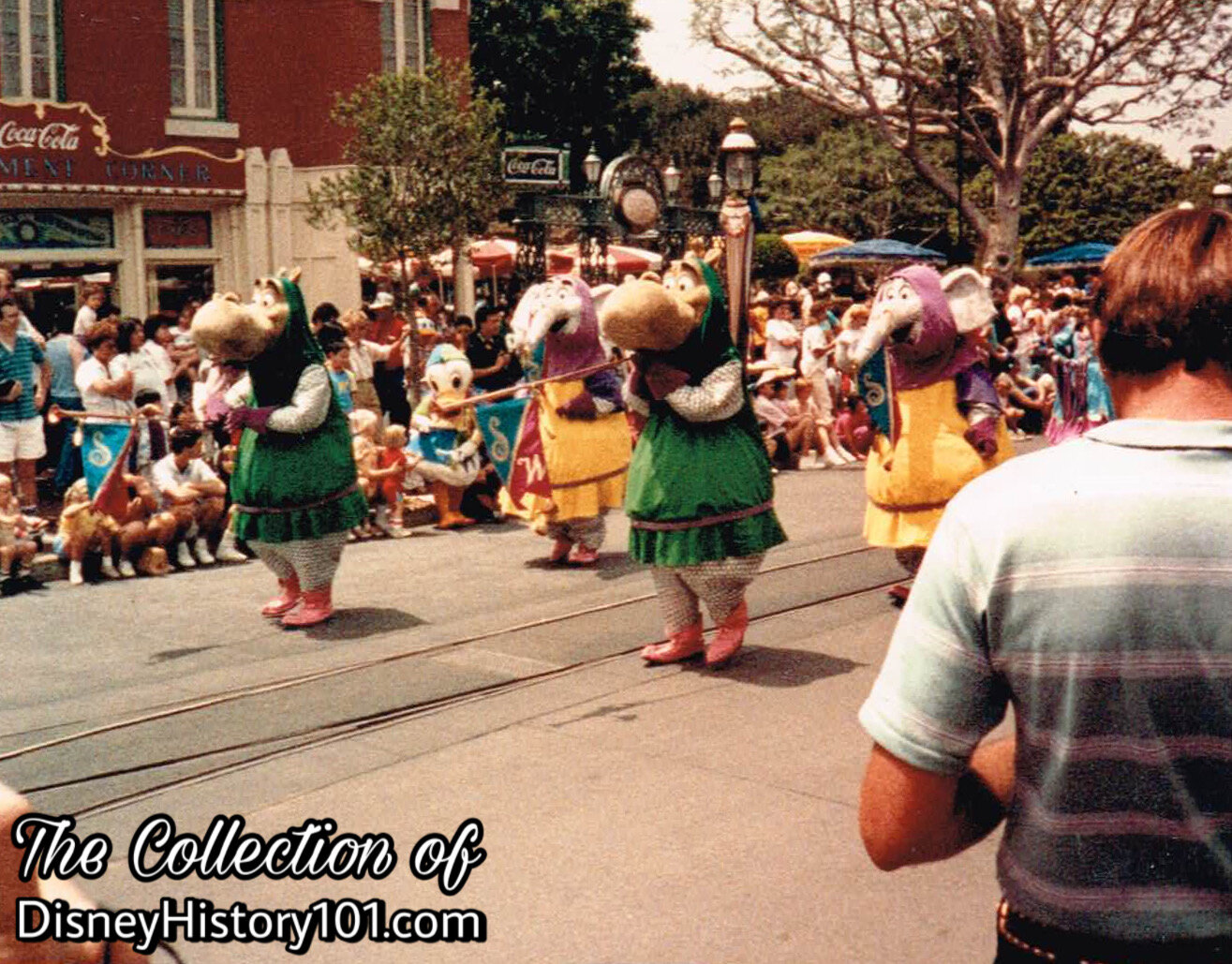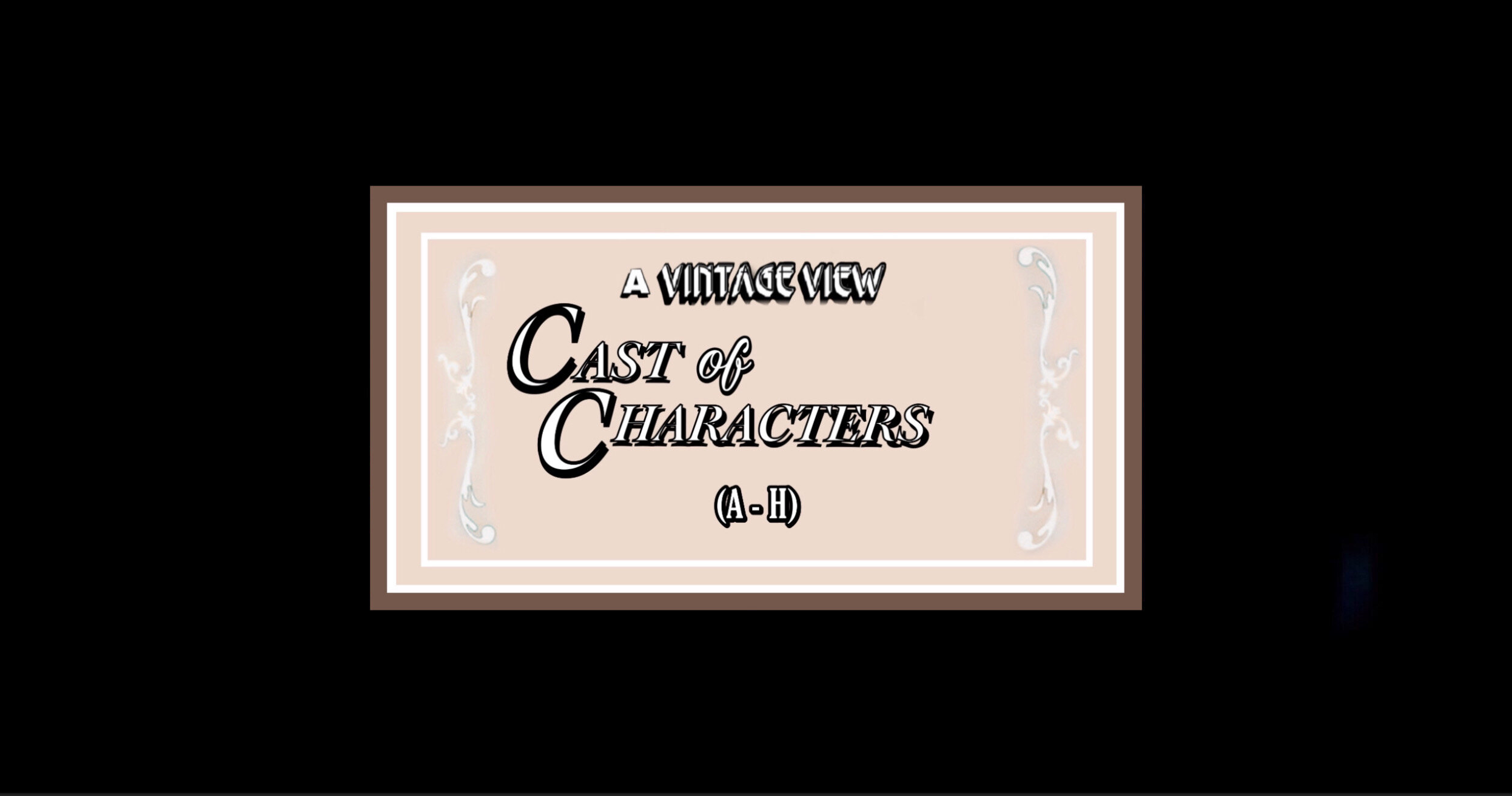DISNEY CHARACTERS (A-H)
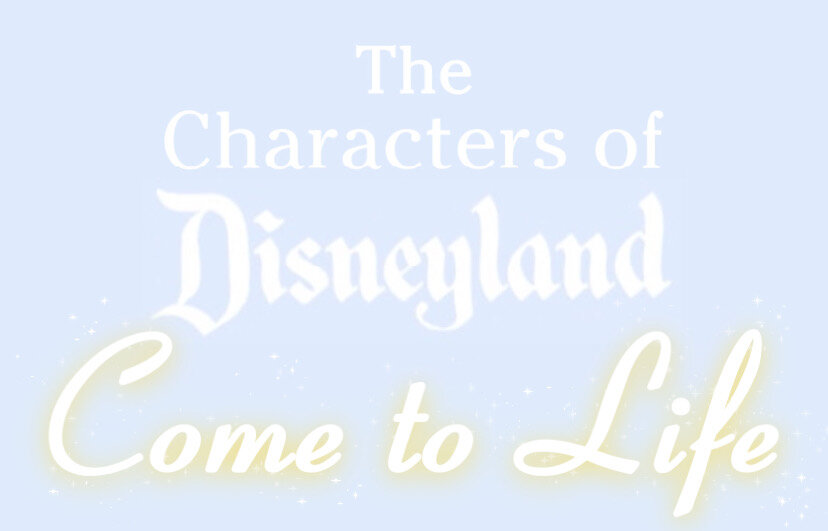
"Disneyland is the Star!" However, Cast Members represent all of Disneyland, and promote goodwill between Disney and the public. The Disneyland Character Cast particularly capture the Spirit of Disneyland and Disney Parks worldwide! Thousands of Guests visit Disney Parks each day with the hope of just taking a picture with, acquiring the autograph of, or just to shaking hands with Mickey Mouse or some other world famous Disney Character. Today, the Disney Character is brought to life by a Cast Member.
But did you know, that “come to life” versions of Walt Disney’s popular licensed characters actually predate Disneyland by a number of years? Yes, some of Walt Disney’s three-dimensional life-size cast of characters were creating happiness even before Disneyland was amidst its earliest planning stages. As you will see, these characters actually helped “set the stage” for their future appearances in Disney Parks for decades to come. In addition, we will see how one-time make-believe Disney Characters have “come to life” as a result of untold numbers of talented people!
“The 1930s - Walt’s Characters ‘Come To Life’”
The creation of characters (and casting) has always been an essential part of the success of Walt Disney’s short films and feature length films. As to character development, Walt once said: ”I try to build a full personality for each of our cartoon characters - to make them personalities.” Walt and Ubbe had been practicing this philosophy during their days in Kansas City, culminating with the production of Walt’s first Alice Comedies pitched in August of 1923. Perhaps the earliest character to come out of the inkwell and “come to life” was Mickey Mouse (with the help of the first “Pageant Helper,” Toots Novelle), in conjunction with the traveling Fanchon & Marco vaudeville revue show staged by Larry Ceballos during the early 1930s. Advertisements promised: “You’ll see Mickey Mouse and all of Walt Disney’s famous cartoon characters come to life on the stage.” The popularity of Mickey Mouse persisted and he appeared “in person” again, this time in his own show - the Mickey Mouse Circus, at California Pacific Exposition (from 1935-1936). A few years later, newer versions of Mickey Mouse, Minnie Mouse, and (the debuting) Donald Duck would walk the red carpet alongside Snow White and the Seven Dwarfs for the premier of Snow White and the Seven Dwarfs at Carthay Circle Theater in Los Angeles, in 1937. Despite the creation and development of a growing cast of theatrical stars, it would be another decade before more of Walt Disney’s characters would “come to life” in a regular exhibition on a near daily basis.
“The 1940s - Ice Cycles, Ice Capades, and Future Stars of Disneyland”
The Ice Follies began to produce a popular show called Ice Cycles (in conjunction with the Ice Capades), which ran from 1946 to 1949. With that, Walt Disney would see a magical opportunity to form a special arrangement that would allow some of his licensed characters to appear in the Ice Follies shows. According to this press release photograph, “Walt Disney’s Dumbo becomes the first elephant to take to the ice in the coming Ice Cycles of 1948, which is scheduled to open to a limited engagement at [an arena to be determined]. He comes to life to the delight of both young and old as he goes through the laugh-provoking maneuvers of the frozen surface in the all-new edition of the thrilling musical revue on ice.”
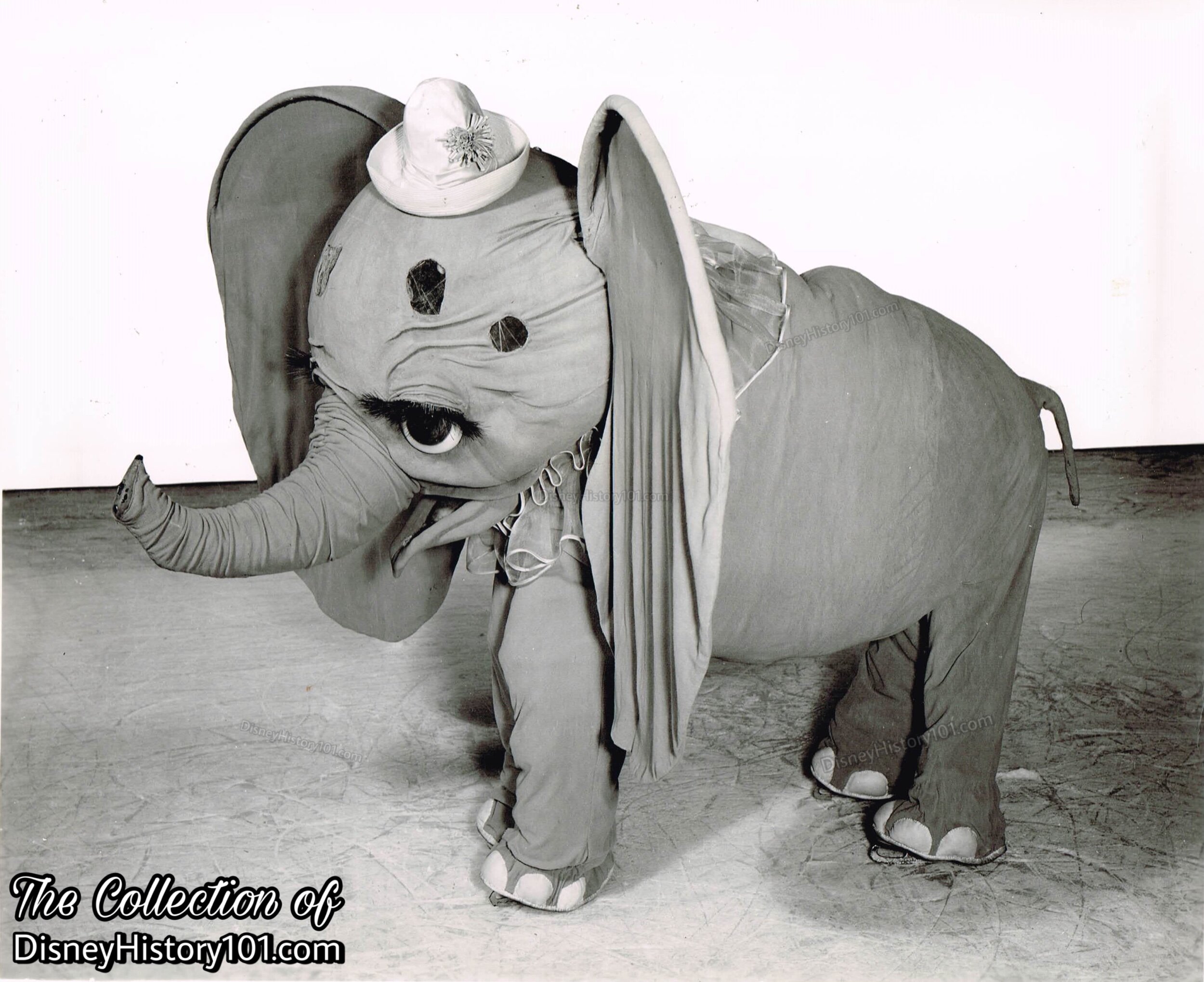
ICE CYCLES with ICE CAPADES, (1948)
To make it clear, this version of Dumbo never appeared inside Disneyland, but he did pave the way for the two-man version of Dumbo that would.
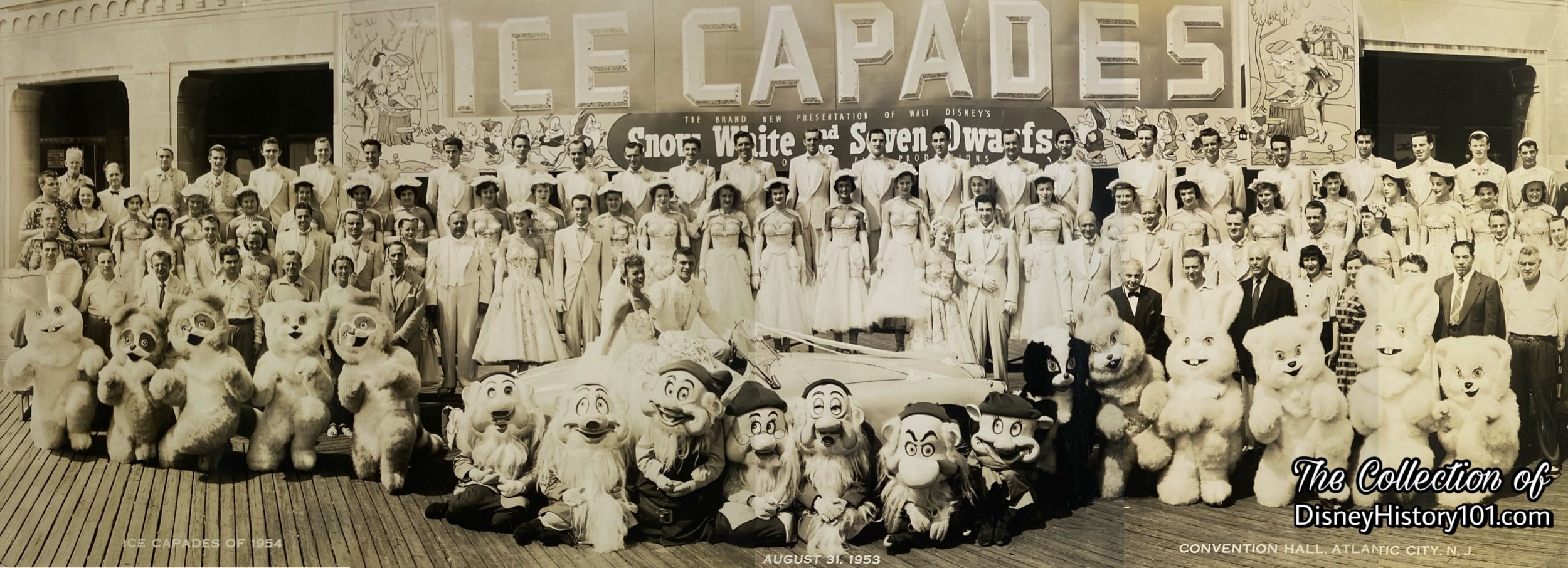
Ice Capades Snow White and the Seven Dwarfs cast Photo
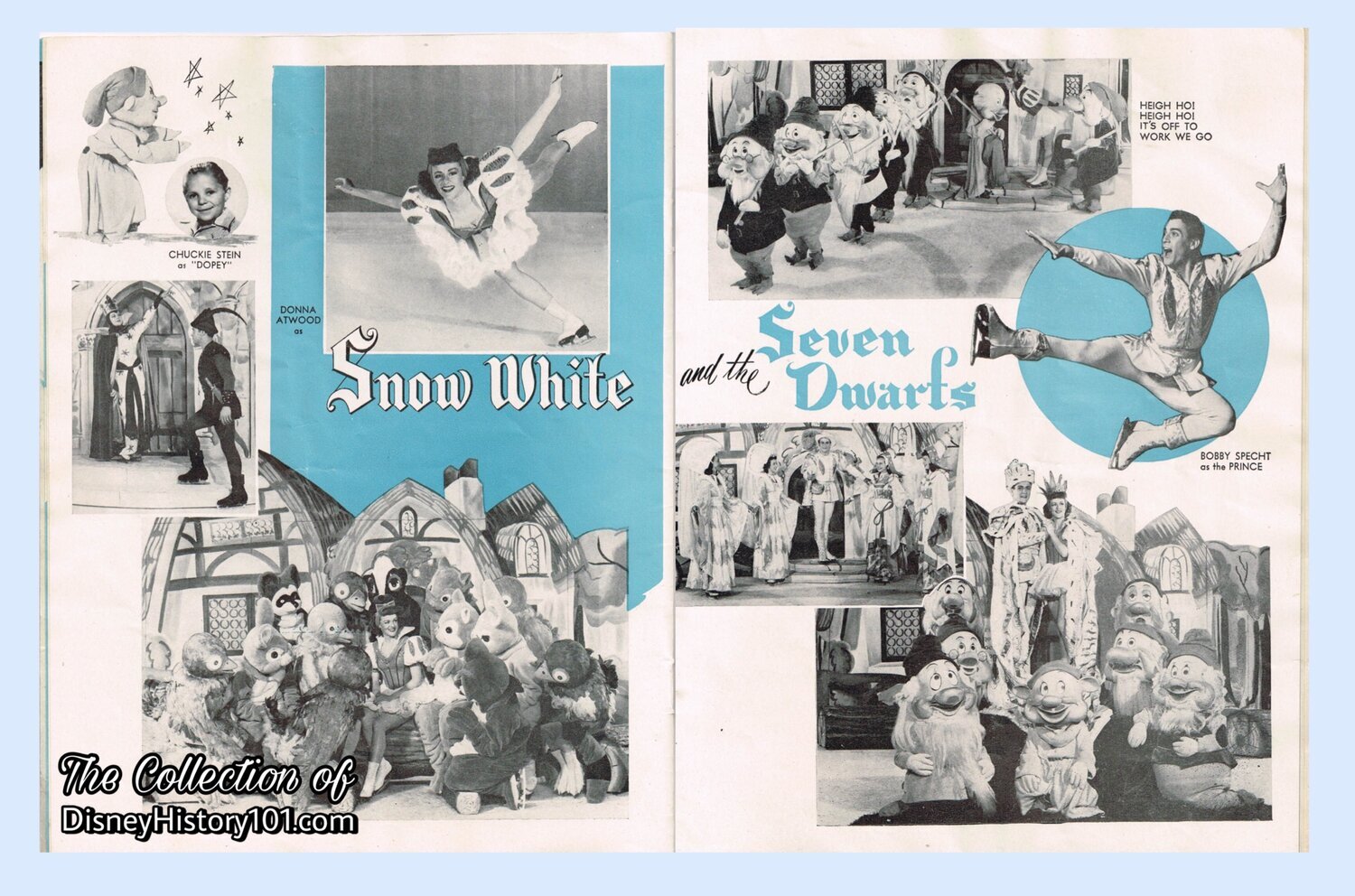
ICE CAPADES, (1949)
“‘FROM SCREEN TO STAGE’” - Walt Disney’s cast of Snow White and the Seven Dwarfs delighted theatrical crowds in 1938! Now, through a special agreement between Walt Disney and John H. Harris (who created the figure skating extravaganza “The Ice Capades”), a presentation of “Snow White and the Seven Dwarfs” was negotiated to appear as the 11th of 24 acts, during the 1949 Ice Capades - nearly a decade after the namesake, award-winning film was released, and an entire six years before Disneyland opened!
These very incarnations of the Dwarfs would go on to be featured in the Mickey Mouse Club Circus at Disneyland. But for now, all of the characters were portrayed by professional figure skaters - Donna Atwood (Snow White), Bobby Specht (Prince Charming), Francine Benoit (The Wicked Queen), Helen Davidson (The Wicked Queens “Even More Wicked Transformed Self”), Herbert Cowman (The Faithful Huntsman), Jill Bruhinger (Grumpy), Nona McCarthy (Happy), Nadine Jackson (Doc), Jack Bruhlinger (Bashful), Ursula Welsch (Sneezy), Julie Jacks (Sleepy), and Chuckie Stein (Dopey). In addition to these principle characters, were a cast (including three Trees of the Haunted Forest, and the “Birds and Animals of the Forest”!
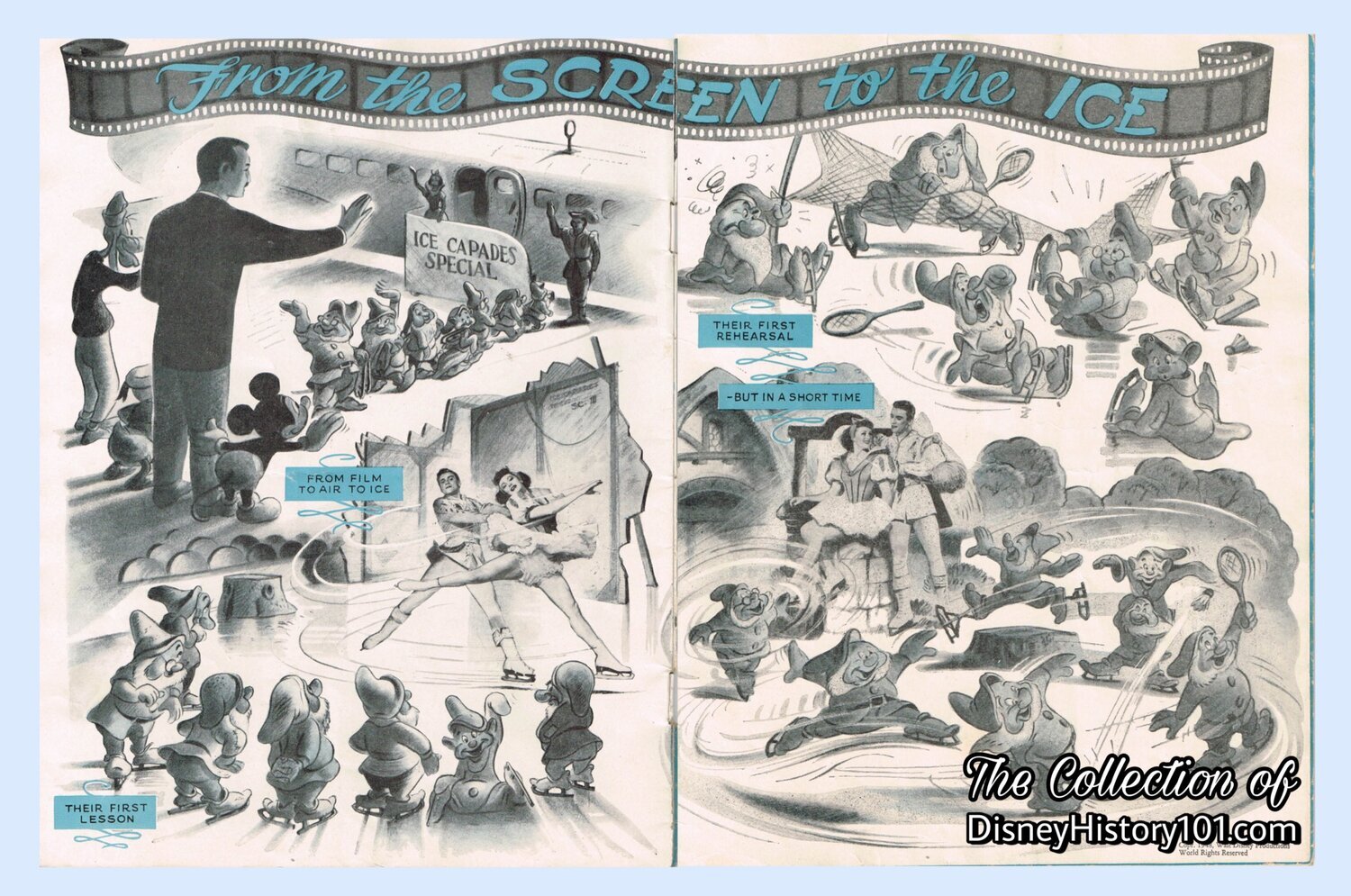
ICE CAPADES, (1949)
You’ll notice that Walt Disney, Mickey Mouse, and Donald Duck have come to see the cast of Snow White and the Seven Dwarfs off, as they depart for their country-wide 1949 tour. However, none of those characters would appear at the Ice Capades that year (except of course, for Walt Disney)!
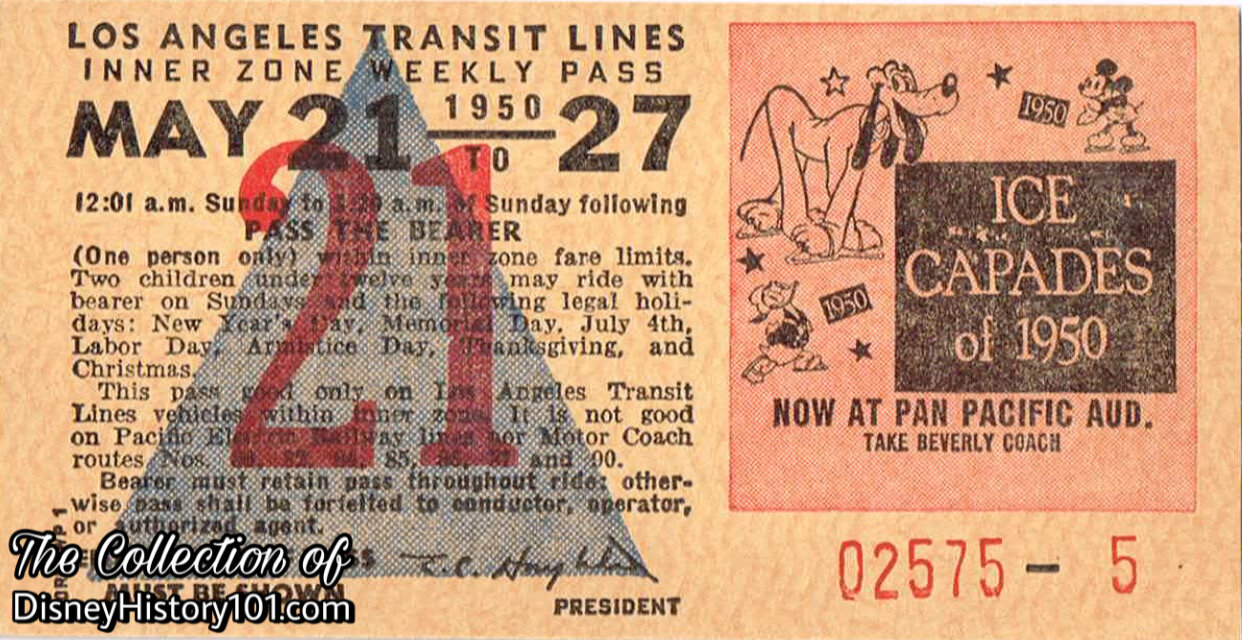
THE ICE CAPADES TICKET, (1950)
The big performance of the 1950 Ice Capades was clearly the come-to-life versions of Walt Disney’s popular characters, as seen on this ticket!
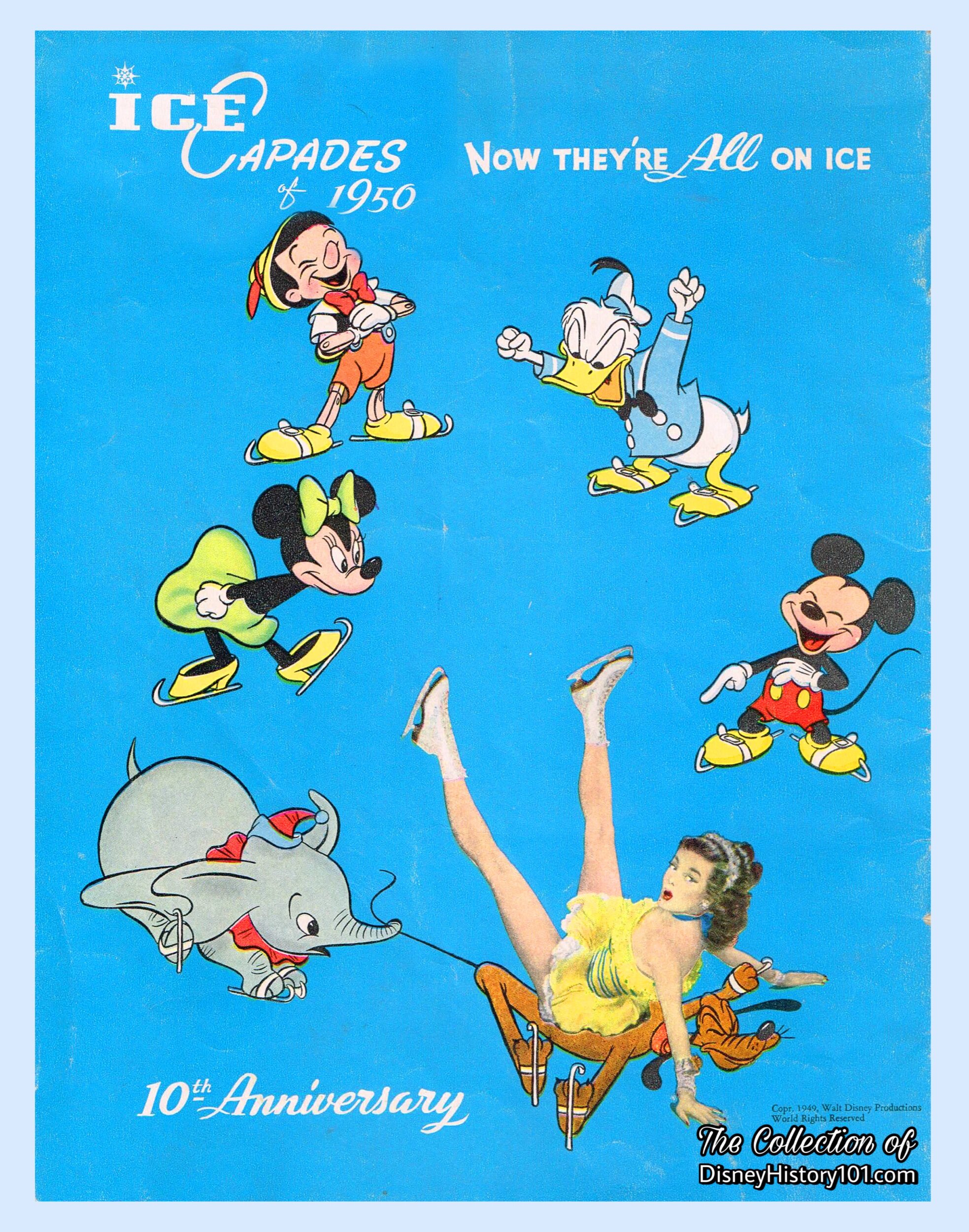
THE ICE CAPADES, (1950)
The following year (in 1950), Mickey Mouse, Minnie Mouse, Dumbo, Pluto, and Pinocchio appeared for the first time in the Ice Capades act “The Toy Shop”. These early character costumes were used (by special permission of Walt Disney) provided by John H. Harris (Producer of the Ice Capades) and ergonomically designed for an Ice Capades show.

ICE CAPADES "Walt Disney's Toy Shop" Post Card Image featuring one-time “Standard Disney Characters,” (1950)
These are “Walt Disney’s fanciful characters” as they appeared in the Ice Capades production of the “Toy Shop” in 1950. The black and white photographs of these endearing characters just never do them justice. In this color image, you don’t seem to notice the “air vents” as much, for one thing. These charming representations are most remembered by Ice Capades patrons, because for the first time (in years) Mickey, Minnie, Donald, (and their pals) were brought to life - this time through the magic of the Ice Capades! You may notice that a newer version of Dumbo appeared (which differed from the One seen in the Ice Cycles). It was this version that would ultimately make a couple of brief appearances in Disneyland parades (and even the Mickey Mouse Club Circus) a few years later. You might also note, that this incarnation of Donald Duck would also appear in a few parades at Disneyland, while driving his nephews aboard one of Mr.Toad’s motorcars.

WALT DISNEY’S TOY SHOP SOUVENIR, (1950)
These characters were popular, and endearing - so much that character merchandise was manufactured and sold. Donald Duck’s “come-to-life,” ice skating, character debut was commemorated with souvenir pins like this one!
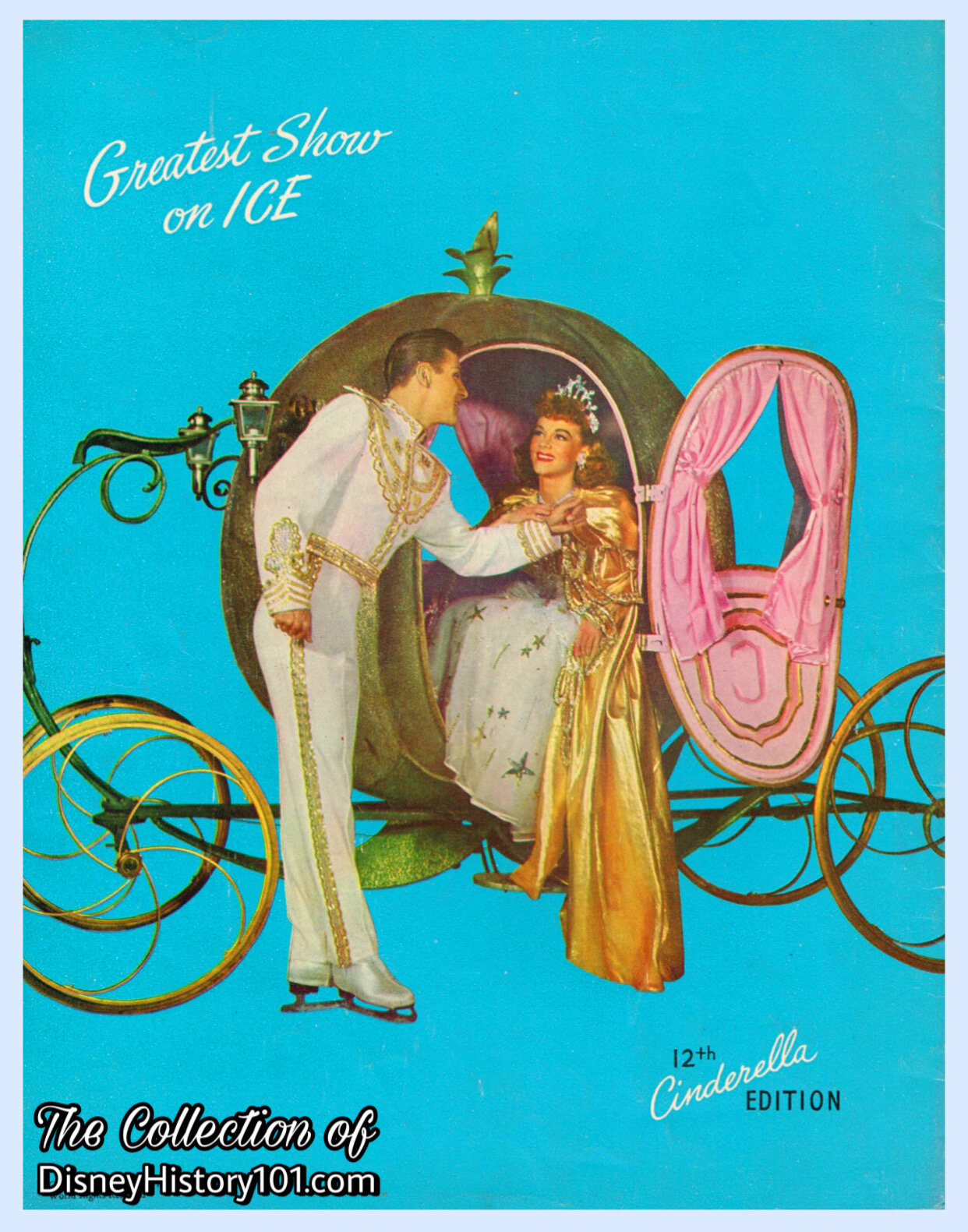
The ICE CAPADES of 1952 featured an adaptation of Walt Disney’s Cinderella (released February 15, 1950).
Next, a production of Walt Disney’s Cinderella defined the Ice Capades of 1952, its characters appearing on programs (pictured), and in some Disneyland parades (within a few years). Let’s take a look at some of them below.
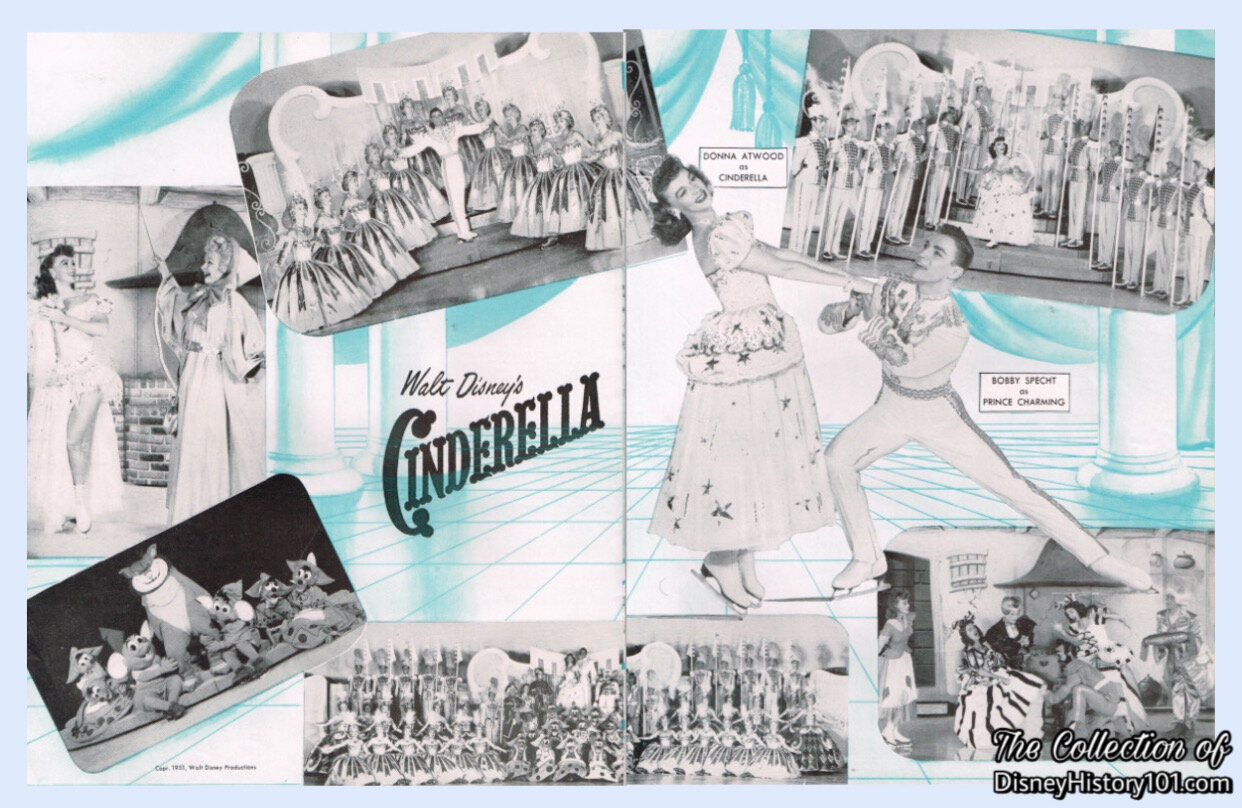
ICE CAPADES, (1952)
“The sweetest story ever told” - Cinderella - had one of the largest Ice Capades casts yet - Cinderella (Donna Atwood), Prince Charming (Bobby Specht), The King (Orrin Markhus), The Stepmother (Irma Thomas), The Stepsisters Anastasia (Jeanne Sook), Drizella (Patti Phillippi), The Grand Duke (Herbert Cowman), Jaq (Paul Castle), Gus-Gus (Alma Castle), Fairy Godmother (Joan Comerford), Lucifer (Joe Setta and William Brown), Herald (Lyall Stevenson), “Walt Disney Mice” (portrayed by 16 individuals), Ladies of the Court (portrayed by 40 individuals), and Officers of the Court (portrayed by 16 individuals)!

The Cast of the Ice Capades.
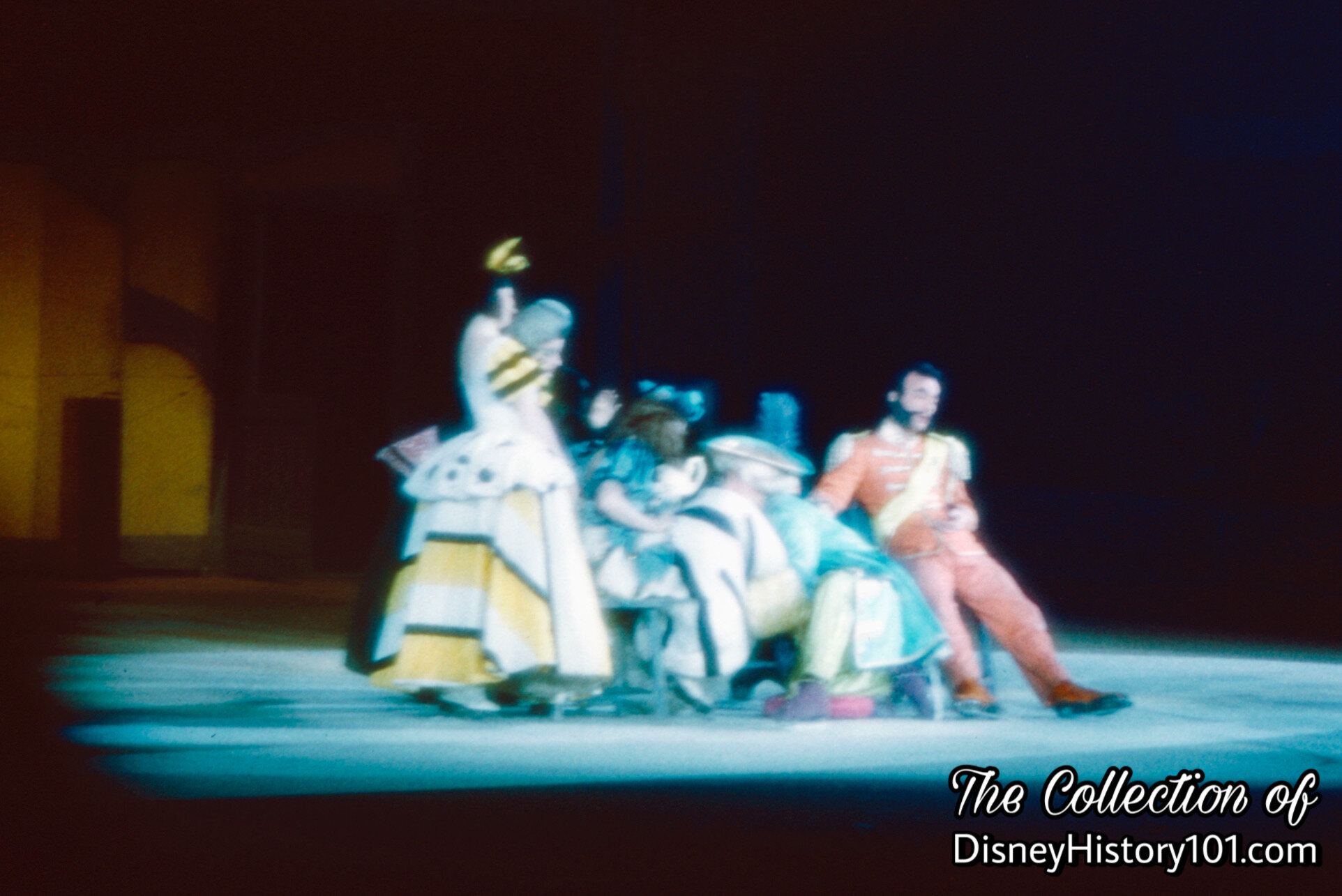
Walt Disney’s Cinderella at the Ice Capades 1952
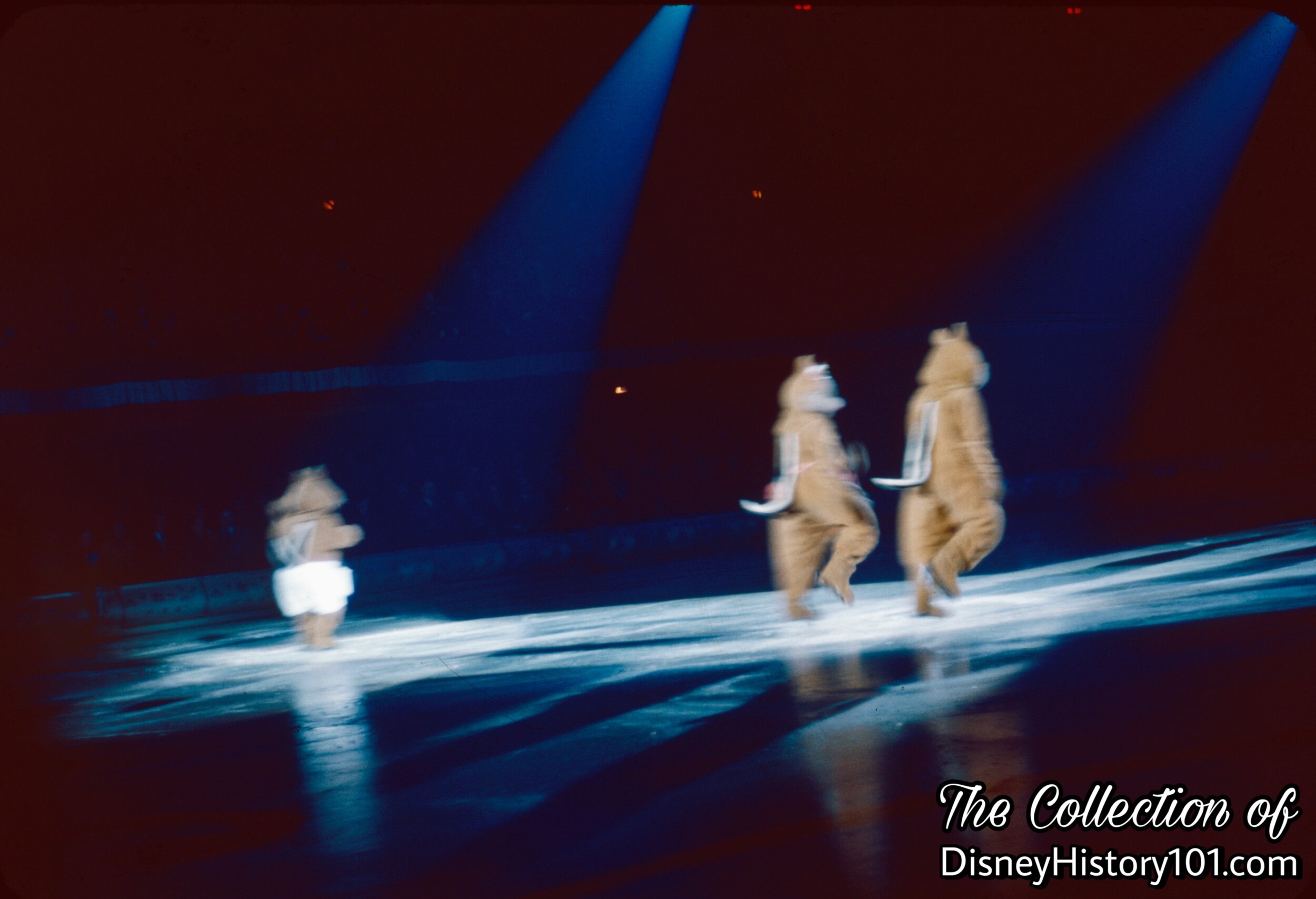
Chip ‘n’ Dale and Clarice perform with Walt Disney’s Cinderella at the Ice Capades 1952
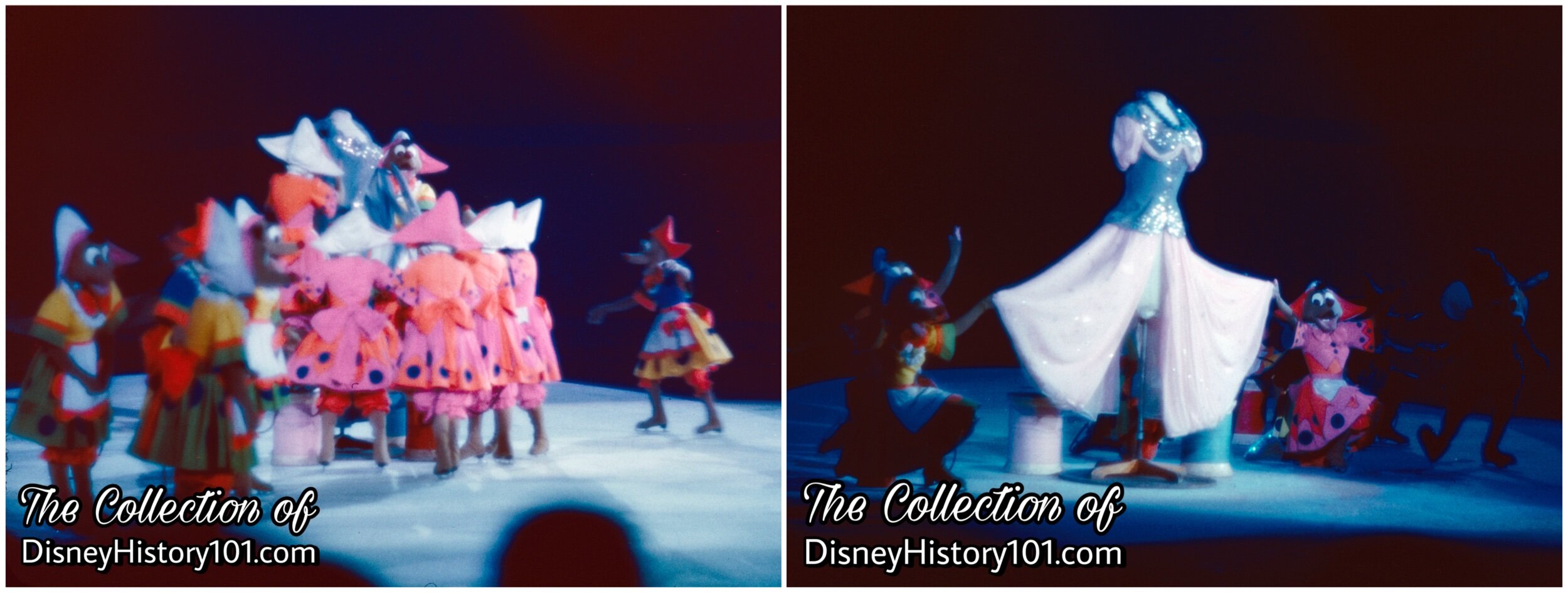
“She’ll be more beautiful than all, in the lovely dress we make for Cinderelly!”, Walt Disney’s Cinderella at the Ice Capades, 1952
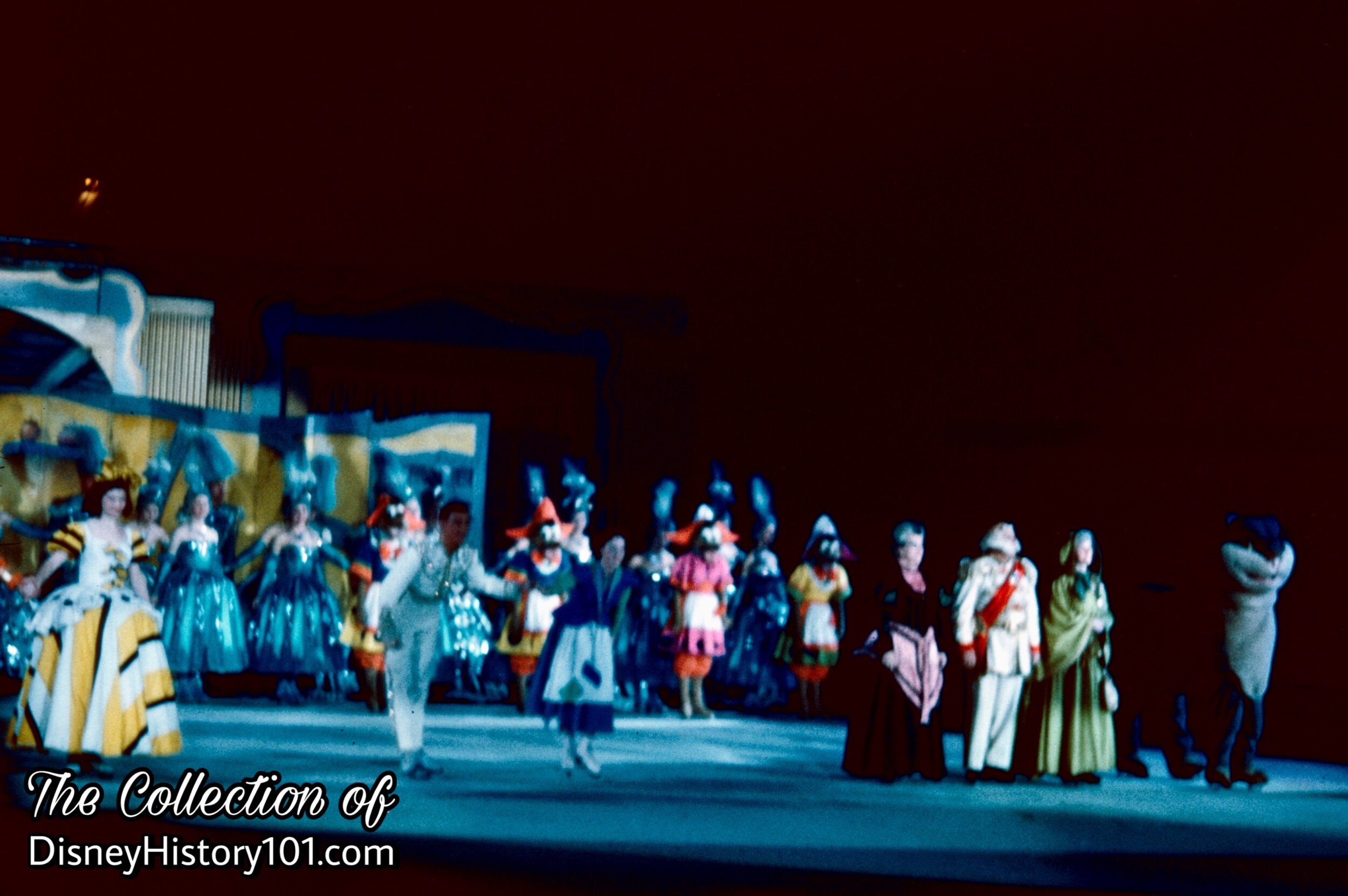
The Cast of Walt Disney’s Cinderella at the Ice Capades 1952
Yes, some of these characters would also go on to appear in seasonal Disneyland parades!
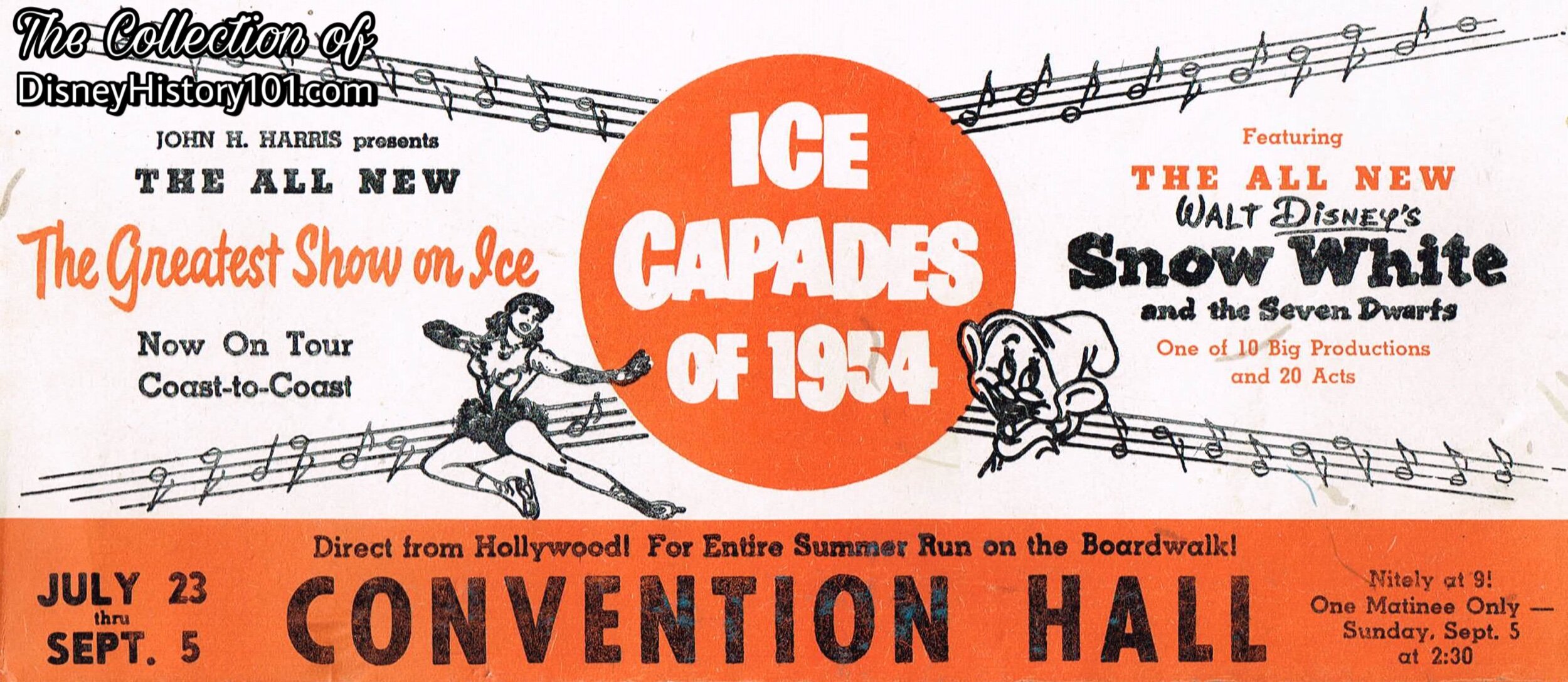
ICE CAPADES, (1954)
(Pictured Above : Ice Capades of 1954 Advertisement)
A few years passed without any licensed Walt Disney characters appearing in the Ice Capades. Then, Walt Disney’s Snow White and the Seven Dwarfs appeared again during the Ice Capades of 1954. The characters, costumes, props, and scenic illustrations (including those of Walt Disney licensed characters and themes) produced for the show, were all created at the new half-million-dollar, 25,000 square-foot, Ice Capades Studio (in Hollywood, California). However, it is surprising (considering Walt’s promotional efforts through the mediums of television, radio, and even the Tournament of Roses Parade) there was no promotional Disneyland-related Ice Capades segment during 1954 or 1955 (though Walt Disney’s Peter Pan toured with show during 1955)! Of these were the very Disney Characters that appeared (in the 1950 Ice Capades production of “The Toy Shop”.
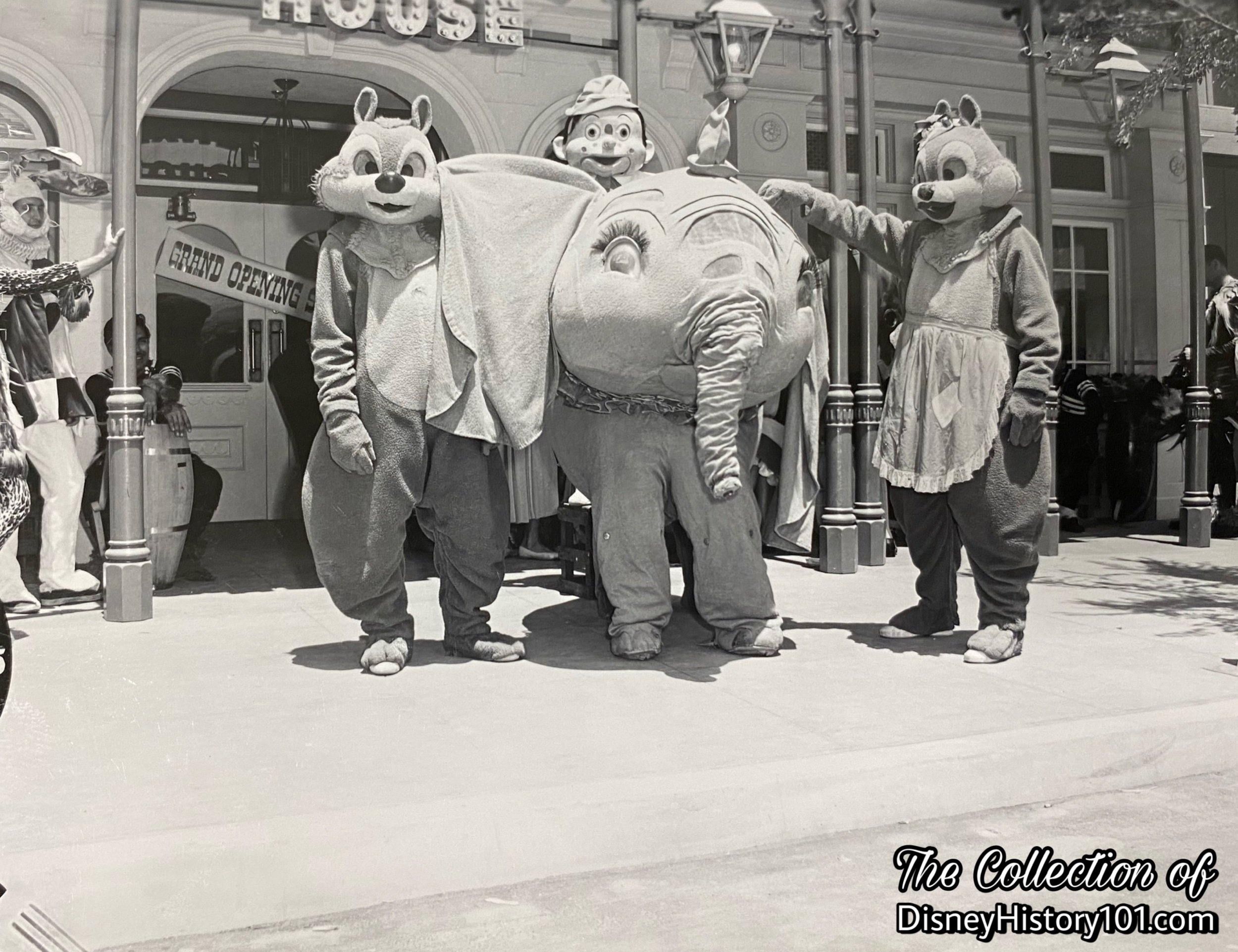
The Disney Characters debut in Walt Disney’s original Magic Kingdom - Disneyland!
“1955 - John Harris & Disneyland”
Since the beginning, Disneyland would begin to synergistically work with Walt Disney Studios and keep the Disney characters before the public. When Disneyland opened in July of 1955, there were 1,280 costumed Hosts and Hostesses, that appeared at Disneyland. Many of the costumes for these were provided by Chuck Keehne (Chief of the newly established Walt Disney Studio Wardrobe Department, and co-designer of the Mickey “Mouse-ke-ear” hat for the television series). Beginning on July 17th, 1955 (in a special arrangement between John H. Harris and Walt Disney), the Disney Characters appeared in the televised Press Preview Day Broadcast. After this, the Disney Characters (and costumes provided by John Harris’ Ice Capades) would continue to appear at Disneyland numerous times during Disneyland’s first year of operation, including the Opening Day Press Preview Parade and in the Mickey Mouse Club Circus (which was held during the Park’s first winter season of 1955). Chuck Keehne would oversee the Wardrobe for one of Disneyland’s first big events - the Mickey Mouse Club Circus, during the fall and winter of 1955! As for the pageant helpers, each would attend an orientation class, to assure that they would “create happiness for others.”
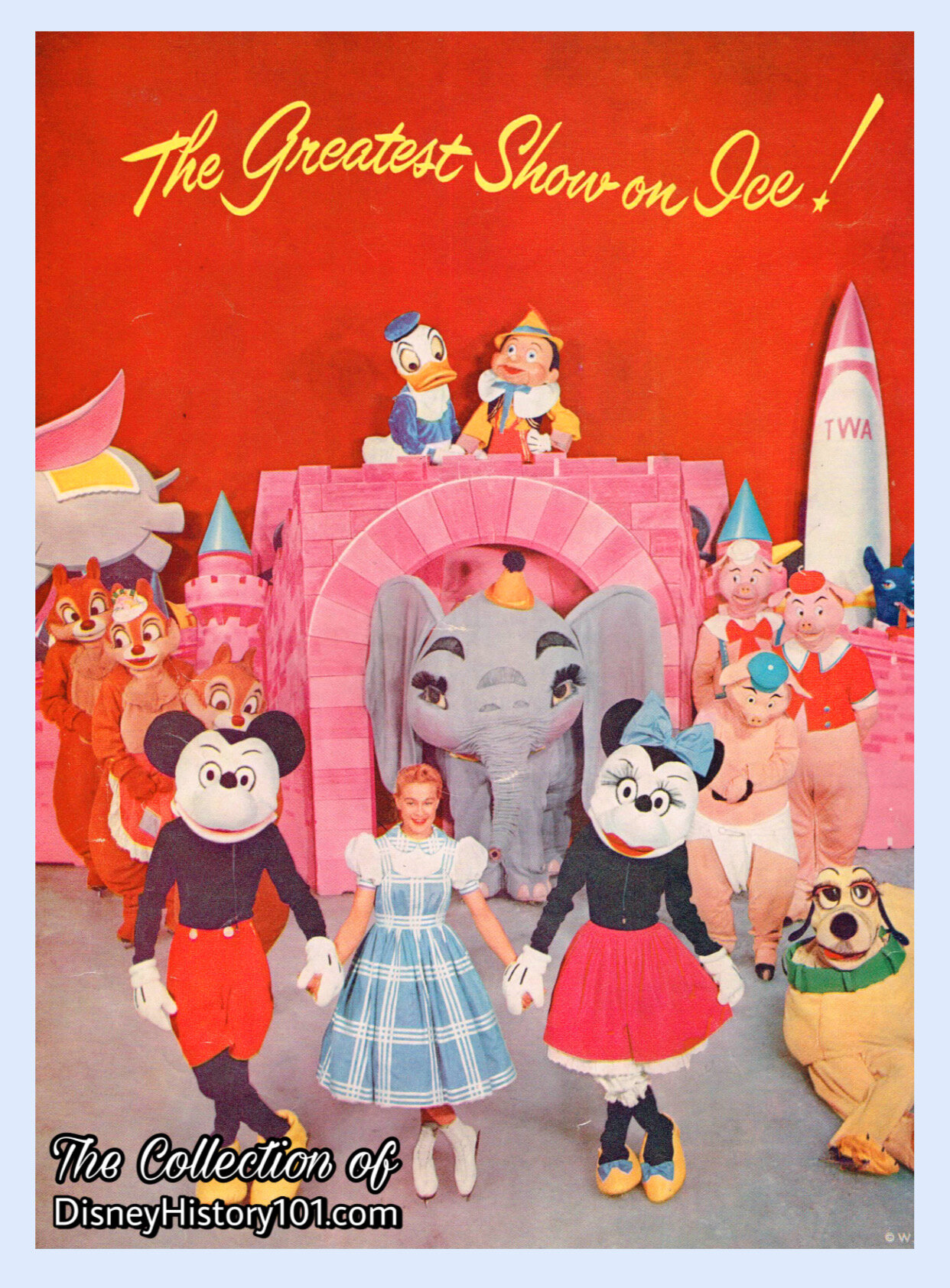
THE ICE CAPADES, (1957)
After Walt Disney’s magical characters (pictured above) marched through the streets of Disneyland in the Press Preview Day Parade (of July 17th, 1955), the magic of “Disneyland” came to the Ice Capades (in 1957)! All of this was made possible through a synergistic special arrangement between Walt Disney and John Harris.
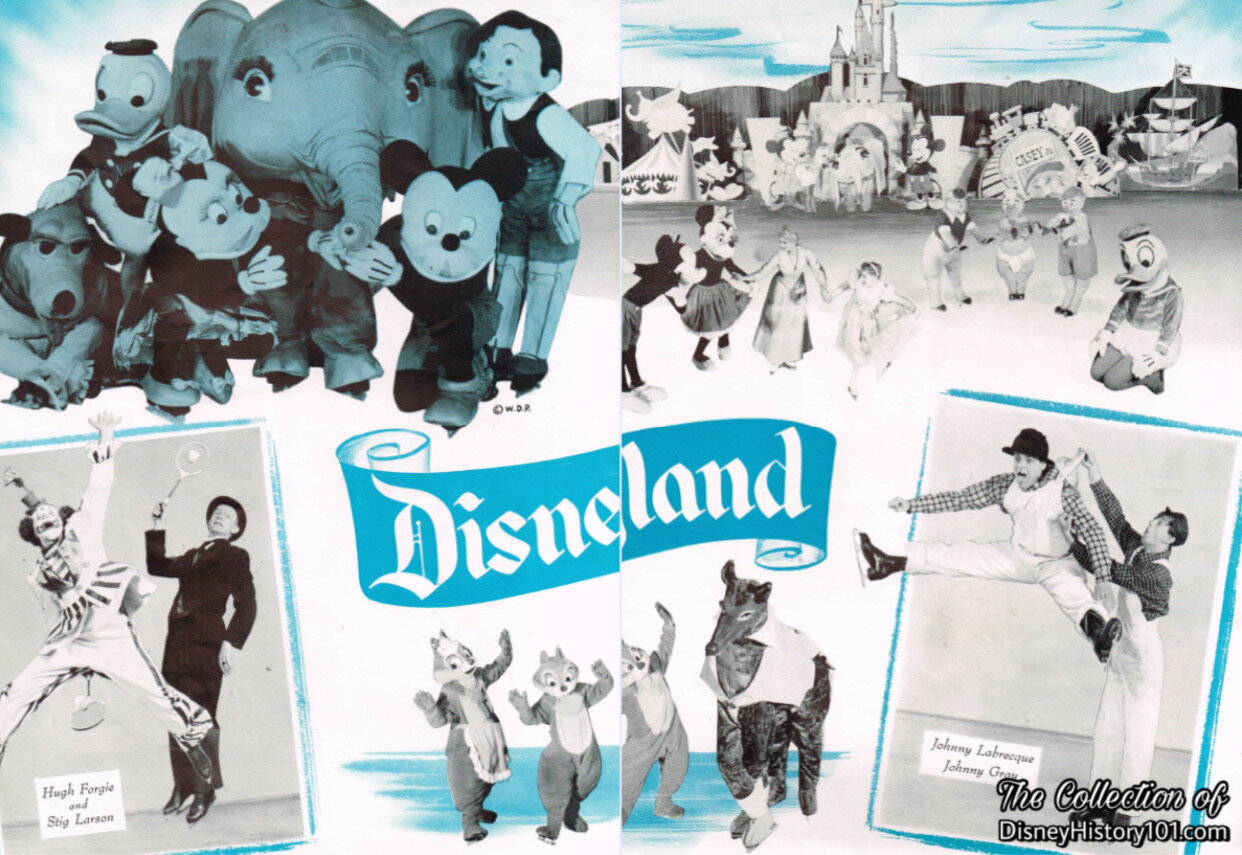
THE ICE CAPADES, (1957)
At long last, during 1957 (a few years after Disneyland opened), “the greatest show on ice” featured a special production entitled “Disneyland”! This segment starred Mickey, Minnie, the Three Pigs, the Big Bad Wolf, Chip, Dale, Clarice the chipmunk, an all-new version of Dumbo, Pinocchio, Donald, Pluto, original characters Little Joan & Mother, and Three Rabbits (who would later make appearances in Disneyland’s seasonal Springtime and Wintertime parades). During this time, it was common to see Ice Capades characters (like Fifi the Poodle, Maude “the Comedy Mule”, and Scottie) make appearances in seasonal Disneyland parades like the Parade of the Toys and even the first few seasons of Fantasy on Parade.
DISNEYLAND LEGACY : John Harris would loan the characters to Disneyland for the big televised opening, and continue to loan them to Disneyland for some time thereafter. The Disneyland characters continued to be featured in Ice Capades acts into the early 1960s.
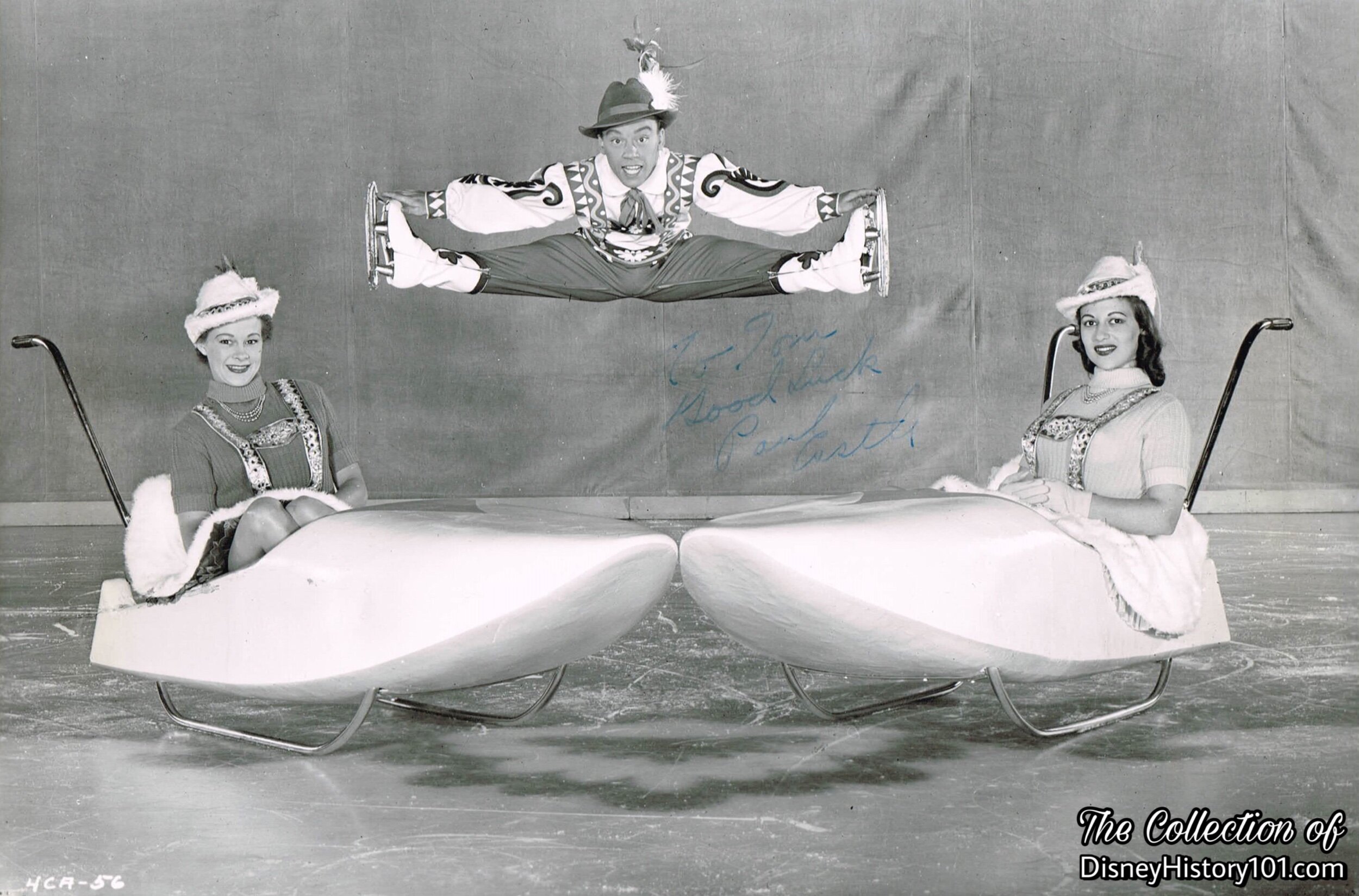
Pictured Above : Paul Castle appearing in “Jingle Polka” an early Ice Capades Production, performing one of his animated stunts he was so famous for!
DISNEYLAND LEGACY : More than Walt Disney’s cast characters from the Ice Capades went to work for Disneyland. The 42-inch-tall Paul Castle originally performed with the Ice Capades, but would go on to give life to Mickey Mouse during his decades of Disneyland appearances. Paul Castle was even present during one of Walt’s final appearances with Mickey Mouse, at a Tournament of Roses Parade, and continued to be affiliated with Mickey until January 31, 1986!
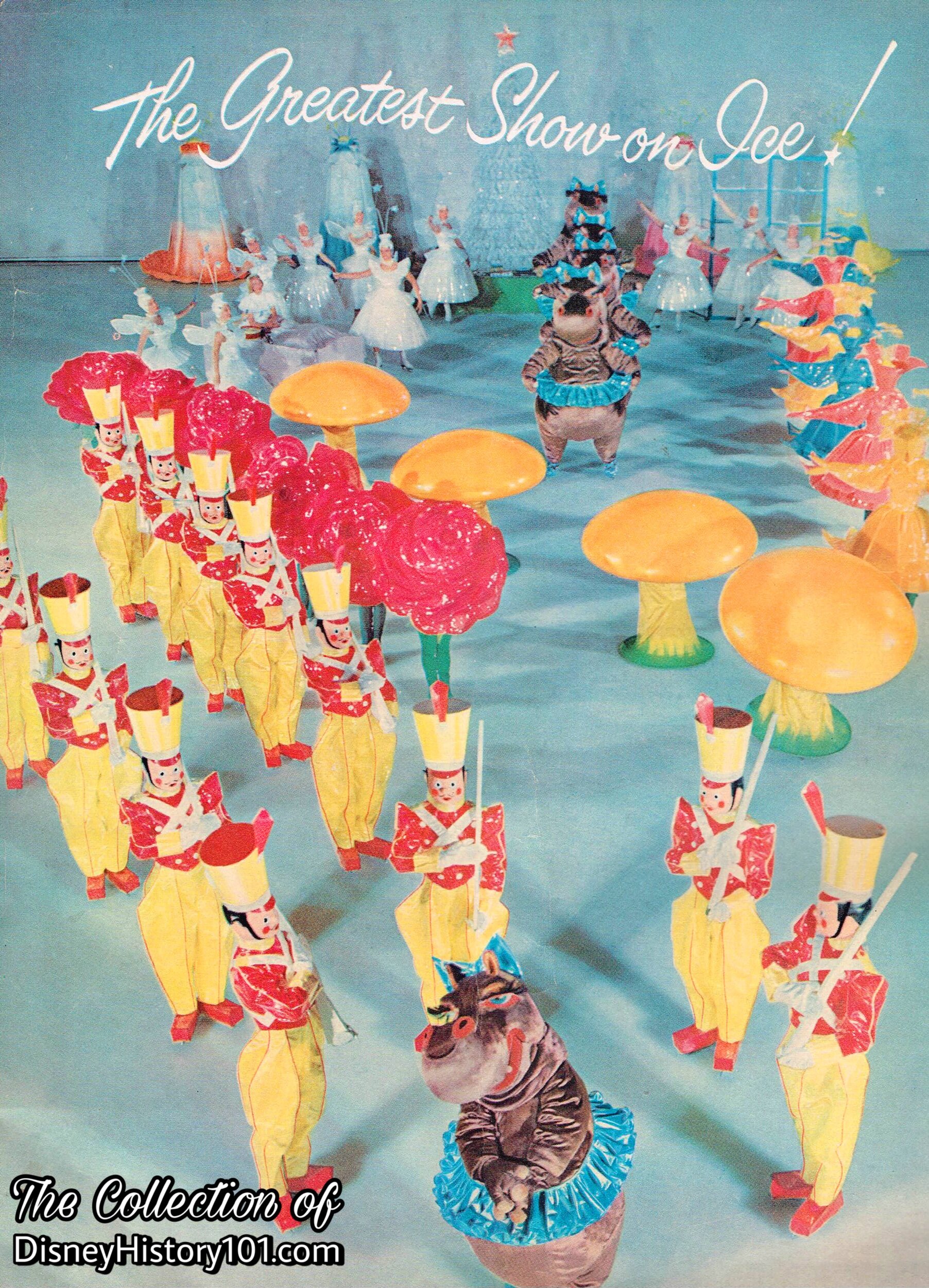
ICE CAPADES, (1957)
Walt Disneys Fantasia as interpreted from the Nutcracker Suite comes to the ice for the eighteenth edition of the Ice Capades! Some of the last characters used (with special permission by Walt Disney) were of the cast of Walt Disney’s Fantasia. They appeared in segments of the Ice Capades, and on souvenir merchandise (like hats, pins, and pennants), from 1961-1962. Some of these same Fantasia characters (hippos and mushrooms) would also appear in contemporaneous Disneyland parades those years!

ICE CAPADES, (1958)
This program excerpt gives us a look at the woodland animal cast that appeared in the show (which later appeared in some seasonal Disneyland parades), as well as the newest cast of Snow White and the Seven Dwarfs. Snow White (Sandy Culberson), Prince Charming (Bobby Specht), The Witch (Diane Grogan), Six of the Dwarfs (The Ice Ca”Pets”), Dopey (Paul Castle), The Enchanted Trees (The Ice Cadets), The Rabbits (The Ice Ca”Pets”), The Bears (The Ice Ca”Pets”), and The Dancing Elephants (yes, elephants in a Walt Disney Production of Snow White and the Seven Dwarfs, portrayed by none others than the Ice Cadets)!
In the following act - a non-Disney performance - Maude (Mrs. Astor’s Pet Mule) returned to the Ice. You may recollect that Maude made a few cameo appearances in Disneyland parades.
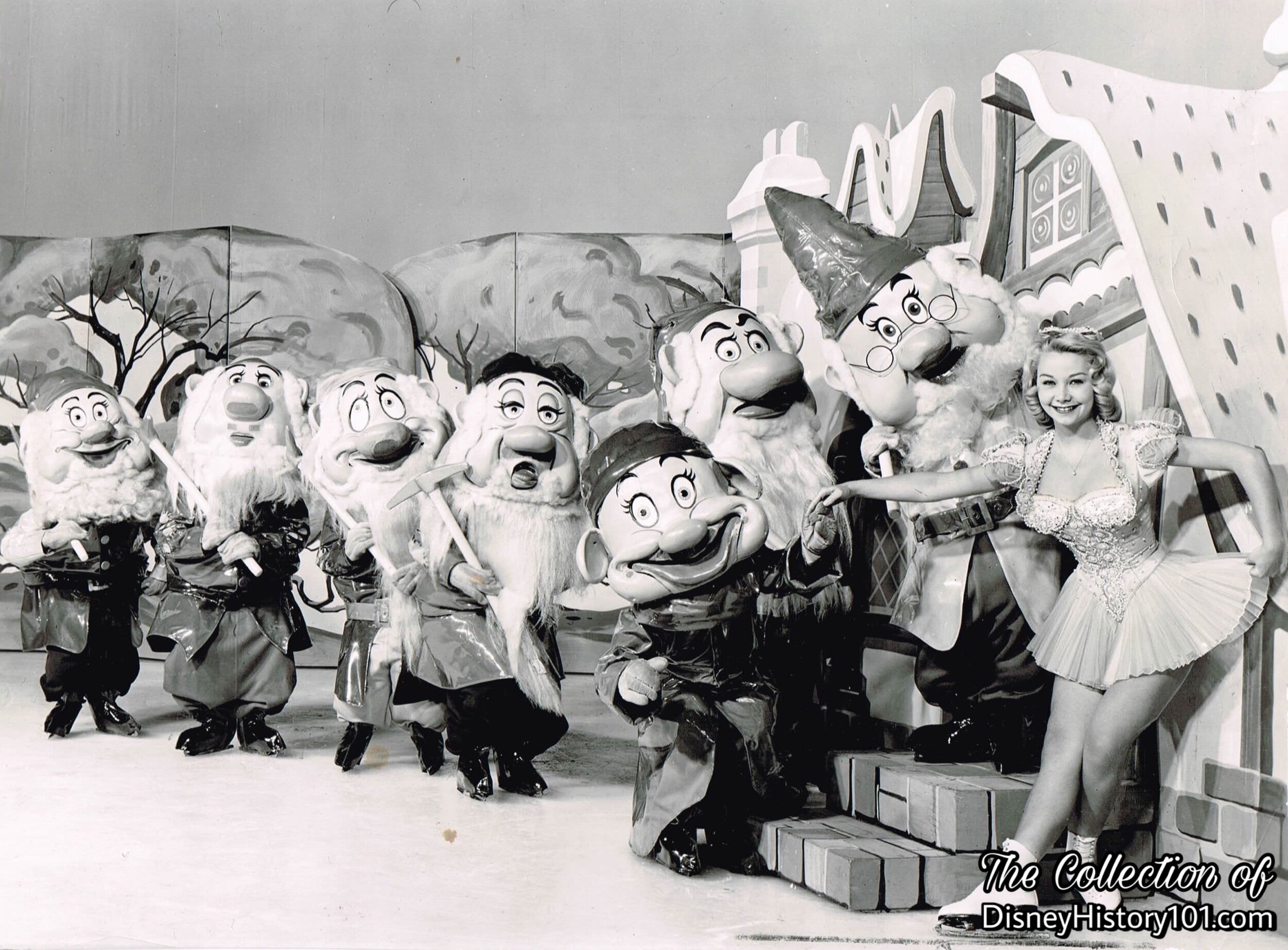
THE ICE CAPADES, (1959)
Snow White and the Seven Dwarfs returned yet again, to the Ice Capades 1959. This press photo gives a great view of early versions of the Seven Dwarfs that appeared on Disneyland’s opening day, and eventually made seasonal appearances inside Disneyland right up to the spring of 1961.
The 22nd Ice Capades (of 1962) brought back previous versions of Disney Characters (which no longer appeared in the Park) into a show called “Disneyrama”. Later, another version of the Ice Capades featured a Fantasia segment with Clara, the Wooden Soldiers, “Ballerinas Hippopotamuses”, Sugar Plum Fairies, “Chinese Mushrooms”, and a Dozen Roses.

Fantasy on Parade, (c. 1961)
Walt Disney, on the eve of Disneyland’s first day of operation, promised that “Disneyland will never be completed. It will continue to grow, to add new things, as long as there is imagination left in the world.” The second incarnations of Mickey Mouse, Minnie Mouse, and the Three Pigs (originally appearing in the Ice Capades), made an appearance in Disneyland’s Fantasy on Parade!

Disneyland “Happiest Show On Earth” Entertainment Guide excerpt, Summer, 1961.
(Pictured above : Like the musical acts of the Dapper Dans, Keystone Kops Quartet, and the Shoe Shine Boys, “The Disney Characters” received billing as an attraction inside the Entertainment Guide!)
“The 1960s - The Walt Disney Studio Costume Shop ‘Builds a Better Mouse’ and Reimagines The Disney Characters”
By the 1960s, all the Magic Kingdom had become “a stage where more than 150 professional entertainers …$1,000,000 worth… [were]…showcased daily. Musicians, singers, dancers, even Mountain Climbers and Indians…and a colorful collage of come to life cartoon characters from Walt Disney’s animated films, add a live and lively sparkle to every corner of Disneyland! The big Disneyland show …[started] with the first hour of operation and… [continued] right up to midnight every night (‘til 10 pm on Sunday)!”
Disneyland abounded with Area Entertainment - music and/or entertainment which complement the theme of the area, enhanced the Show, and entertained Guests on a level more immediate and personal than stage shows. Atmosphere entertainment was usually staged among the Guests. And the stars of the show, were those “come to life” characters from Walt Disney’s films, it was now wise to enlist the staff of the Walt Disney Studio Costume Shop (est.1955) on the studio lot in Burbank. Walt Disney Studio Character animators could now easily work closely with the Model Shop staff, and begin to produce functional costumes that were “on model.”
Unlike the Ice Capades’ Disney Characters (which were still in use by The 22nd Ice Capades of 1962), these were meant to be seen at close range and capture the characteristics of the character as much as possible. The team of Walt Disney Studio Character artists Bill Justice and John Hench partnered with Chuck Keehne (Chief of the Walt Disney Studio Wardrobe Department, from 1955-1979) to oversee the creation of new Characters that could “stand up to the rigors of every day use among the guests." By the seventh summer season (or, the summer of ‘61), 40 spectacular life-size “come to life” versions of your favorite Disney characters were ready to perform for Disneyland guests! “Plasterers” worked under the direction of these supervisors, utilizing prefabricated materials (fiberglas, rubber, polyurethane, and others) to fabricate various sculpted Character heads and parts. Joining the Cast were “long time favorites” as “Pluto, Goofy and Figaro the cat…The Three Little Pigs…The Big Bad Wolf… lovable Pinocchio… old Captain Hook, the Crocodile and Peter Pan,” according to “Disneyland News” Vol.1, No.1.
Height Range (a measurement scale) began to determine what costumes each Cast Member could wear.
The Disney Characters would factor into a concept (later popularized through World’s Fairs like Expo ‘67), which Walt pioneered since Disneyland’s earliest days - that of entertaining queue lines with live performers! Frontierland had its gunfighters, while both Adventureland and Tomorrowland had their live musical entertainment. Fantasyland had its “come-to-life” Face Characters like Peg Leg Pirate and the Fantasyland Court Jester. Soon they would be joined by “Mickey and Minnie Mouse, Pluto, Goofy, the Three Pigs, the Big Bad Wolf, Figaro the Cat, Pinocchio, Donald Duck, Chip and Dale, Captain Hook, Snow White and the fabled Dopey, Doc, Grumpy, and all the rest” comprising the cast of “the happiest show on earth.” Some of these were Face Characters (e.g. Peter Pan, Snow White, or Alice). Others were Fur Characters (“nickname for any Character costume that utilizes a Character head regardless of whether or not fur is actually used in the costume”). Some of these debuted on the cover of Vacationland, (Spring, 1961). Disneyland had certainly come a long way from just two life-sized costumed characters!
The Characters were popular, and during the 1960s, characters and costumes (as the Mickey Mouse Club costumes of Mickey, Goofy, and Pluto) were occasionally requested to be rented by affiliated outside parties. By the summer of ‘63 (and again in ‘64), the “come to life” Character Cast in Disneyland numbered 25. “On a summer afternoon, 1963,… in Fantasyland, dozens of Disney characters - Mickey Mouse, Pluto, the Three Pigs and the Bug Bad Wolf, Snow White an the Seven Dwarfs - come to life in people-size costumes,” according to the author of “Walt Disney Disneyland,” pages 51 & 52, printed by Officine Grafiche Arnoldo Mondadori - Verona; first published 1964.
Some of these Characters appeared outside the Disneyland stage at the Steve Allen Theater (on May 13th, 1964). During the winter of 1964 to the spring of 1965, the Snow White and the Seven Dwarfs costumes were shipped to “the other side of the pond” to be utilized for publicity events in London, England. In addition to special guests (Tarzan, the Great Wallendas, and others), “Mickey Mouse and his friends from Disneyland” (including Snow White and the Seven Dwarfs) were the honored guests of the Canadian National Exhibition (held August 24th thru September 5th, 1964) and contemporaneous Mickey Mouse Club promos filmed in Toronto. Paul Castle was particularly close to Mickey Mouse for the latter two events. The “fanciful Disneyland Characters” even entertained employees and families of Walt Disney Studio (performing from the Theater, during the Christmas holiday season of 1964).
By January of 1965, the Disney Characters were set to appear in connection with a Pro-Bowl Half Time Show held at Los Angeles Coliseum on January 9th. At this time, Tommy Walker was also arranging for the appearance of the Disney Characters during the second season of the New York World’s Fair. A total of 19 Character costumes (2 Mickey, 3 Pluto, 3 Goofy, 5 Alice, 2 White Rabbit, 2 Chip and 2 Dale) would arrive in New York by Sunday, April 4th. While their first appearance at the New York World’s Fair started April 17th, 1965, the Disney Characters would soon contemporaneously appear in association with the St. Louis Police Circus (April 22nd - May 9th, 1965). This was thanks to an arrangement between Walt Disney, Disneyland, and Al Dobritch. Many of Walt Disney’s Characters began to frequently make appearances outside Disneyland (at department stores, and on multiple television programs). Some Characters appeared at a three-day charity event for the “Wonderful World of Color - City of Hope,” from April 11-13, 1967. All the while new Character Costumes were being developed by July of 1967.
This era though short-lived, played an important role in the corporate synergy, as these Characters served as Ambassadors of “cross pollination” advertisement, in promotion of Walt Disney’s coming east-coast Disneyland - Walt Disney World in Florida! By March of 1970, meetings were even being held regarding the appearance of the Disneyland Characters in a promotional segment of the Carol Burnett Show.
Despite all their travels, there was never an operable day of Disneyland that went by, when the Disney characters weren’t seen welcoming guests to the Park! This was owing to the multiple costumes that were created for each Character. Back at home (and by Disneyland’s Tencennial celebration of 1965), the Park’s Cast of Characters had grown to include Tick Tock the Crocodile from Walt Disney’s Peter Pan, the Caterpillar from Walt Disney’s Alice in Wonderland, Flower and Thumper from Walt Disney’s Bambi, the Penguins from Walt Disney’s Mary Poppins, and the Hippos from Walt Disney’s Fantasia’s “Dance of the Hours”. With this increase of the Disneyland Character Cast, came Character Training Films (which were in some form of development by February 9th, 1965). By the mid-1960s, the characters were still under the supervision of Disneyland Entertainment Director Marvin Marker. By December of 1965, the Characters and Gun Fighters were under the supervision of Disneyland Talent Supervisor Chuck Burnes (from the University of Disneyland).
Souvenir postcards of the era, along with the 1965 Disneyland Donruss collectable card set (card #39) featured many of these popular characters meeting “in front of Disneyland Main Gate with a flower portrait of Mickey Mouse”! The Disney Characters continued to make appearances at events, like at the City of Hope Show (in 1967). During July of 1968, Ben Harris (Entertainment) and Don Hofstader (Wardrobe) issue were holding numerous meetings and making arrangements regarding the “problems and procedures” of the Disneyland Characters appearing at the Hollywood Bowl.
By the summer of 1969, Br’er Bear and Br’er Fox had joined the cast of more than 30 Disney characters who regularly stroll through the “Magic Kingdom” meeting guests. Many of these “Disney Character costume designs” were created (or overseen) by Bill Justice, who continued to make these contributions (as attested to by “Disney on Parade” programs of the 1970s). During this era, items that could not be repaired by the Staff on site were handled by an outside contractor (e.g. some “Character Shoe Repairs” handled by French Shoe Repair in South Coast Plaza, during November of 1969).
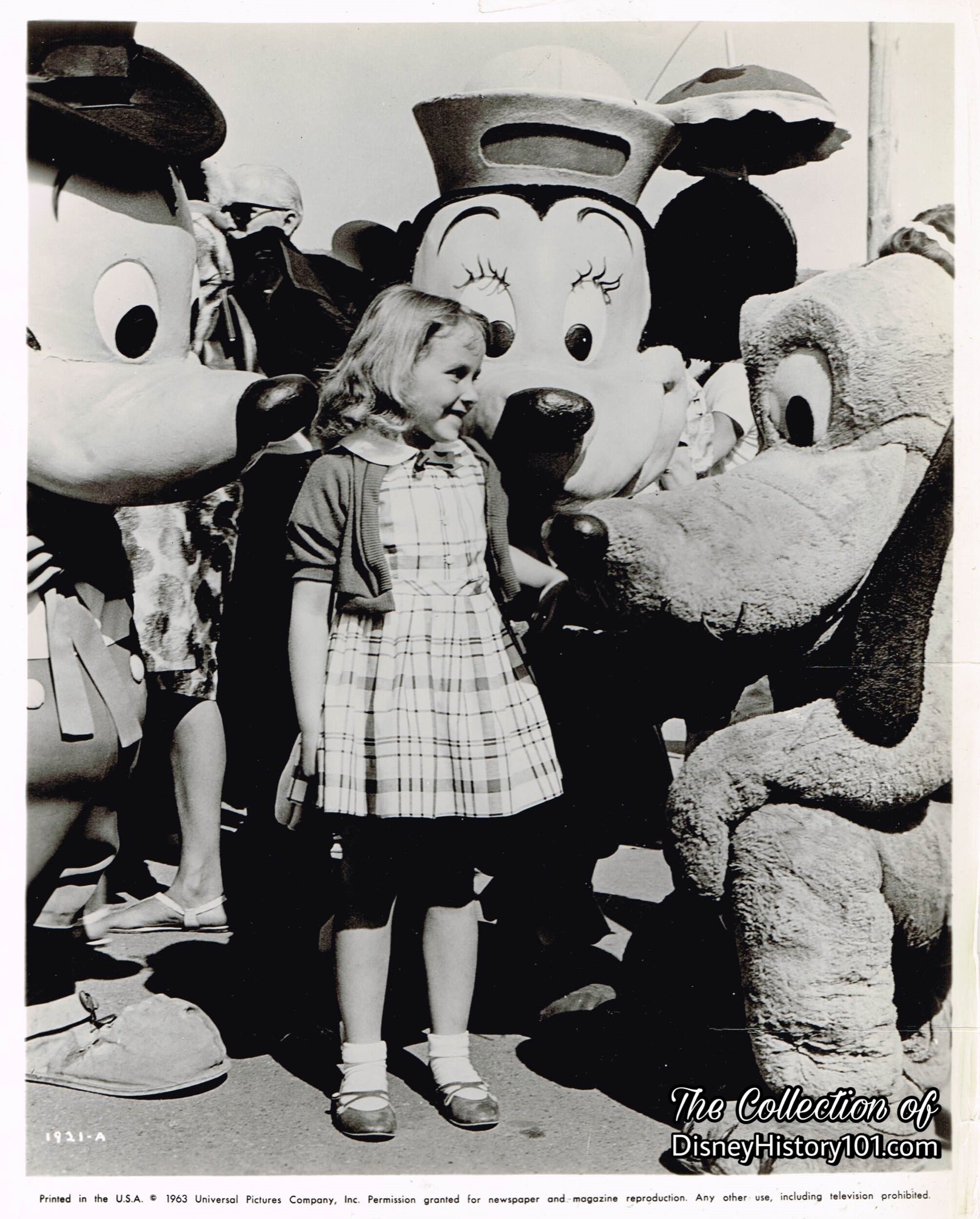
Standard Characters Mickey Mouse, Minnie Mouse and Pluto "create happiness" for a young guest, (1963)
Third incarnations of Mickey Mouse and Minnie Mouse (to appear inside Disneyland) greeted guests during the early 1960s. These “stouter” versions were reminiscent of Mickey and Minnie’s appearances in those popular American Motors Nash Automobile commercials (from 1955 to 1957). After a few years they were replaced by designs of Walt Disney Studios Character Department employees (Bill Justice and John Hench) and the creations of the Walt Disney Studio Wardrobe Department (overseen by Chuck Keehne), during the spring of 1966.
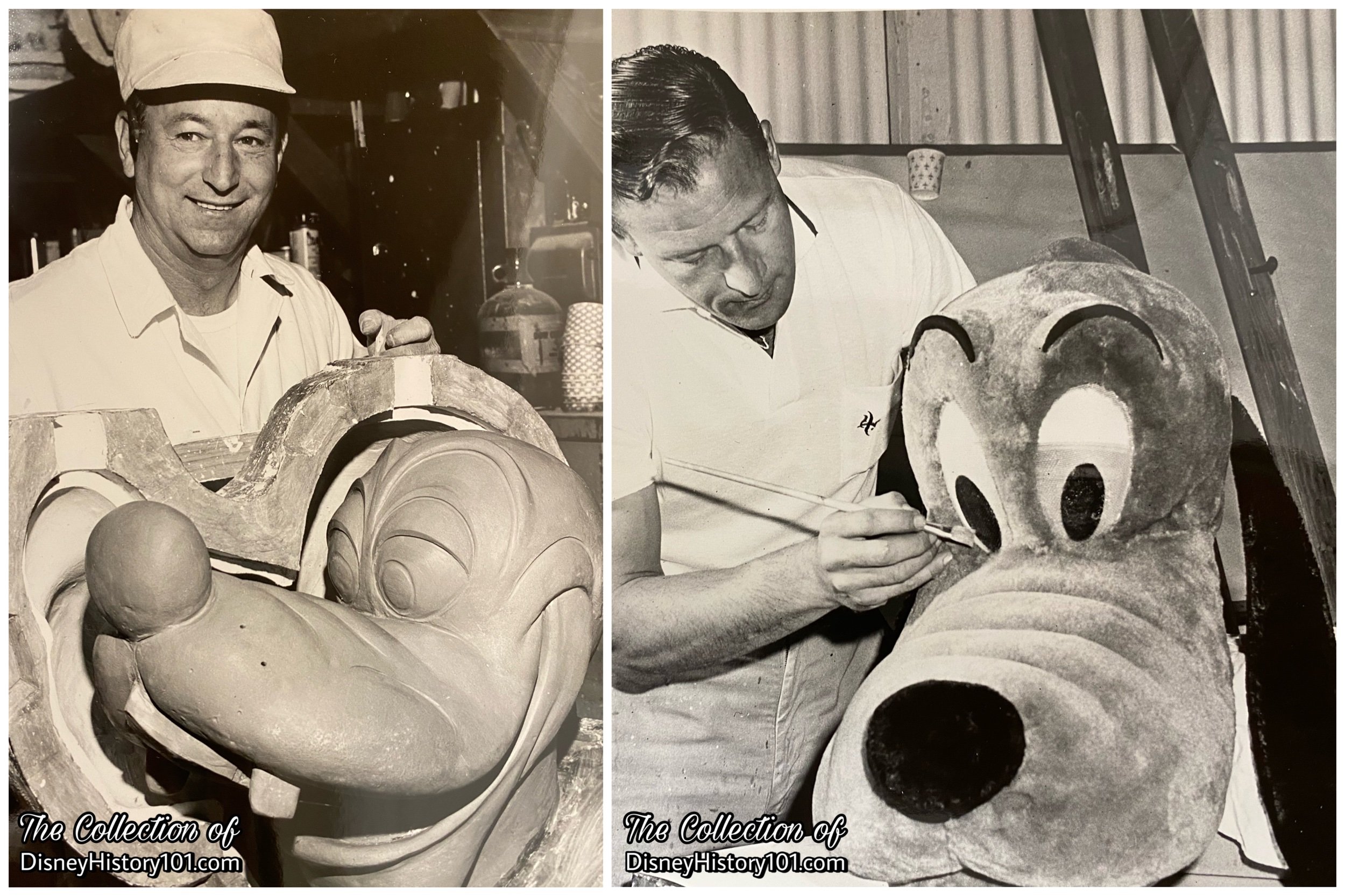
Show Documentation captures the creative intent.
All the Disney Character heads from Mickey Mouse to Robin Hood, were manufactured in the Staff Shop and Boneyard areas. The creation of a plaster cast, displayed by Joe Pasquesi of Disneyland model shop. Vinyl plastic is poured between head and cast to form master mold. That production mold (the final mold of the original sculpture) is used to create a fiberglass replica (left). A layer of fiberglass and plastic resin material is then applied to inside of mold to produce exact replica of clay head in light, durable material. A Defog solution was used on Plexiglas eyes in Character heads to keep them from fogging up.
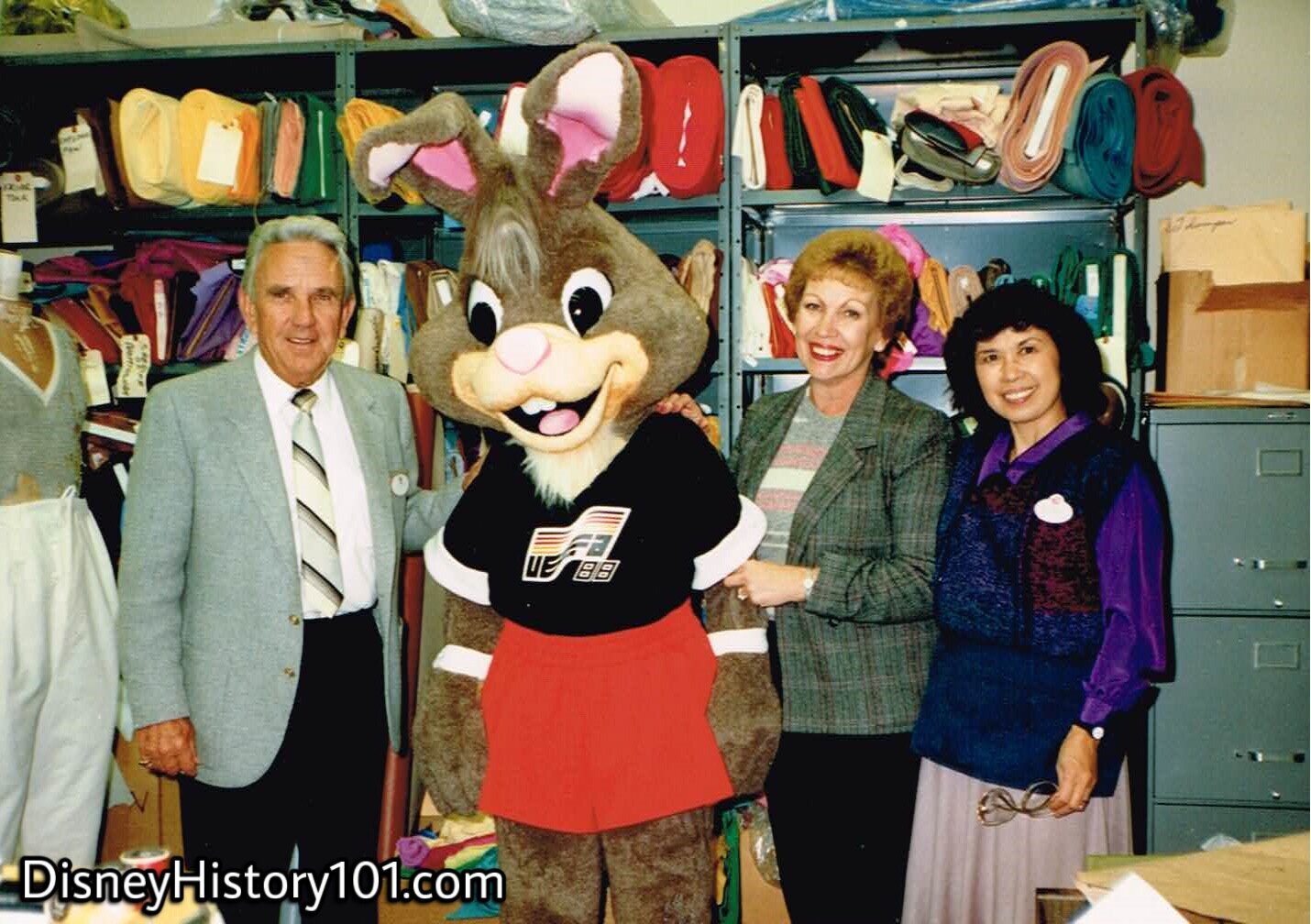
Bob Phelps (Costuming), "Rabbit" (a non-Disney, UEFA Rabbit Mascot), Phyllis Kerr (Character Costume Coordinator), and Shinko Mahaffey (Character Costume Coordinator), (c. 1980s)
”Establishing The Disneyland Entertainment Costume Department & Wardrobe”
With a greater demand for a growing cast of characters (to meet the parade schedules during the late 1960s), there was a greater need for a facility that was a little closer to home! Disneyland would finally establish its very own Costuming Department among its Entertainment Division.
It would be located in the Administration Building. Costumes would now be created entirely on site. Soon after Bob Jani became Head of Disneyland Entertainment, Bob Phelps left his job with Western Costume Company (where Disneyland Fantasy on Parade Costumes had been rented for years, as late as 1966), and became the new Disneyland Entertainment Costuming Department Director. When Phelps wasn’t presiding over DRC affairs, he was working for the world’s largest wardrobe department (comprised of 18 Costuming Department seamstresses and 35 Issuing Department employees). When Disneyland first opened, Cast Member Wardrobe worn by Hosts and Hostesses was provided by House of Uniforms (founded 1951, by Warren Ackerman), located in Beverly Hills. By the Summer of the Disneyland Tecennial, things had changed, with Lella Easton in charge of Disneyland Wardrobe. For example, costumes (as those worn why the Plaza Inn or Lincoln Exhibit hostesses) were designed at Disneyland, but then manufactured off-site locally or in places far away as San Francisco.
By 1969, Bob Phelps was located in a new office. The Disneyland Entertainment Costuming Department would soon provide more than 4,000 employees of Disneyland’s stage.
By 1975, George Williams (Mill Foreman) divulged: “We are very busy now making new wardrobes for the hundreds of Parade costumes. The wardrobes are made out of plywood and are very large to include room for the heads. Also, we do the maintenance of the Parade units and as there are a lot of breakdowns, we have to keep many carpenters available.”
By 1977 they were providing costumes for 18,000 costumed employees. By that very year of 1977, the Characters were typically designed and sculpted in clay by WED Enterprises artists. These designs were then sent to Disneyland Staff Shops, where full-scale versions were sculpted in clay, in order to cast molds. At this time, Plasterers of the Disneyland Staff Shop (like Lou Montero, Tom Mc Grath, and Foreman Wilbur Wise [who retired during 1977]) were responsible for Disneyland’s diverse and supportive props, including those used by Characters). These same Staff Shop technicians would also often sculpt and craft the Character heads during this time. Other Staff Shop employees (like Bob Johnson) would handle the body textures at the Taxidermy Shop. Lastly, WED Enterprises, Inc. designs were subsequently sent to the Paint Shop and Wardrobe departments for the remaining fabrication according to specifications. Additional laundry and alterations for the character “overdressing” (or, costumes) were also performed on site. Before the Show quality of a Character’s fur was affected by weathering or too many “love pats,” the Staff Shop had the remedy!
As for Bob Phelps, he also researched, designed, chose the fabric for, these “well-blended” costumes for Disneyland’s five magical lands! By the Fall of 1968, the department cared for “more than 40,000 outfits in nearly 400 different styles”. Phelps’ vast knowledge and experience contributed much-needed improvements to the department’s creation and care of these costumes. For example, Bob suggested that the character heads be stored on poles (rather than hangers) in the Character Headroom, so they would not get further damaged by elements of the “Zoo” storage area. Today, the utilization of Head Stumps (mushroom shaped fixtures situated in the Character break areas; used to hold Character heads) and Head Hooks or Head Hangers (hook shaped wire fixtures on hanging racks in the Character break areas used to hold Character heads between uses), owe their presence at Disney Parks to Bob Phelps. As a sidelight, Head stumps are occasionally equipped with a fan (or Blower inside to air out heads when not in use).
Also, the costumes would be inventoried, and safely stored in protective manners, within the new Wardrobe Facilities. Duplicates were also created in case the need rose to loan them for promotional tours, or for general backup. This was important during the early 1970s, as twice-daily Character Parades (from Fantasyland to its a small world) were a common occurrence!
Under Phelps’ supervision, Costume Designers like Tom Pierce and former Hollywood costume designer Jack Muhs were hired (during the late 1960s and early 1970s) to help design, renovate, and create anew, the Park’s needed costumes (as those of The Golden Horseshoe), including Character “overdressing” (or, costumes). The duo would become Senior Costume Designers for the Park.
As a “sidelight,” Jack would move on to produce unique Characters (as the “People of America” for “America on Parade” during the American Bicentennial celebration) for 22 years, before retiring December 31, 1991. As for Tom Pierce, he would continue to serve Disneyland in this capacity for 23 years, before retiring the very same day as Jack Muhs. Bob Phelps became Wardrobe Director for Walt Disney World.
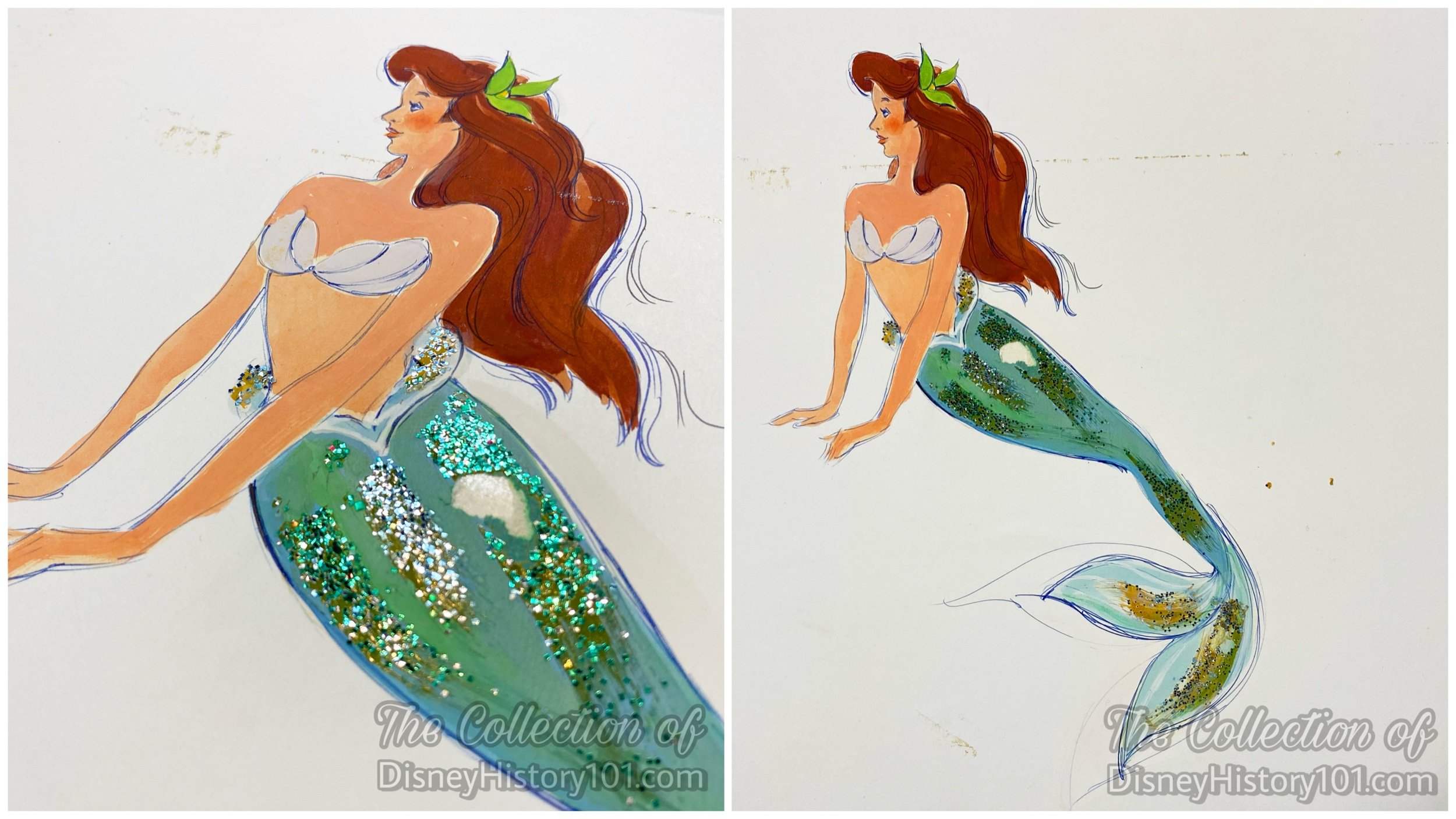
A concept of the first Ariel Face Character costume by Alyja Paskevicious Kalinich.
In time, Bob also hired the legendary female designer Alyja Paskevicious Kalinich (1979-1999) to assist with Disneyland overdressing and costume designs (long before she temporarily relocated to Walt Disney World to assist with design of its Operational and Entertainment costumes).
As mentioned, promotional tours were performed for the release or re-release of a Walt Disney Production. Sometimes, characters were join the tour. As you read through this section, notice the Dumbo Promotional Tour, the 101 Dalmatians Tour, and the Jungle Book Promotional tours, where some new characters debuted!
New characters were created as new Walt Disney Studio feature films or Walt Disney Television animated shows were produced. The Entertainment Costume Department has even been privately contracted to create non-Disney characters from time to time over the years (as pictured above).
As of Disneyland’s 50th, there were 20,000 Cast Members bringing the Disneyland show to life (but only a small fraction of these were involved in the Entertainment Department).
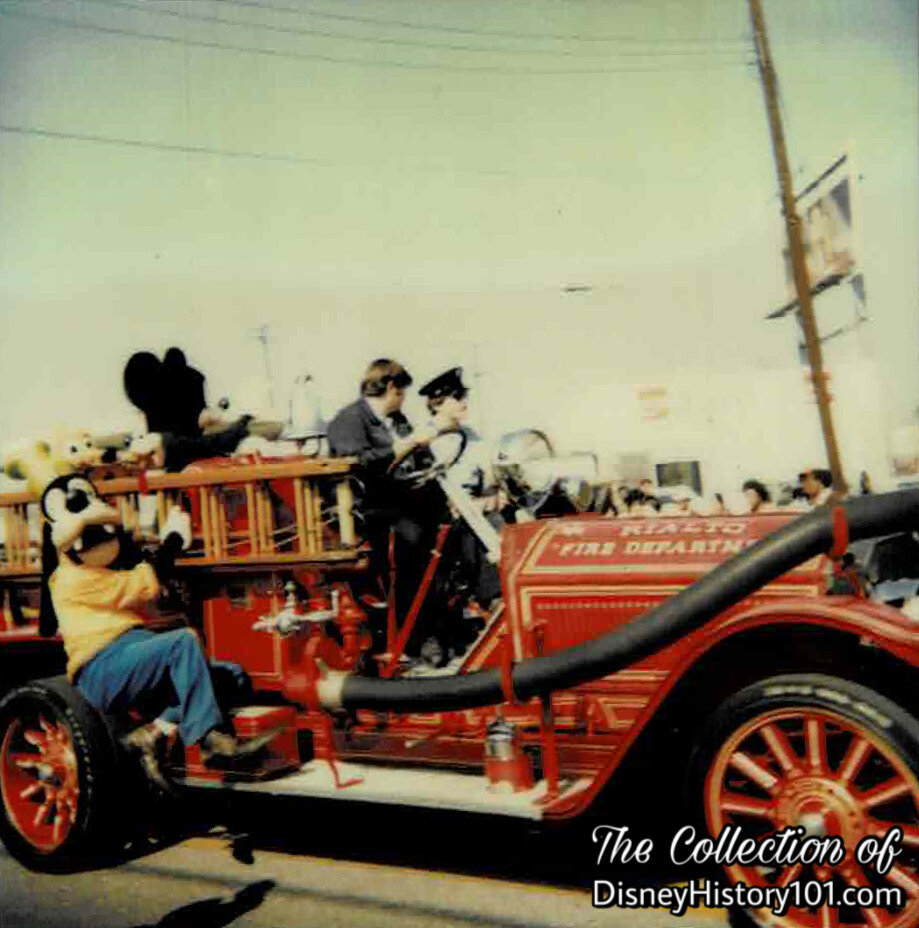
Mickey and a "stowaway dog" aboard an antique City of Rialto Fire Engine.
The Disneyland cast of Characters continued to support a positive Disney image by making public appearances (like this appearance in an unknown parade aboard an antique City of Rialto Fire Engine).
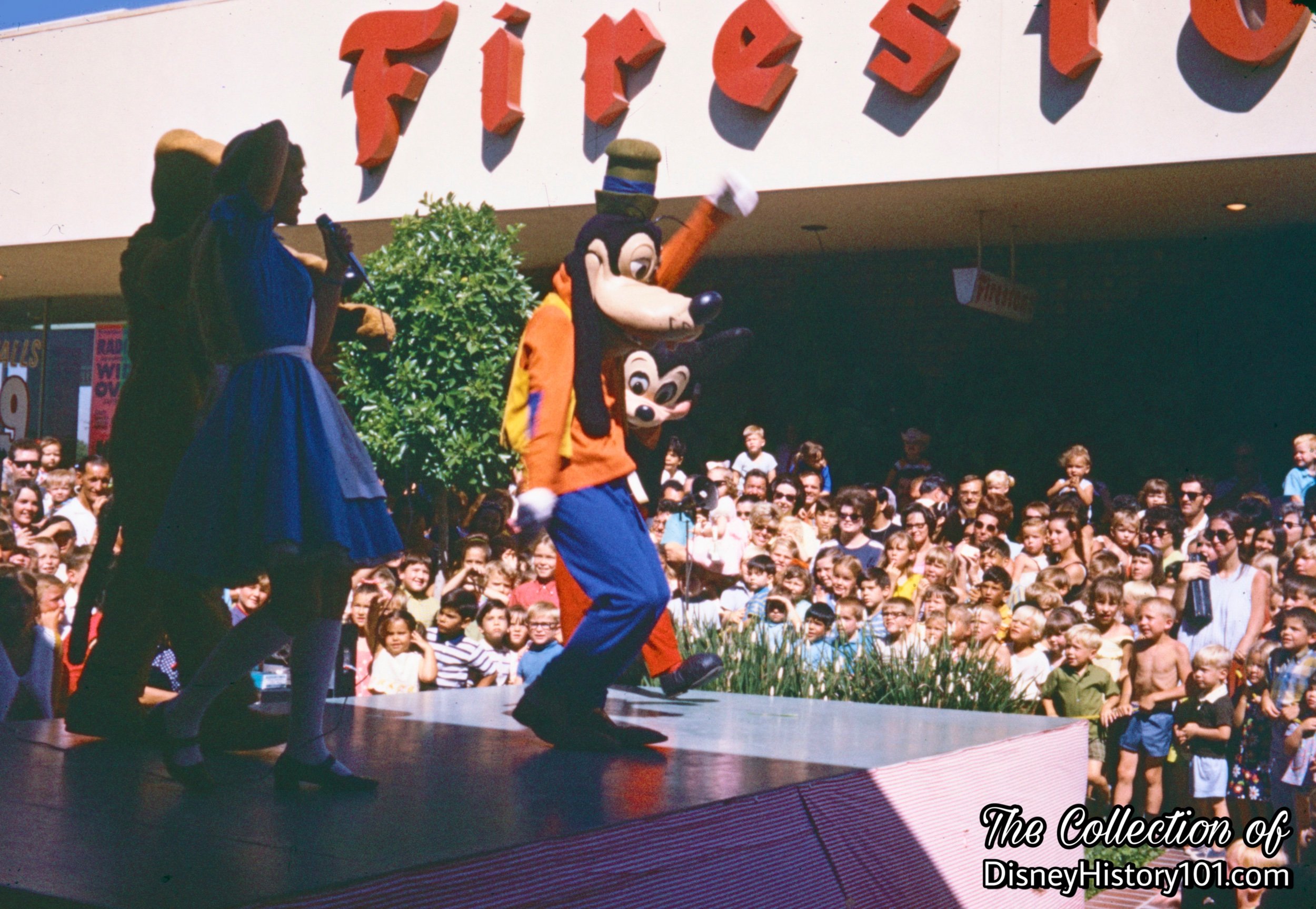
Disney Characters support a “Good Show” - a positive Disney image outside Disney Parks.
“Operating Guidelines”
Disney Characters effect a Good Show when the Cast Member understands the (1) Story (2) How It's Done, (3) On Stage Try-Out, and (4) Work and Practice.
Operating Guidelines - rules and regulations set by the company dictating expectations both on stage and back stage have come to influence the Disney Character. For instance, Character actions are often animated to coincide with a Character’s personality. In recent decades, Disney Character animation (movements and routines) have become more choreographed.
By the 2000s, additional garments had been added to the Cast Members in Character roles. On Stage, Skull Caps (surgeon's caps) were worn under a Character head to keep hair from falling into the performer's face. Paw Pad costume pieces (or inserts) were worn to fill out the paws of Characters (like Pluto). Off Stage (on break), Smocks (blue overcoats) were worn over face role or face Character costumes while eating, drinking, smoking, and sitting.
Of importance is the role of the Character Attendant. The Character Attendant assists the Character Performer, aware of situations relating to safety and show quality (i.e. managing Guest interaction, limited vision of Characters, frightened children, and the inappropriate actions, questions, or requests of some Guests).
Now, let’s take a look at the diverse characters and entertainers that have enhanced Disneyland’s show through the decades! You won’t need to Download the mobile app to access character greeting locations and times. Through our tour, we’ll see multiple versions of some familiar faces, and even get to know some of the individuals who were “close” to some of these beloved characters, animating and giving life to them while cast in “roles” to produce/present the DISNEYLAND Show!

In This Section :
•Aladdin - Aladdin made his debut in Disney’s Aladdin released November 25, 1992. Aladdin is a Disney Face Character who can talk, communicate with Guests, and create magical Disney experiences for them.
•Alice (Alice in Wonderland) - Walt Disney’s first come-to-life Alice stepped onto the silver screen in the Alice Comedy “Alice’s Day at Sea,” released in 1924. More than two decades later, Walt Disney’s adaptation of Louis Carrol’s Victorian Alice character made her feature-length theatrical film debut on July 28, 1951.
A few years later, Alice in Wonderland characters would “come to life” at Walt Disney’s Disneyland Disneyland! Donna Jackson, of guest relations, was the first to portray Alice in the bell telephone hour. When the Alice in Wonderland attraction opened, it was accompanied by a Grand Opening Parade held on July 14, 1958. Mouseketeer Karen Pendleton portrayed the popular Alice character from the 1951 animated feature-length film. Since then, Alice is a Disney Face Character who can talk, communicate with Guests, and create magical Disney experiences for them. has been portrayed by a number of individuals who worked for Disneyland!
DONNA JACKSON of Guest Relations was asked to play the part of Alice-In-Wonderland for a scene to be used on the Bell Telephone TV show which was taped at Disneyland in November of 1960. The Disneylander reported: “Anxious to speak her only lines with expression and exactness, Donna began, ‘Once upon a time, there lived a whale named Pinocchio who swallowed a little boy called Monstro…’”
During the summer of 1961, Alice often appeared in parades (occasionally portrayed by Space Girl Donna Fox), alongside her Wonderland companions - the Mad Hatter and the White Rabbit. On November 25, 1961, Alice (portrayed by Donna Fox) would help host the 3rd Annual National Pop Warner Disneyland Bowl Football Festival held at La Palma Stadium in Anaheim, California!
Alice also hosted the 9th episode of “Meet Me At Disneyland” (airing on ABC), in August of 1962. Venita Wolf (1962 Orange County Press Club Queen) filled the role of Alice in the Disneyland Show. Also in August of 1962, Lloyd Richardson, Larry Clemmons, Joe Marquette, Coy Watkins, and Jack Leppert (of the Walt Disney Studio) filmed and shot scenery for Studio Production #3185. During this visit, a plate was shot with “Alice in Wonderland” and six others Characters in front of the castle.
Selma Littlejohn portrayed Alice for the Fall of 1964, when many new Disneyland Characters debuted at Disneyland! During 1964, through a special business arrangement with Al Dobritch (of the Dobritch International Circus), Alice and her co-stars appeared in traveling circus acts.
Alice was part of the Pre-game “Walt Disney and Disneyland Salute to the California Angels” at the new Angels Stadium on Saturday, April 23rd, 1966!
Alice was also featured in a Look Magazine photo shoot (in conjunction with new Disneyland 3-D post cards) along side six other “Disney Characters”, at 10:30 a.m., on May 23, 1966.
Yvonne Hudson portrayed Alice around the summer of 1966.
Shelley Meyer was close to Alice, during Disneyland’s “silver anniversary year” of 1980. “Shelley missed a Park audition for a gymnast a few years ago, but she was given the opportunity to try out for Alice as a substitute. With her long, blond hair and big, blue eyes she was a natural choice for the part - - it wasn’t just a coincidence that Alice had always been her favorite story book character. As a Character that can talk to guests, Shelley has a difficult job to remain in Character and have all the right answers that children ask her as Alice. However, Shelley has a chance to be creative and imaginative as a speaking Character and has been highly successful, as evidenced by the many complimentary letters the Park receives about her portrayal of Alice.” [Disneyland Line, January 31, 1980]
•Ariel - Ariel made her debut in The Little Mermaid. She is one of King Triton’s seven daughters and her sisters are Adella, Alana, Andrina, Aquata, Arista, and Attina.
Owing to Alyja Kalinich (Disneyland Character & Entertainment Costume designer from 1979-1999), Ariel first came to life at Disneyland and the Walt Disney World Magic Kingdom. Ariel is a Disney Face Character who can talk, communicate with Guests, and create magical Disney experiences for them. When she isn’t going for a swim with Flounder, Ariel can be found at Disneyland.
According to “Fantasy Faire - Just Got Happier”: “Ariel was once a mermaid who lived in the underwater kingdom of Atlanti-ca. She had a knack for getting into trouble, and often lost track of time as she explored the sea with her friends Flounder and Scuttle. Ariel was so fascinated by the human world that she sought out a magic spell to transform her into a human! Once on dry land, she met her true love, Prince Eric - who married her and with whom she'll live happily ever after!”
•Aurora (Sleeping Beauty) - Aurora (Briar Rose) with significant contributions by Marc Davis, appeared in Walt Disney’s Sleeping Beauty. According to “Fantasy Faire - Just Got Happier”: “Bestowed with the gifts of beauty and song, Princess Aurora is a young lady who has been loved since the day she was born - from her family and the three good fairies who hid her from the evil Maleficent, to the brave Prince Phillip who fought to rescue her. Together they prove that, with a little faith and love, dreams can become a reality.” Princess Aurora owns the castle at Disneyland Paris.
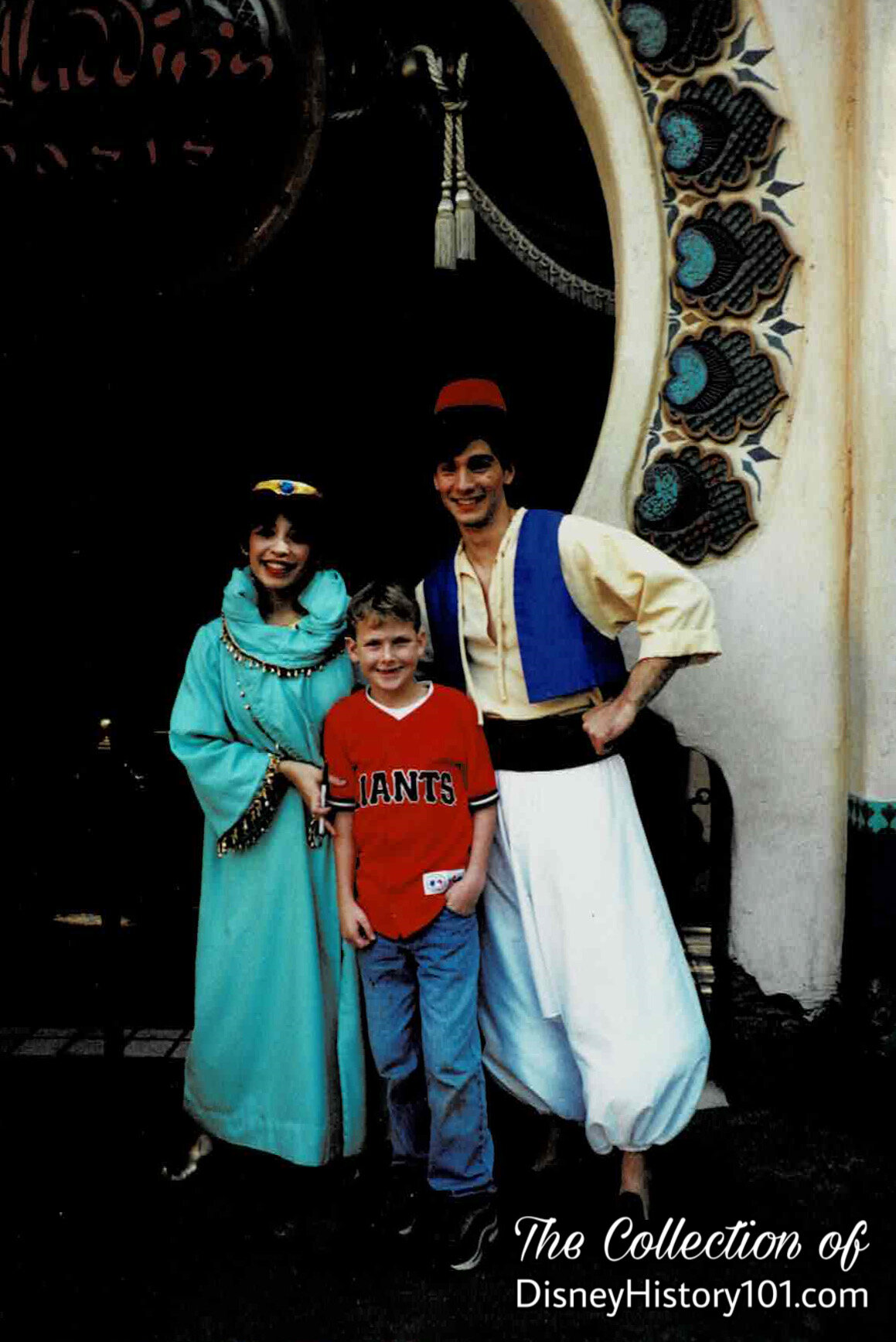
Aladdin and Jasmine
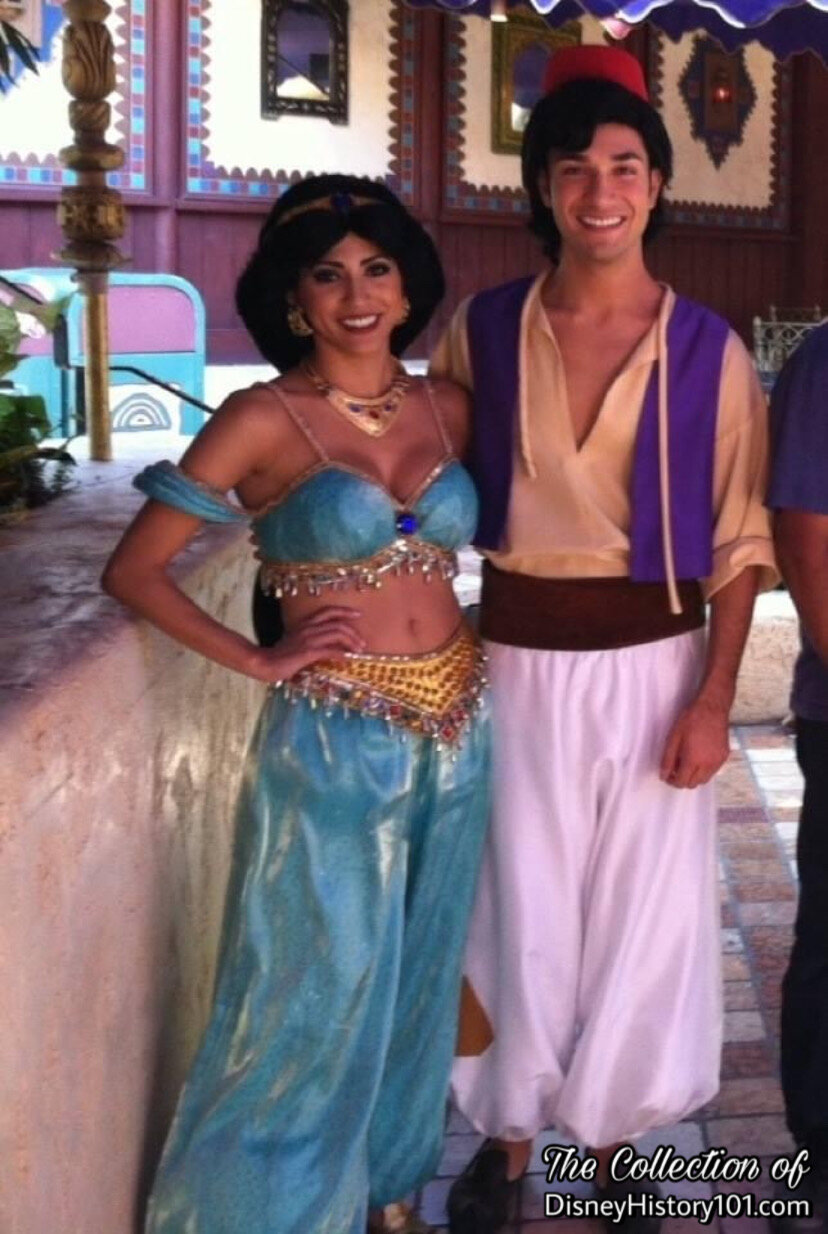
Aladdin and Jasmine extend courteous smiles toward Guests
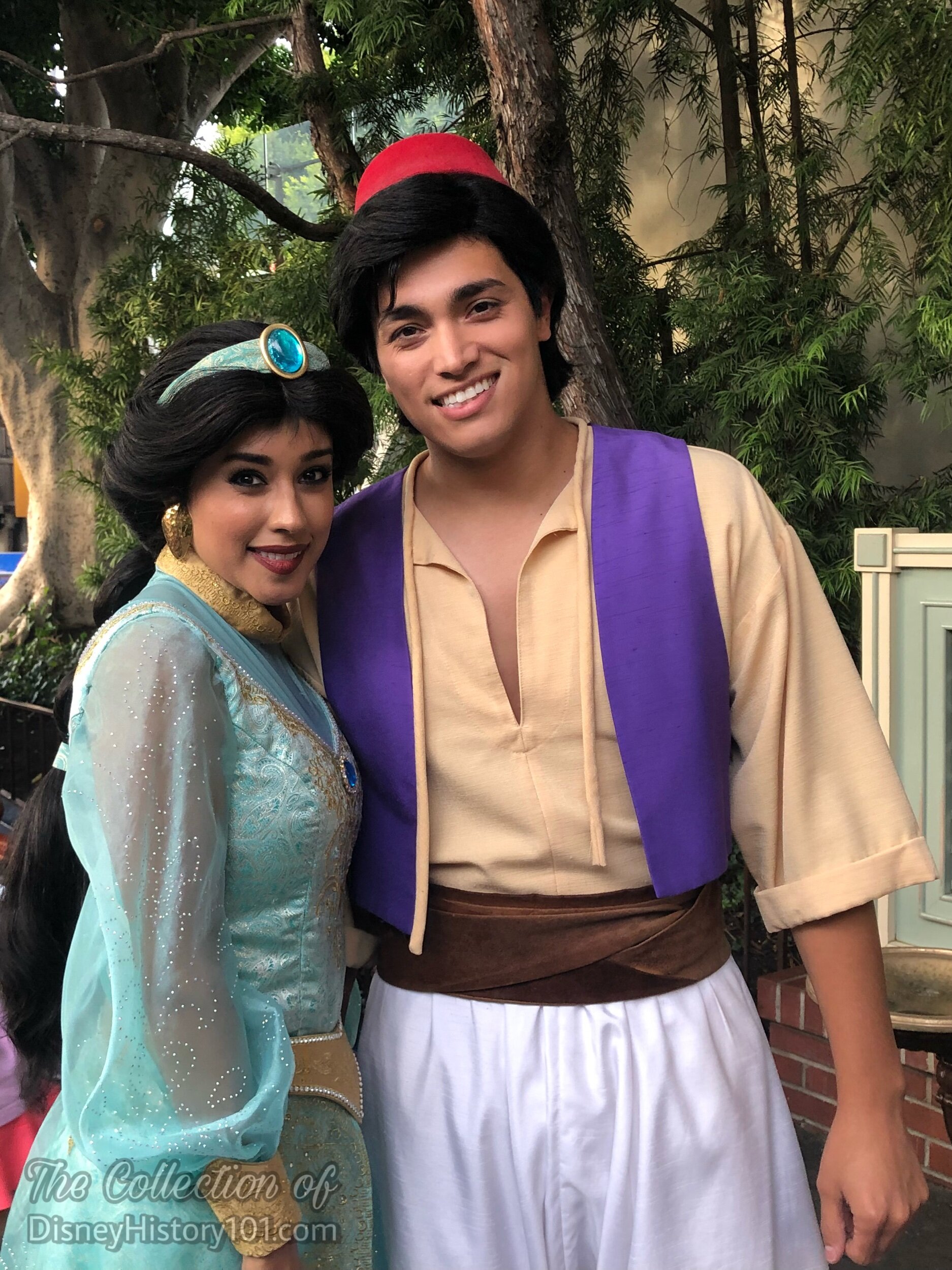
Aladdin (and Jasmine) extend courteous smiles, 2019

ALICE, (1958 - present)
Above Photo : “No chasing ‘White Rabbits’ for these two” - Alice (portrayed by Nancy Winston) and the Hatter skip gaily through Fantasyland, without a schedule to follow, c. early 1960s


ALICE, (1964)
Here, Alice, the White Rabbit, and the Mad Hatter appear in the 1964 Pancake Races Parade. This very trio also appeared on a 1965 Disneyland Donruss collectible card #12.

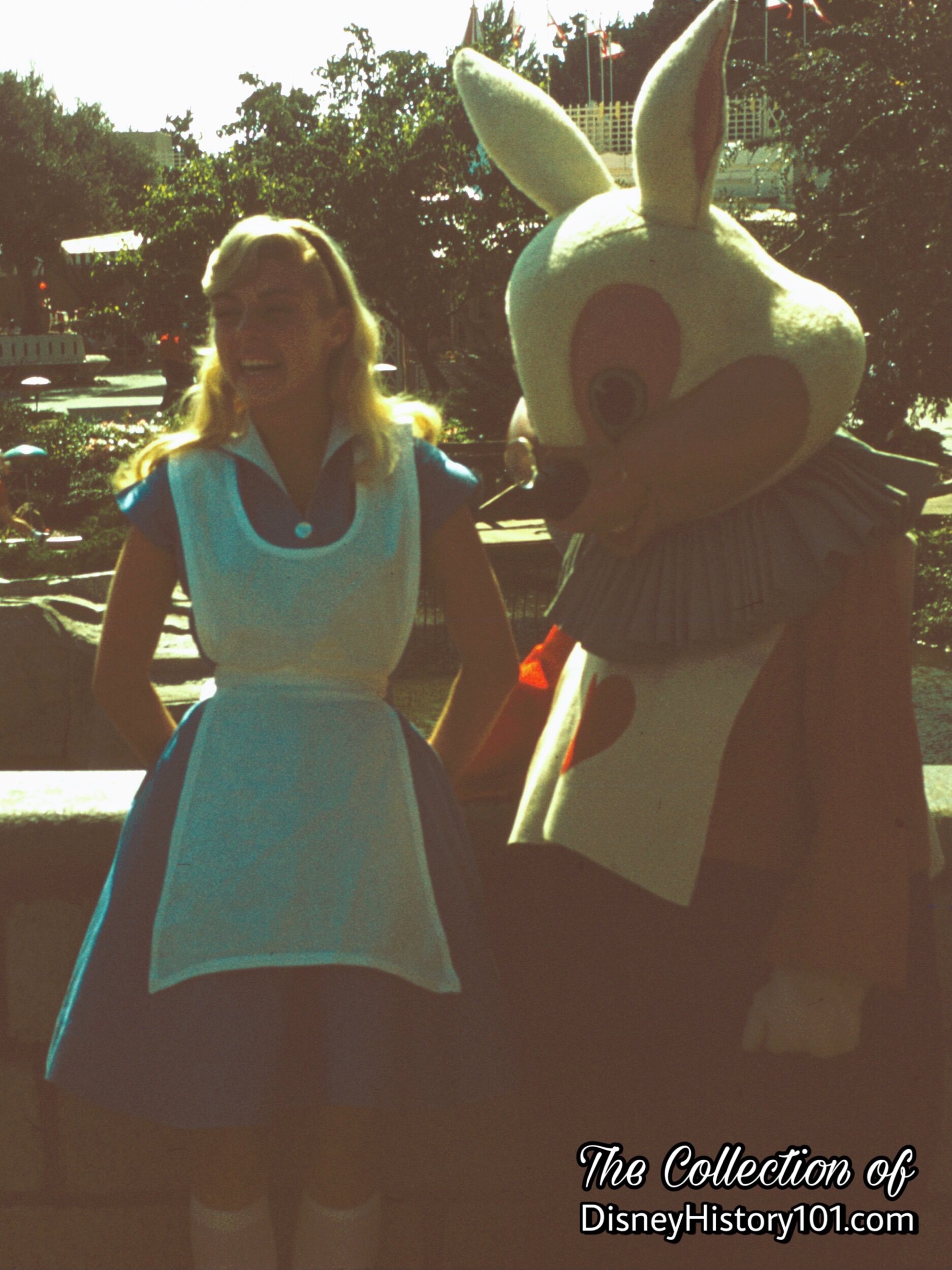
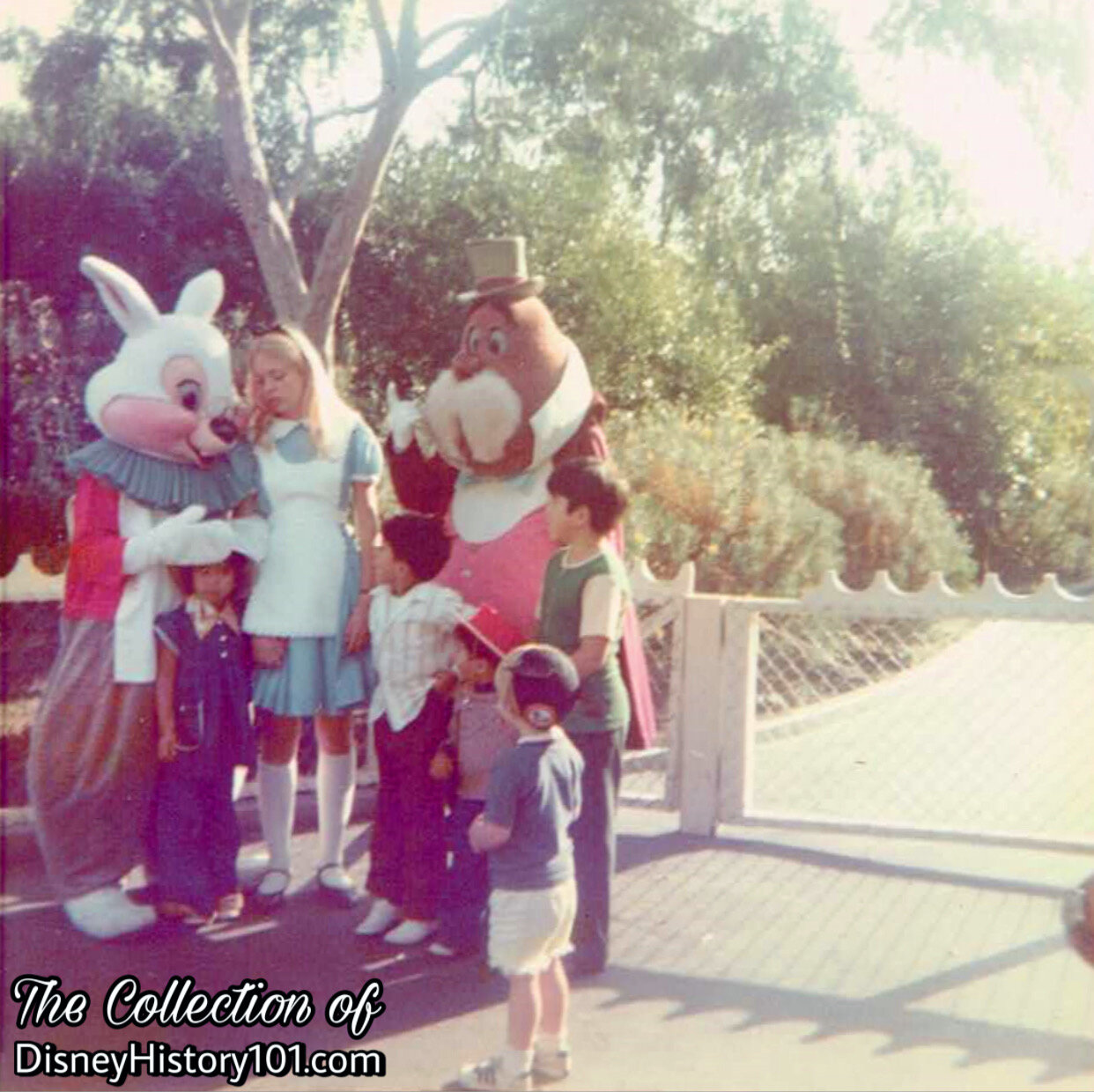
ALICE, WHITE RABBIT, WALRUS
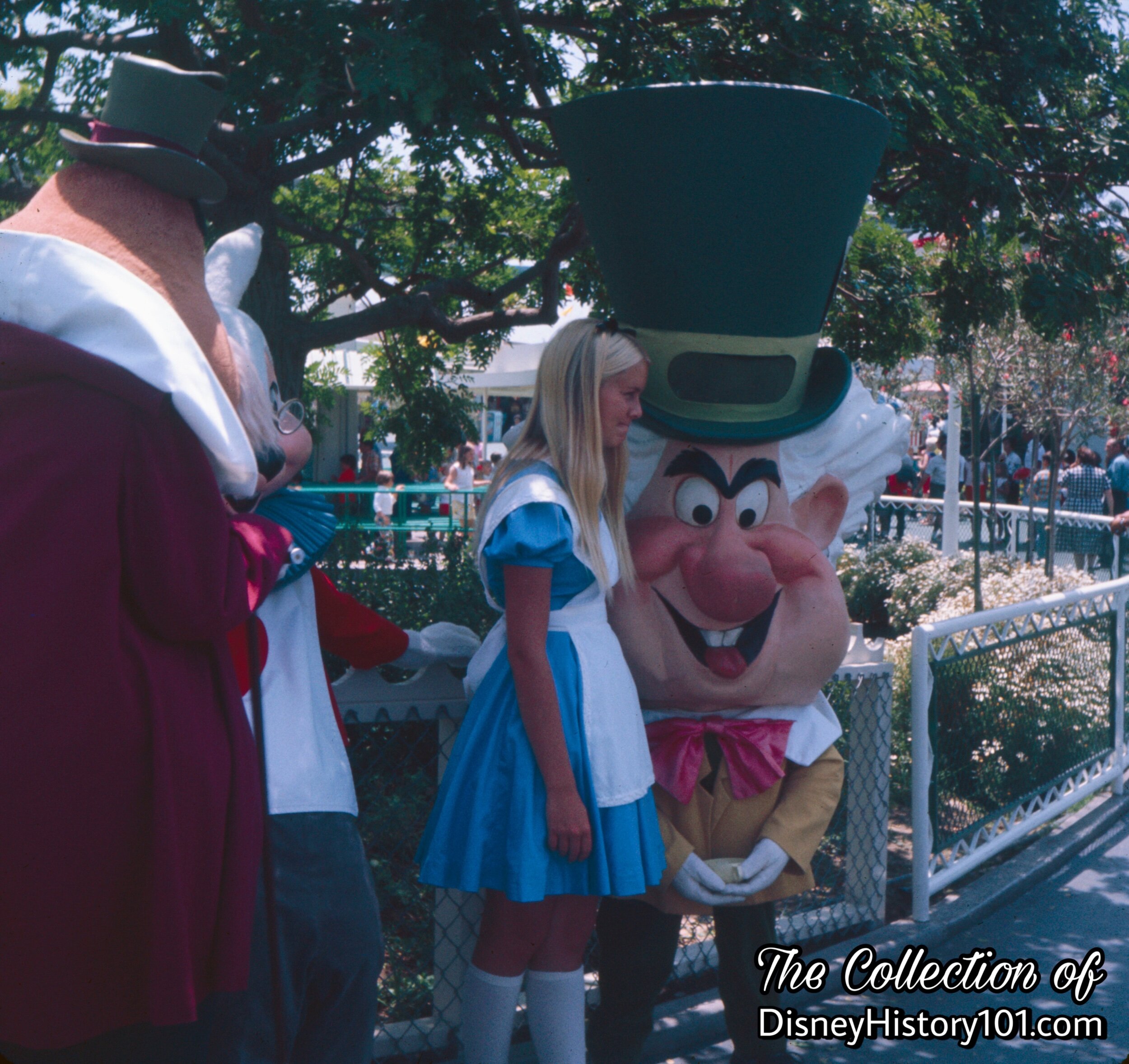
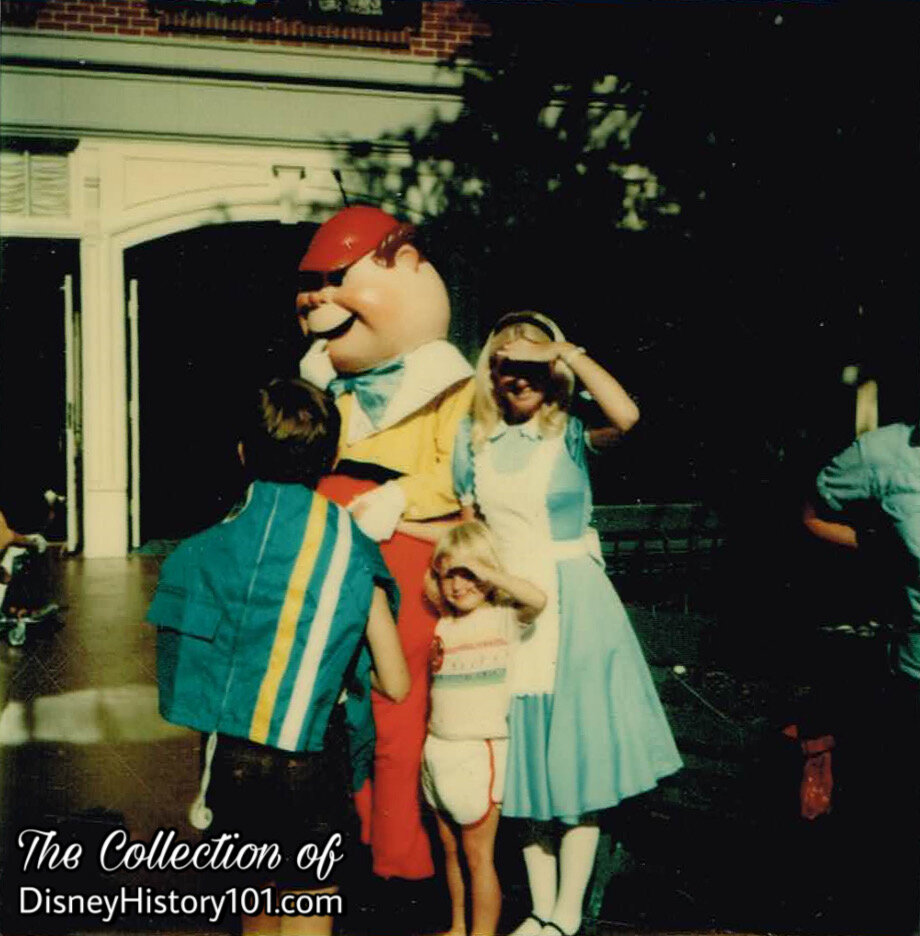
ALICE and TWEEDLEDEE
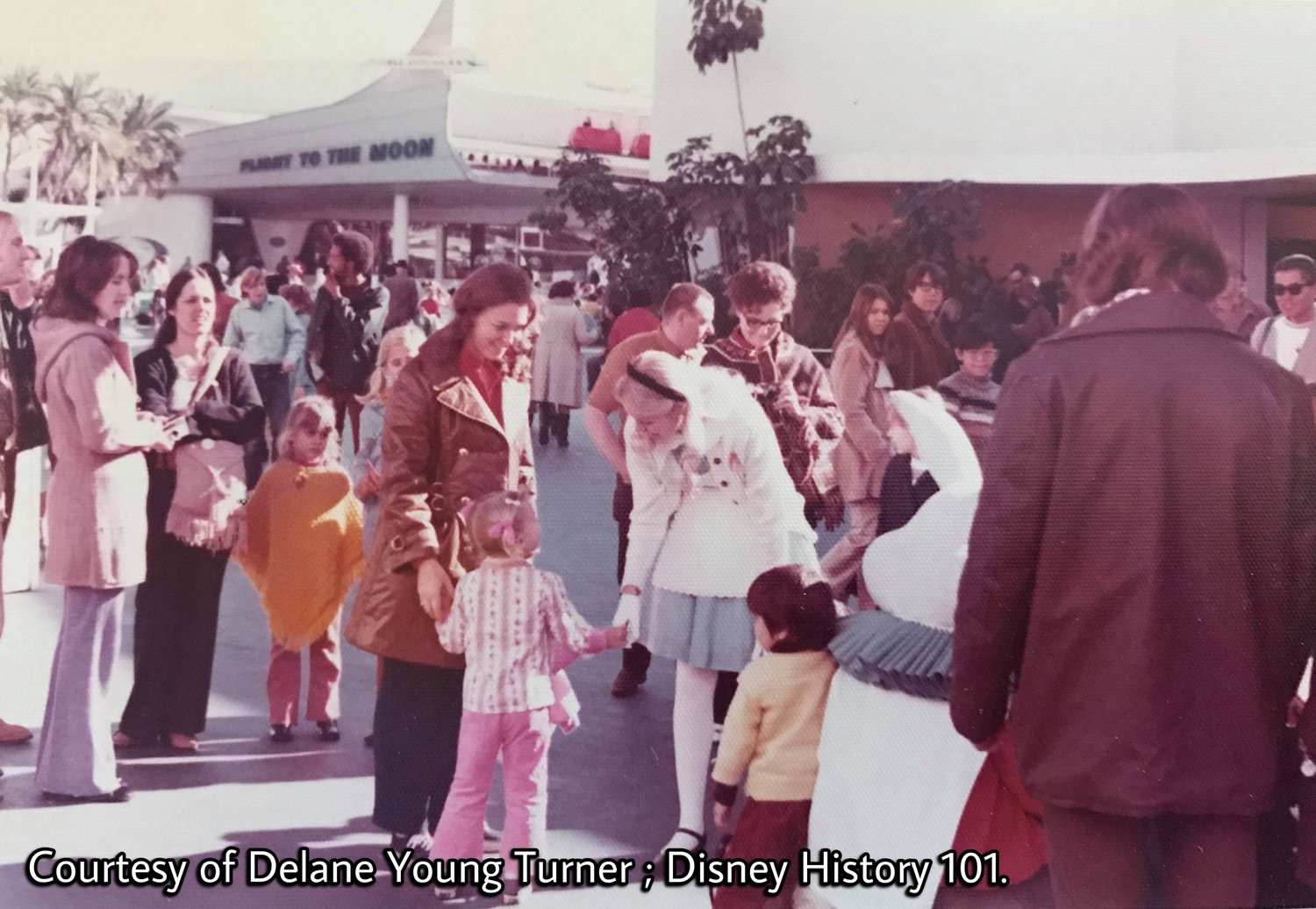
ALICE in Tomorrowland, (1972)
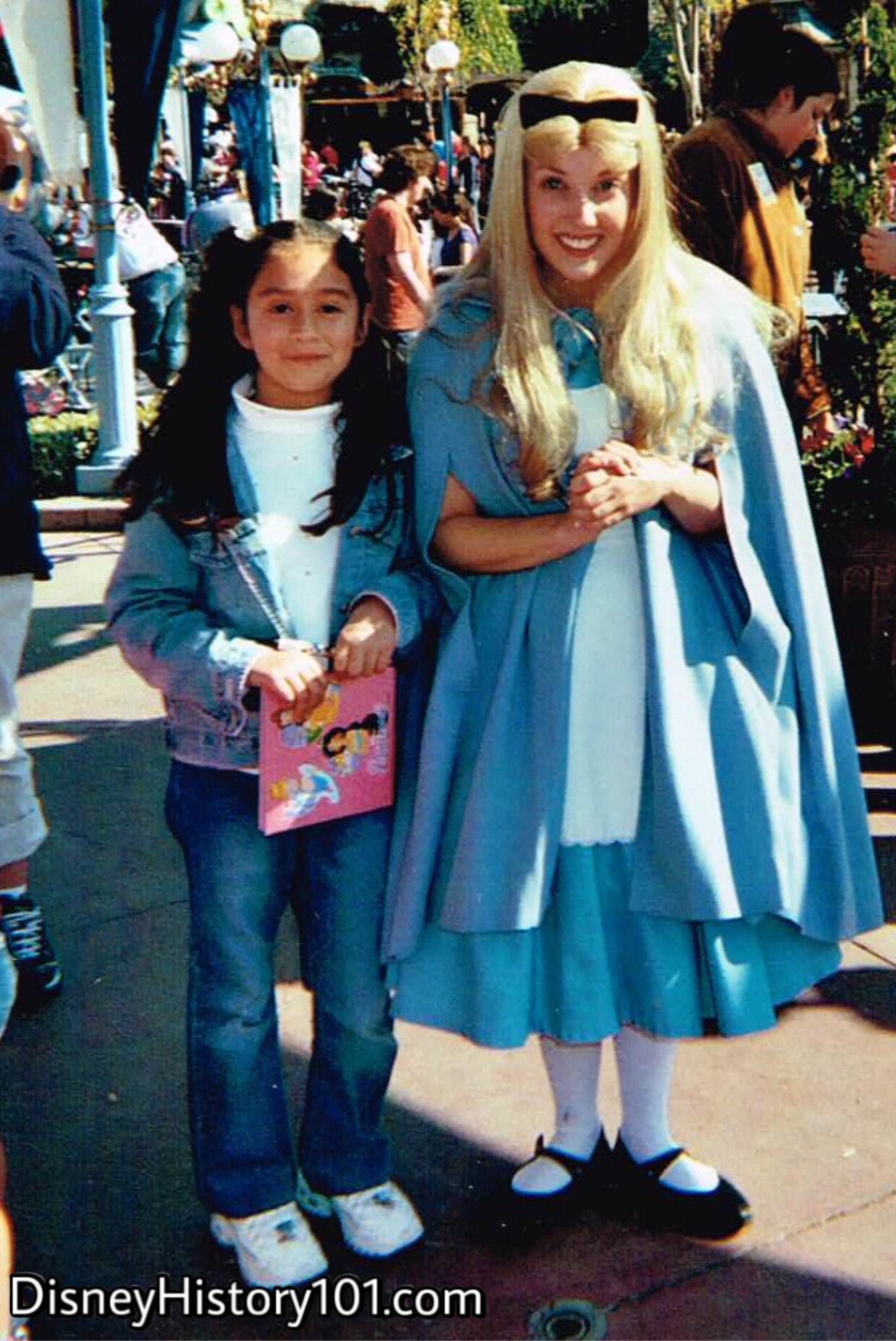
ALICE "preserves the dream" for a young Guest, c. 1990s.

In This Section :
•Baloo (Jungle Book ; Tale Spin) - During October of 1967, many meetings were held between Ben Harris (Entertainment) and the Disneyland Staff concerning the new Characters and Walt Disney’s Jungle Book film Premier. Baloo first debuted during The Jungle Book National Tour, which lasted 26 days (from November 5th thru November 30th, 1967). Disneyland Entertainment Department employees Lee Reineke and Ben Sherman were “Pageant Helpers” who very close to Baloo and King Louie during the tour of several cities. Twenty-two locations visited included Atlanta, Baltimore, Boston, Buffalo, Chicago, Cincinnati, Cleveland, Dallas, DC, Denver, Detroit, Houston, Indianapolis, Miami, Milwaukee, Minneapolis, New Orleans, Philadelphia, St. Louis, Salt Lake City, San Francisco, Toronto, and Washington. Mike Lopez and John Lopez were close to Baloo and King Louie during this tour.
Then, the “Jungle Book Parades” (consisting of Col. Hathi, Baloo and King Louie) with the Disneyland Band made regular appearances in Adventureland, greeting guests as part of the Character Program, “throughout the Christmas Holidays” (daily between parades, from 9:00am to 11:45am). [“Disneyland Holiday Talent Master Schedule,” prepared for the period of December 16, 1967 through January 1, 1968] “Disney News” (Winter 1967-68) soon reported: “Jungle Book’s stars Baloo the bear, King Louie the ape and Colonel Hathi the elephant will make their first appearance this year.” Popular Dutch singer Heinje Simons visited Disneyland during 1967 (likely during this season), and took many photographs with both Baloo and King Louie.
During the 1970s, Baloo appeared in Main Gate/Town Square. He also made appearances around 1972, at “mix in” and “Regular Private Parties” (first five hours of party beginning 15 mins. prior to the gate opening of each party).
When he isn’t having a play date with Mowgli, Baloo can be found at Disneyland.
•Bashful (Snow White and the Seven Dwarfs) - Ever since the summer of 1961, the second incarnation of Bashful made daily appearances (at times) in Disneyland!
•Beast - Beast and Belle appeared in the “Beauty and the Beast” show five times a day (through the summer season of June 19 - September 13, 1992) at Videopolis in Fantasyland.
•Belle (Beauty and the Beast) - Beast and Belle appeared in the “Beauty and the Beast” show five times a day (through the summer season of June 19 - September 13, 1992) at Videopolis in Fantasyland. Belle is a Disney Face Character who can talk, communicate with Guests, and create magical Disney experiences for them.
According to “Fantasy Faire - Just Got Happier”: “Belle is a headstrong, intelligent young woman with a kind heart. Her love of reading helps her escape the small town life of her provincial French village. Each new book is a source of escape and adventure for Belle. Now that she has found the Beast and her enchanted object friends, she shares her adventures with them and has a new sense of home.”
•Bernard (The Rescuers) -The Rescuers was released June 22, 1977. That same year, Bernard, Bianca, and Orville made their Disneyland debut! It wasn’t until late 1977/early 1978, that Mickey Mouse welcomed the stars of The Rescuers to the Magic Kingdom in Florida.
•Bert the Chimney Sweep (Mary Poppins) - Bert the Chimney Sweep made his theatrical debut in Walt Disney’s Mary Poppins on August 21, 1964. Bert is a Disney Face Character who can talk, communicate with Guests, and create magical Disney experiences for them.
•Bianca (The Rescuers) - See Bernard
•Big Bad Wolf (Silly Symphonies) - The Big Bad Wolf made his film debut on May 27, 1933, as a “professional bad guy and pig chaser.” He debuted at Disneyland during the summer of 1961, alongside new incarnations of the Three Pigs (seen here)! They were all part of “the Happiest Show on Earth”!
Also in August of 1962, Lloyd Richardson, Larry Clemmons, Joe Marquette, Coy Watkins, and Jack Leppert (of the Walt Disney Studio) filmed and shot scenery for Studio Production #3185. During this visit, a plate was shot with “Big Bad Wolf” and six others Characters (including the Three Pigs) in front of the castle.
After some sort of hiatus, the Disney Character made a return during the winter if 1962. According to the Talent Schedule “All of our regular Characters, plus a return visit by the 3 Pigs and Wolf and Pinocchio, J. Worthington Foulfellow and Gideon, will highlight this year's Holiday Season.”
The Big Bad Wolf was part of the Pre-game “Walt Disney and Disneyland Salute to the California Angels” at the new Angels Stadium on Saturday, April 23rd, 1966!
The “Wolf” made regular appearances at the “Small World”Area, greeting guests as part of the Character Program, “throughout the Christmas Holidays” (daily between parades, from 9:00am to 11:45am). [“Disneyland Holiday Talent Master Schedule,” prepared for the period of December 16, 1967 through January 1, 1968]
A number of Cast Members were “close” to the Big Bad Wolf. However, contrary to rumor, Ringo Starr was not one such individual.
•Big Thunder (Mountain) Breakdown Boys-The Big Thunder Mountain “Breakdown” Boys performed their bluegrass melodies from Frontierland throughout the 1980s (c.1986). The group featured Doug Mattocks (banjo), Raul Reynoso (mandolin), Charlie Warren (bass), John Jorgensen (guitar). When John left the group to pursue his career, Paul Shelasky would join the group. Years later, Doug Mattocks and Charlie Warren would continue to perform at Disneyland and Disney’s California Adventure Park.
•Billy Hill (and The Hillbillies) - According to Dave Smith (Chief Archivist Emeritus of The Walt Disney Archives), “Billy Hill and the Hillbillies began appearing as atmosphere performers in Critter Country and Frontierland in May 1989. They then moved to the Golden Horseshoe on June 8, 1993, where they proudly noted their ten thousandth show in February 2003. After performing at Big Thunder Ranch Jamboree, according to the Disney Parks Blog, they had their final show on January 6, 2014.” [Disney Facts Revealed by Dave Smith, 2016]
More to come about Dennis Fetchet (occasionally Farley the Fiddler) and others of this group.
•Black Bart (Frontierland) - Founder and Professor Emeritus of the University of Disneyland, Van France once said: “In a theater, when there are more people in the audience than seats, there is ‘standing room only.’ At Disneyland, when the people outnumber the ride capacity, the ‘standing’ is done in long, frustrating lines. Since we didn't have the money to create expensive attractions, we had to find innovative, inexpensive ways to keep the guests entertained. Live shows and free attractions provided entertainment for the guests at a time when we didn't have adequate capacity or attractions to handle them.”
Like most good westerns, there were good guys and bad guys. Around these parts, bad guys didn’t get more nefarious than Black Bart! As far back as the fall of 1955, gunshots would ripple through the placid Frontierland air, as the Golden Horseshoe’s receipts were robbed by the baddest guys in the wild west. Outside the Golden Horseshoe, Sheriff Lucky and a character known only as the “Villain” held “showdowns” most days, on the hour. The “roaring gun battles” took place from 11a.m. to 7 p.m., right in front of the Golden Horseshoe Saloon!
Over the years, Frontierland’s various Marshalls would pursue a number of “old west” villains like Pecos Bill and Black Bart the Crooked Gambler. Some of the “bad guys” were portrayed by the likes of George Brent, Bill Hazel, Ray Lanier, and Noah Morrison. Chases would take the duo from the Chicken Plantation to the Frontierland Train Depot, and from the steamer docks to the roof of the Casa de Fritos and even the outskirts of Rainbow Ridge.
The “crookedest card shark West of the Monongahela” can usually be found strolling the landing, as he sizes up a “mark” for his questionable playing card talents. When Black Bart isn’t twirling his finely waxed mustache or goatee while being taken alive, he spends much of his time announcing the arrivals and departures of the Mark Twain as well as presentations of the Golden Horseshoe Revue! Jim Quigley recalled: “My paycheck or your life!” roared BLACK BART as his Colt 44 thundered in Jim's Payroll office. That's how gunslinger, BLACK BART, used to collect his paycheck each week.”
Van France recalled “Our regular gunfight shows were fun for guests who might otherwise be standing in a line. We could get double duty out of two men assigned to Security Black Bart had no trouble playing an old time robber, since he was sort of a sleazy type by nature. Sergeant Lucky was an easy-going, friendly man who could play the good sheriff when he and Black Bart had their regular shootouts in front of the Golden Horseshoe. Unfortunately, they wanted the rates of Hollywood stunt men, and their shows finally bit the dust during one of our frequent budget cuts.”
While the gunfights ended around 1963, the Character was so popular that he had a legacy (of sorts) in the Riverboat Gambler, who appeared as late as 1987!
When the Magic Kingdom opened at the Walt Disney World Vacation Kingdom, there were Frontierland Gunfighters present - Stunt men who would “shoot it out, western style.”
•Blue Fairy - from Pinocchio
•Br’er Bear (Song of the South) - Both Br’er Bear and Br’er Fox made their theatrical debut in Walt Disney’s Song of the South, on November 12, 1946.
The duo appeared in “Disneyland Showtime” (a c.1970 Wonderful World of Disney episode), dancing to the Strawhatter’s Dixieland melodies alongside Donnie Osmond. He also appeared on the cover of Vacationland (Winter/Spring, 1970) in the Flower Market with Guests. During the winter season of December 19, 1970 through January 3, 1971, Br’er Bear appeared at locations in New Orleans Square. He also made appearances around 1972, at “mix in” and “Regular Private Parties” (first five hours of party beginning 15 mins. prior to the gate opening of each party).
By 1977 (and due to “love pats” and weather conditions), the true-life Disneyland Staff Shop craftspeople helped maintain Br’er Bear’s appearance, creating new coatings of fur for him.
Cast Members Mike Lopez and Kent Zbornak were once close to Br’er Bear.
•Br’er Fox (Song of the South) - Both Br’er Fox and Br’er Bear made their theatrical debut in Walt Disney’s Song of the South, on November 12, 1946.
The duo appeared in “Disneyland Showtime” (a c.1970 Wonderful World of Disney episode), dancing to the Strawhatter’s Dixieland melodies alongside Donnie Osmond. During the winter season of December 19, 1970 through January 3, 1971, Br’er Fox appeared at locations near the Main Gate and in Town Square.
•Br’er Rabbit (Song of the South) - Br’er Rabbit made his theatrical debut in Walt Disney’s Song of the South, on November 12, 1946. “The Happiest Place on Earth.”
•Briar Rose - see Aurora.
•Bumblelion (The Wuzzles) - Bumblelion’s Disneyland debut (during 1985) coincided with the Wuzzles television run (from September 14 –December 7, 1985). This character is believed to have appeared in Walt Disney’s Magic Kingdom On Ice: Sport Goofy from 1985 to 1986.
•Butterbear (The Wuzzles) - This character is believed to have appeared in Walt Disney’s Magic Kingdom On Ice: Sport Goofy from 1985 to 1986.
•Buzz Lightyear - Toy Story characters © Disney Enterprises, Inc./Pixar Animation Studios. To infinity and beyond!
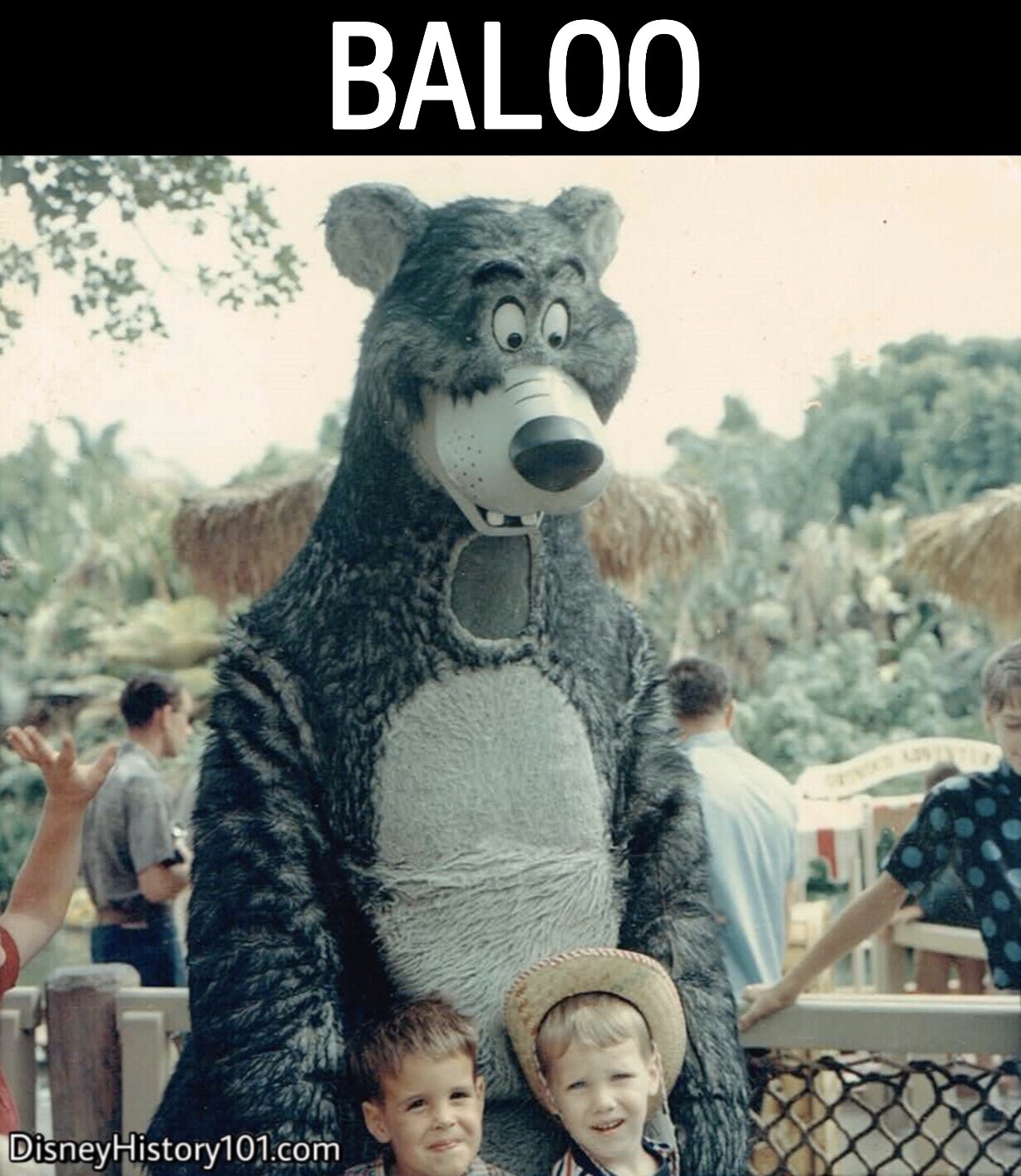
(Pictured above : Baloo wanders out of the jungle to meet a couple of “man cubs” near a “set” at the Jungle River Cruise docks in the “man village” of the Magic Kingdom at Walt Disney World, c. 1967!)
•Baloo (Jungle Book ; Tale Spin) - During October of 1967, many meetings were held between Ben Harris(Entertainment) and the Disneyland Staff concerning the new Characters and Walt Disney’s Jungle Book film Premier. Baloo first debuted during The Jungle Book National Tour, which lasted 26 days (from November 5th thru November 30th, 1967). Disneyland Entertainment Department employees Lee Reineke and Ben Sherman were “Pageant Helpers” who very close to Baloo and King Louie during the tour of several cities. Twenty-two locations visited included Atlanta, Baltimore, Boston, Buffalo, Chicago, Cincinnati, Cleveland, Dallas, DC, Denver, Detroit, Houston, Indianapolis, Miami, Milwaukee, Minneapolis, New Orleans, Philadelphia, St. Louis, Salt Lake City, San Francisco, Toronto, and Washington. Then, the “Jungle Book Parades” (consisting of Col. Hathi, Baloo and King Louie) with the Disneyland Band made regular appearances in Adventureland, greeting guests as part of the Character Program, “throughout the Christmas Holidays” (daily between parades, from 9:00am to 11:45am). [“Disneyland Holiday Talent Master Schedule,” prepared for the period of December 16, 1967 through January 1, 1968] “Disney News” (Winter 1967-68) soon reported: “Jungle Book’s stars Baloo the bear, King Louie the ape and Colonel Hathi the elephant will make their first appearance this year.” Popular Dutch singer Heinje Simons visited Disneyland during 1967 (likely during this season), and took many photographs with both Baloo and King Louie.
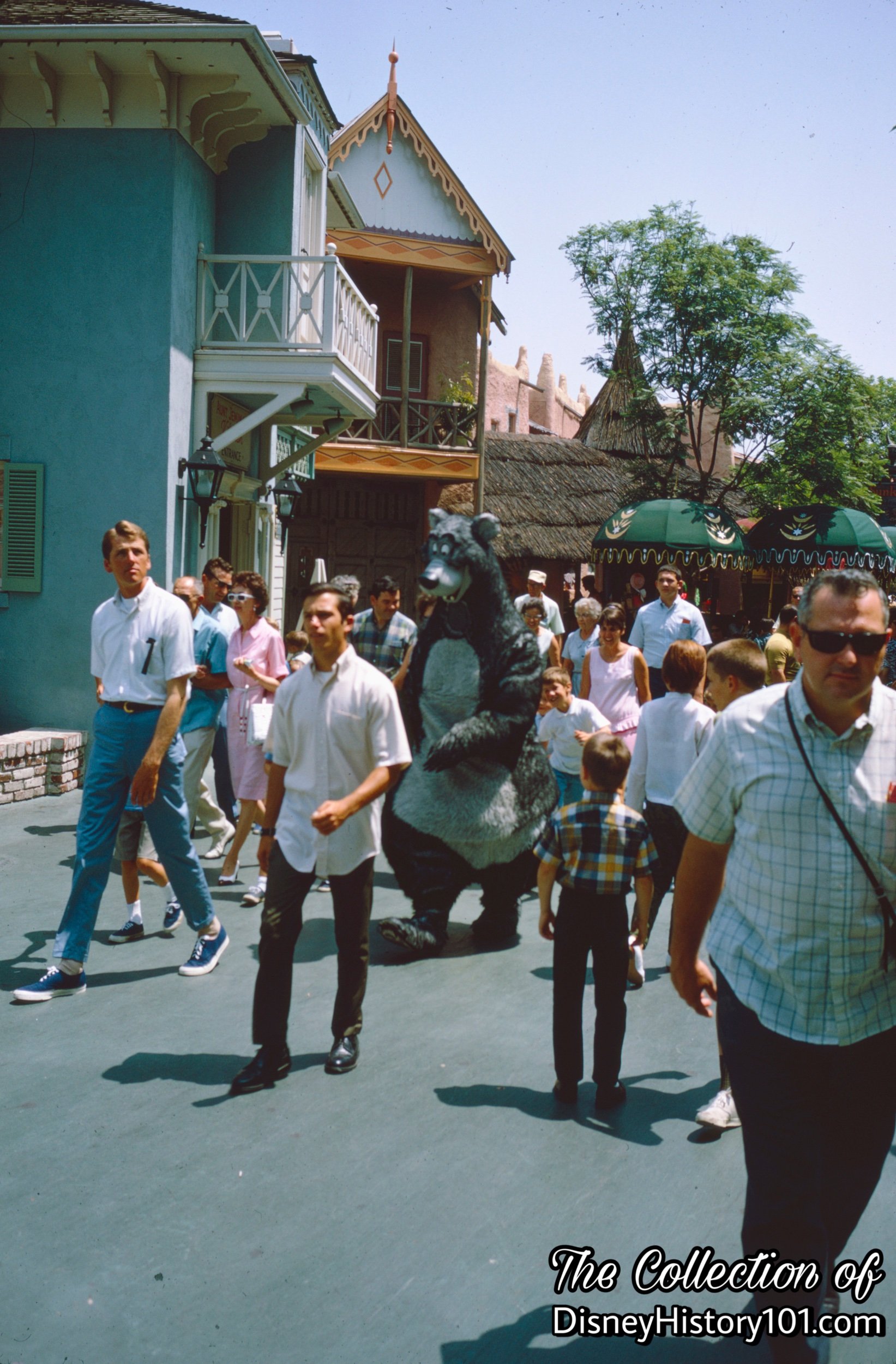
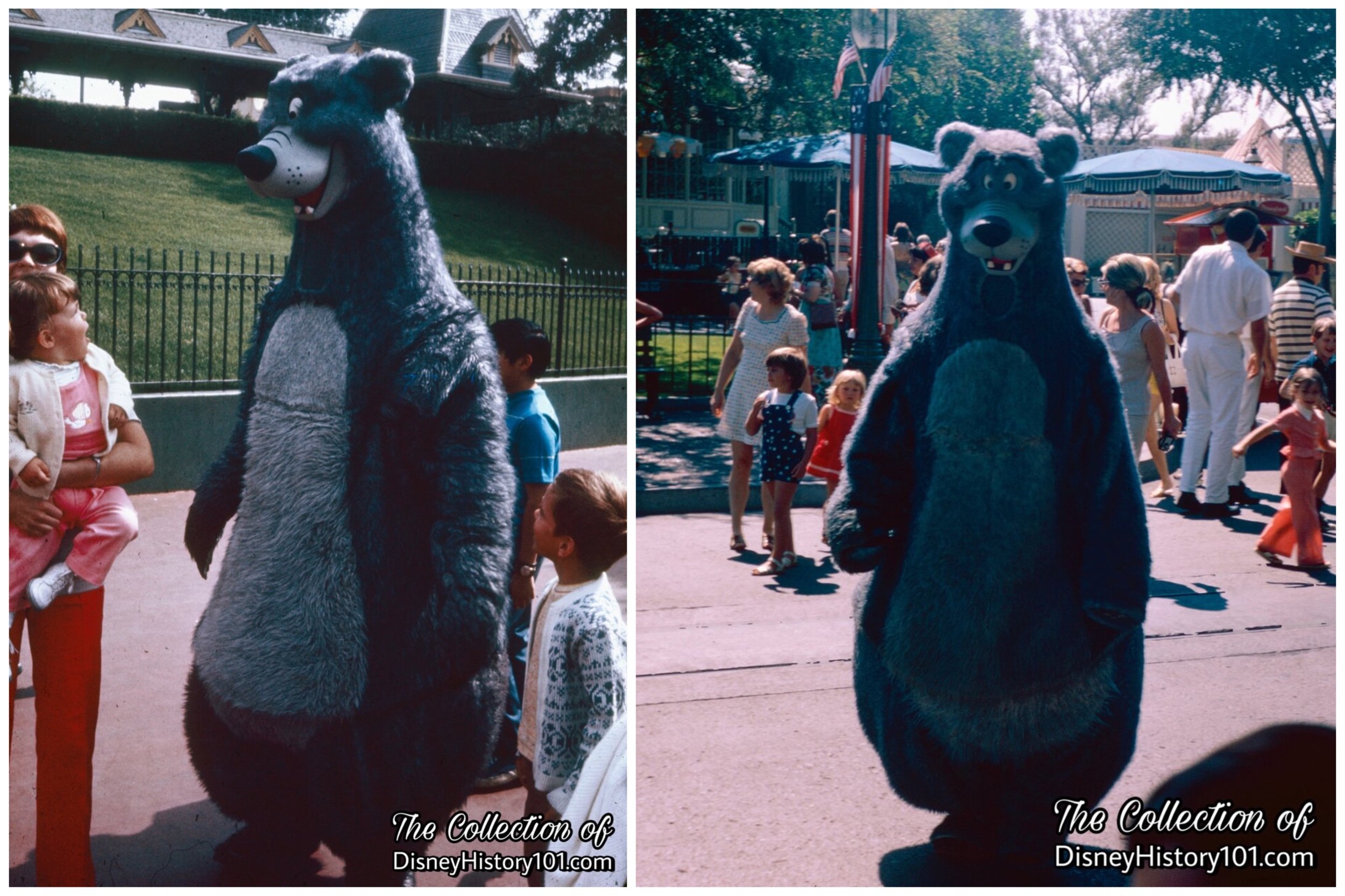
Baloo, 1974.
One of Walt Disney’s newest stars (Baloo) greets guests near the Mickey Mouse “floral portrait” at the entrance to Disneyland!
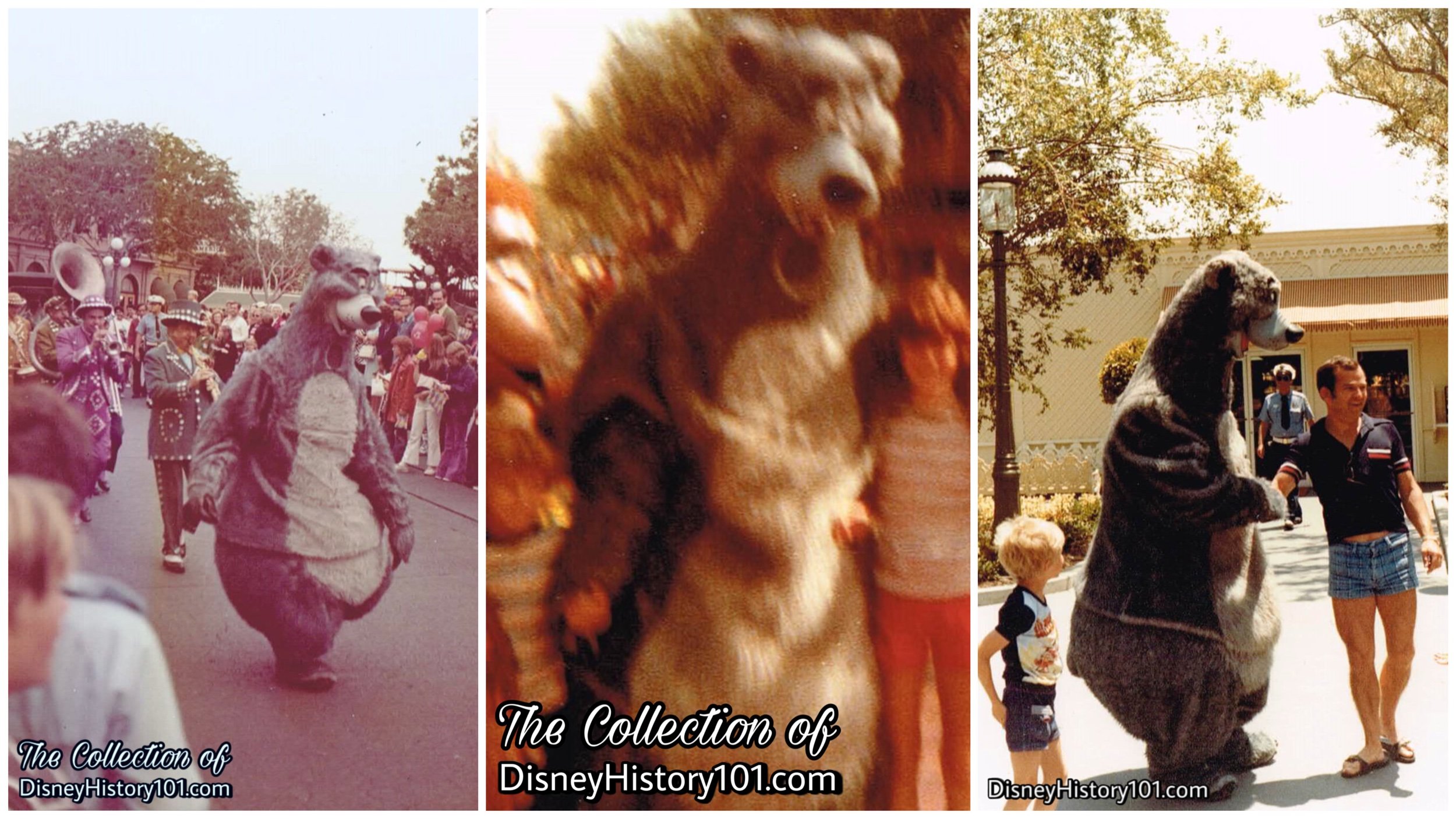
1978 (center)
Baloo the Bear also greeted Disneyland guests in Town Square soon after his debut. Where else would a carefree bear hang out in Disneyland, than the Carefree Corner on Main Street U.S.A.
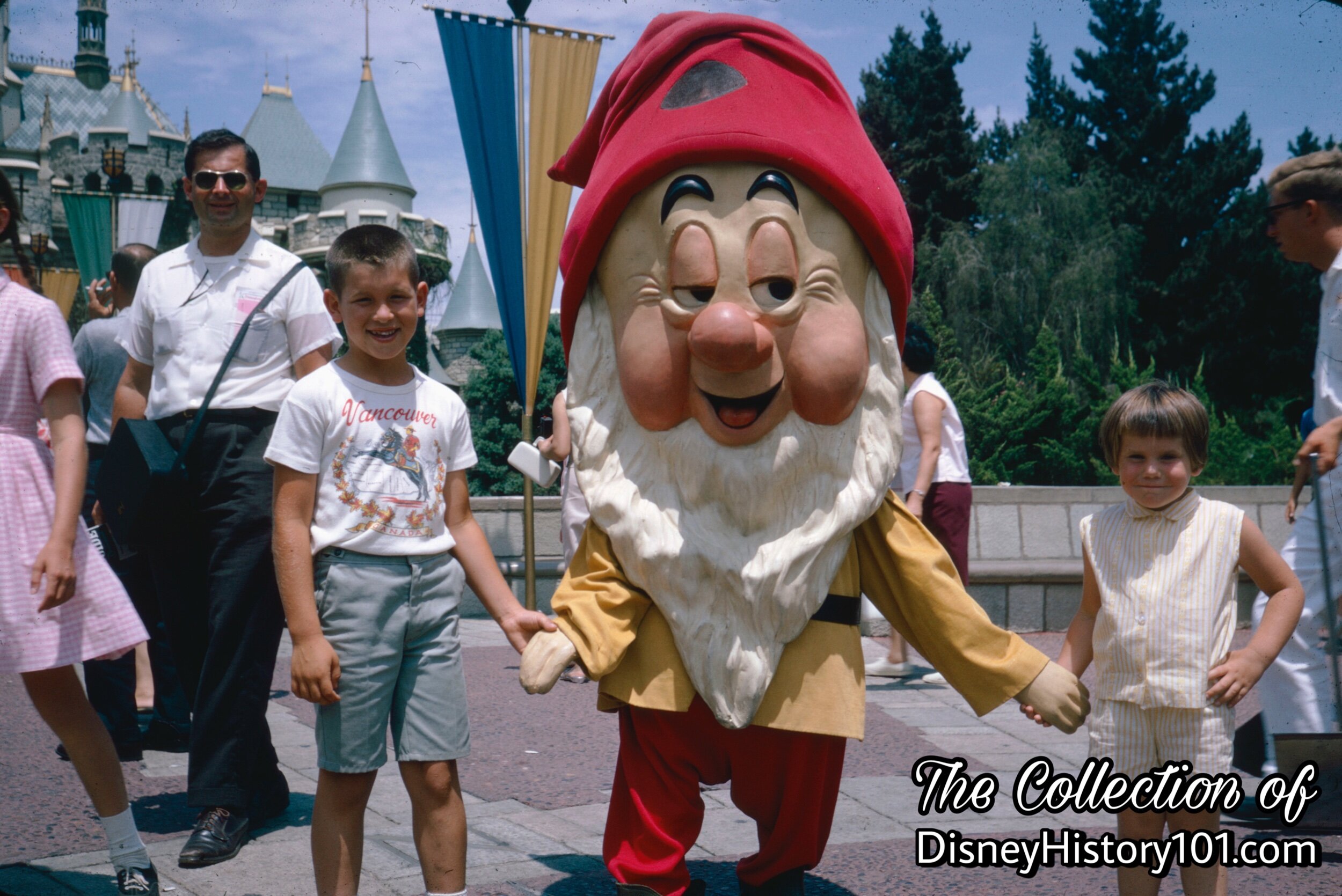
BASHFUL, (1966)
In a post-New York World’s Fair Vintage View, Bashful makes one of his multiple daily appearances in Disneyland!
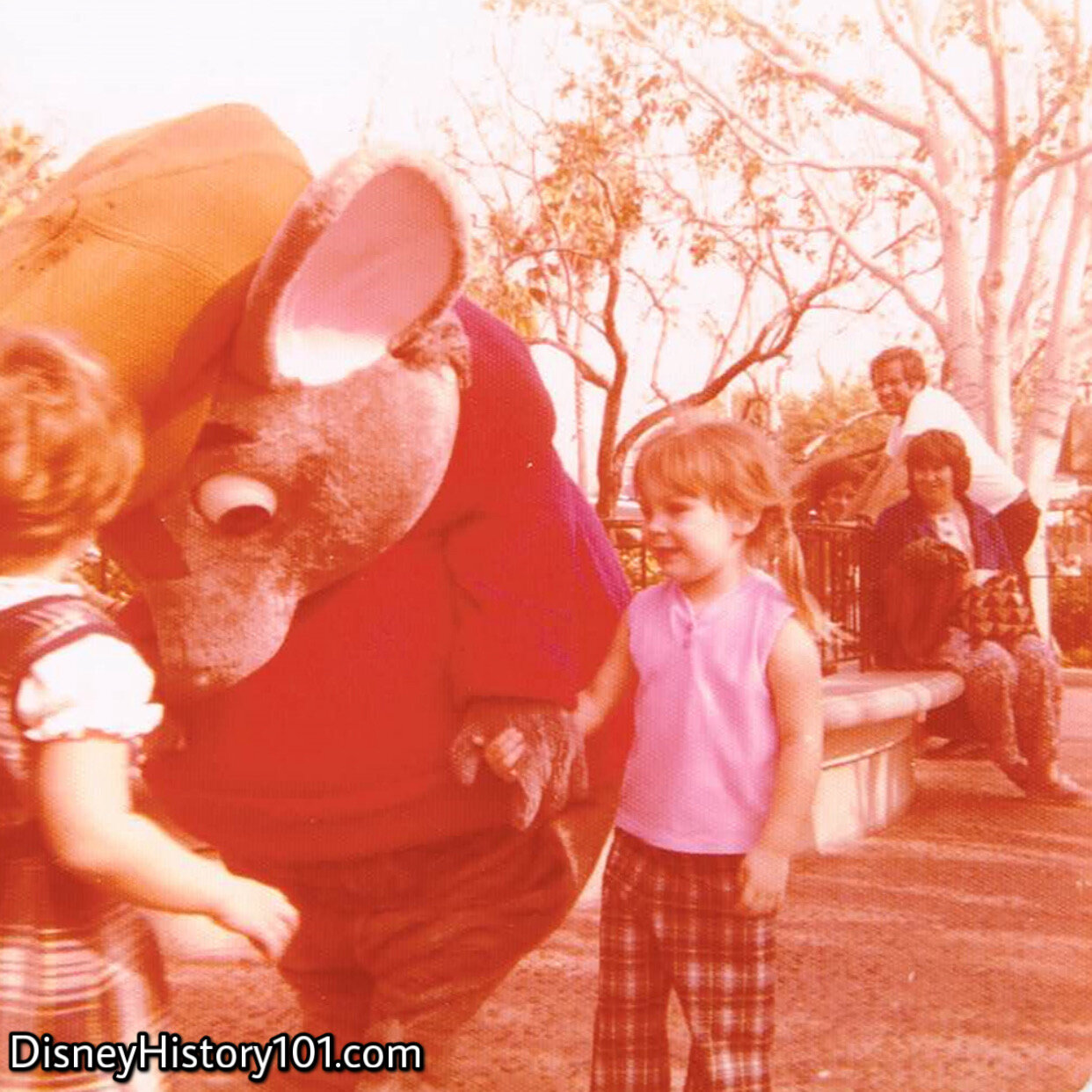
BERNARD of The Rescuers (1977)
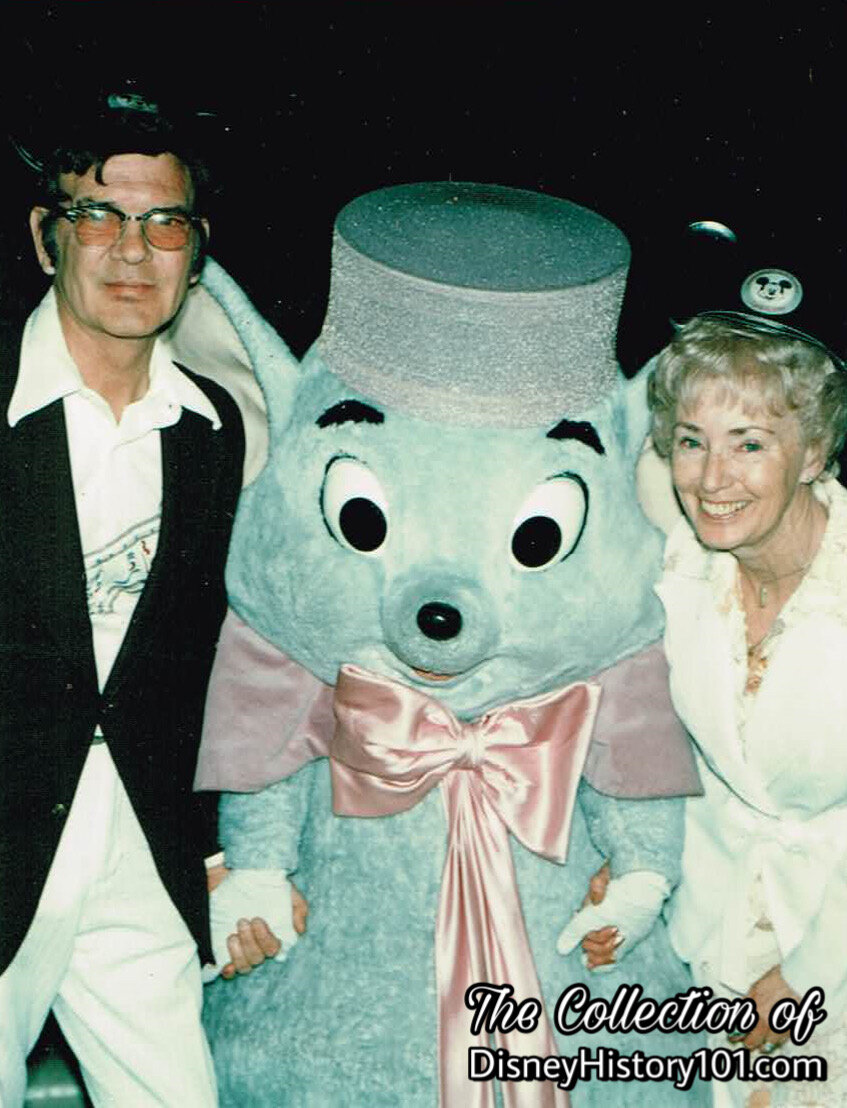
Bianca poses for a "Disneyland Family" photo and creates happiness for a couple of Cast Members, (April 11, 1980)
Tim Brandt (Disneyland Security) and Priscilla (Disneyland First Aid) meet Bianca during Disneyland’s 25th Family Reunion event!
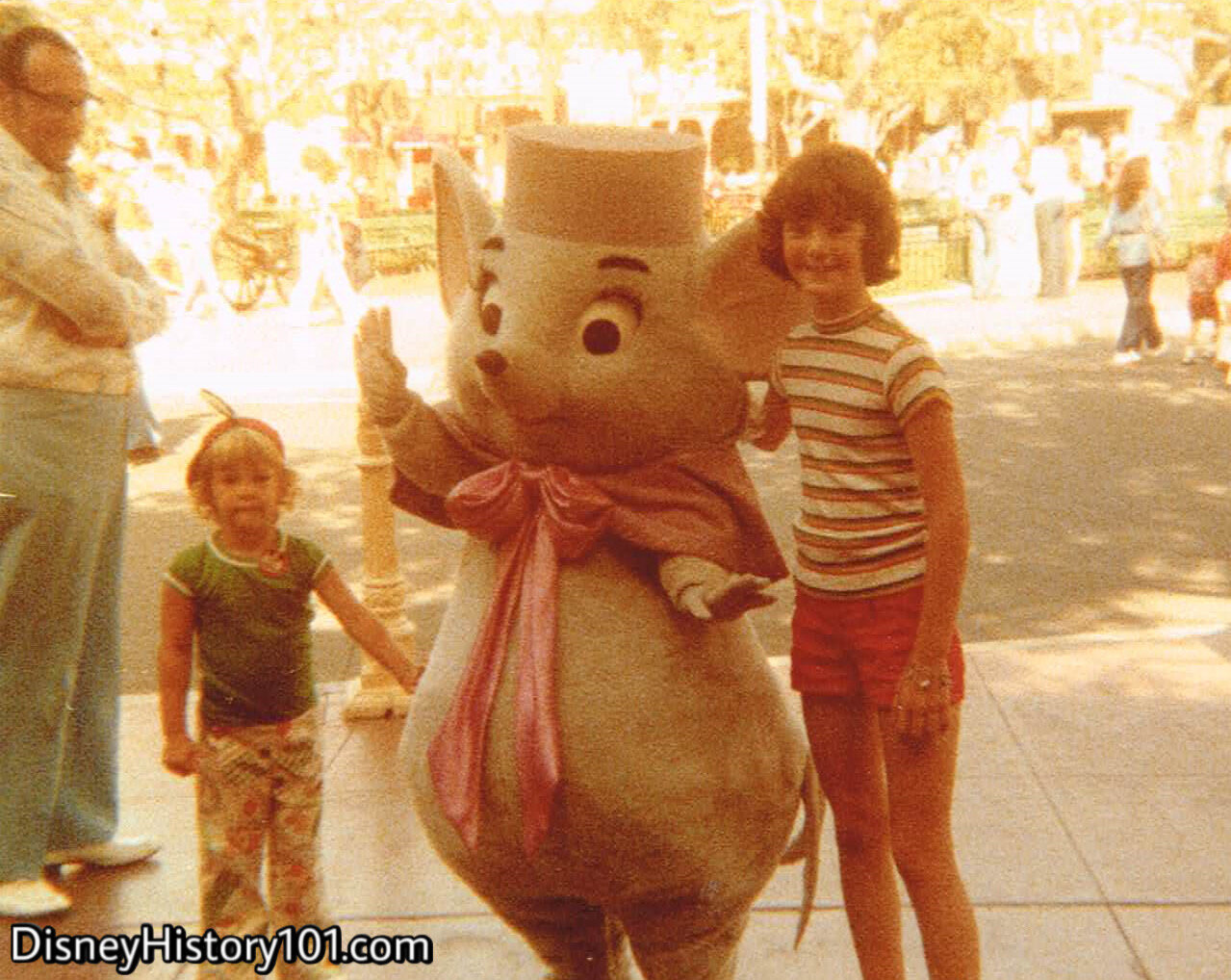
BIANCA of The Rescuers (March, 1978)
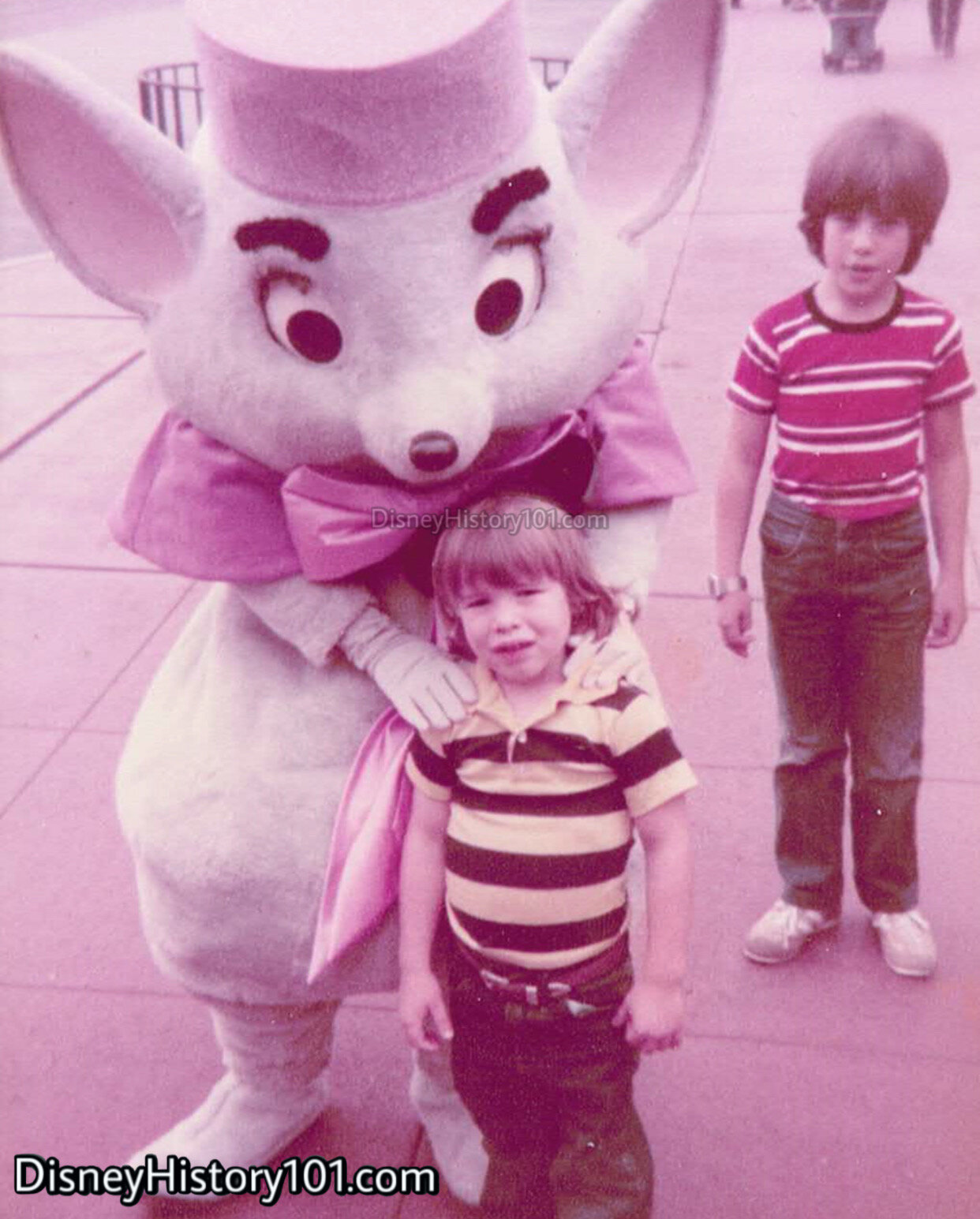
BIANCA of The Rescuers (1981)

BIG BAD WOLF (October, 1961)
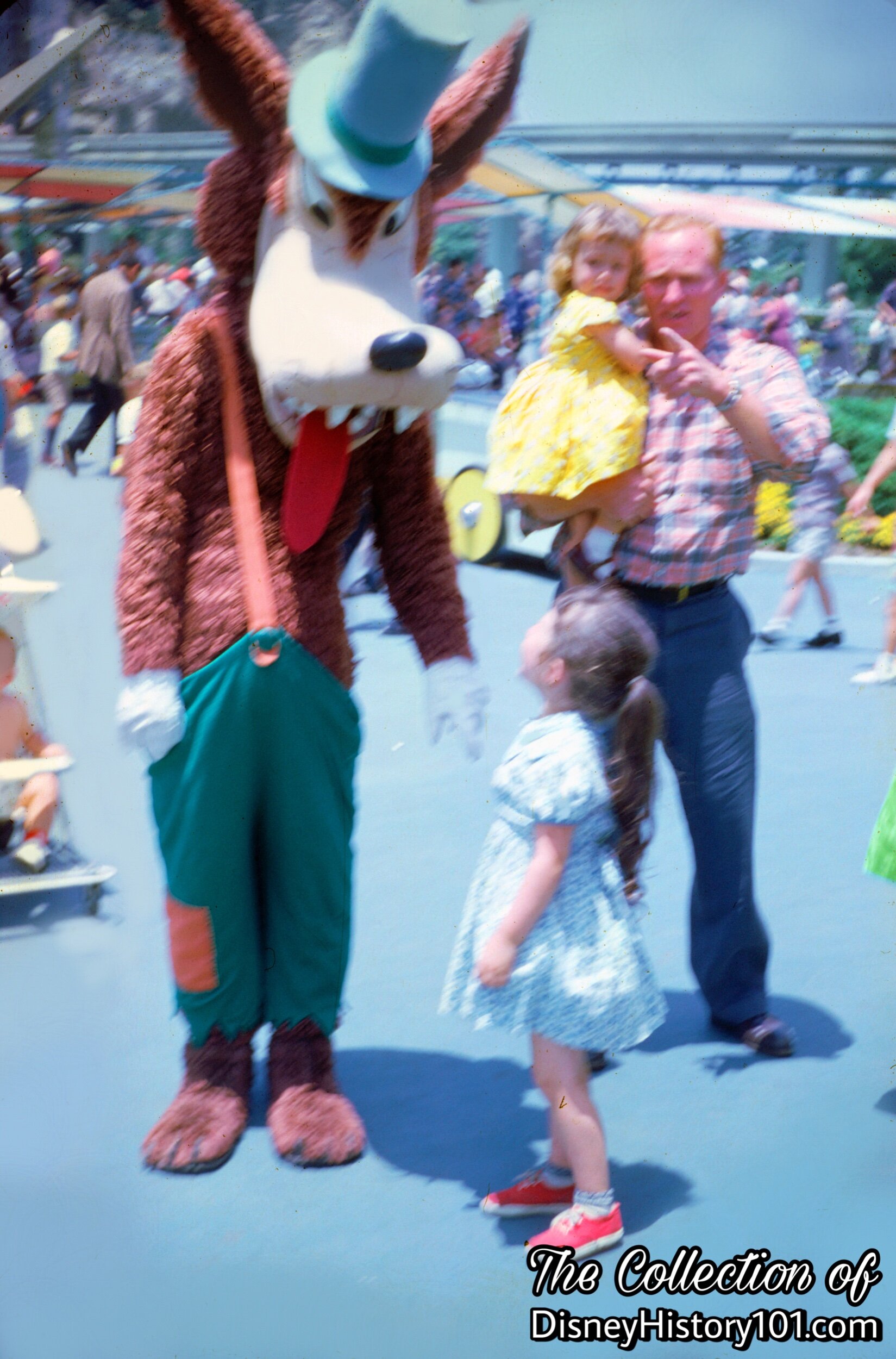
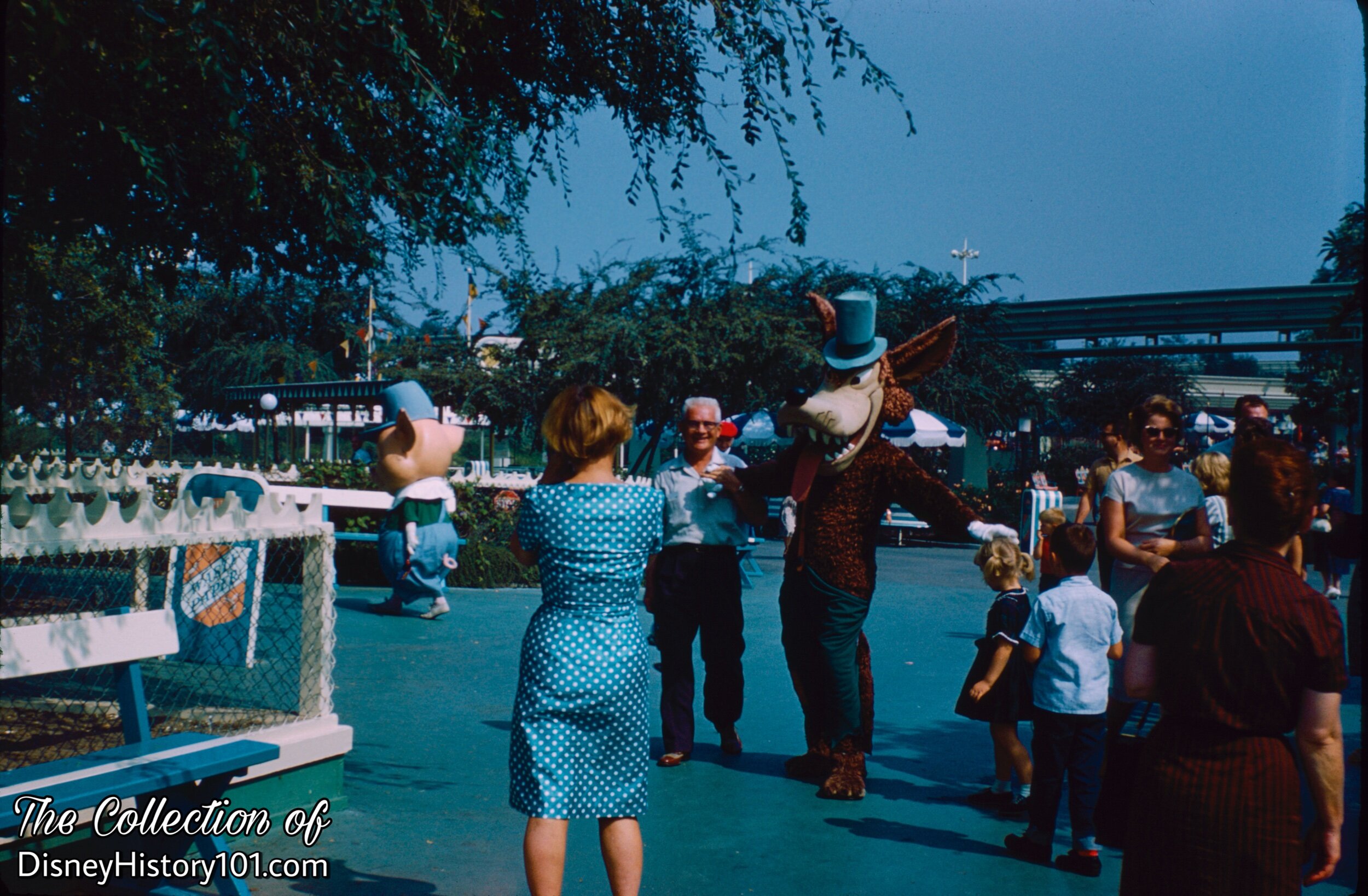
BIG BAD WOLF (October, 1961)
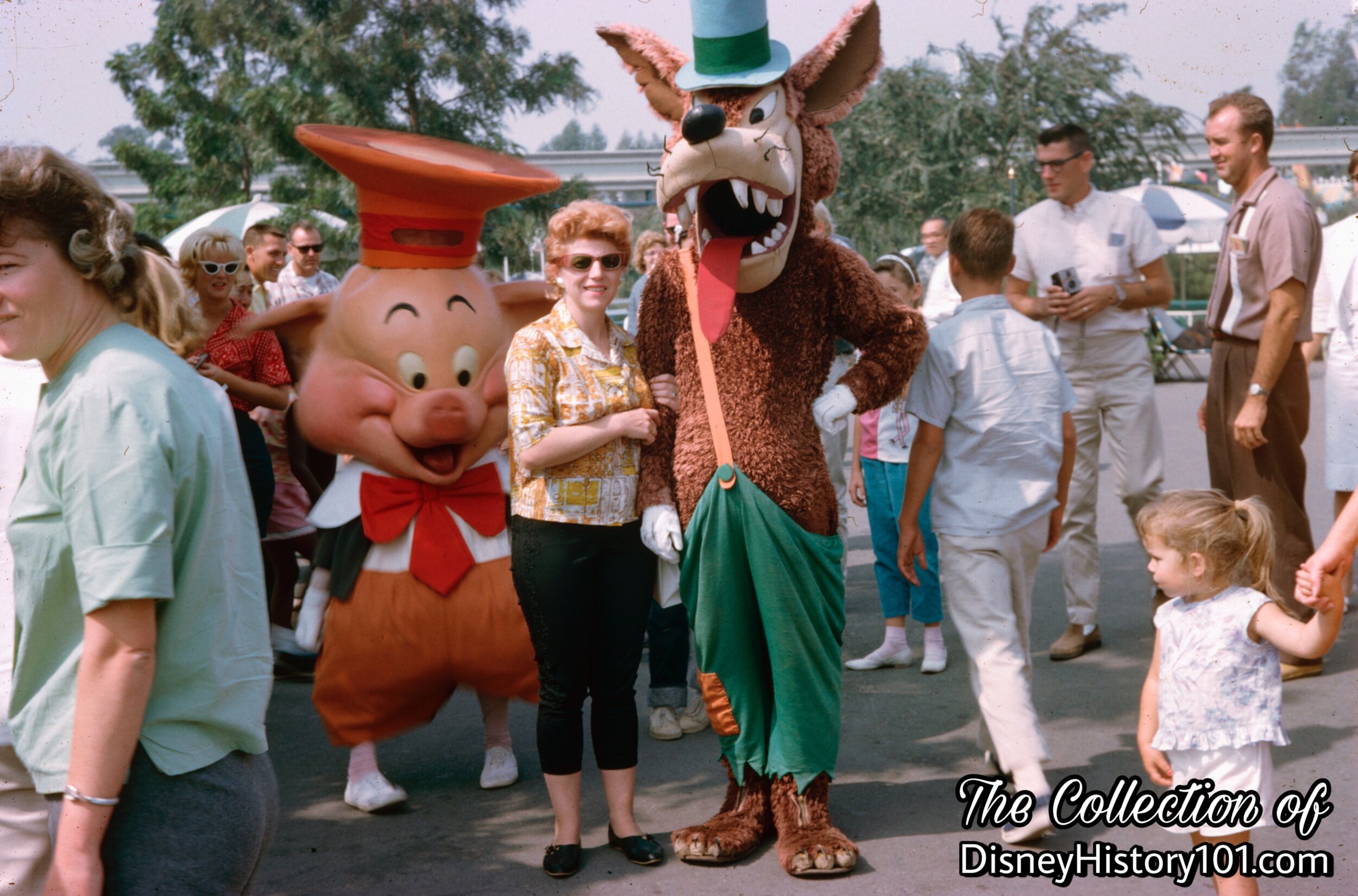
BIG BAD WOLF, (1962)
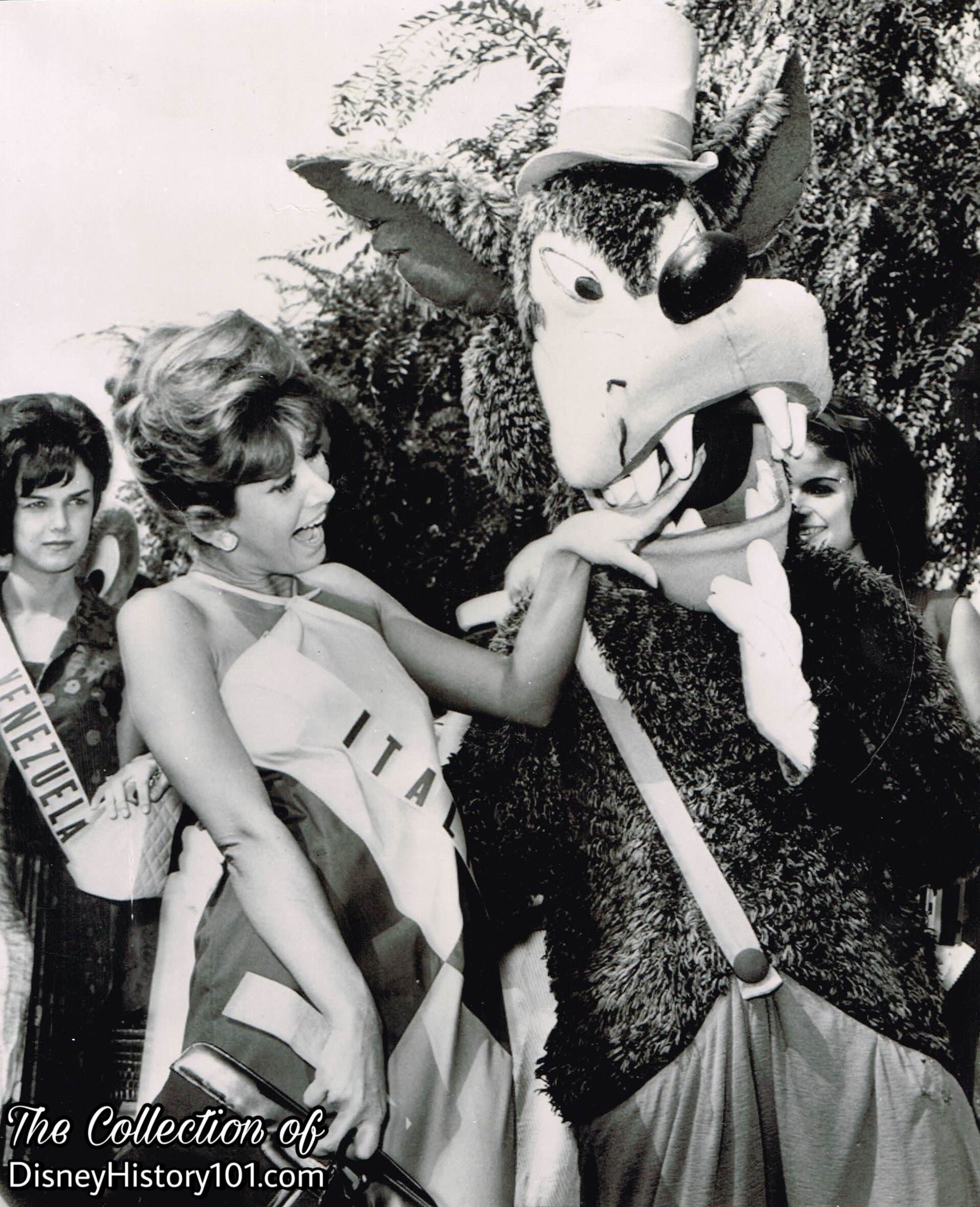
BIG BAD WOLF makes a memorable guest interaction, August 14, 1963.
Big Bad Wolf poses playfully with Miss International Beauty Contestants as they visit Disneyland. Anna Luisa Rispoli (representing Italy) is pictured in the foreground with her mouth in the Big Bad Wolf’s mouth.
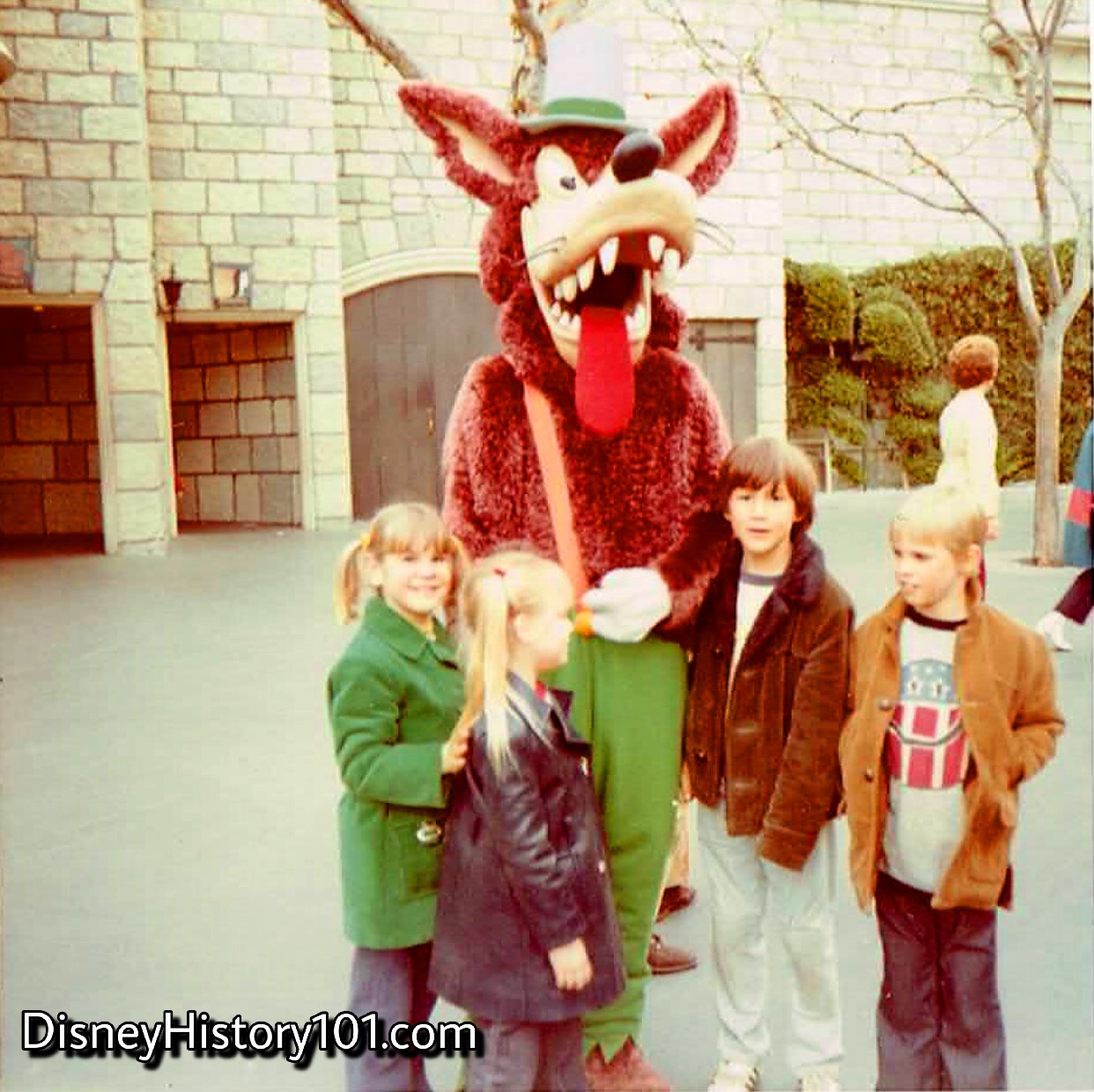
BIG BAD WOLF (1972)
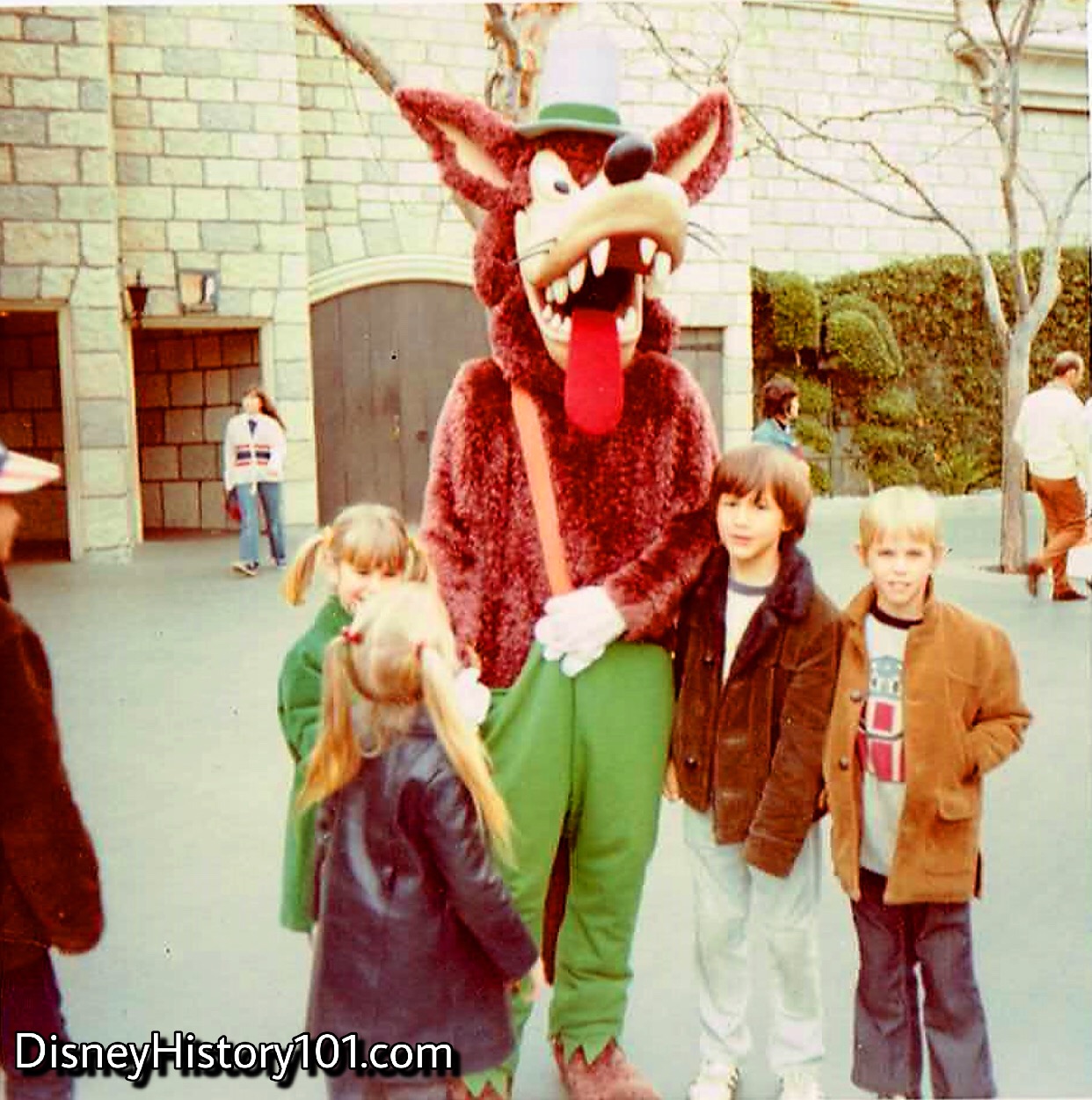
BIG BAD WOLF (1972)
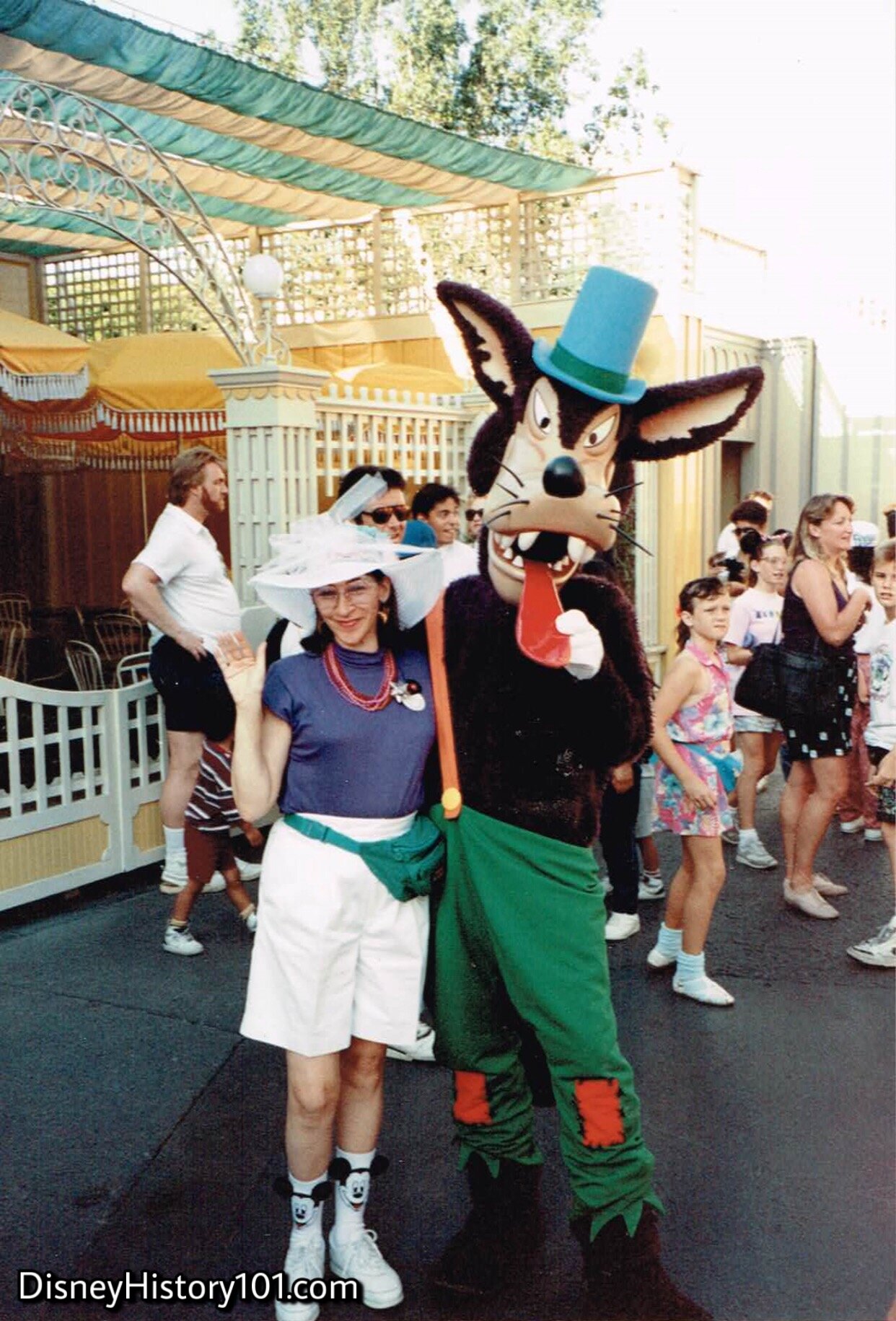
BIG BAD WOLF
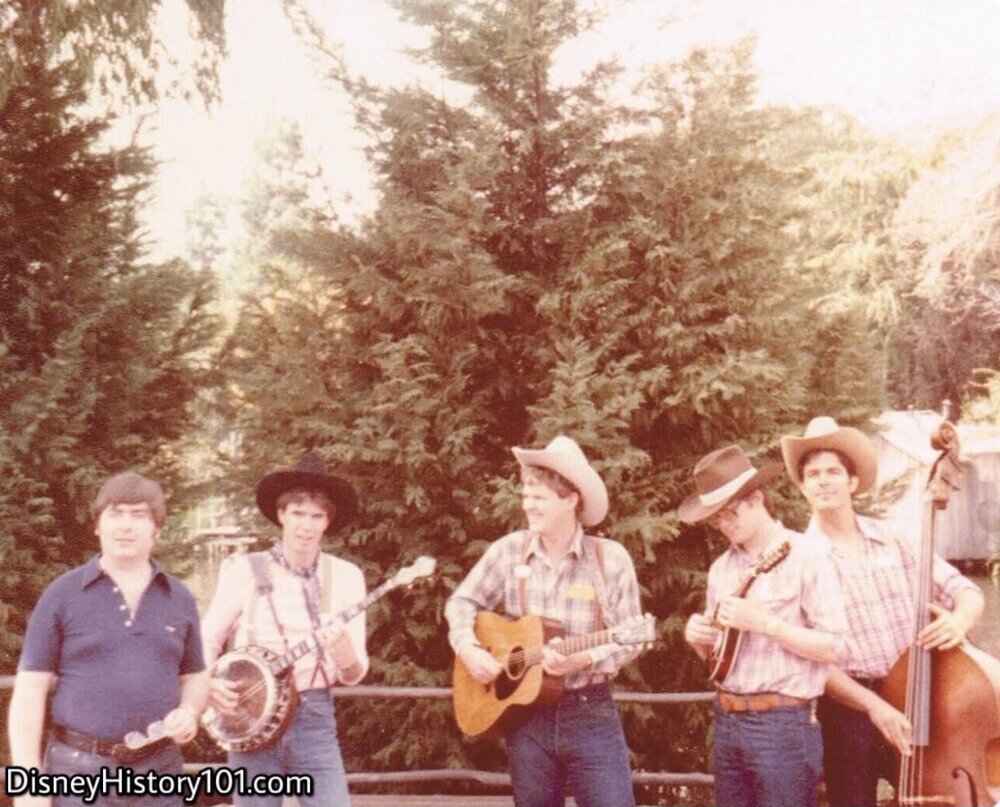
BIG THUNDER BREAKDOWN BOYS
The Big Thunder Mountain “Breakdown” Boys (seen here during Disneyland’s 25th Anniversary) performed their bluegrass melodies from Frontierland throughout the 1980s.
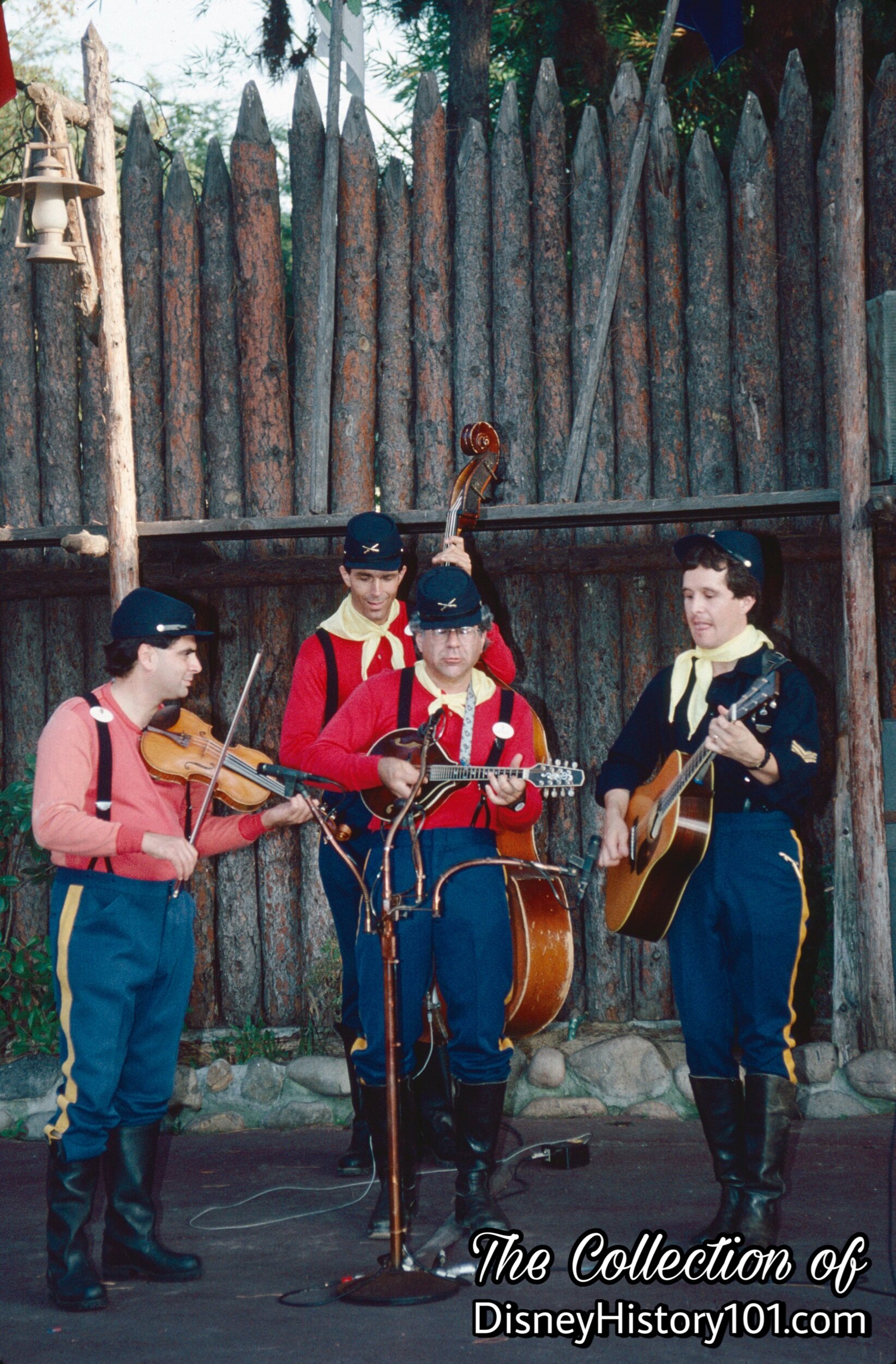
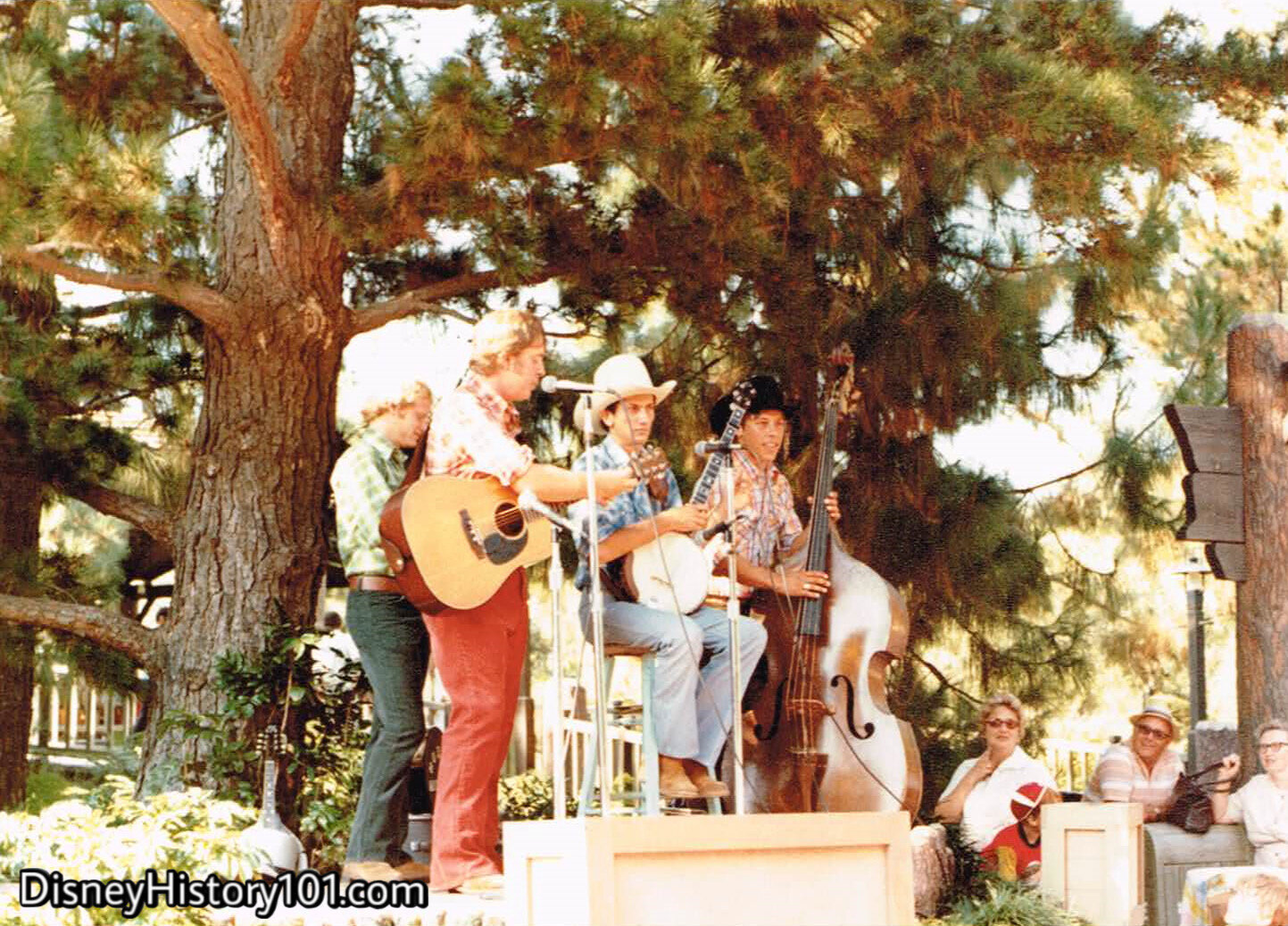
BIG THUNDER BREAKDOWN BOYS
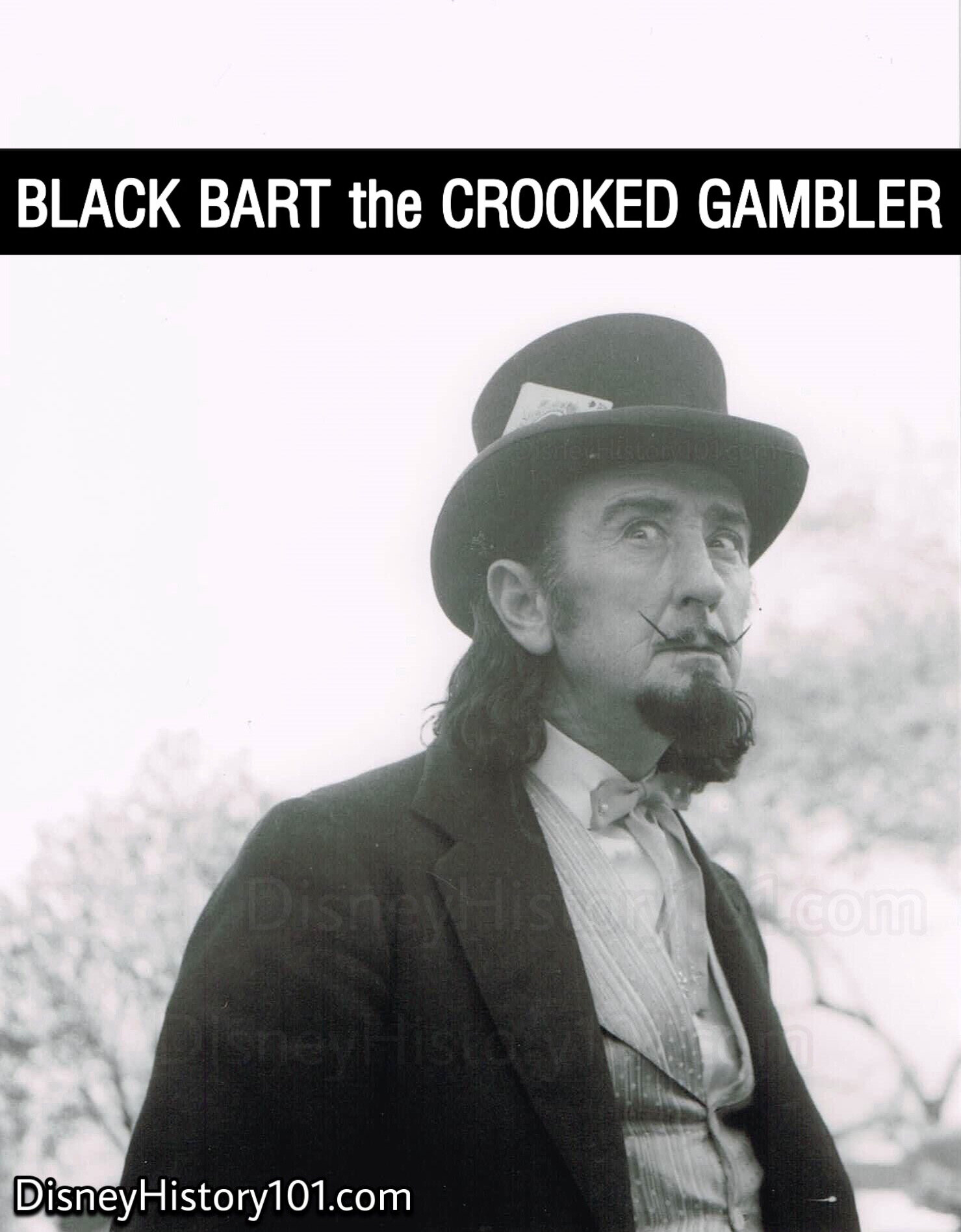
BLACK BART the CROOKED GAMBLER, 1957

Noah “Dick” Morrison was once a “true life” deputy sheriff in Albuquerque, but has since traded his badge for a perforated ace of spades atop his top hat. Noah would portray one of Frontierland’s resident villains - Black Bart (the “crookedest card shark West of the Monongahela”), during Disneyland’s formative years!
Steve recollects : “I did meet [Noah] in character at Disneyland when I was about 8 years old. I was getting off the Omnibus in front of Frontierland when I heard a gunshot. Standing there was Black Bart in western wear…a black cowboy hat, white shirt, black vest, and western bow tie. He greeted all the kids including me and handed out an autographed photo of himself... that was a fun fond memory for me!
My next encounter with Noah was in 1961, when I was 13. The group of junior high [school] kids that lived in the area (which included myself), would stand on the corner adjacent to his house around 10 a.m. [while] waiting for the School Bus.
One morning Noah was sitting on his front lawn and doing a little weeding. None of us kids were talking to each other, and we didn't say anything to Noah. I think most of us knew that he had lost his job at Disneyland playing Black Bart. We all felt sorry for him and were afraid to say ‘hello’, until Jim Briglio spoke up and said, ‘Hi, Black Bart!’ He replied back stoically, ‘Hi’… and then a few other kids also kindly replied back to Noah, "Hi, Black Bart". Soon the bus arrived and we loaded on and were whisked away.
Through the years I would sometimes see him and his shop, as I walked or rode my bike by. His shop (which had originally been a matching detached garage), had been torn down, and he had a gray cinder-brick shop built for his upholstery business.
For many years, (as I grew up and learned to drive), I would often pass by his house on my way home and see his sign out front-- Black Bart's Upholstery! It must have been there for 20 years, until around 1978-80. I'm not sure when Noah passed away but I think he lived in that house until the day he died.“
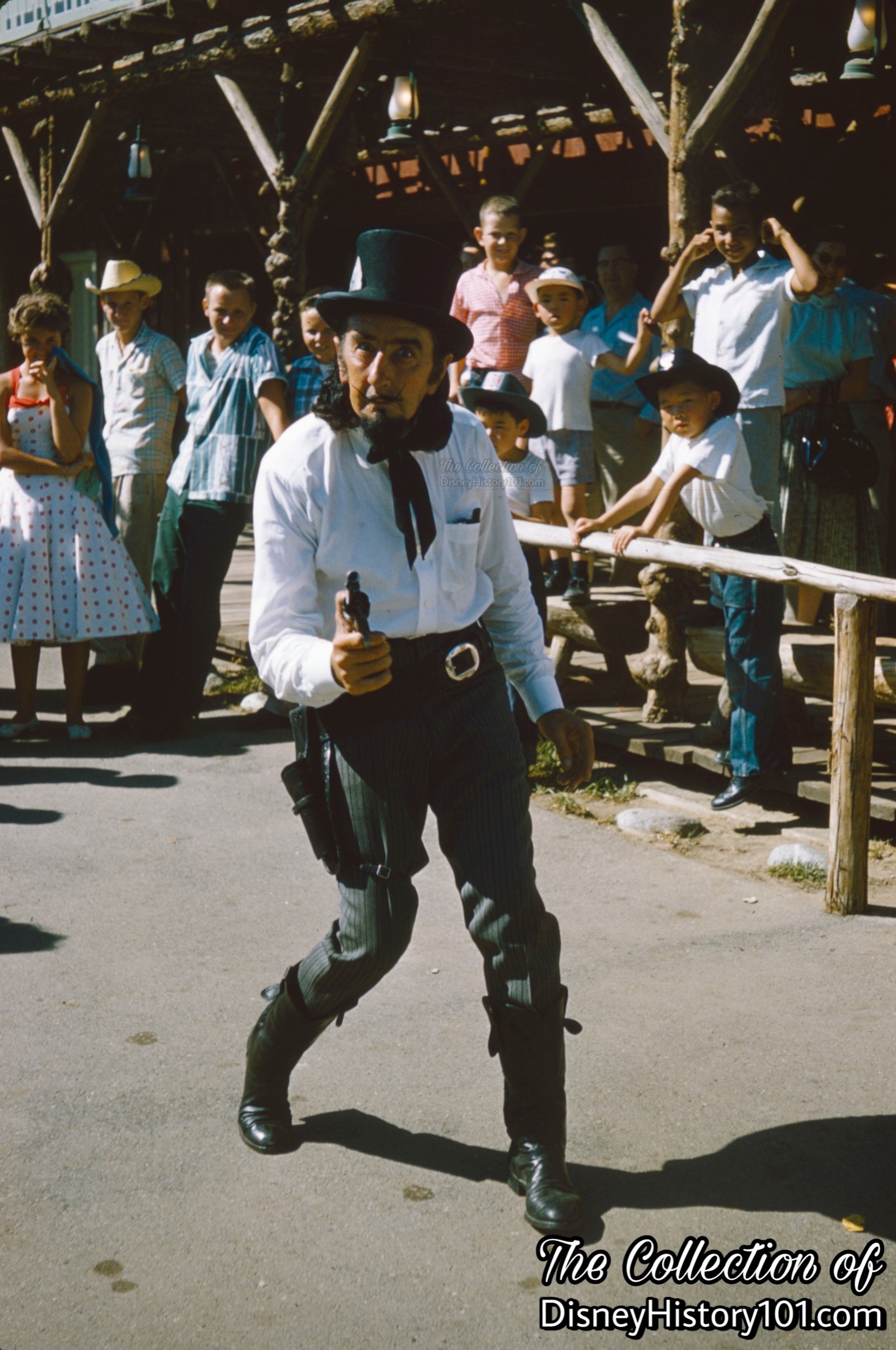
The animated Black Bart Face Character.

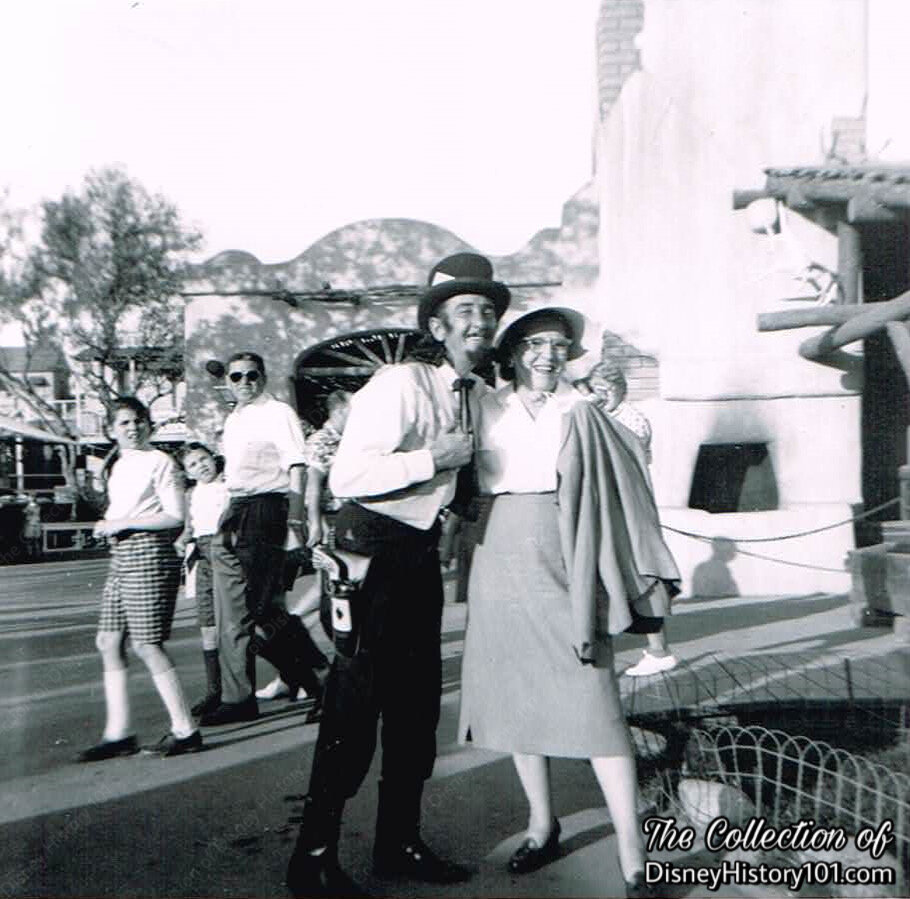
BLACK BART the CROOKED GAMBLER extends a courteous smile.
Disneyland Characters would continue to create happiness long after Van Arsdale France had coined and utilized the expression for presentations given before Disneyland corporate sponsors in 1955.
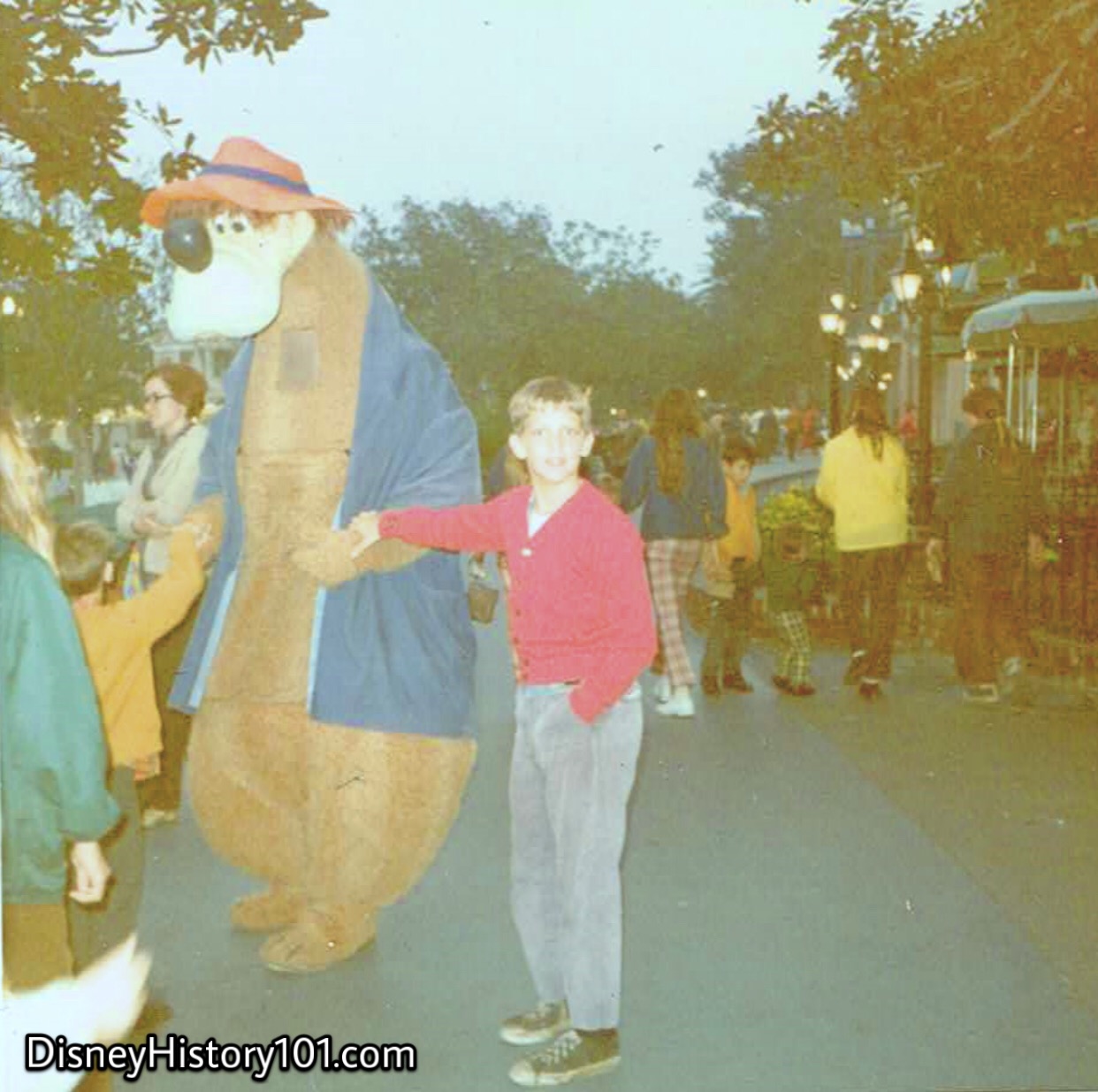
BR'ER BEAR
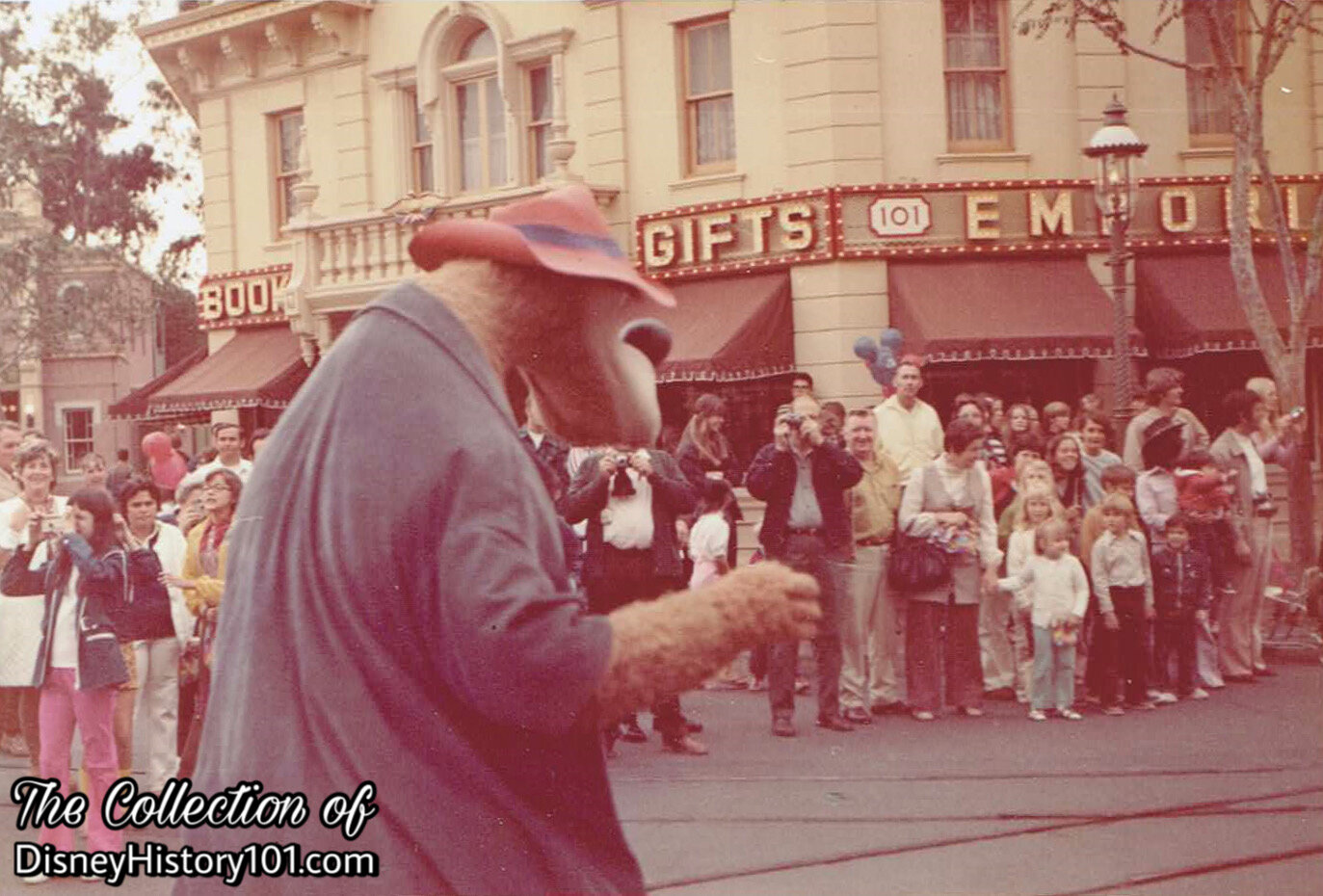
BR’ER BEAR
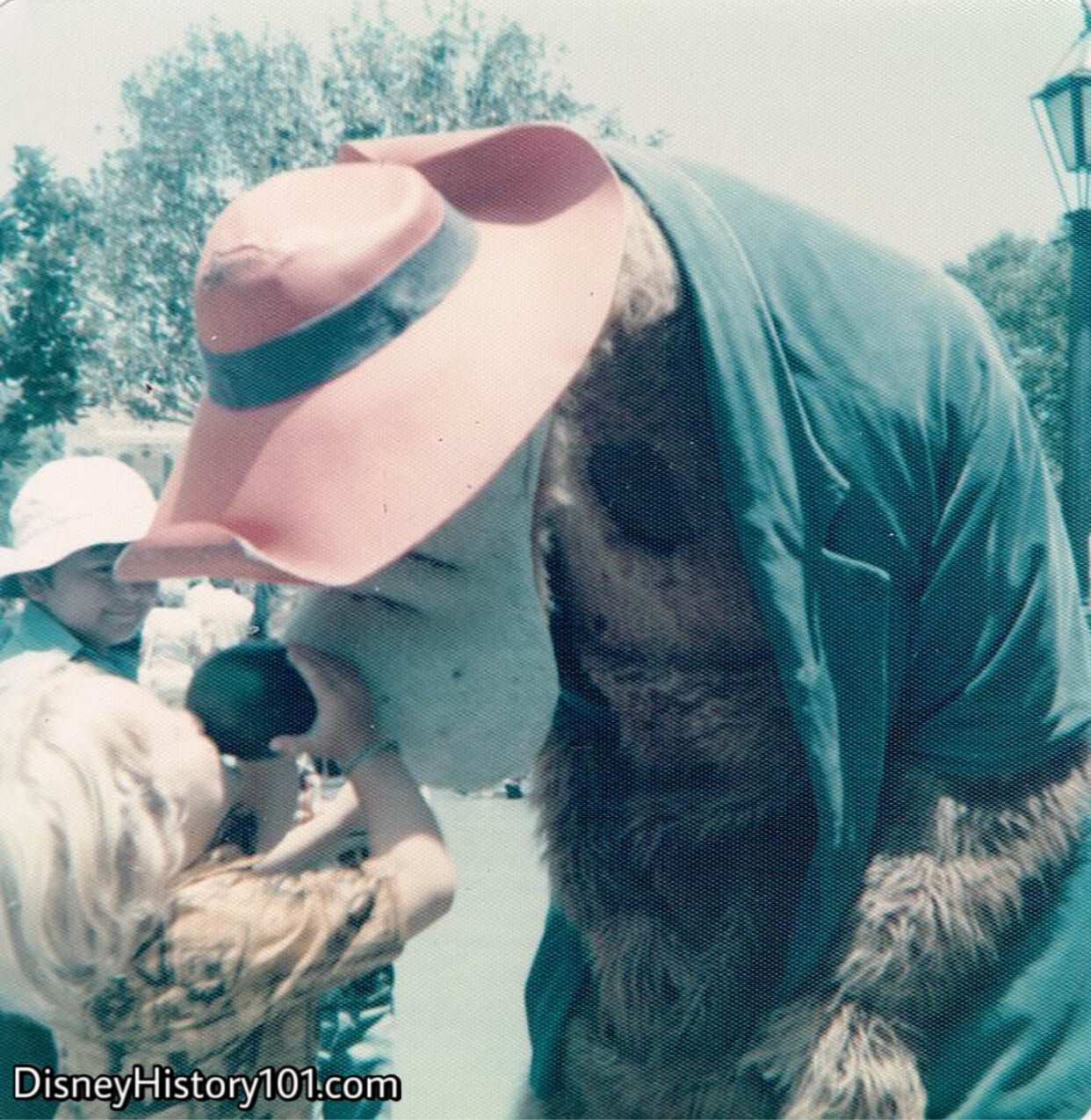
BR'ER BEAR (c. 1975 - 1976)
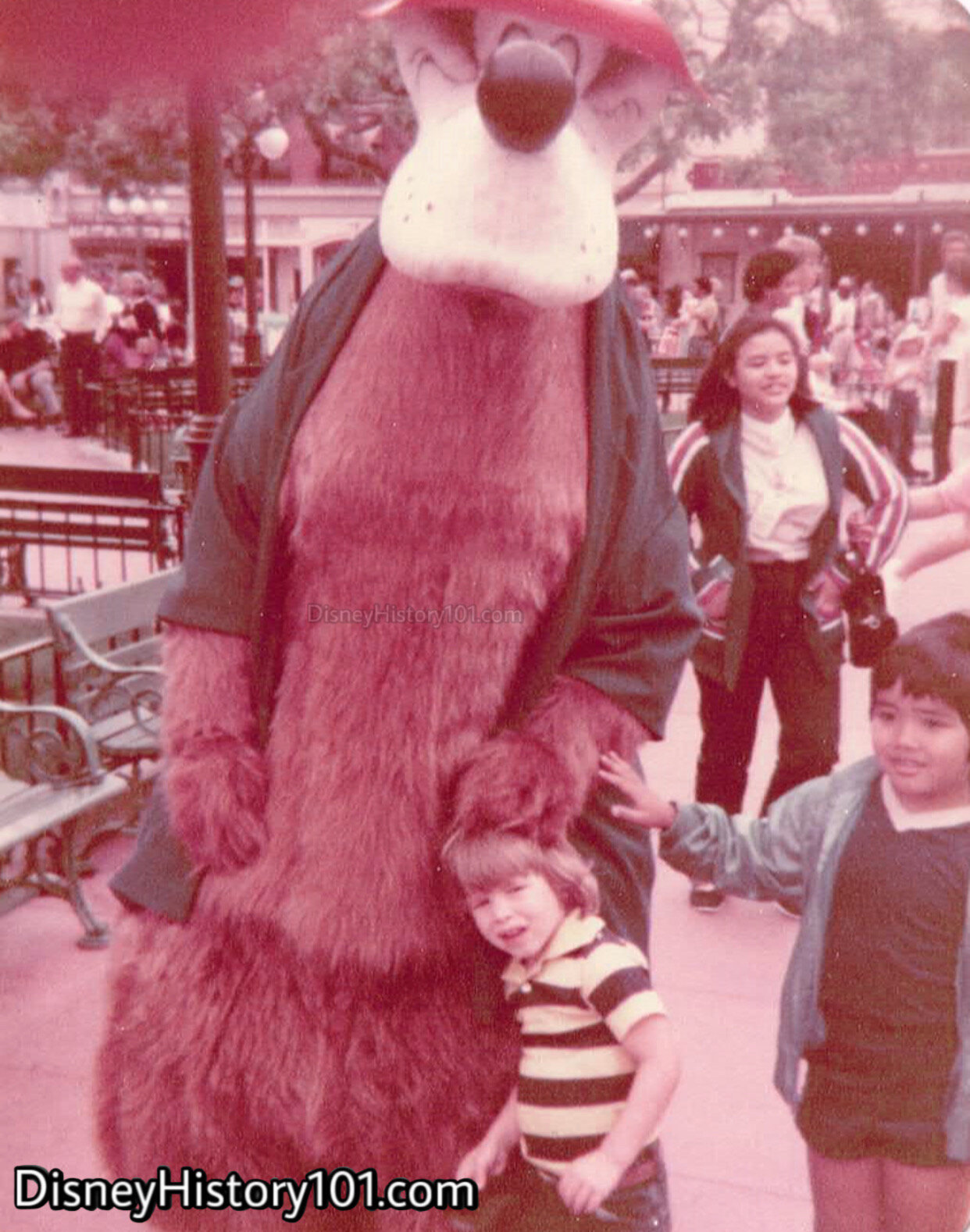
BR'ER BEAR
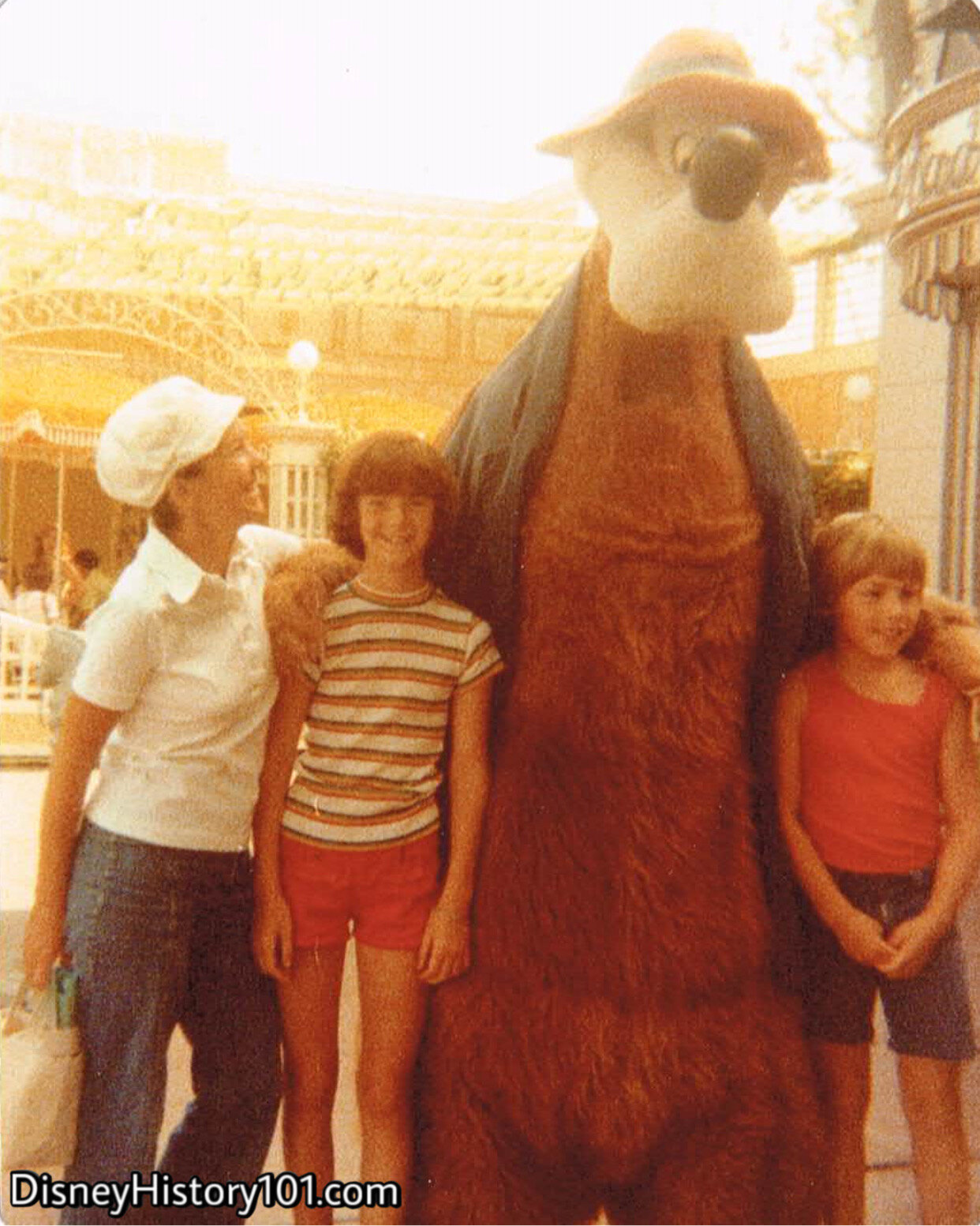
BR'ER BEAR, March, 1978.

BR'ER BEAR and BR'ER FOX
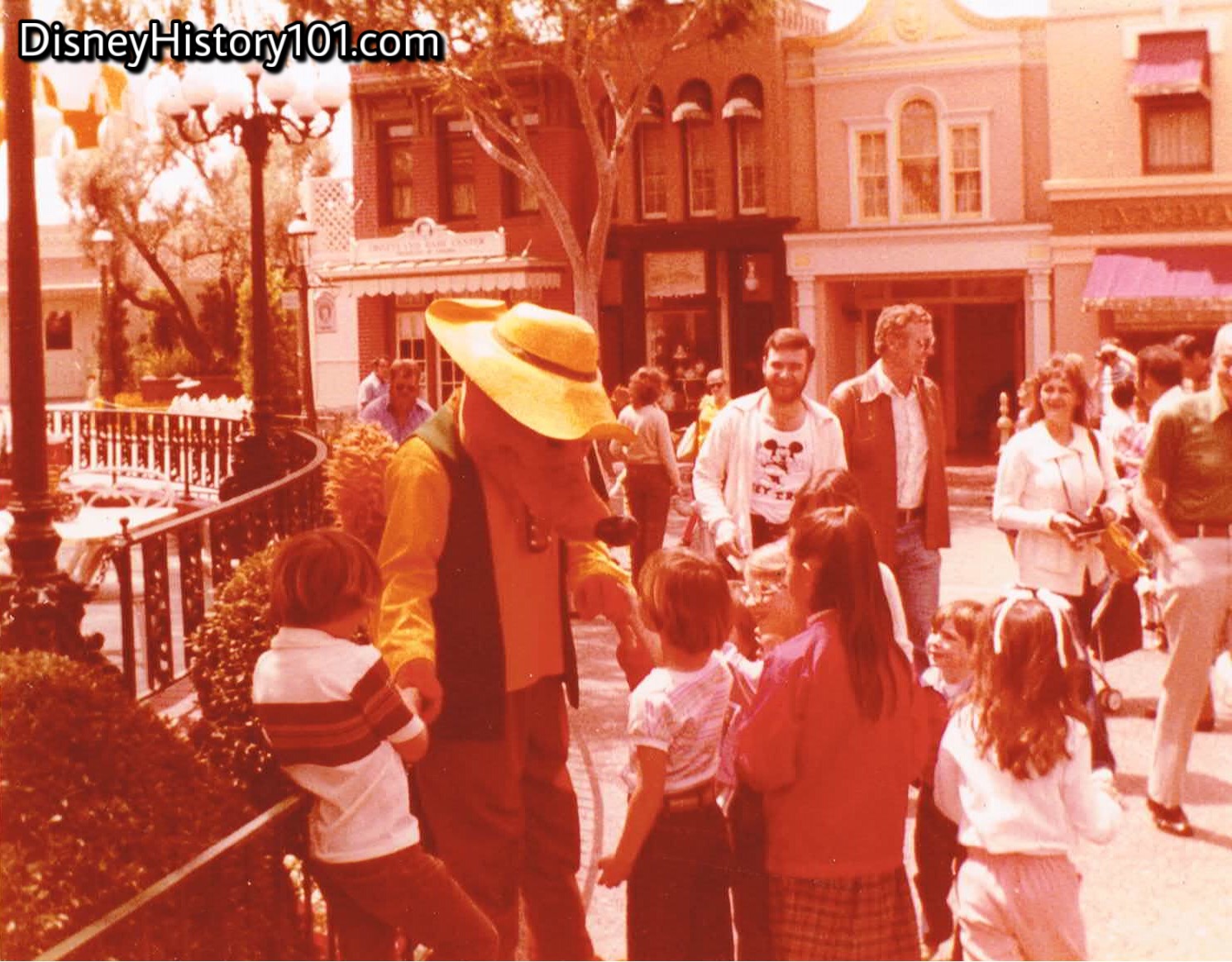
BR'ER FOX
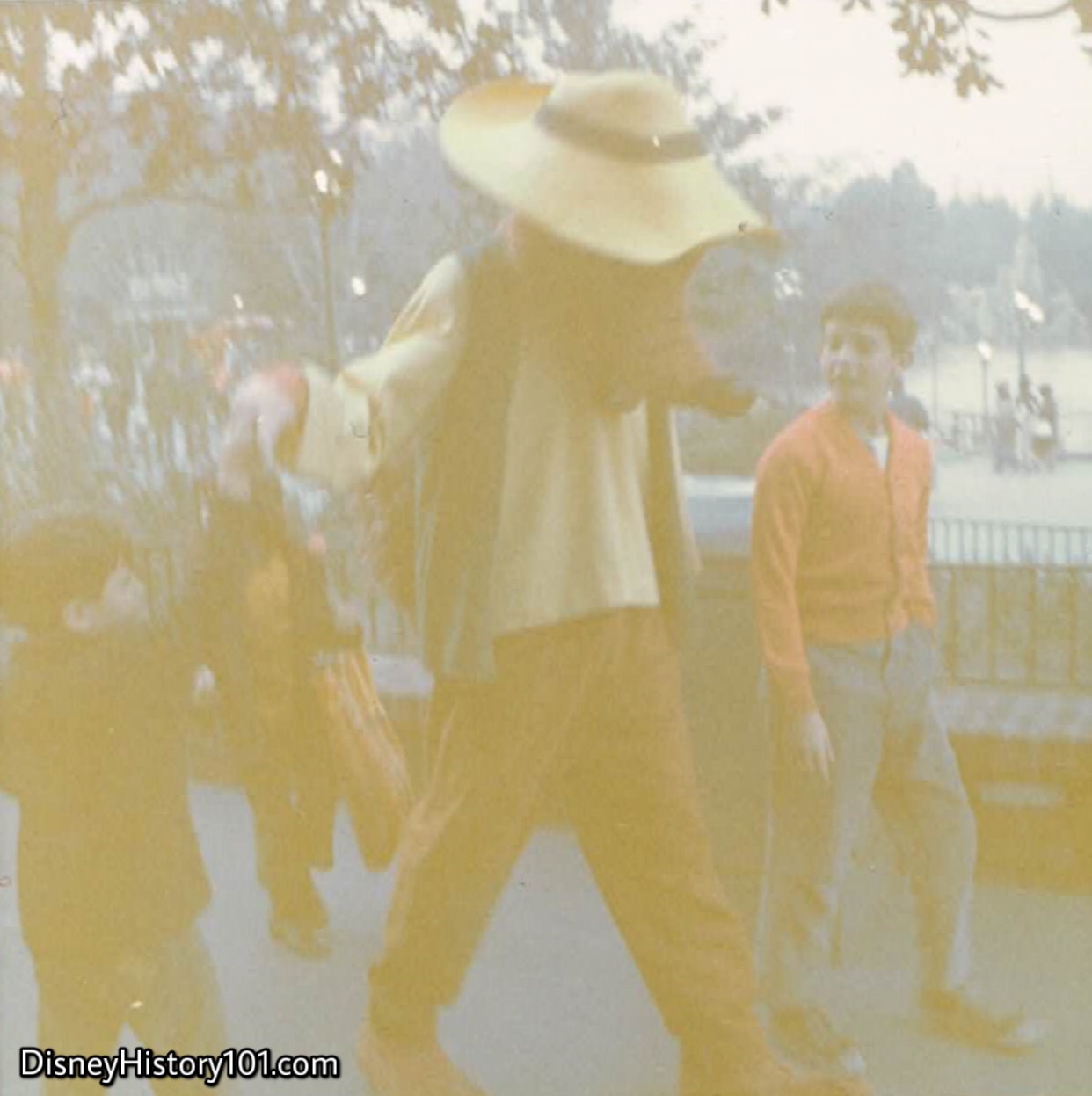
BR'ER FOX (January, 1971)

An animated BR'ER FOX, March, 1962.
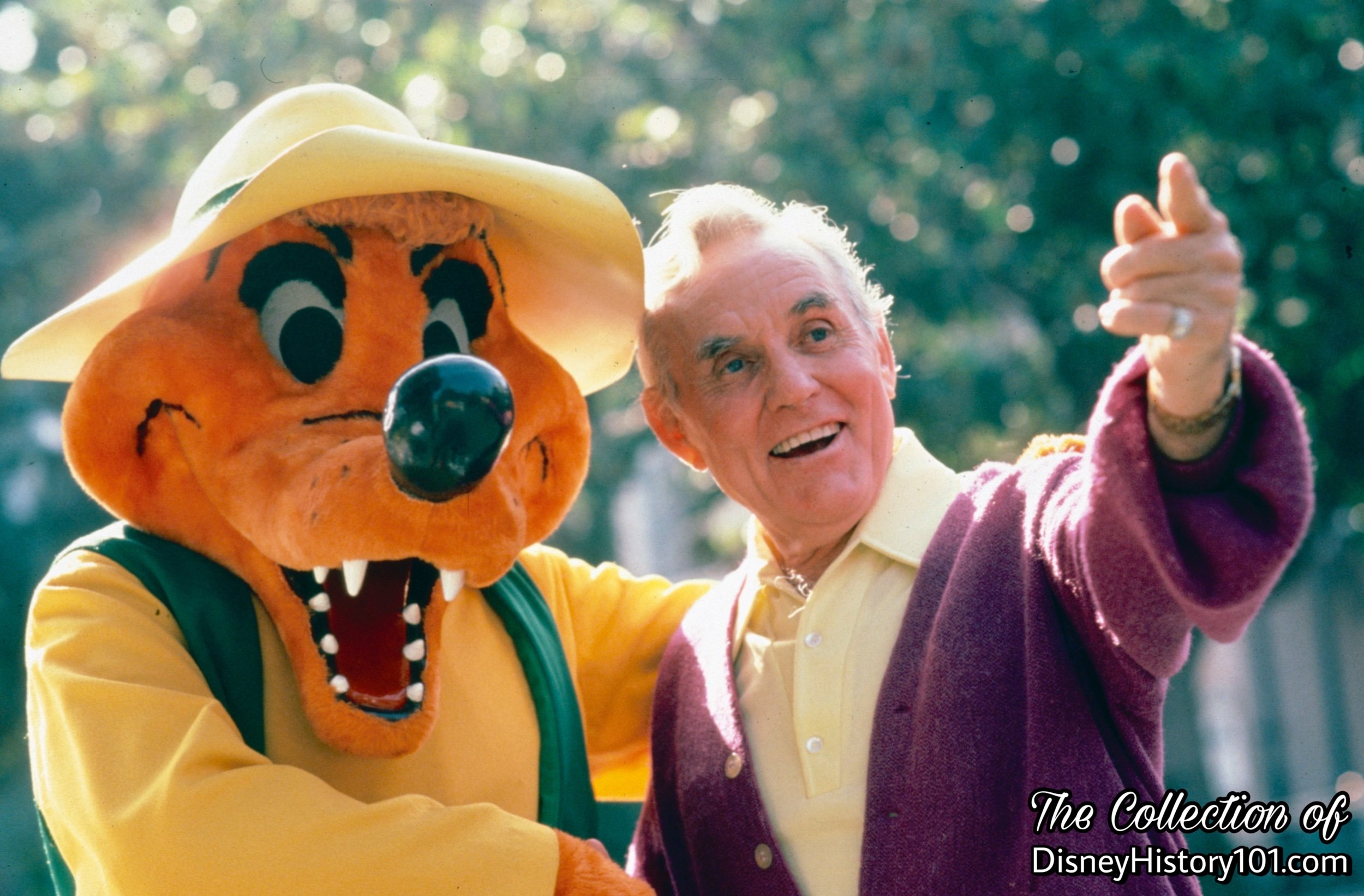
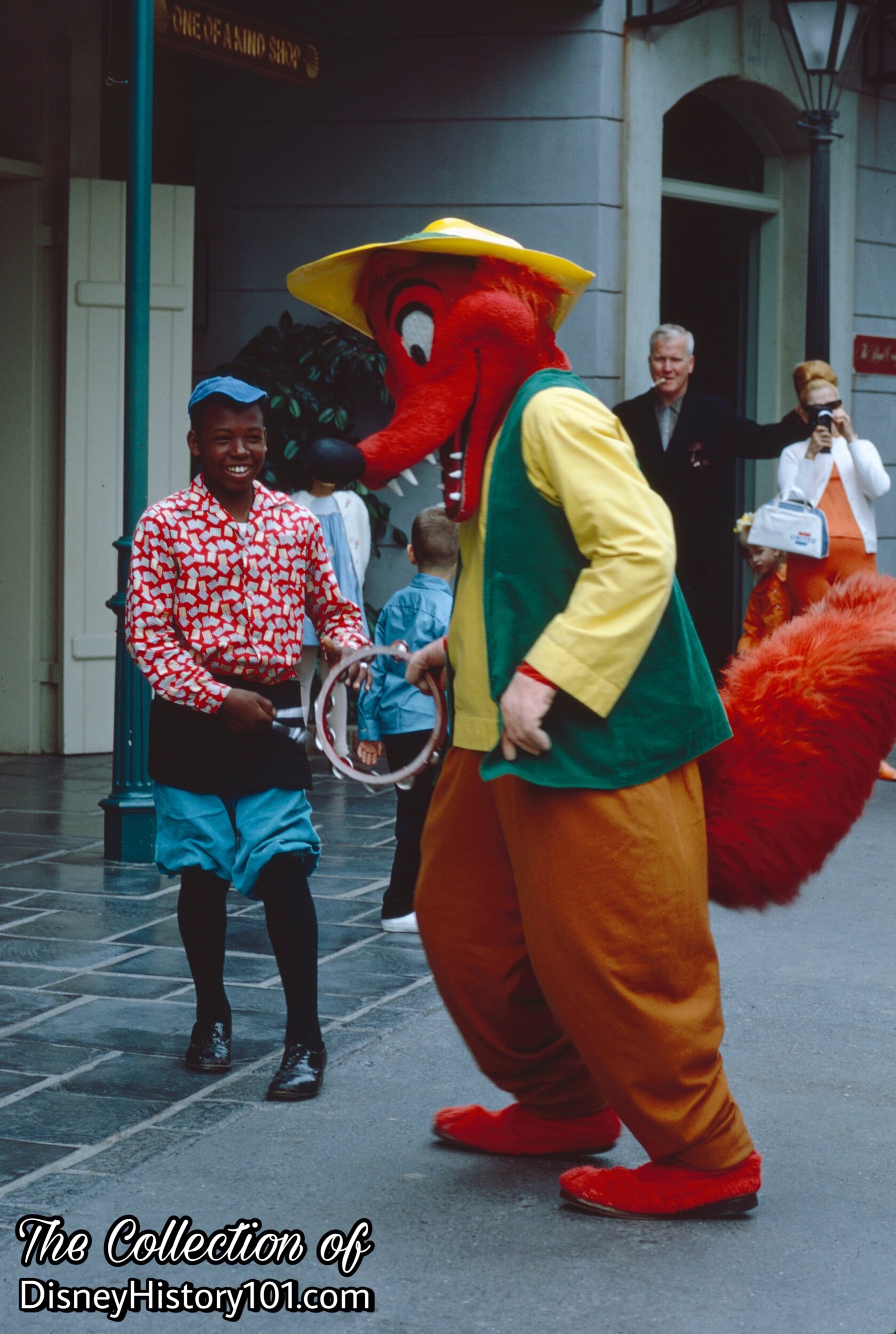
BR'ER FOX
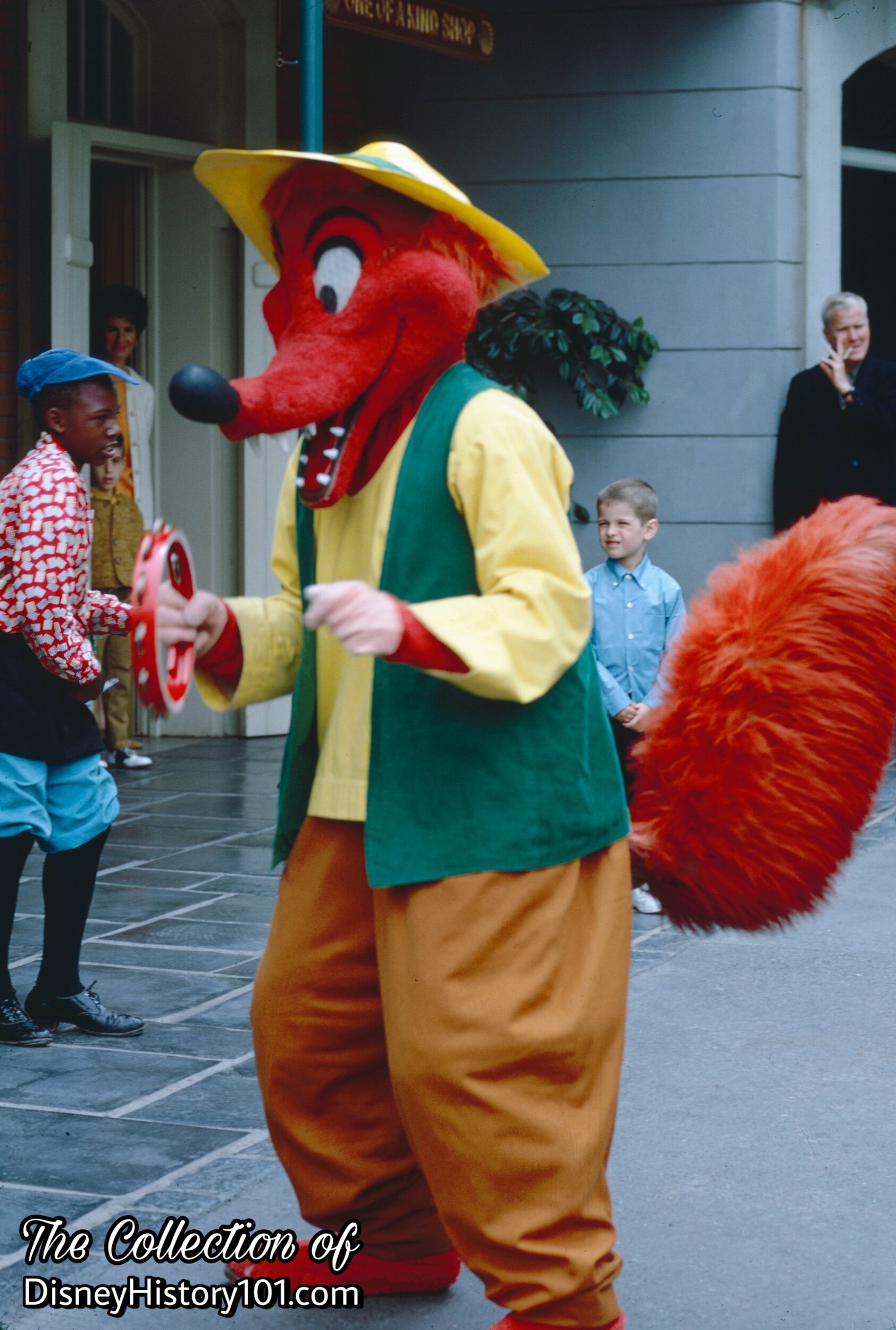
BR'ER FOX
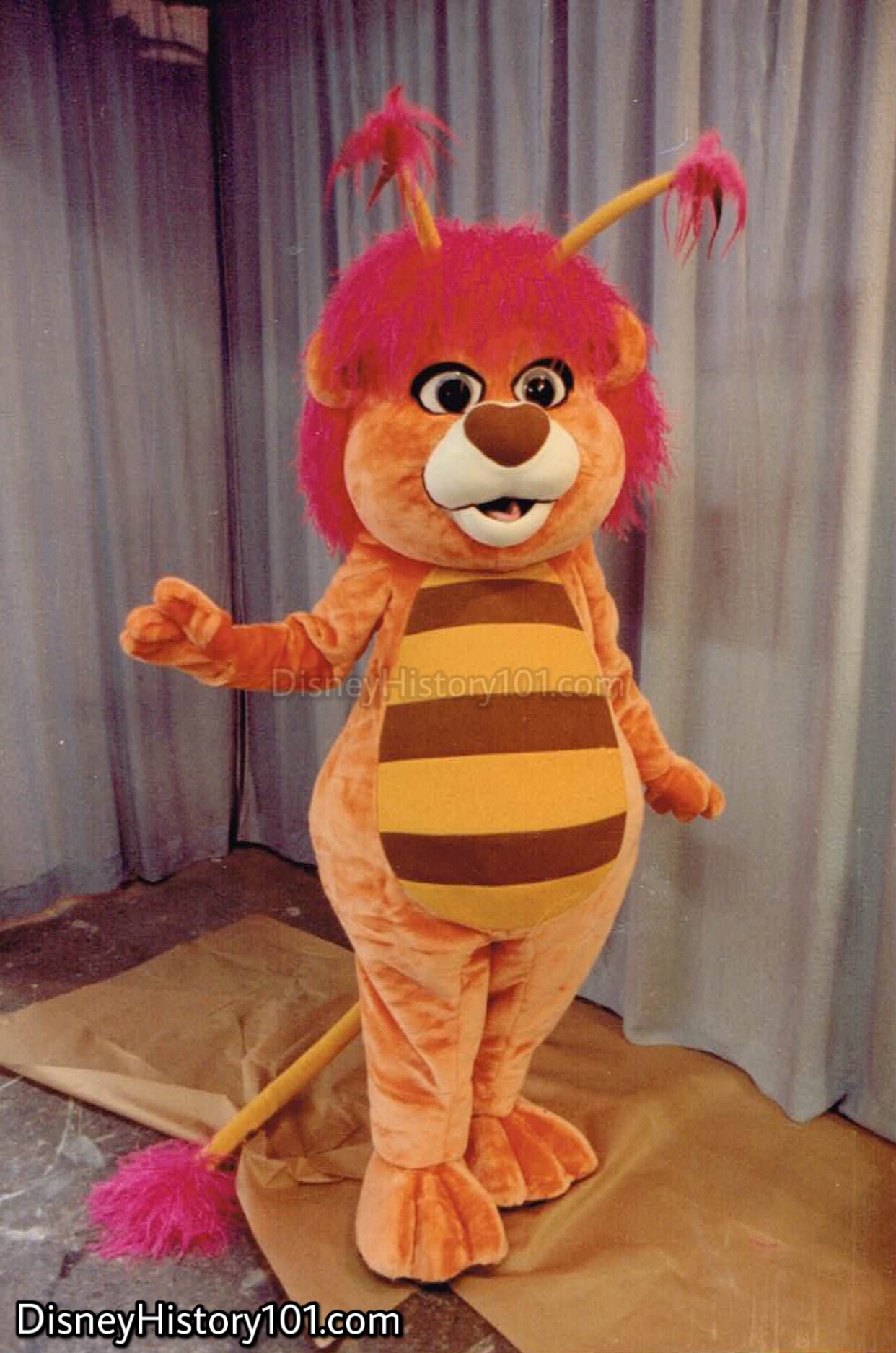
BUMBLELION of The Wuzzles
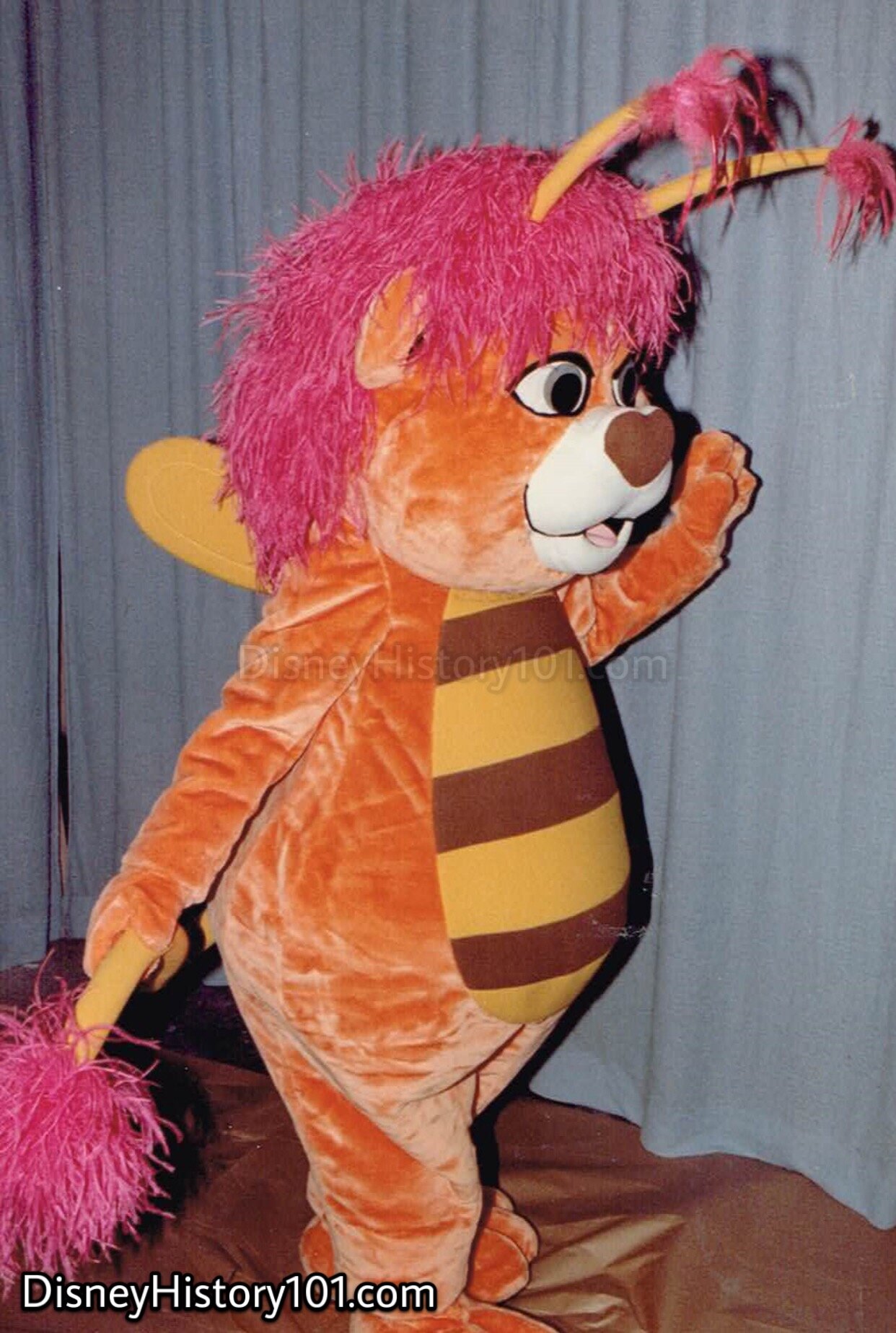
BUMBLELION of The Wuzzles
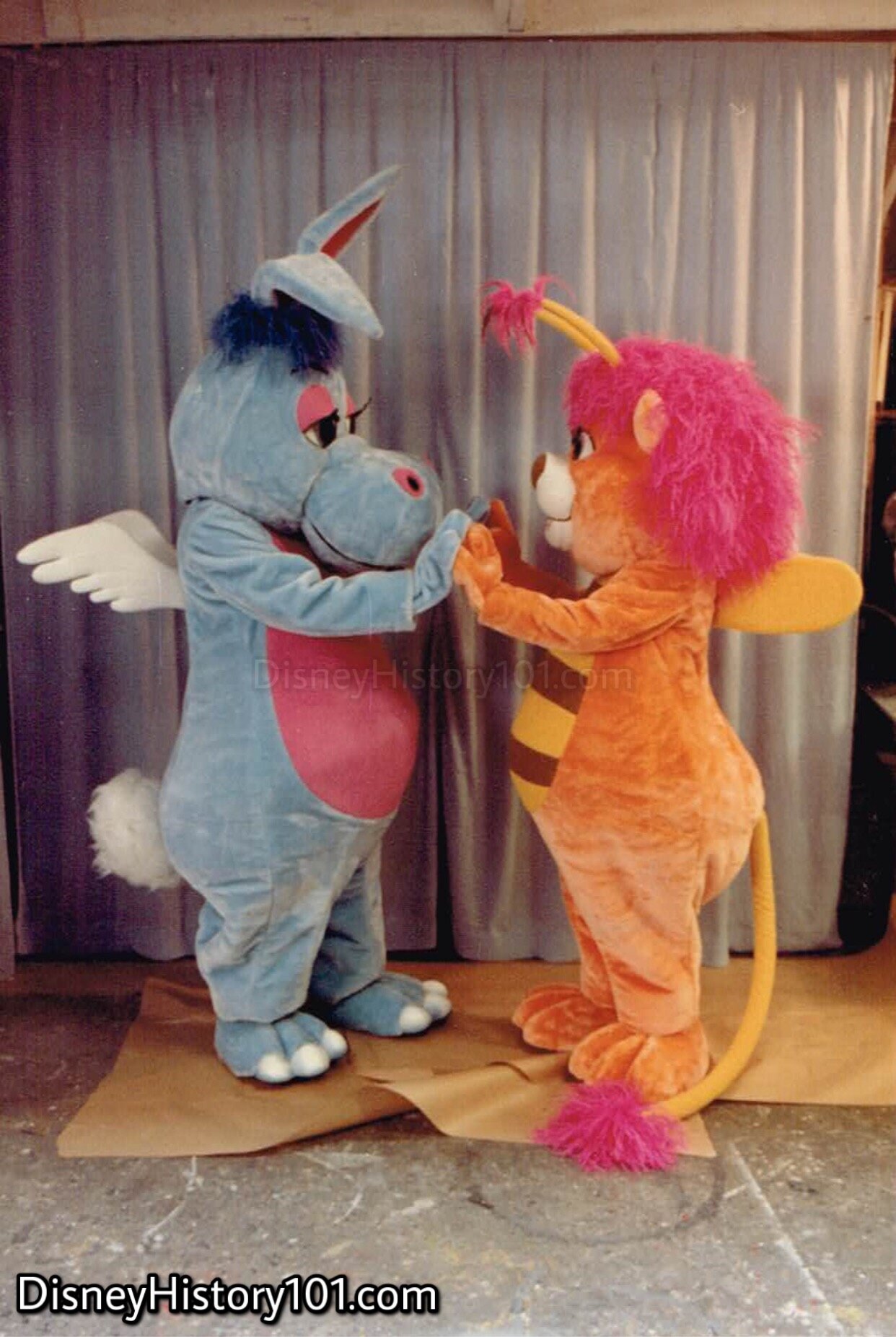
BUMBLELION (and HOPPOPOTAMUS) of The Wuzzles
Since it was established, Disneyland’s theme park operations Disney Code of Guest Service has reminded Disneylanders that “the Magic Begins With” the Cast Member! It looks like Bumblelion and Hoppopotamus are practicing their S.E.R.V.I.C.E. (Smiling, making Eye contact, Respecting each other, Valuing the magic, Initiating guest contact, Creating service solutions, Ending with a ‘Thank You’!
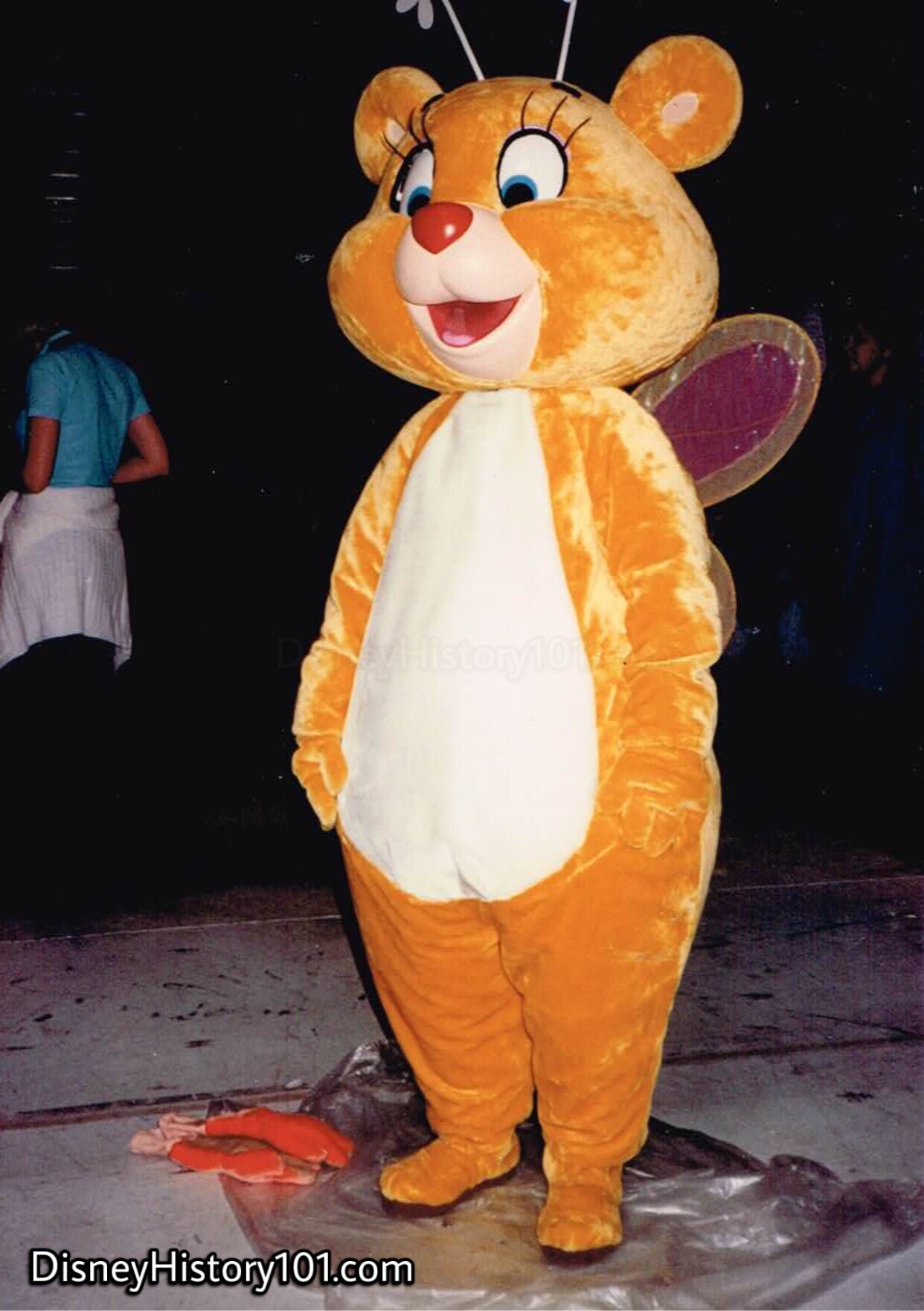
Show Documentation captures the creative intent for Butterbear.
Butterbear prepares to head from Entertainment Costuming, to greet guests on the Stage for the first time (c. 1985)!

In This Section :
•Captain Hook (Peter Pan) - Captain Hook made his theatrical debut in Walt Disney’s Peter Pan on February 5, 1953. The elegant Captain Hook made his Disneyland debut during the summer of 1961. In August of 1962, Lloyd Richardson, Larry Clemmons, Joe Marquette, Coy Watkins, and Jack Leppert (of the Walt Disney Studio) filmed and shot scenery for Studio Production #3185. During this visit, a plate was shot with Captain Hook and six others Characters (including the “Crocodile”) in front of the castle. Captain Hook was part of the Pre-game “Walt Disney and Disneyland Salute to the California Angels” at the new Angels Stadium on Saturday, April 23rd, 1966! Both Peter Pan and Captain Hook made regular appearances at the “Fantasyland Pirate Ship,” greeting guests as part of the Character Program, “throughout the Christmas Holidays” (daily between parades, from 9:00am to 11:45am). [“Disneyland Holiday Talent Master Schedule,” prepared for the period of December 16, 1967 through January 1, 1968]
Cast Members Mike Lopez and Steve Ralsten once served as a Pageant Helpers for Captain Hook.
When Captain Hook hasn’t captured Tinkerbell trying to find the whereabouts of Peter Pan, he can be found at Disneyland.
•Captain Phoebus -
•Cheshire Cat -
•Chip - Chip the Teacup from Beauty and the Beast.
•Chip ‘n Dale - Chip ‘n Dale made their film debut on April 2, 1943. Chip and Dale were given their names by assistant director Bea Selck, who got the idea from the 18th century furniture maker, Thomas Chippendale. Animator Bill Justice is probably best known as the animator who brought Chip an' Dale to life. He animated all but one of the chipmunk cartoons and was the developer of their personalities.
The duo appeared in “Working for Peanuts,” a c.1953 animated short subject filmed entirely in 3-D (and one of the few 3-D cartoons ever produced). Four years later, the chipmunk partners made their big live-action debut at the Ice Capades of 1957, after which Chip and Dale (like most other characters), strolled through Fantasyland (and most of Disneyland), greeting guests without a “timed” schedule. It had been any years since their screen debut in Private Pluto (1943). By this time Chip n’ Dale had appeared in more than 23 short films, and their character models had changed a bit by the late 1950s. Still, this is how Chip and Dale appeared to guests from 1957 to 1961 in Disneyland!
In 1961, new incarnations of Chip ‘n Dale debuted with a total of 33 come to life characters in Disneyland. However (like other Disney Characters), Chip ‘n Dale appeared at quite a few events held outside Disneyland, “training the almost human gorilla” in an act performed at the Canadian National Exposition’s “Matinee Fun Fest” (held August 24 - September 5, 1964). These versions of Chip ‘n Dale (resembling their original appearance) was part of the Pre-game “Walt Disney and Disneyland Salute to the California Angels” at the new Angels Stadium on Saturday, April 23rd, 1966, and were still recognizable and in use during parades and other events until 1968.
By the 1980s, they had starred in more than 24 cartoons, before becoming the current stars of “The Rescue Rangers” on the Disney Channel.
When Dale isn’t going nuts over Daisy’s Peanut Butter pie or being called away on a Rescue Rangers mission, he can occasionally be found meeting and greeting Guests at Disneyland.
•Cinderella - Charles Perrault was the French writer who is best known for his book of fairy tales collected more than 300 years ago, including the original story of Cinderella (The Glass Slipper). Walt Disney’s Cinderella (with significant character contributions provided by Marc Davis) made her theatrical debut on February 15, 1950.
Cinderella married Prince Charming. The film won an Academy Award for Best Song, and remained one of Disney’s most beloved feature-length films. Cinderella is a Disney Face Character who does not sing but can talk, communicate with Guests, and create magical Disney experiences for them. Princess Cinderella owns the Magic Kingdom castle and Tokyo Disneyland castle. Cinderella can usually be found greeting Guests when Suzy & Perla aren’t working on a new ball gown for her, or she isn’t being fitted for some new slippers.
According to “Fantasy Faire - Just Got Happier”: “Cinderella is a kind and gracious young lady who, despite the negative influence of her step-family, knows that dreams can come true. With the support of her mice friends and help of her Fairy Godmother, Cinderella's life changes when she meets her true love at the Royal Ball.”
•Clopin -
•Coachman - from Pinocchio
•Coke Corner Pianist - c.1986
•Colonel Hathi - Then, the “Jungle Book Parades” (consisting of Col. Hathi, Baloo and King Louie) with the Disneyland Band made regular appearances in Adventureland, greeting guests as part of the Character Program, “throughout the Christmas Holidays” (daily between parades, from 9:00am to 11:45am). [“Disneyland Holiday Talent Master Schedule,” prepared for the period of December 16, 1967 through January 1, 1968]
Mike Lopez was once close to Colonel Hathi.
•Country Bears -
•Cruella de Vil - Marc Davis’ Cruella de Vil is a Disney Face Character who can talk, communicate with Guests, and create magical Disney experiences for them.
•Cubbi Gummi (The Gummi Bears) - Disney’s newest stars - The Gummi Bears (and Cubbi) were available for photos beginning in 1987! They were available from 10am until dusk in Big Thunder Ranch. They joined the Disney Characters in Videopolis, and even the daytime New Very Merry Christmas Parade of 1987!
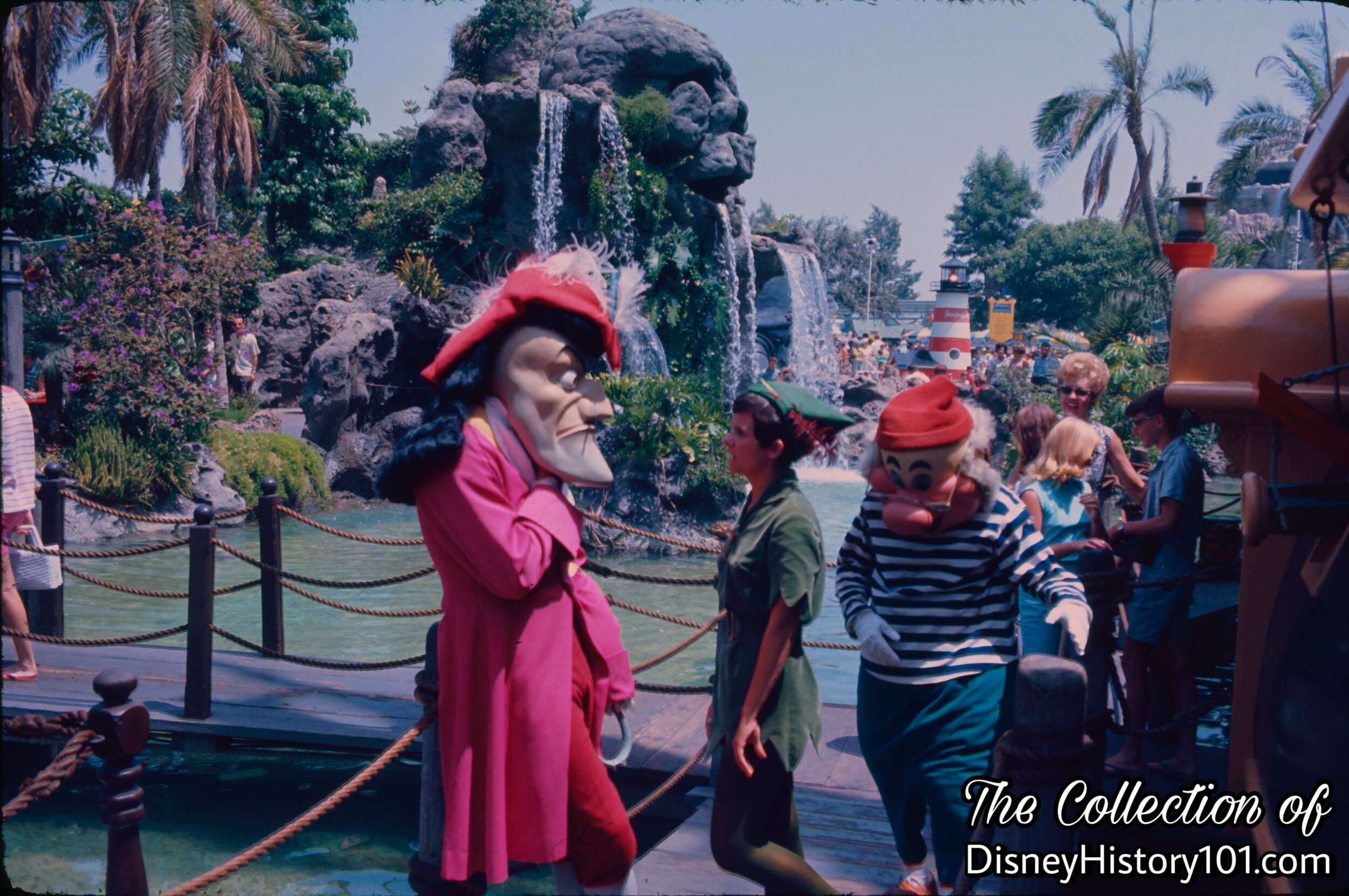
(c. August, 1967)
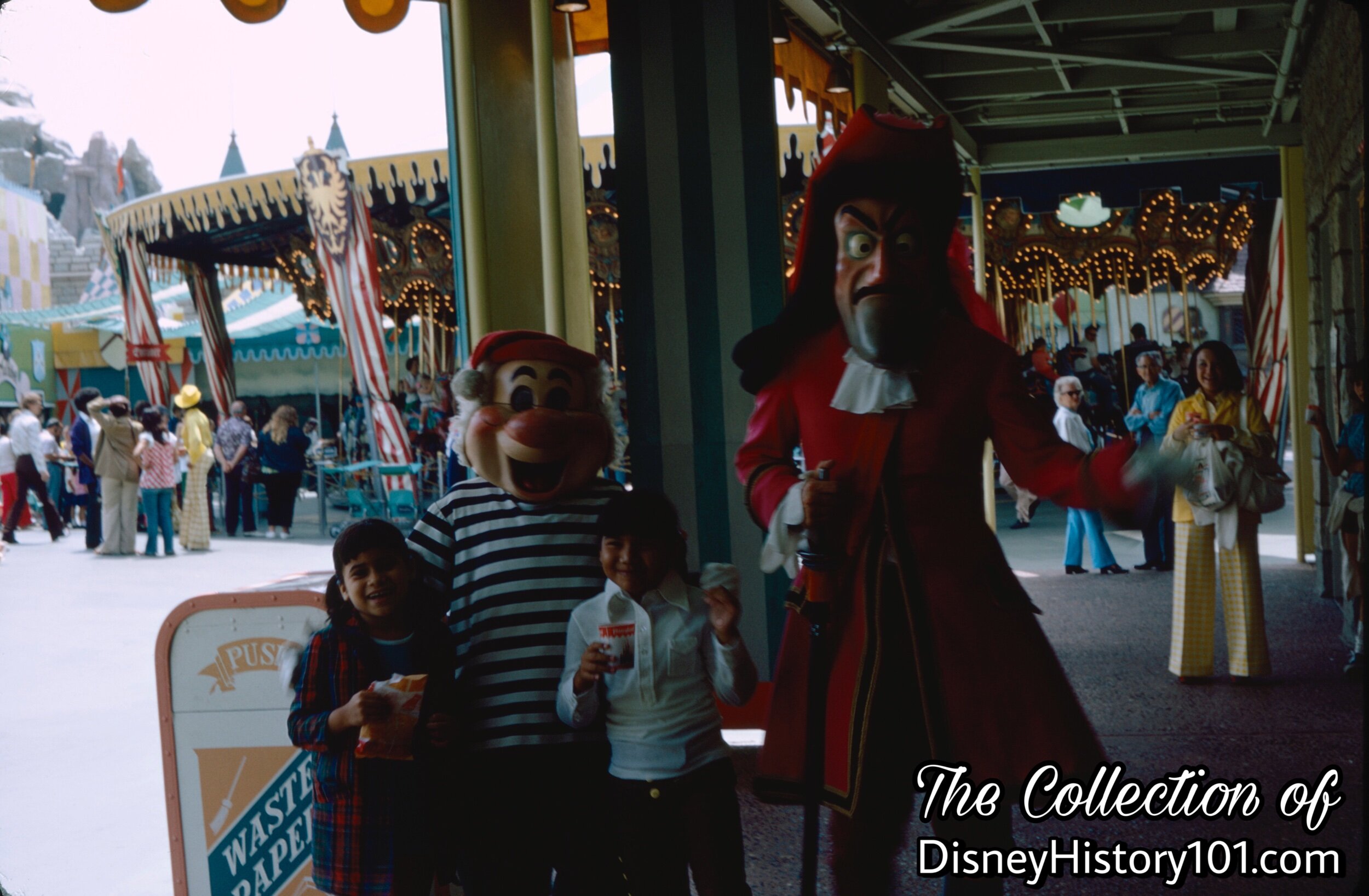
(c. June, 1973)
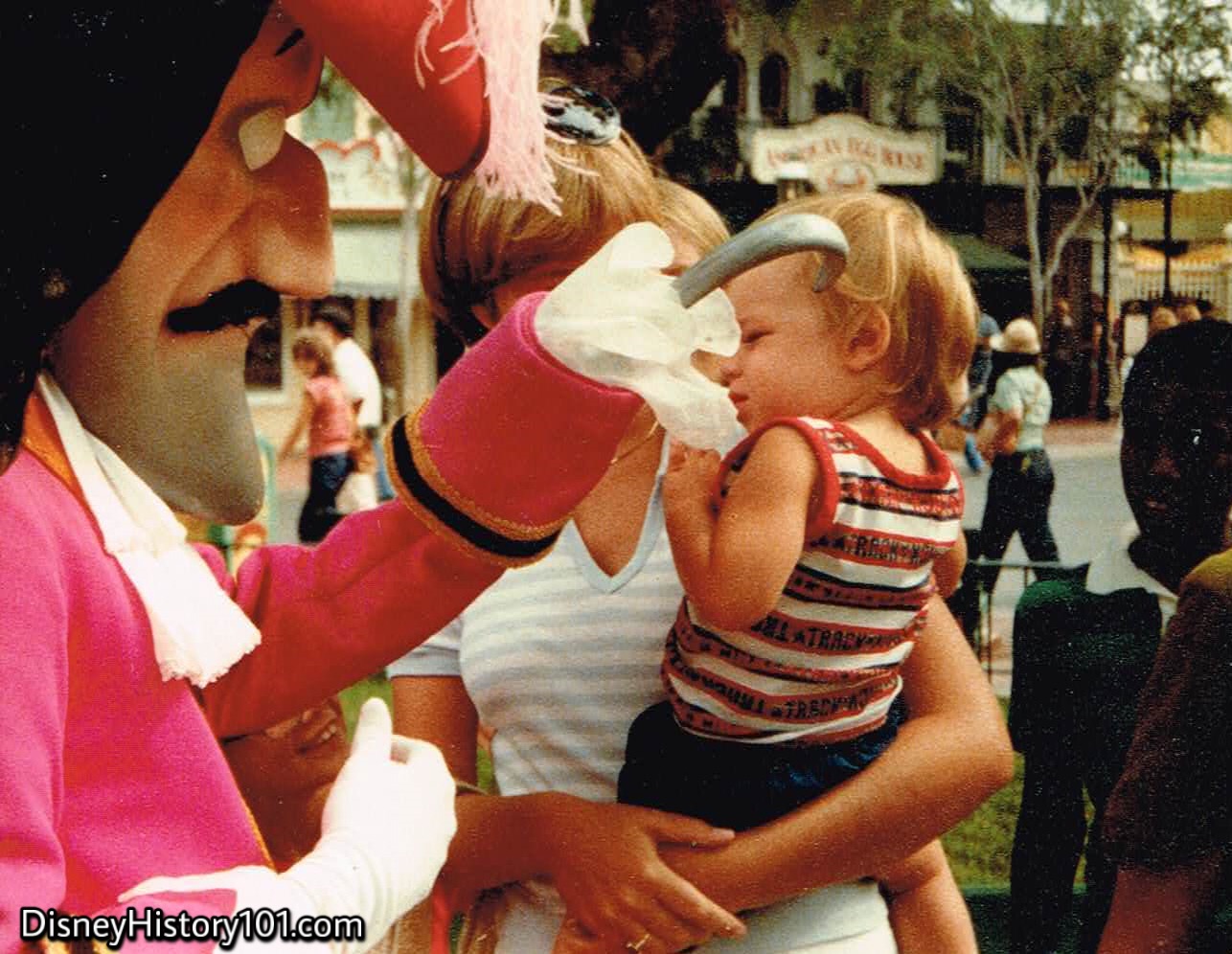
CAPTAIN HOOK, May, 1979.
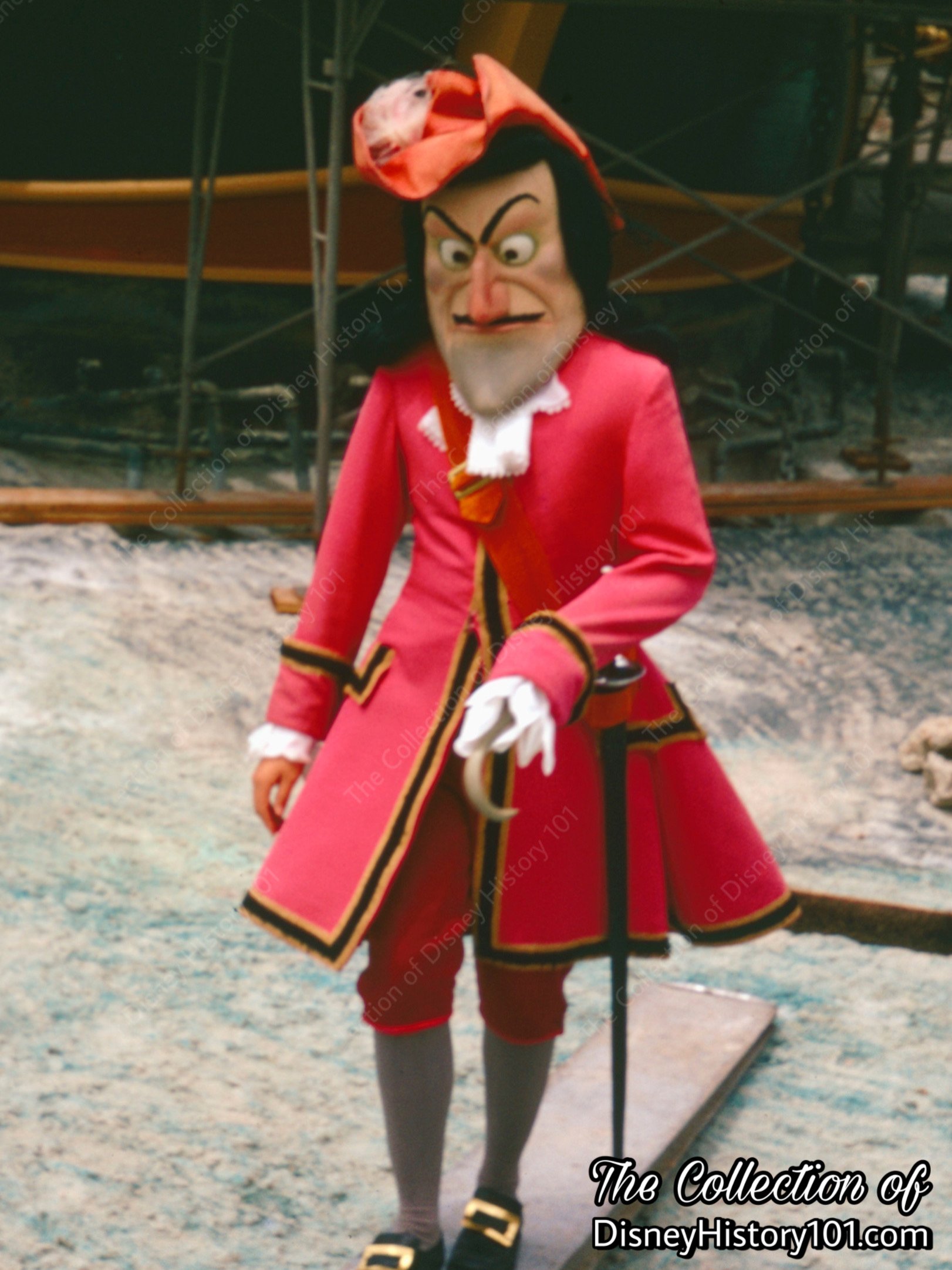

THE COUNTRY BEARS PROMOTIONAL PARADE
The Country Bear Jamboree opened in Disneyland on March 4th, 1972 (a few months after the Magic Kingdom’s incarnation of the show). “Walk-around” versions of the Country Bears were soon seen around Bear Country, as well as making appearances in various Disneyland parades. Even outside Disneyland (in the Santa Maria City Parade on June 3, 1972), Joan Valent (Tour Guide) and Wendell Bear promote the opening of the Country Bear Jamboree!

THE COUNTRY BEARS
Liver Lips, Wendell, and Shaker prepare to “go to town” as they model their fancy new wardrobe courtesy of Disneyland Entertainment Costuming Department!

TERRANCE “SHAKER” at Bear Country Character Photo Location (beginning one hour after Park opening).
You may recollect purchasing postcards which featured some of the Country Bear Jamboree cast. Terrance’s card gave insight into his name with this poem : “Terrance, the Ozark shaker, is always on the prowl ; a strummin’ mountain minstrel with a melancholy growl.”
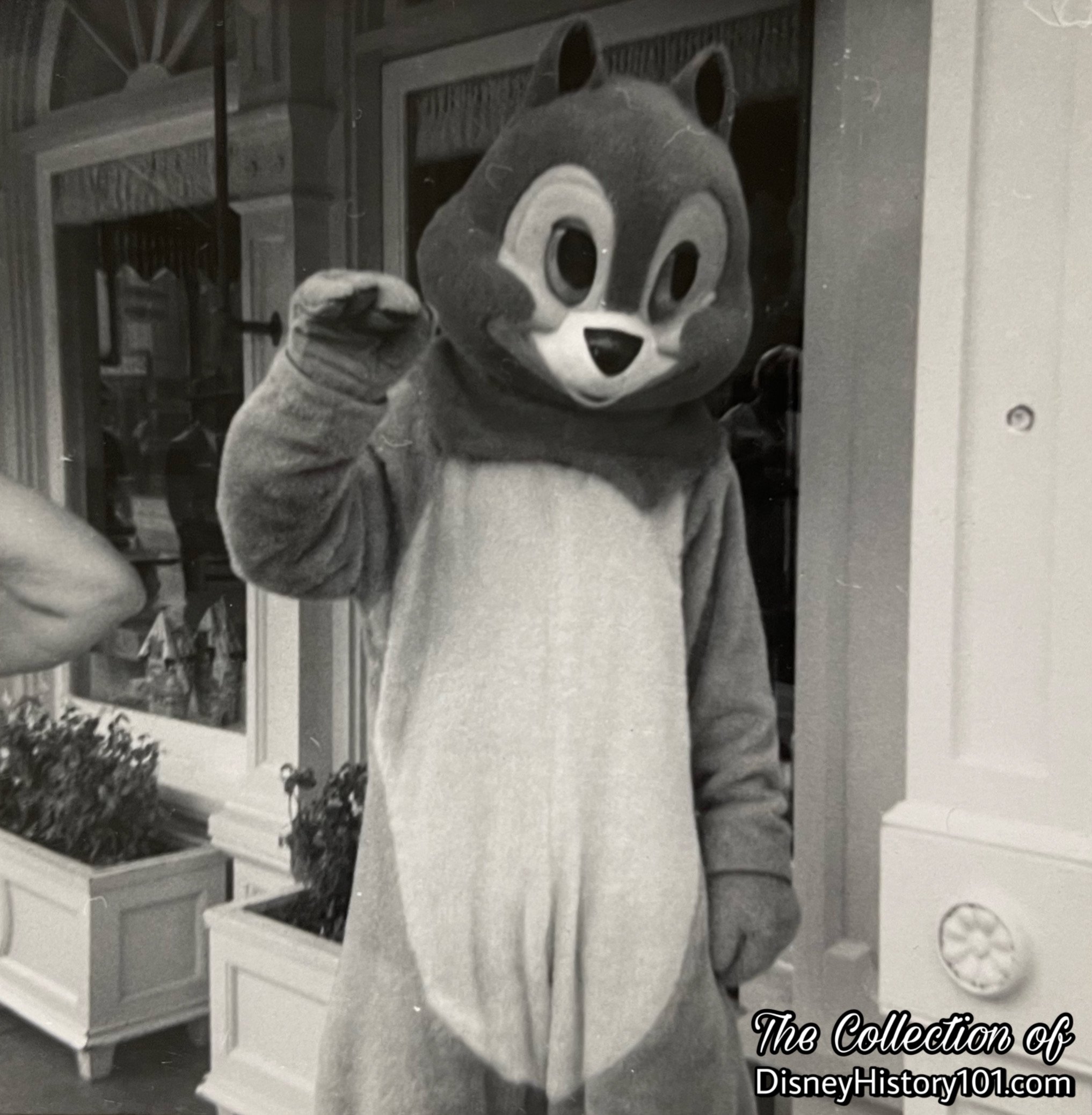
Chip or Dale (December, 1959)
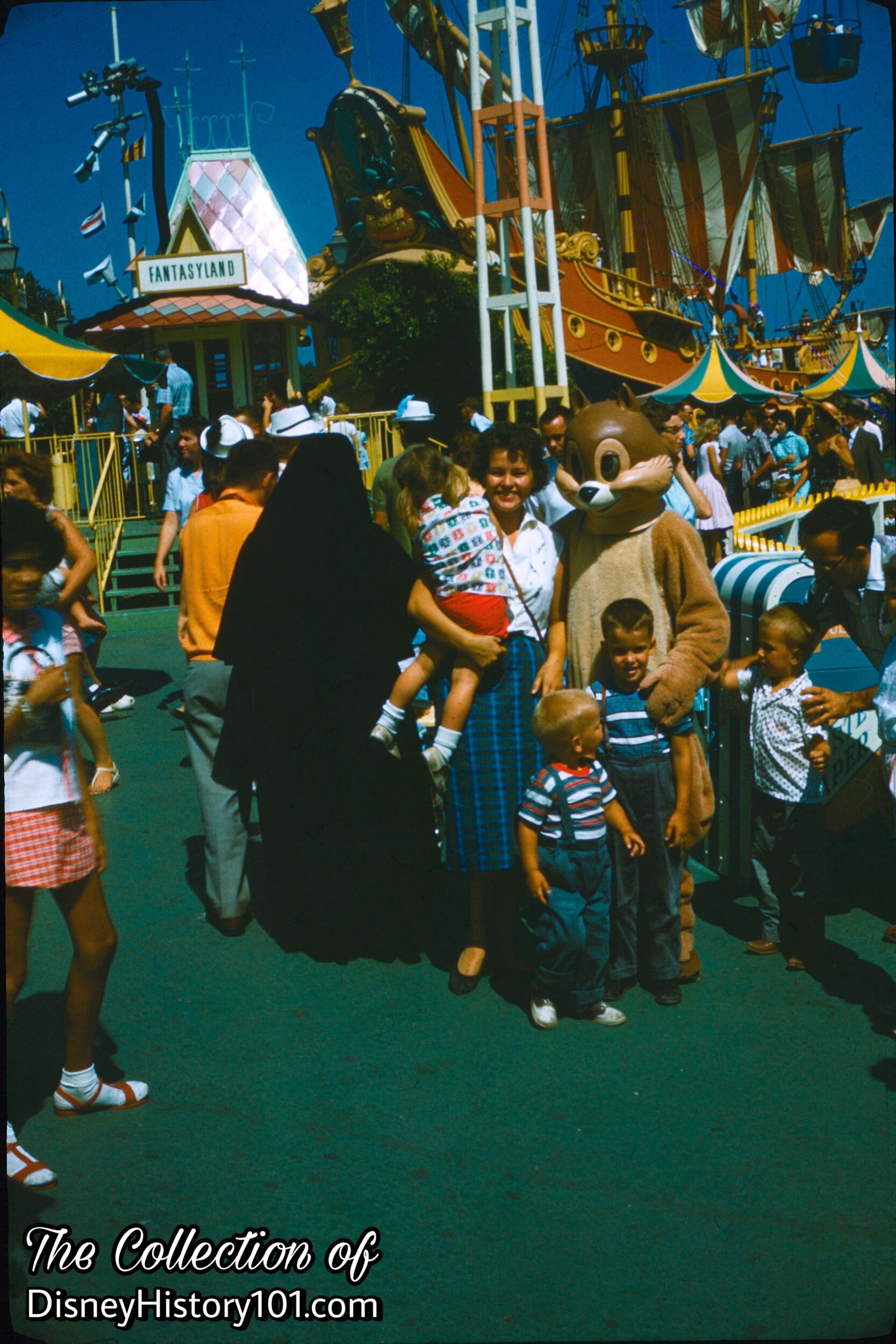
CHIP or DALE (c. 1957)
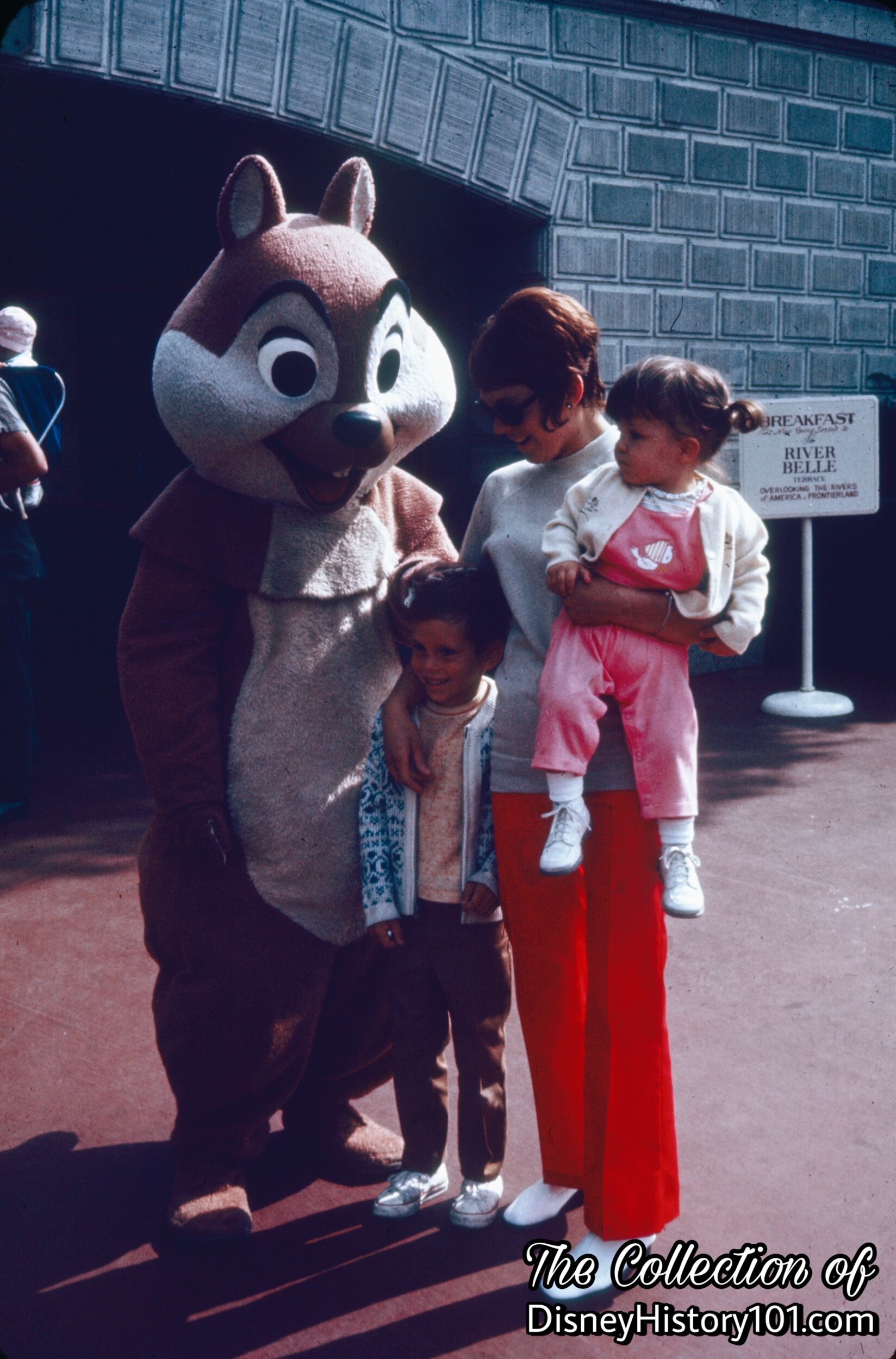
CHIP
Chip is known to occasionally greet guests near Disneyland’s entrance!
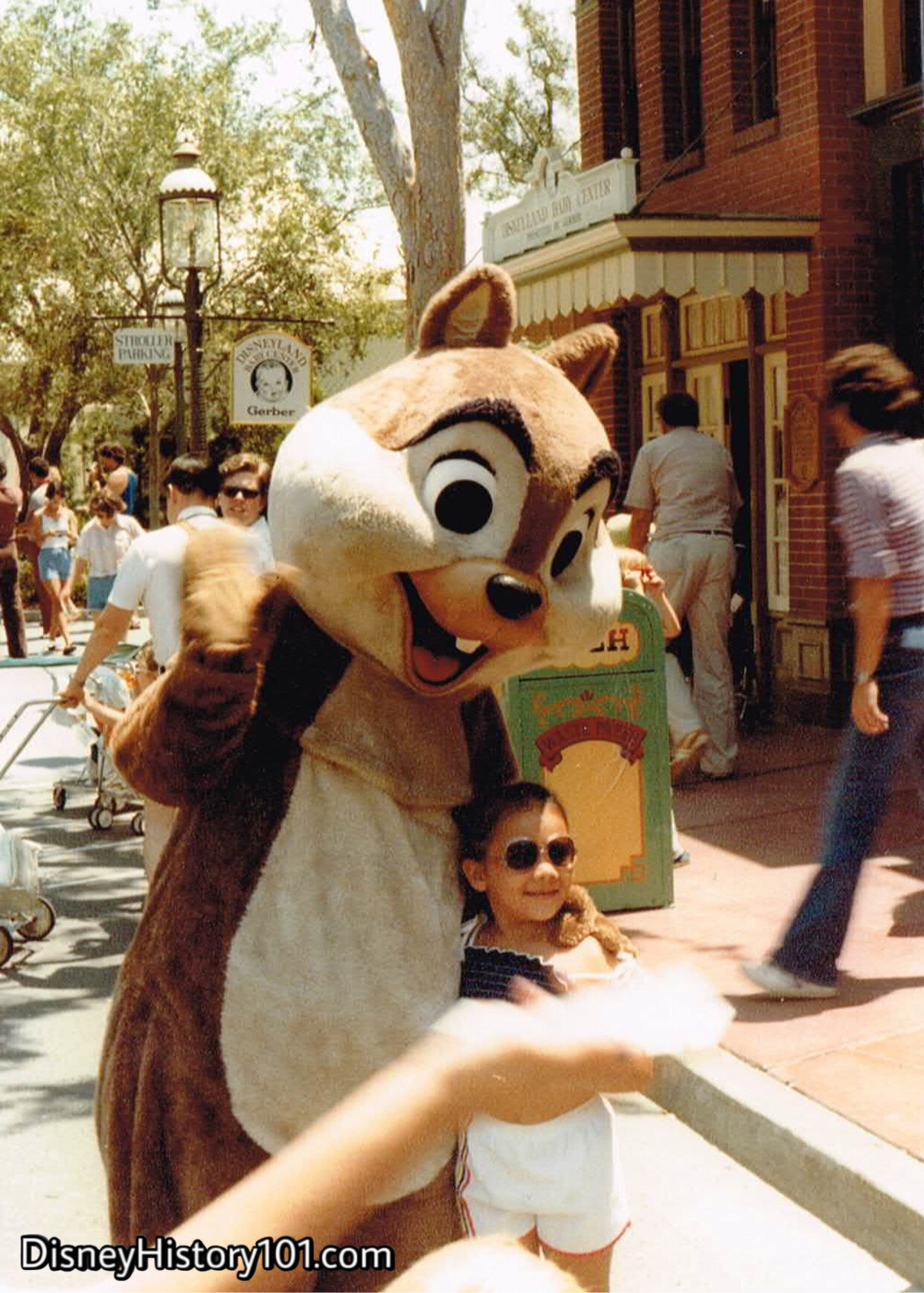
CHIP
Chip greets guests near the Card Corner (c. 1985).
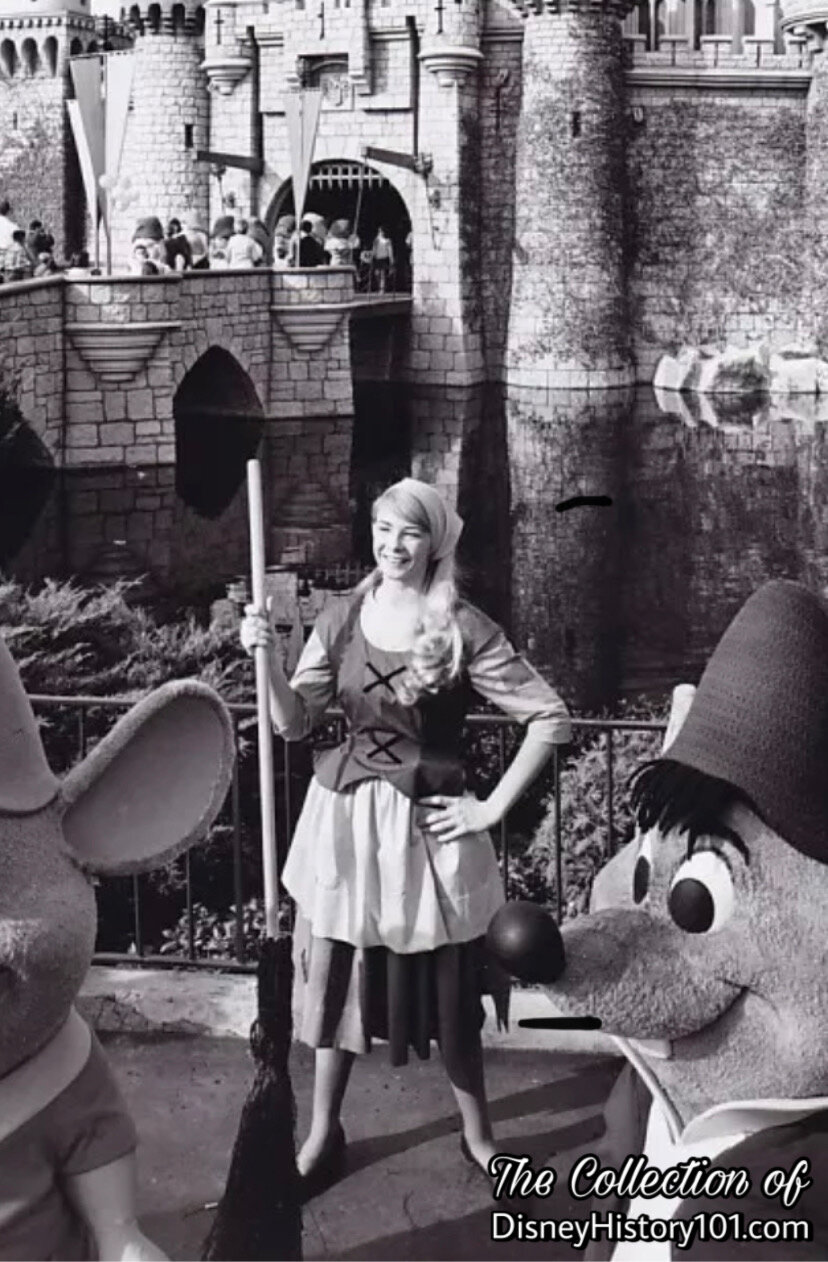
Cinderella
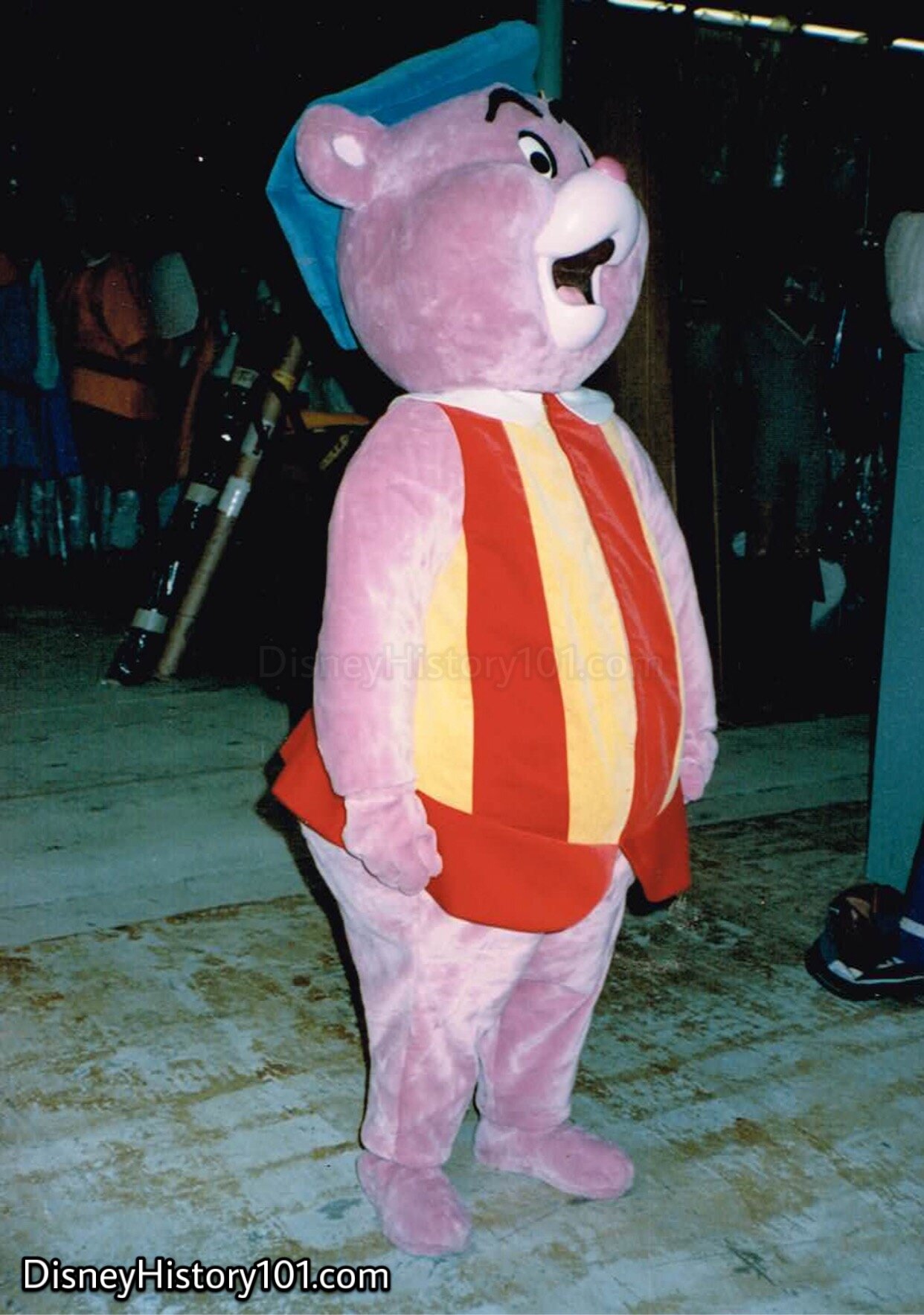
CUBBI GUMMI
Cubbi Gummi waits in the Backstage Area of the Entertainment Costuming Department for his big “on stage” debut!
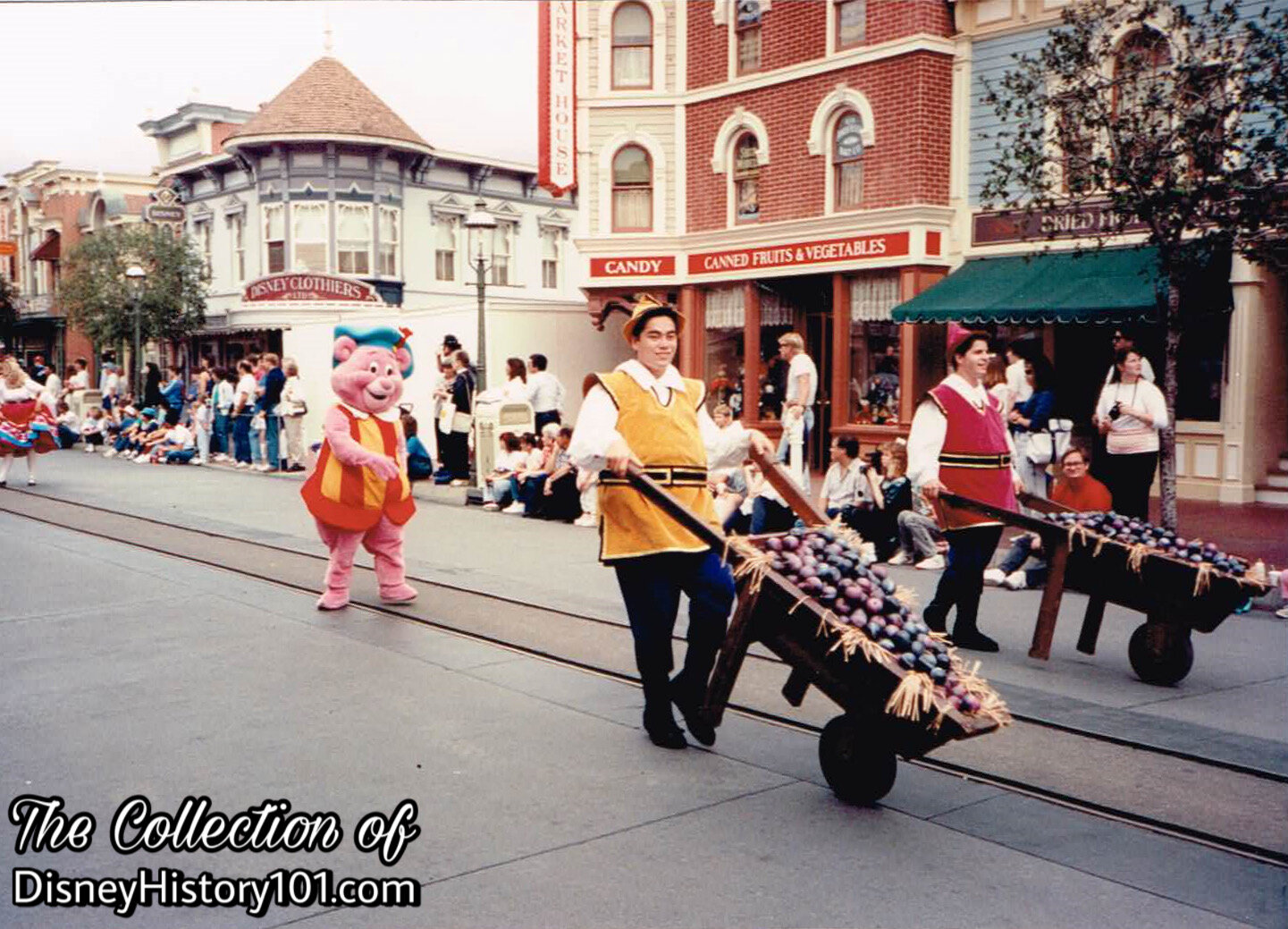
CUBBI GUMMI
Cubbi and follows wheel barrels full of the rarely-seen Gummi Berries!

In This Section :
•Daisy - “Crazy Over Daisy” - “Daisy, you’re the one who’s got me captivated/every time you look at me I get so addlepated.” So went the song lyrics of “Crazy Over Daisy,” released 1950.
Daisy was first called Donna in “Don Donald” released 1937. Judith Martin (a critic) once said that Daisy was a lady “whose idea of heaven is the purchase of a new flowered hat.” According to one source Daisy has been considered a “Disney Standard Character,” meaning that she is a character “of the highest integrity” and “only associates with products, brands, and companies of the highest quality and integrity.” This was true in 1948, when Ingersoll issued the Daisy Duck watch.
Daisy would appear in fifteen films from 1937 to 1988, her last appearance a cameo in the feature film Who Framed Roger Rabbit. Daisy had three nieces in comic book stories: April, May, and June, first appearing in Walt Disney's Comics & Stories #149 (February 1953).
In Norway, Daisy is called Dolly Duck.
•Dapper Dans -
•Dale - Chip and Dale were given their names by assistant director Bea Selck, who got the idea from the 18th century furniture maker, Thomas Chippendale.
When Dale isn’t going nuts over Daisy’s Peanut Butter pie or being called away on a Rescue Rangers mission, he can occasionally be found meeting and greeting Guests at Disneyland.
•Darkwing Duck -
•Disney Street Theater Players - Debuting in 1978, was a “miming, dancing, acting group,” of Disney Characters, born by the Disneyland Entertainment Division and directed by Larry Wilker.
•Disneyland Band -
•Doc - A number of Disneyland Cast Members were close to Doc over the years, including (but not limited to) George Baxter (1971).
•Don Karnage - Baloo’s “Talespin” nemesis appeared five times a day (through the summer of 1991) in “Plane Crazy” in Videopolis at Afternoon Avenue in Fantasyland.
•Donald Duck - Donald Fauntleroy Duck made his film debut on June 9, 1934 in “The Wise Little Hen.” Donald soon had a starring role in his very first publication in 1935. He made his daily comic strip debut the same year he was first nominated for an Academy Award (in 1938) for “The Good Scouts,” after which he appeared in a number of temperamental screen rolls (nine of which were nominated for an Academy Award and one of which won an Academy Award in 1943). Donald appeared in at least 216 (of some 1,200 wartime insignia), more than any other Disney character. Donald Duck also notably starred in one of the few 3-D cartoons ever produced - “Working for Peanuts,” released 1953. Ever since his first appearances at Disneyland, Donald Duck was limited to appearing in parades during Walt’s era. However (like other Disney Characters), Donald appeared at quite a few events held outside Disneyland. According to one source Donald Duck has been considered a “Disney Standard Character,” meaning that he is a character “of the highest integrity” and “only associates with products, brands, and companies of the highest quality and integrity.”
Despite being known as a “spirited sore looser” or an “impatient hothead,” in 1957 Donald Duck took over the “Disneyland” TV series for one week in “Your Host- Donald Duck.” Three years later, 1960 was “The Year of the Duck,” as Donald’s 25th anniversary was celebrated by Walt Disney Productions. Four full hour Donald Duck television shows aired on Walt Disney Presents between February and September. According to one press release, these included “60 solid minutes of Donald Duck cartoons reaching 35,000,000 viewers per show or total cumulative audience of 140,000,000.” Donald would also appear in a new series of cartoon theatrical short films like the educational short film “Walt Disney presents Donald in Mathmagic Land,” new Donald Duck Dell Comic Books, 243 daily comic strips, and 109 Sunday Donald Duck Color Pages in newspapers (with a circulation of 28,000,000).
A few years later, Donald appeared with Clarence Nash at the Canadian National Exposition’s “Matinee Fun Fest” (held August 24 - September 5, 1964).
During this time, many individuals became acquainted with the duck with “the sweetest disposition,” including Steve Berk (some time after 1969). Glenn “Ducky” Galey was the closest to Donald Duck (during the late 1970’s and early 1980’s). You may recall that it was common to see Donald Duck appear in parades at Disneyland by riding in an “‘03 car driven by Operations.”
During the 1970s, Donald appeared in Main Gate/Town Square.
After the Disney Channel began its premium cable service in 1983, Donald starred in “Donald Duck Presents” followed by “Down and Out with Donald Duck.” In 1984, Donald Duck (Disneyland’s official Diction Coach) received a slight redesign (of his lower body and feet, finally enabling him to walk parade routes). In 1984, Donald Duck was successfully and honorably discharged from the army, receiving a brand new sailor suit in honor of his 50th birthday (which coincided with the 30th anniversary of Disneyland)!
Today, Donald Duck is known as Tang-Lao-Ya in China.
In the present, Mickey Mouse, Minnie Mouse, Donald Duck, Goofy, and Pluto are still considered the original "Fab Five" VIP Characters. When Donald isn’t getting paint to fix up the Miss Daisy or wrapping a gift for Daisy, he can occasionally be found meeting and greeting Guests at Disneyland.
•Dopey (Snow White and the Seven Dwarfs) - Dopey “don't know [how to speak], he never tried.”
Paul Castle is perhaps one of the first character actors (known by name) to work so “close to” the first incarnation of Dopey to appear at Disneyland. He did so after portraying the iconic character during the 1959 Ice Capades production of Snow White and the Seven Dwarfs.
By the summer of 1961, the 2nd incarnation of a “come-to-life” Dopey made his Disneyland debut (courtesy of Walt Disney Studio character designer Bill Justice)! Dopey soon made several appearances outside Disneyland. He was among a caravan of characters that represented Disneyland in the multinational 1964 New York World’s Fair parade! When the parade was finished, he was known to make appearances greeting guests near the Tower of the Four Winds. After the fair was over, Dopey could often be found greeting guests near the Disneyland Main Gate!
A variety of Cast Members would be “close to Dopey” through the years, including Bill Carson (1971).
•Dumbo - Walt Disney’s Dumbo debuted October 23, 1941. Two special parades featured Dumbo, and guests could meet and pose for pictures with Dumbo on January 16 & 17, 1971
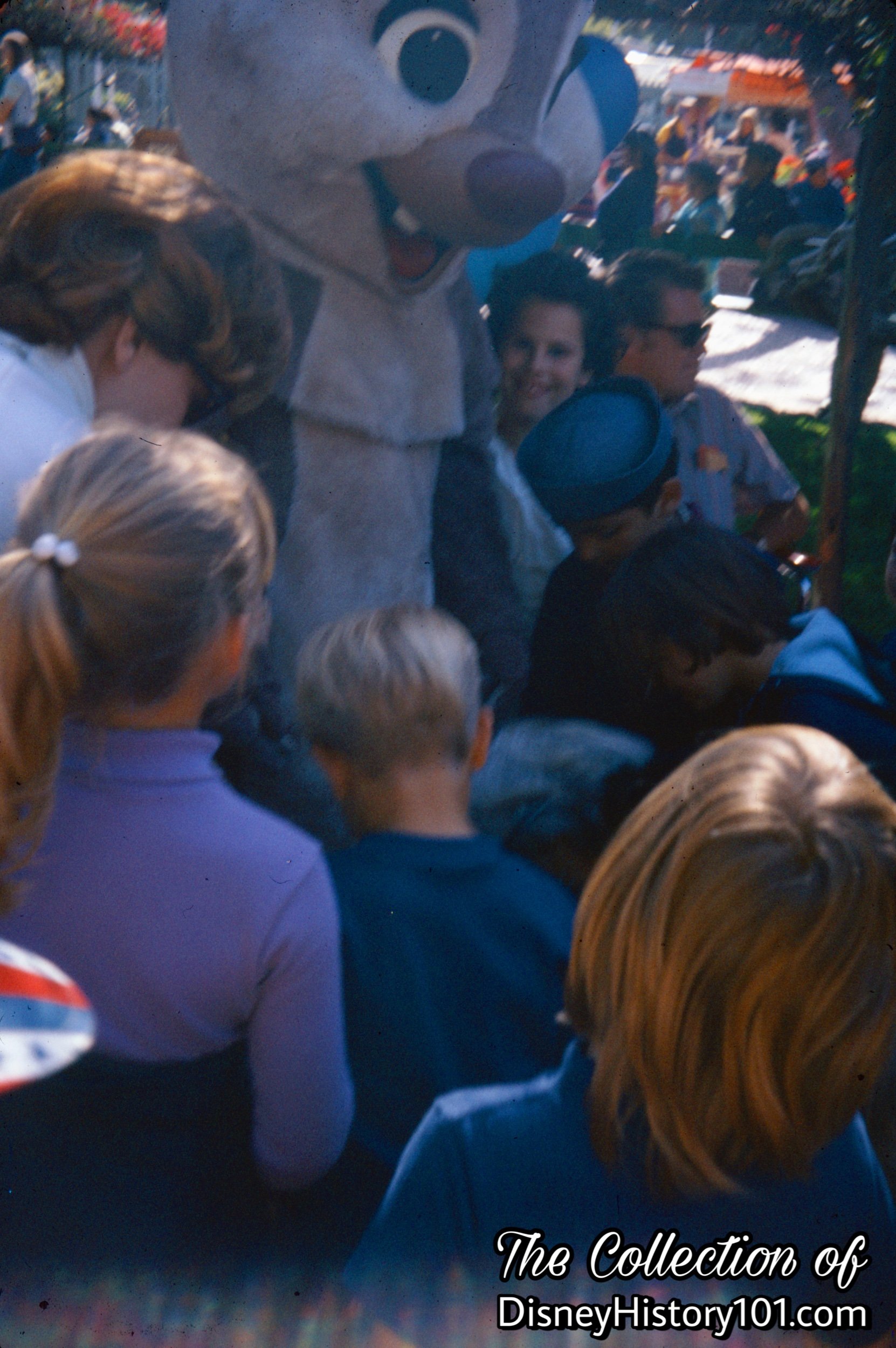
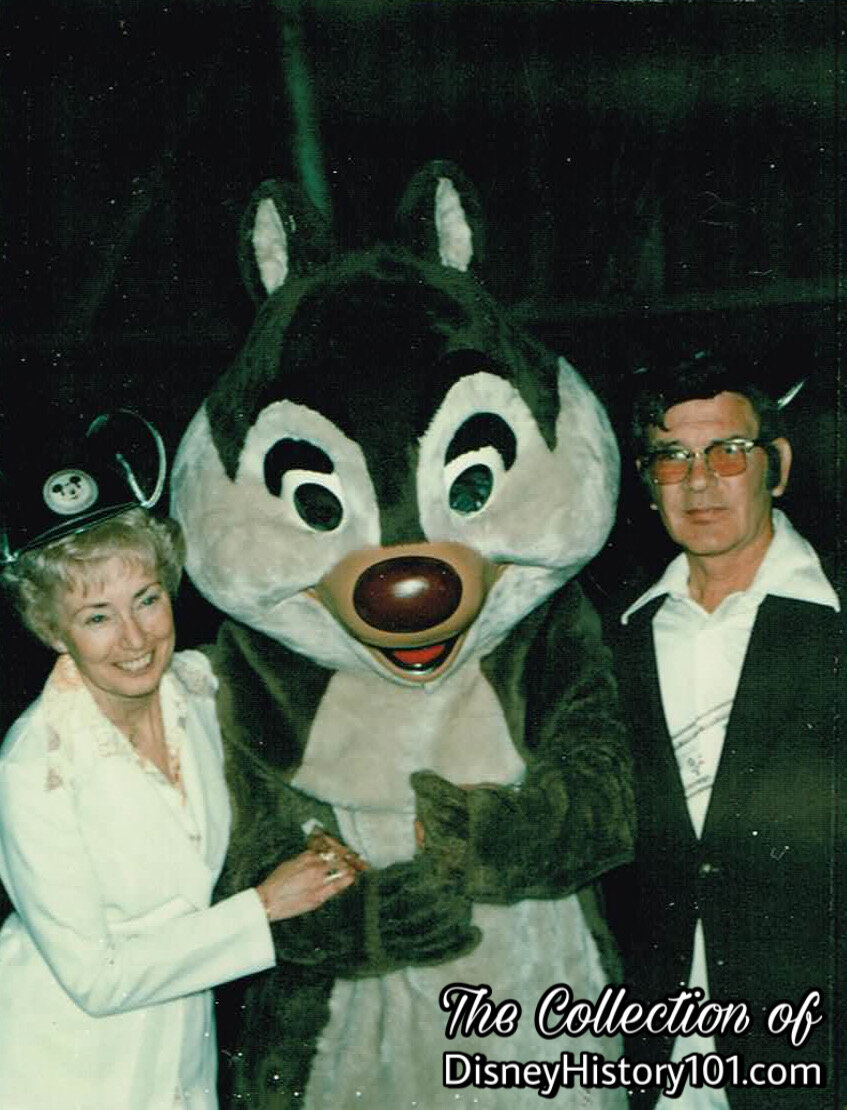
Dale, (April 11, 1980)
Tim Brandt (Disneyland Security) and Priscilla (Disneyland First Aid) meet Dale during Disneyland’s 25th Family Reunion event!
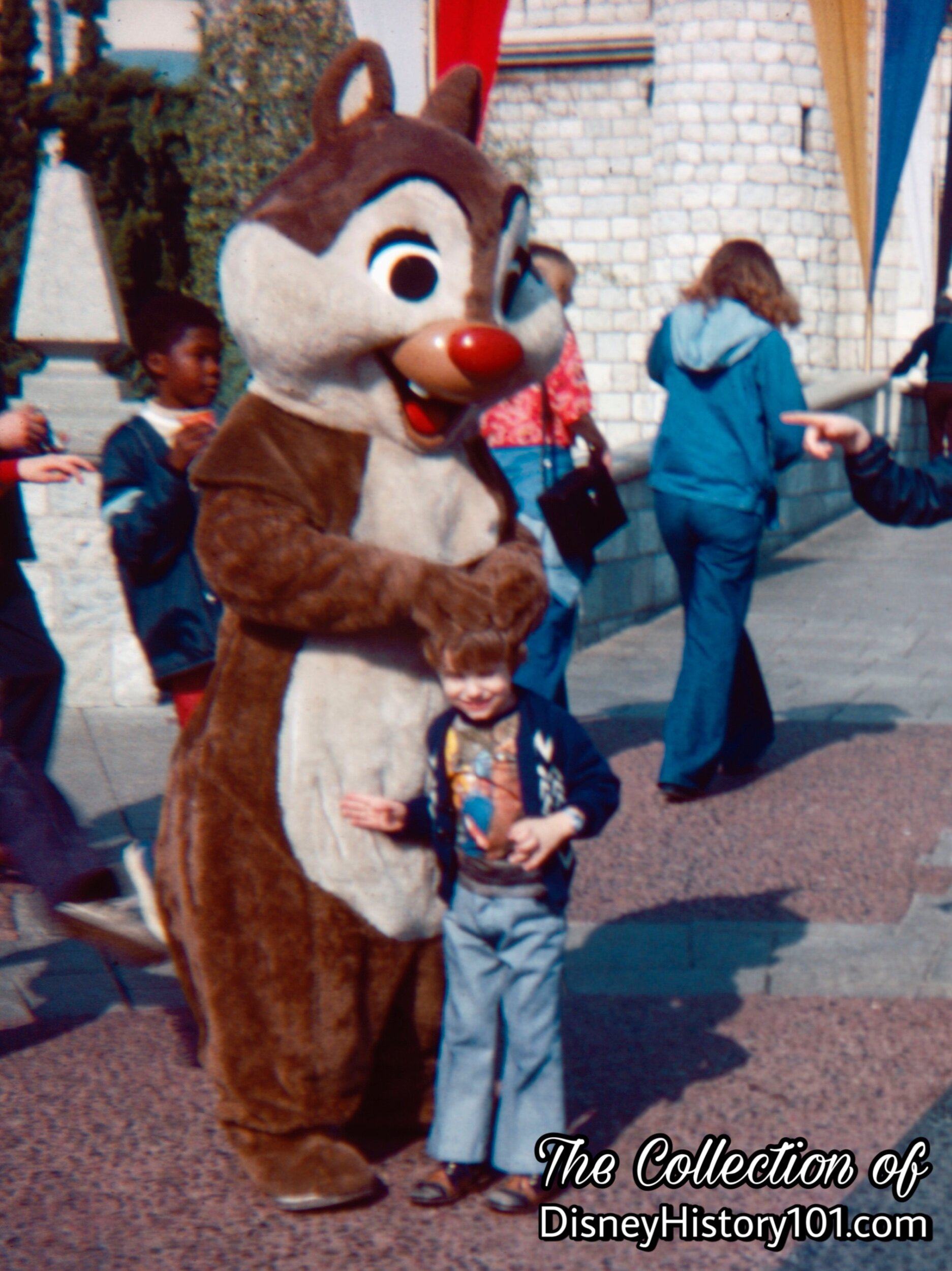
DALE, (1977)
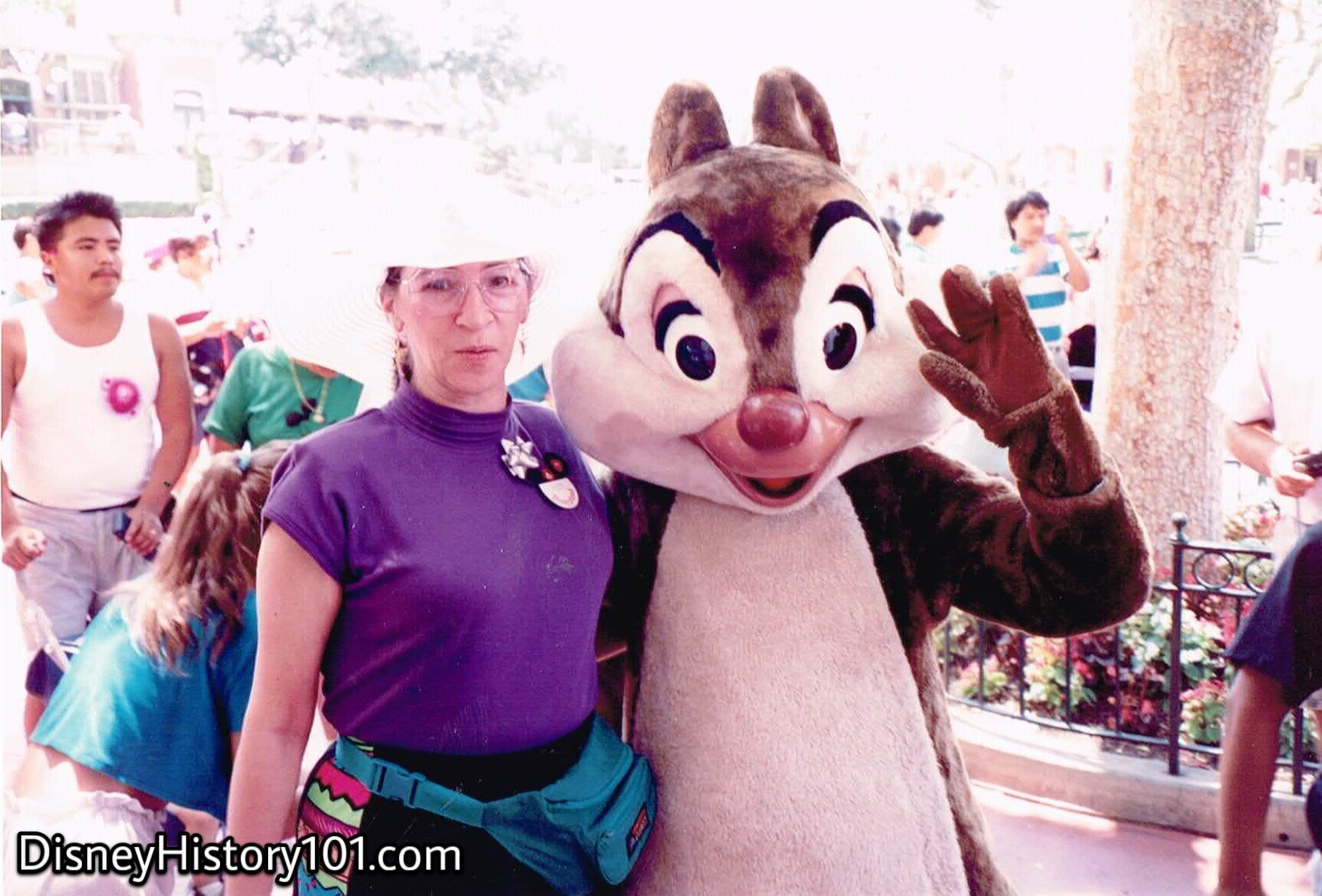
DALE
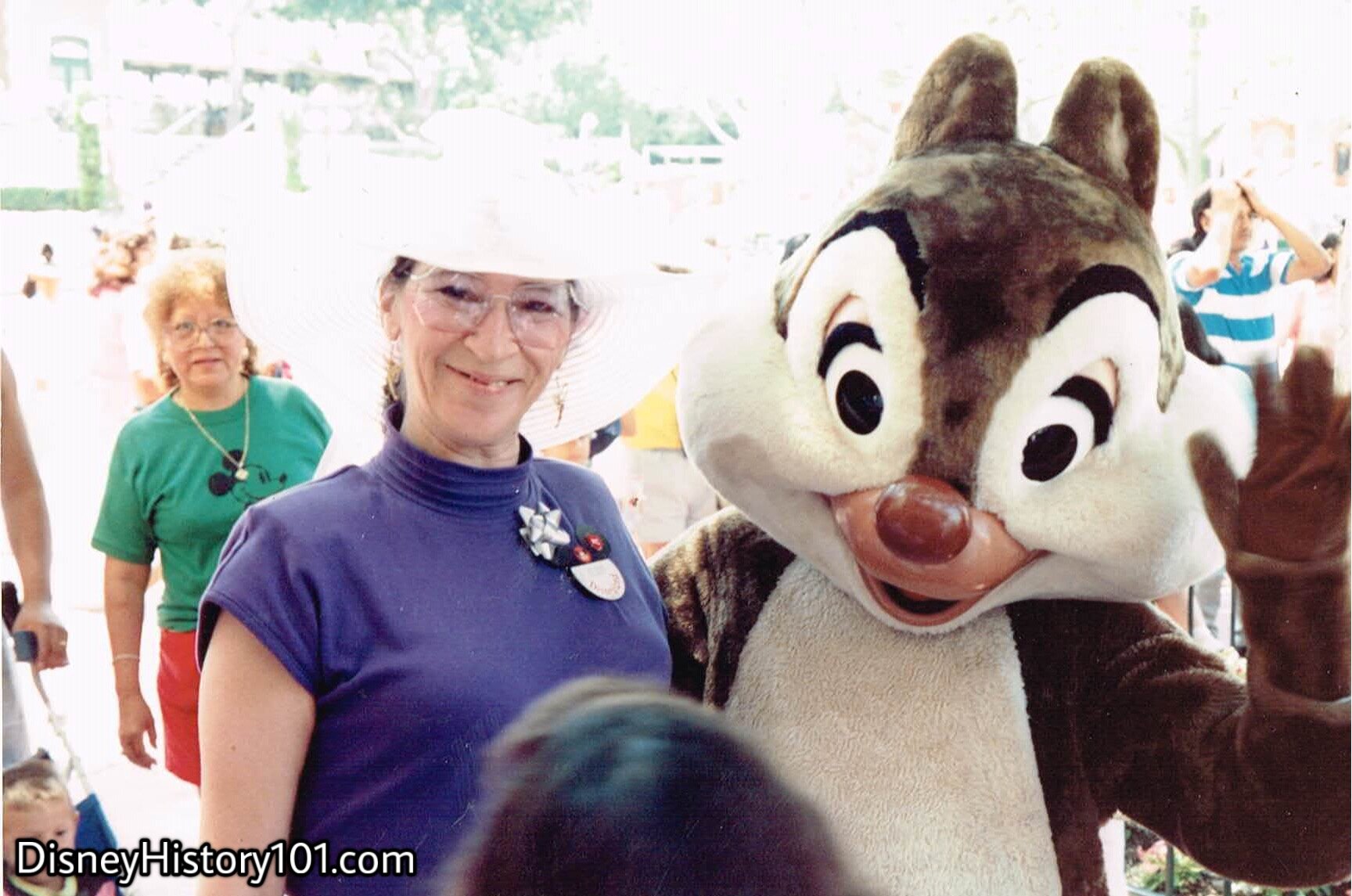
DALE
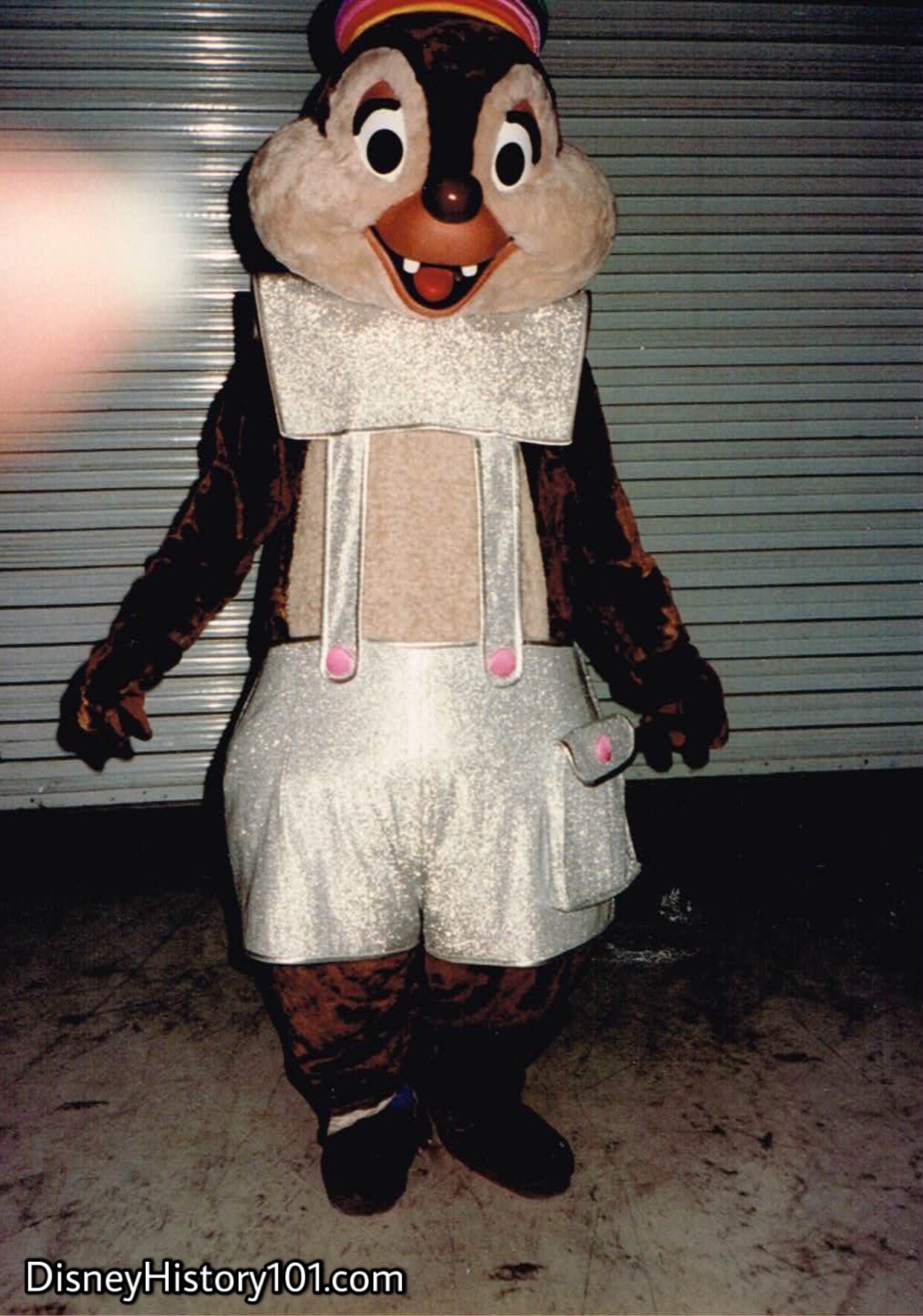
DALE
A special costume was made for Dale (to help celebrate the opening of Captain EO).

“Disneyland After Dark,” 2018.
In the recent decades, certain Characters have made occasional reappearances in Disneyland. These Characters are referred to as “Specials” -any out-of-the-ordinary appearance at a convention, filming, photo shoot, hospital, etc. For example, during Disneyland After Dark (2018), Merlin, Jimmy Cricket, and Flora greeted guests. You may recall that Merlin the Magician regularly officiated the Sword in the Stone Ceremony four times daily on weekends during the 1980s. Our favorite character from the first Disneyland After Dark event (not pictured), was Mickey dressed as Zorro!
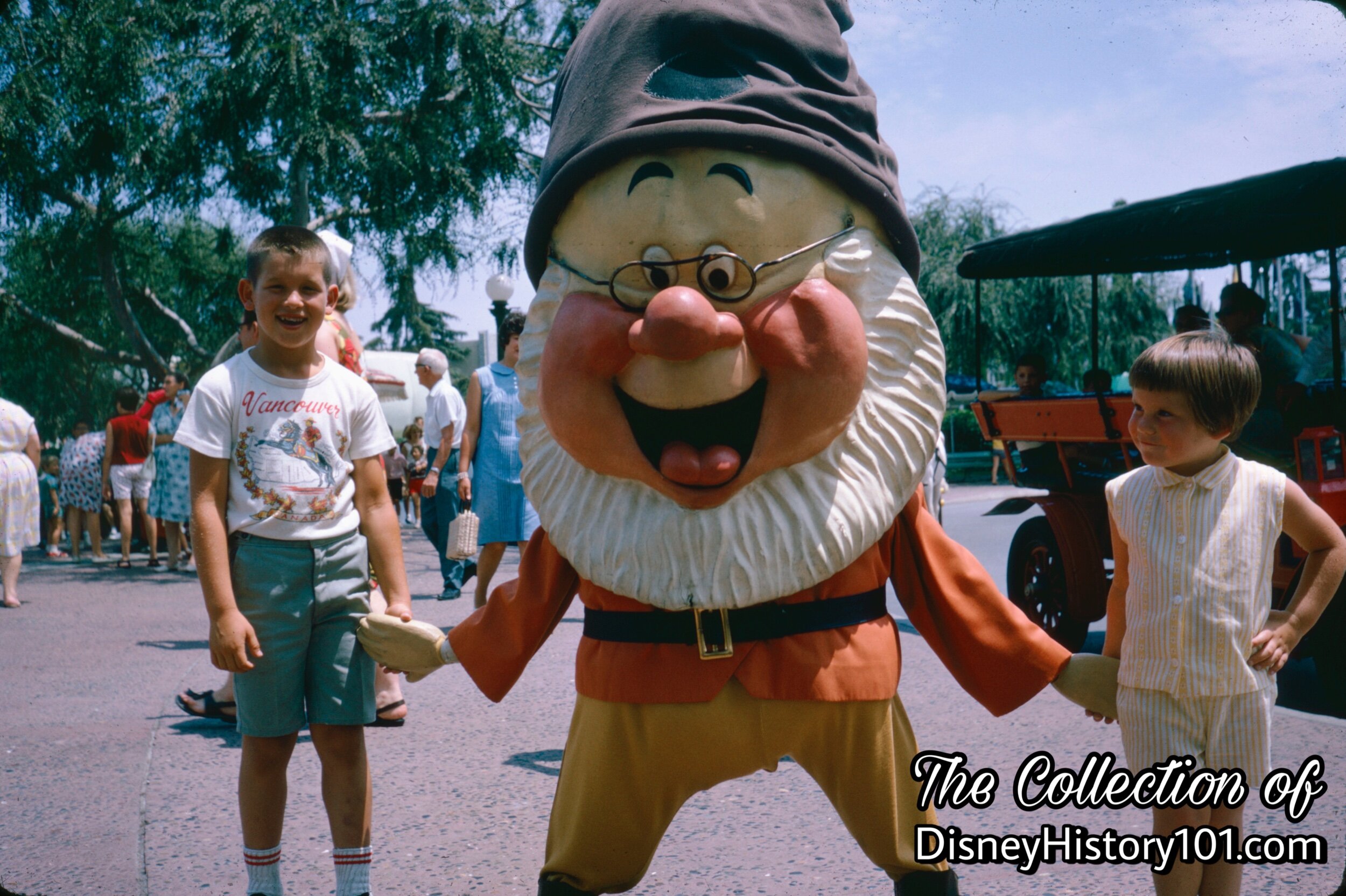
DOC
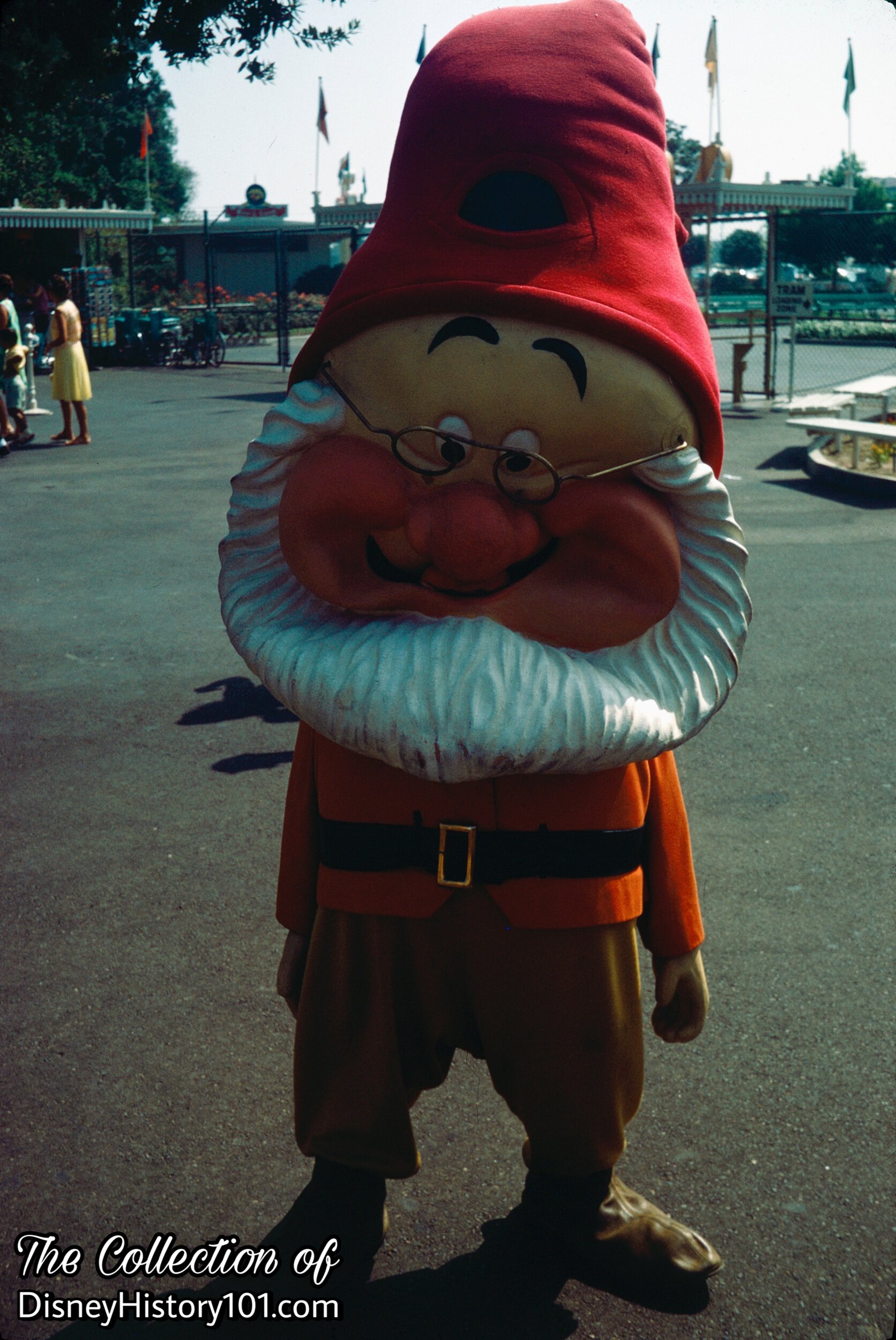
DOC, 1967
This incarnation of Doc made his debut inside Disneyland during the summer of 1961.
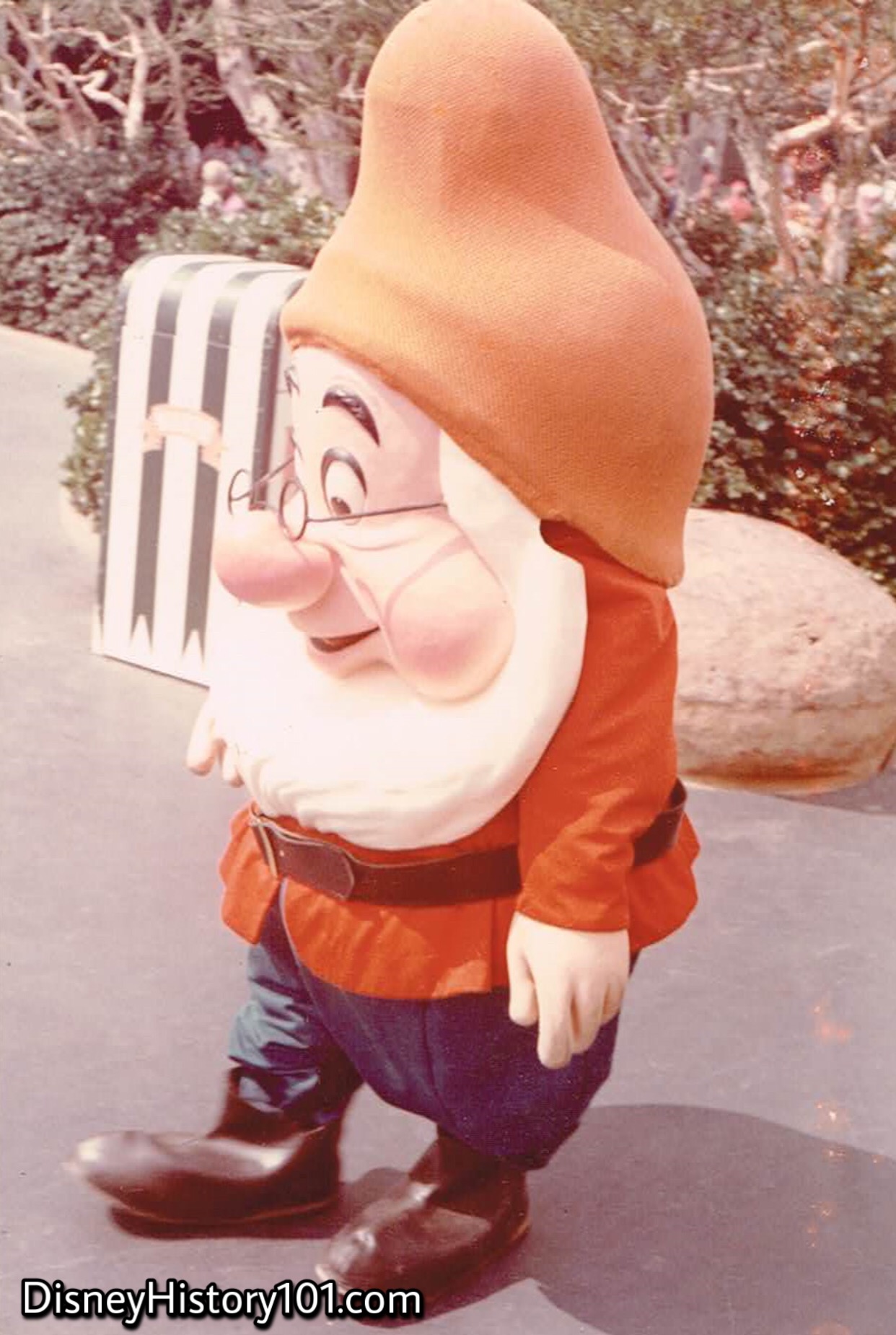
DOC, (September, 1972)
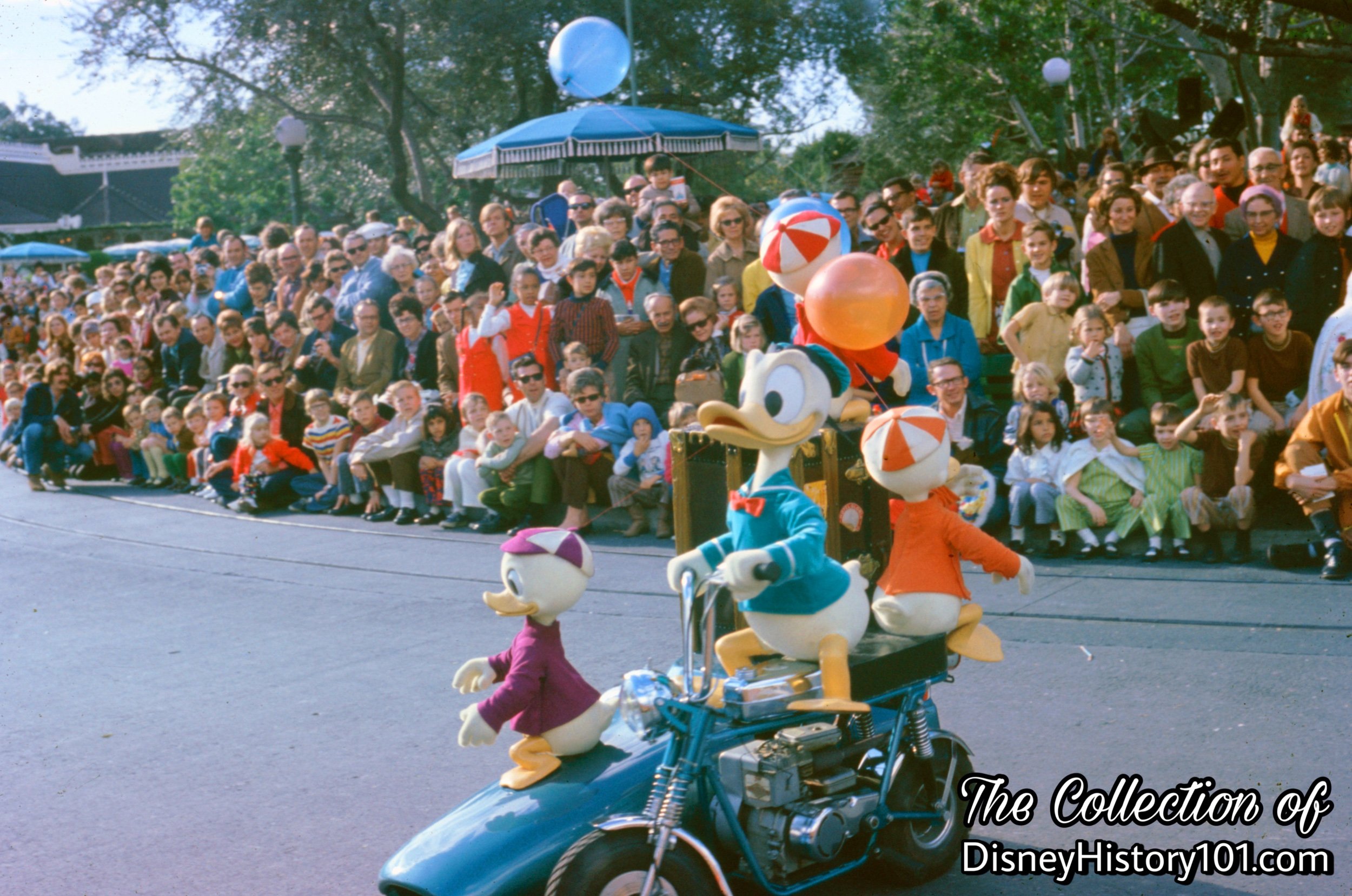
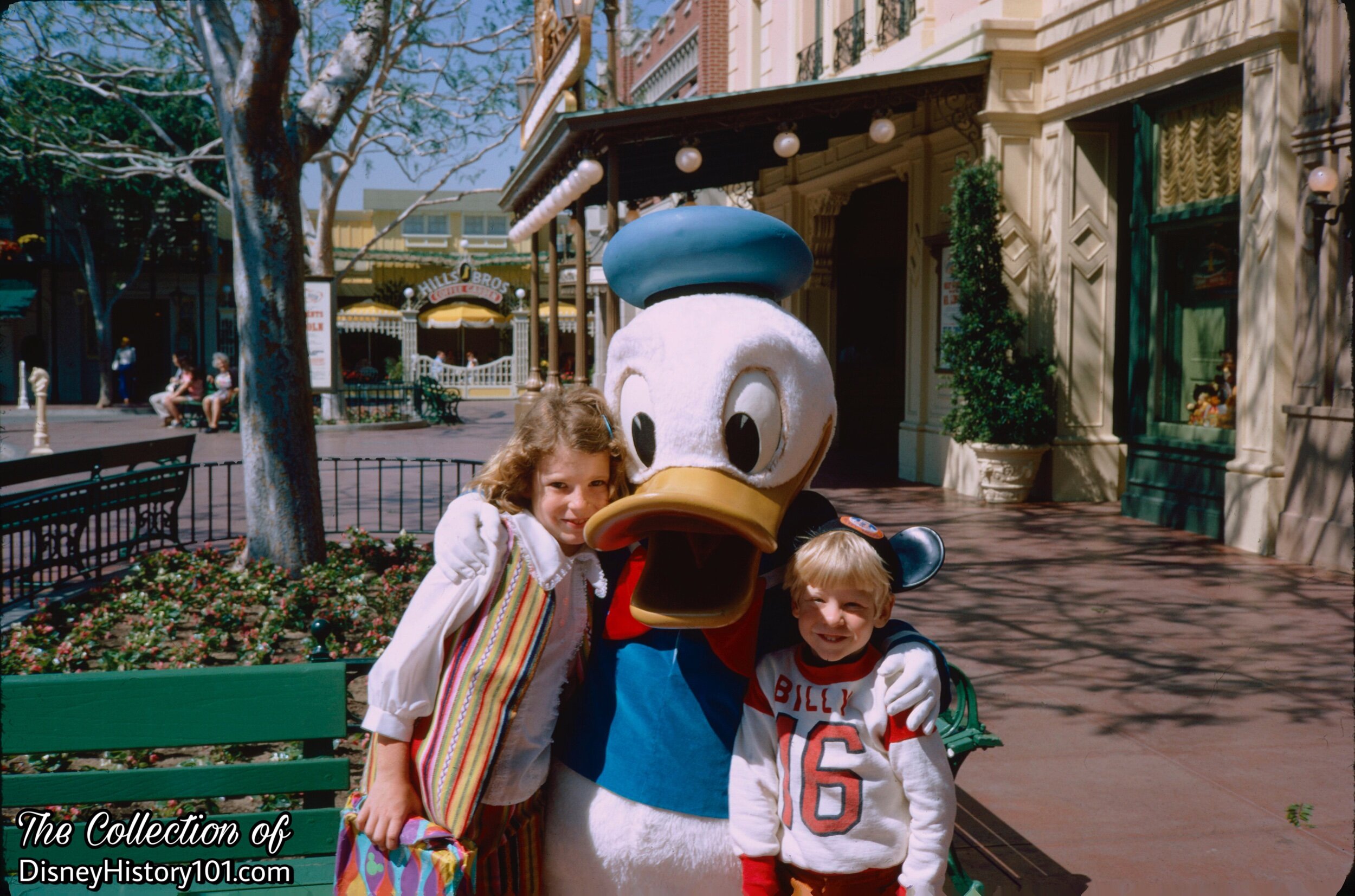
DONALD DUCK, (April, 1972)
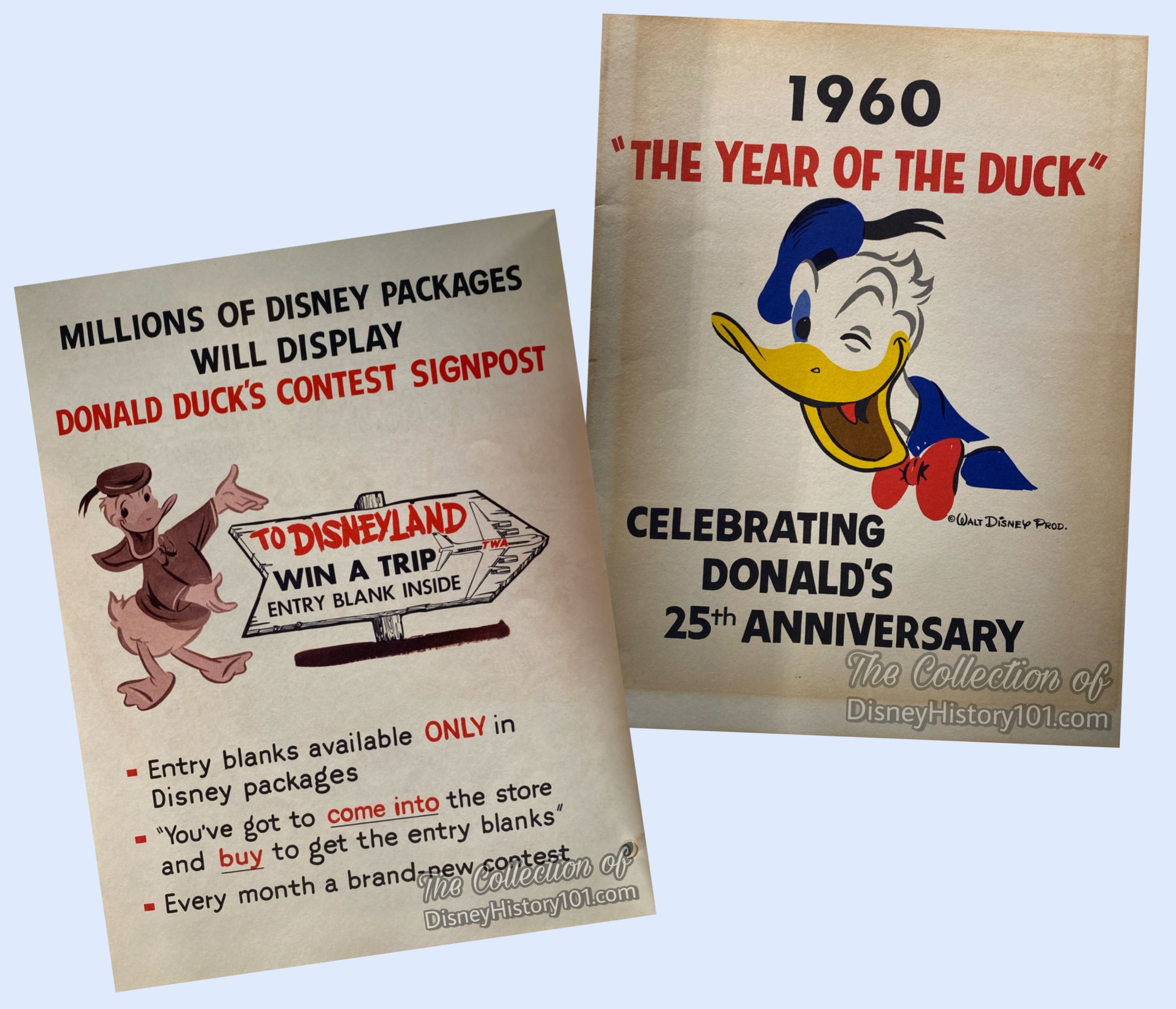
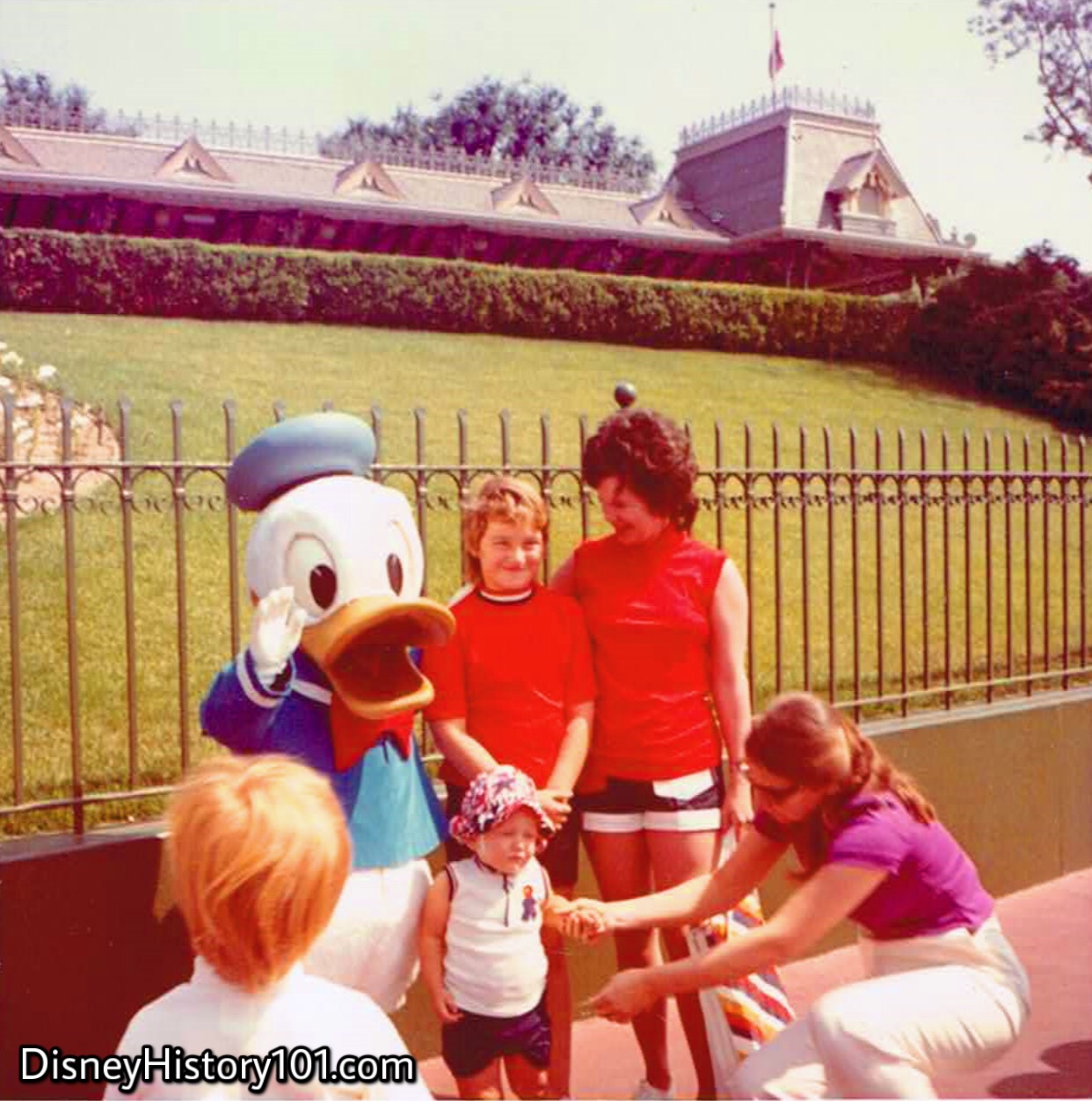
DONALD DUCK
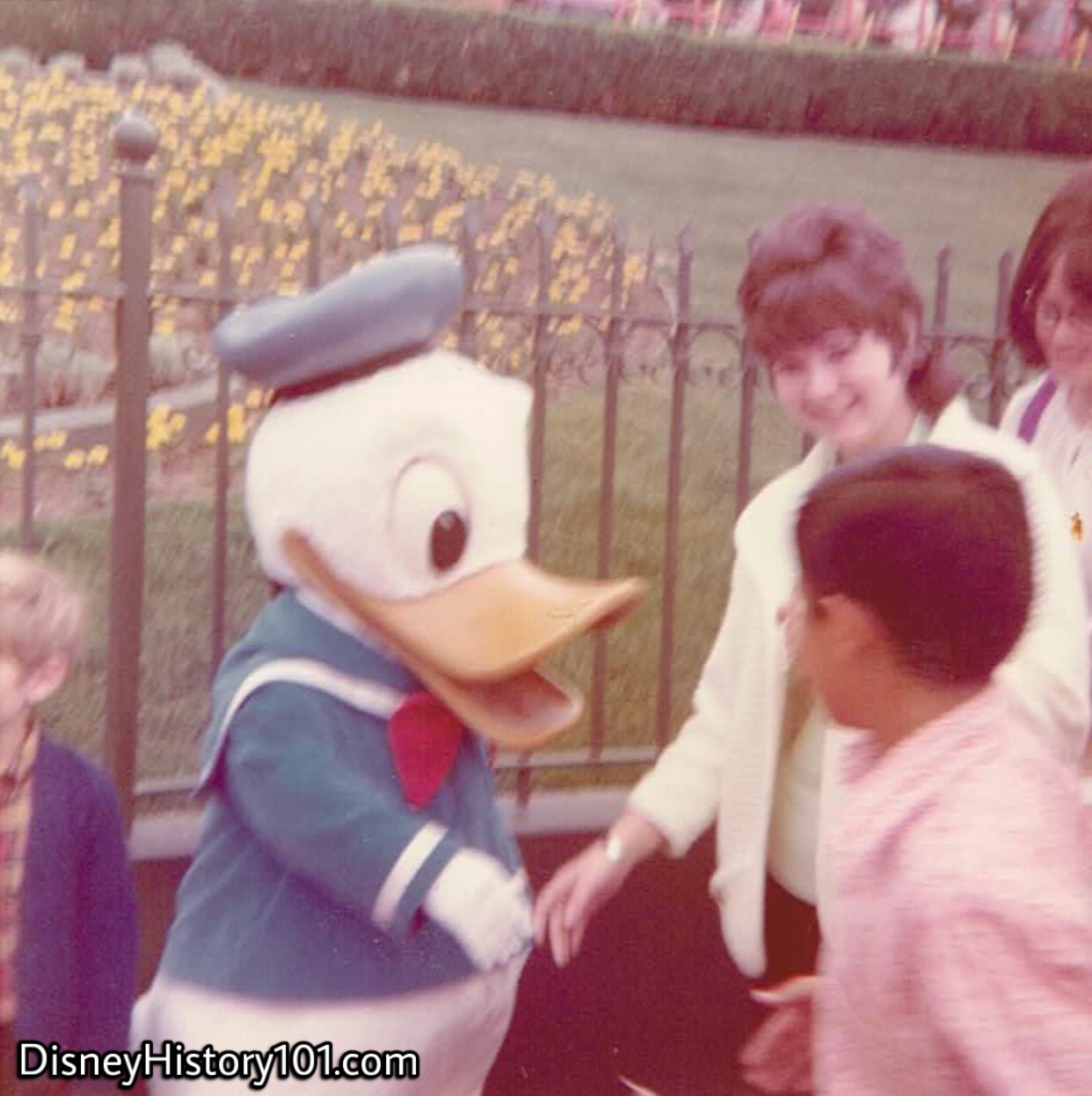
DONALD DUCK, 1972
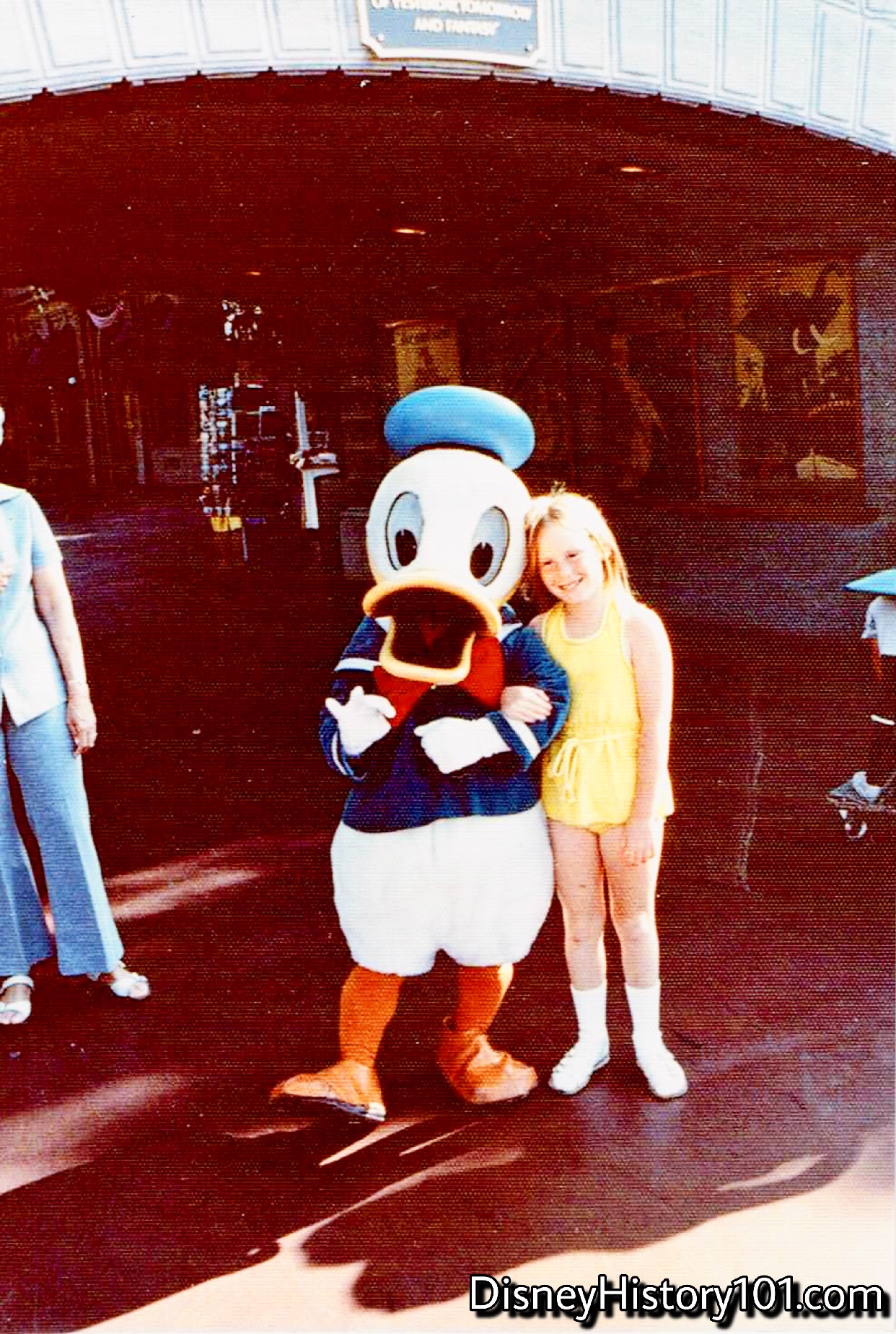
DONALD DUCK
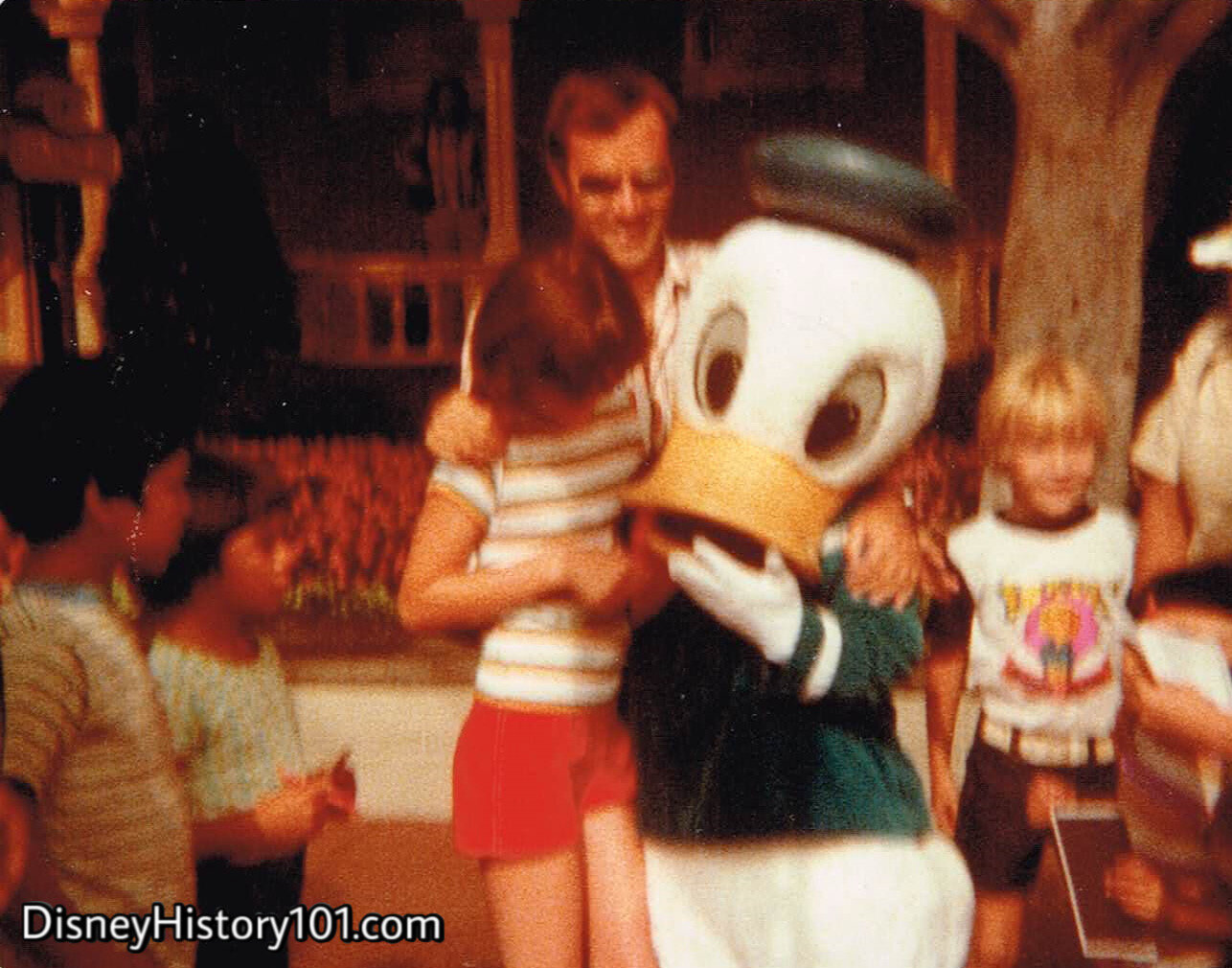
DONALD DUCK (March, 1978)
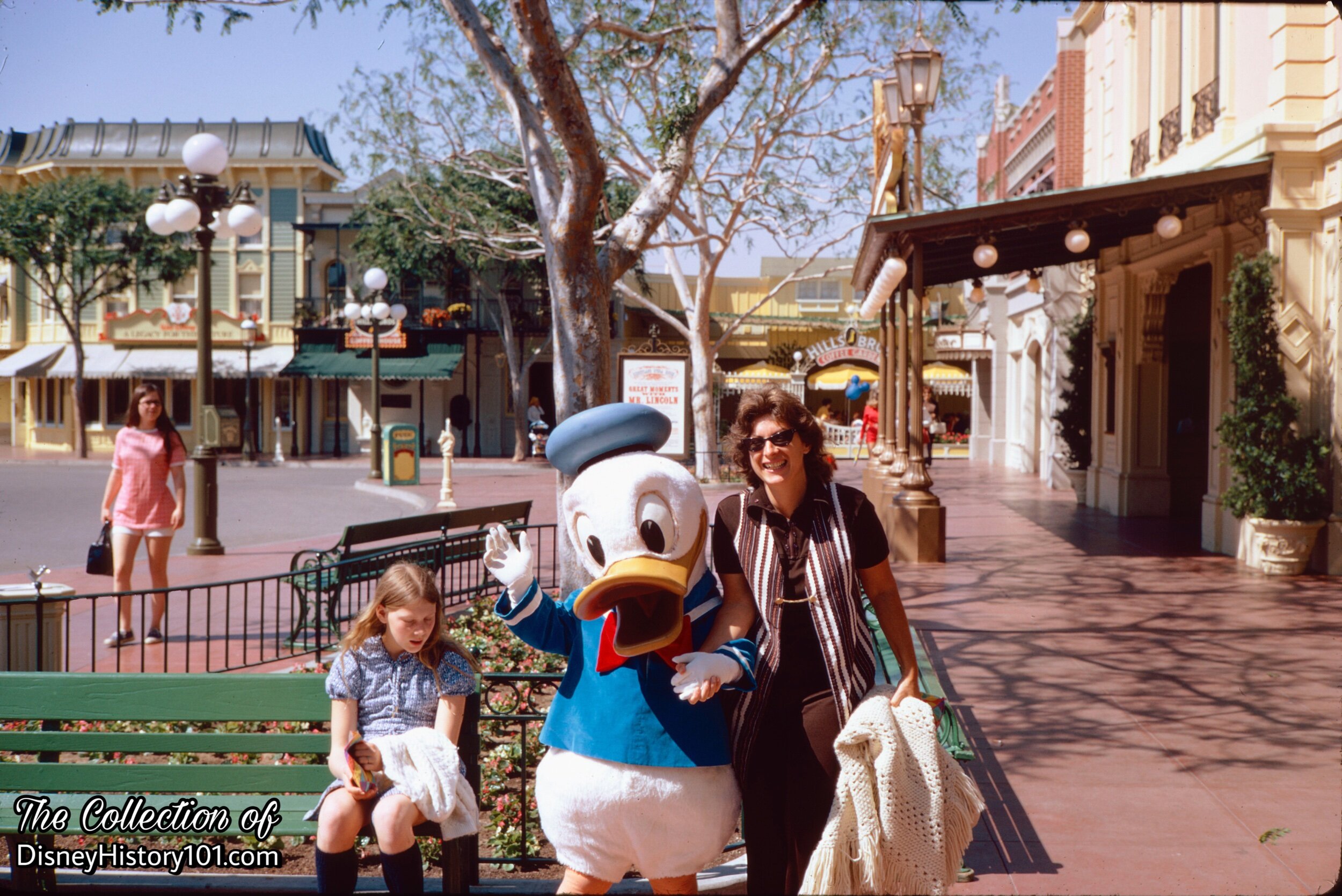
DONALD DUCK

DONALD DUCK
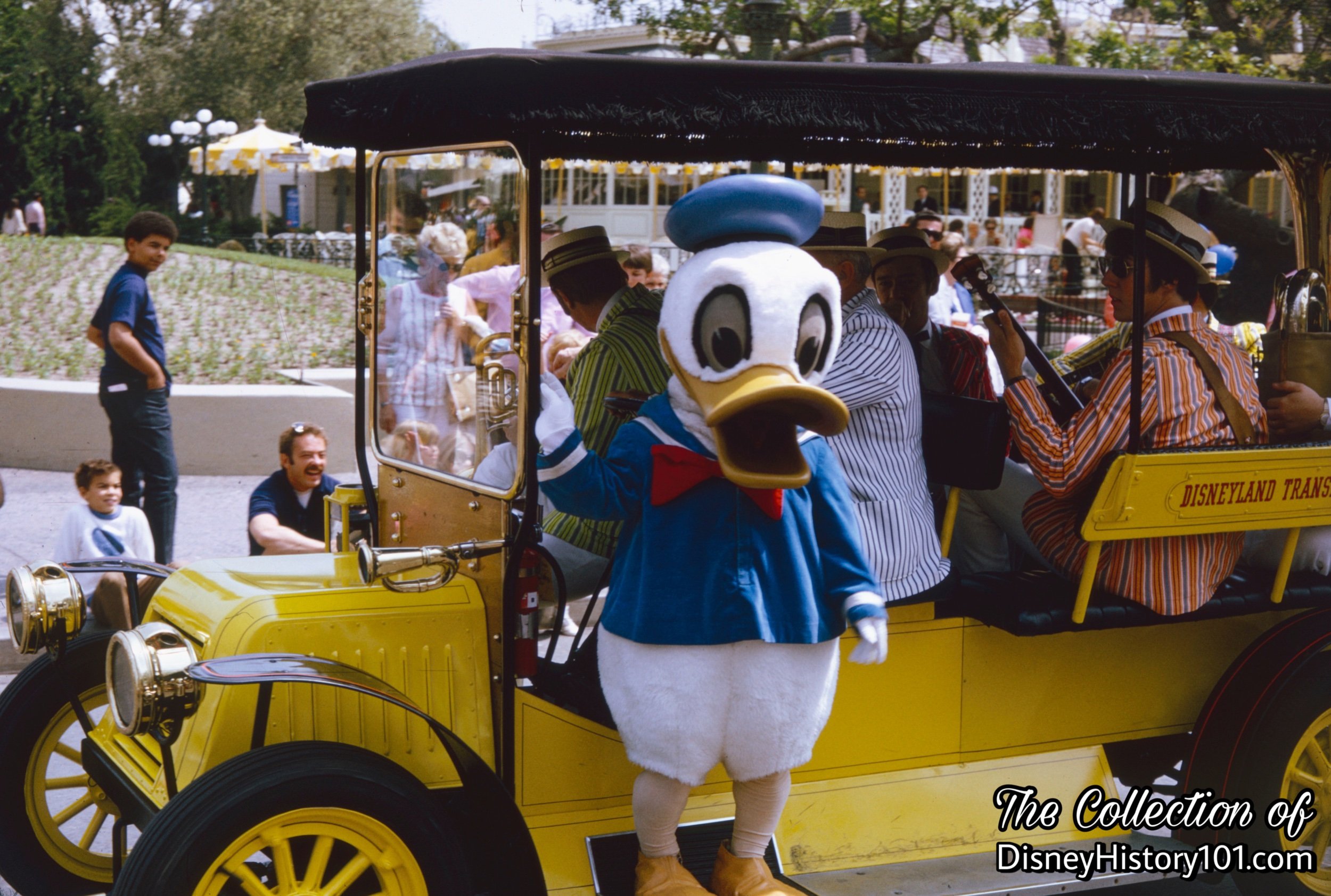
Donald rides an electric Horseless Carriage with other entertainers driven by a Pageant Helper.
In parades, Donald Duck usually rode aboard an '03 car driven by Operations.

DONALD DUCK
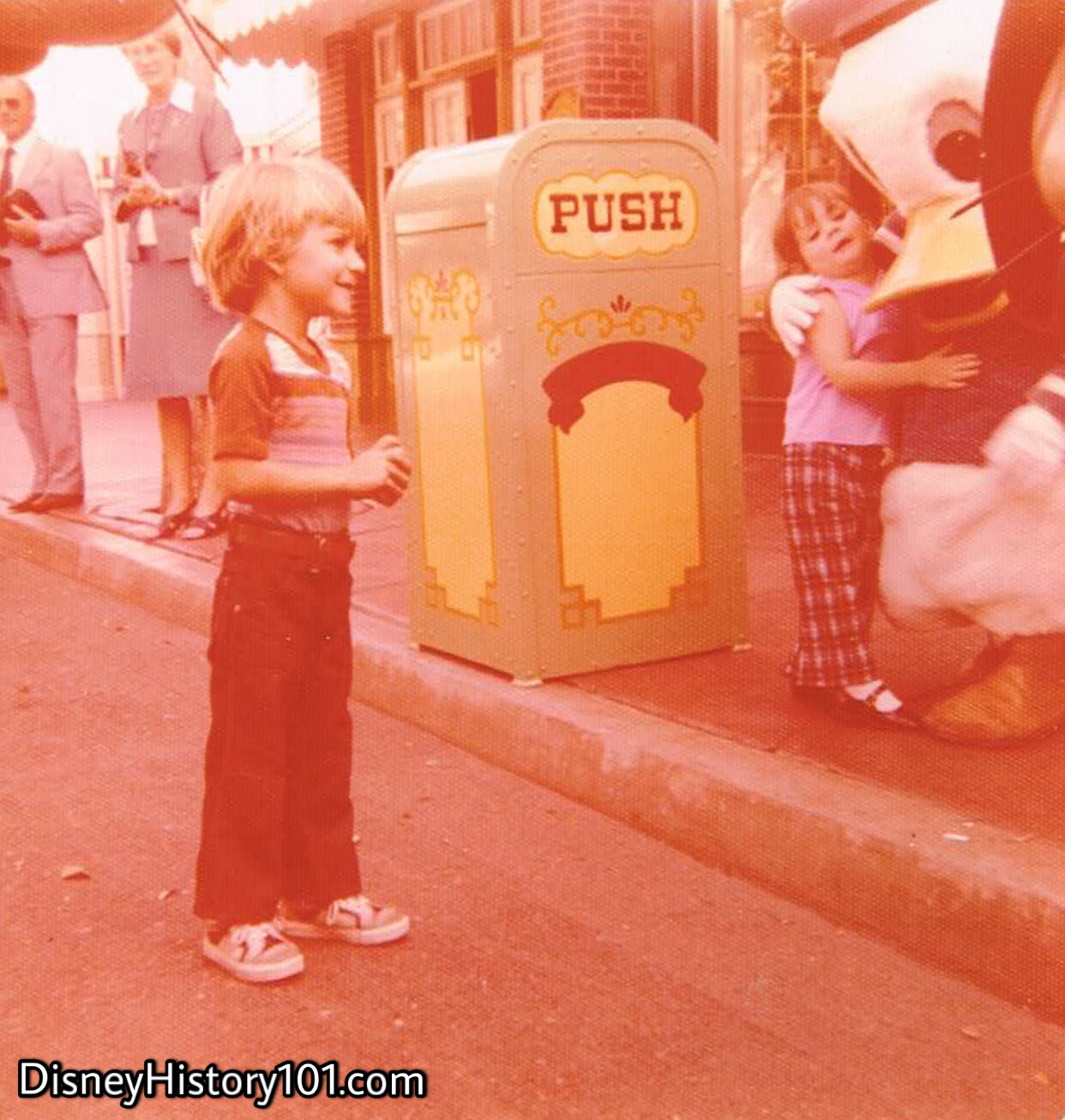
DONALD DUCK
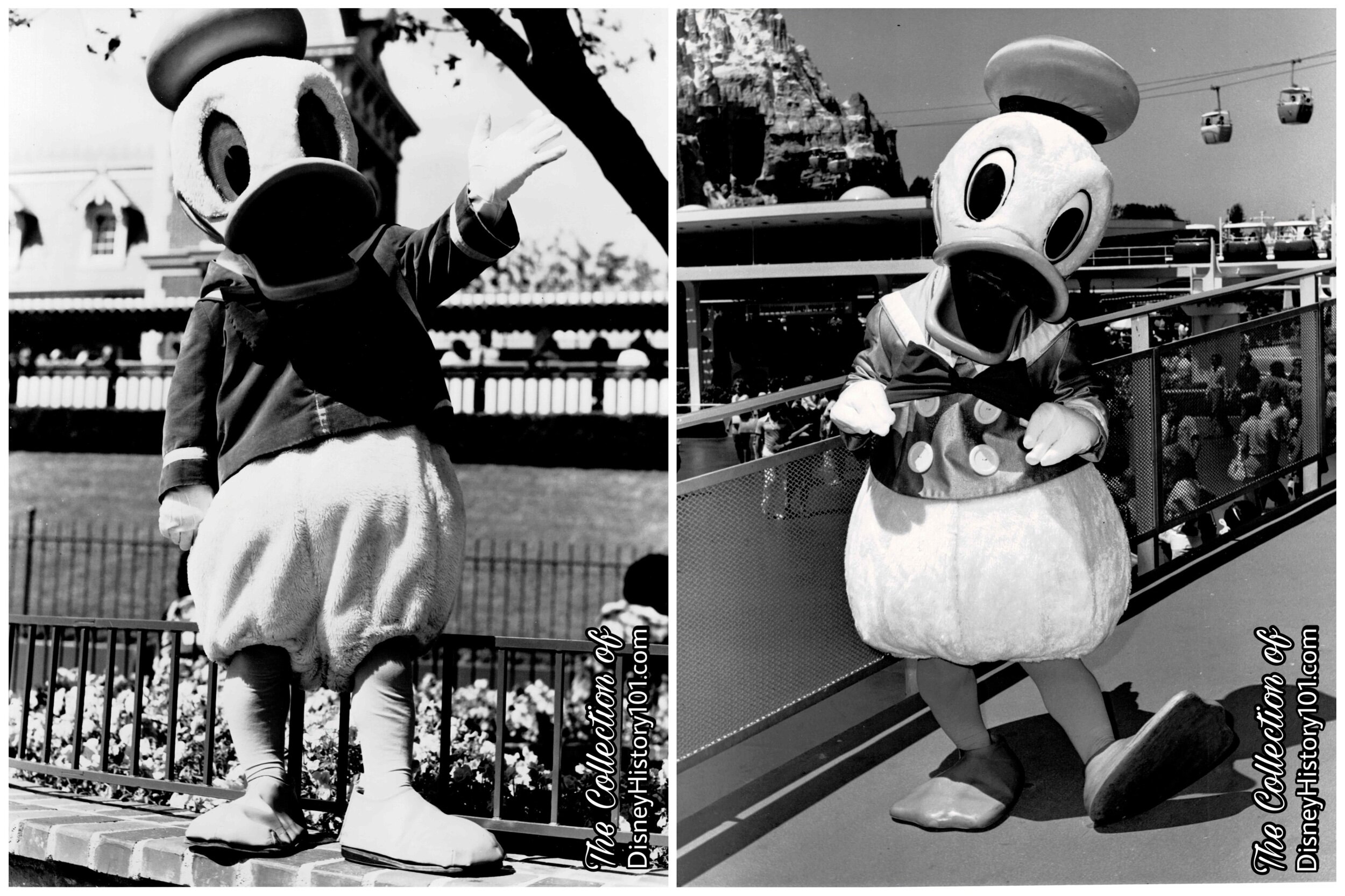
Donald, a Costumed Standard Character appears at Disneyland; ©️Walt Disney Productions.
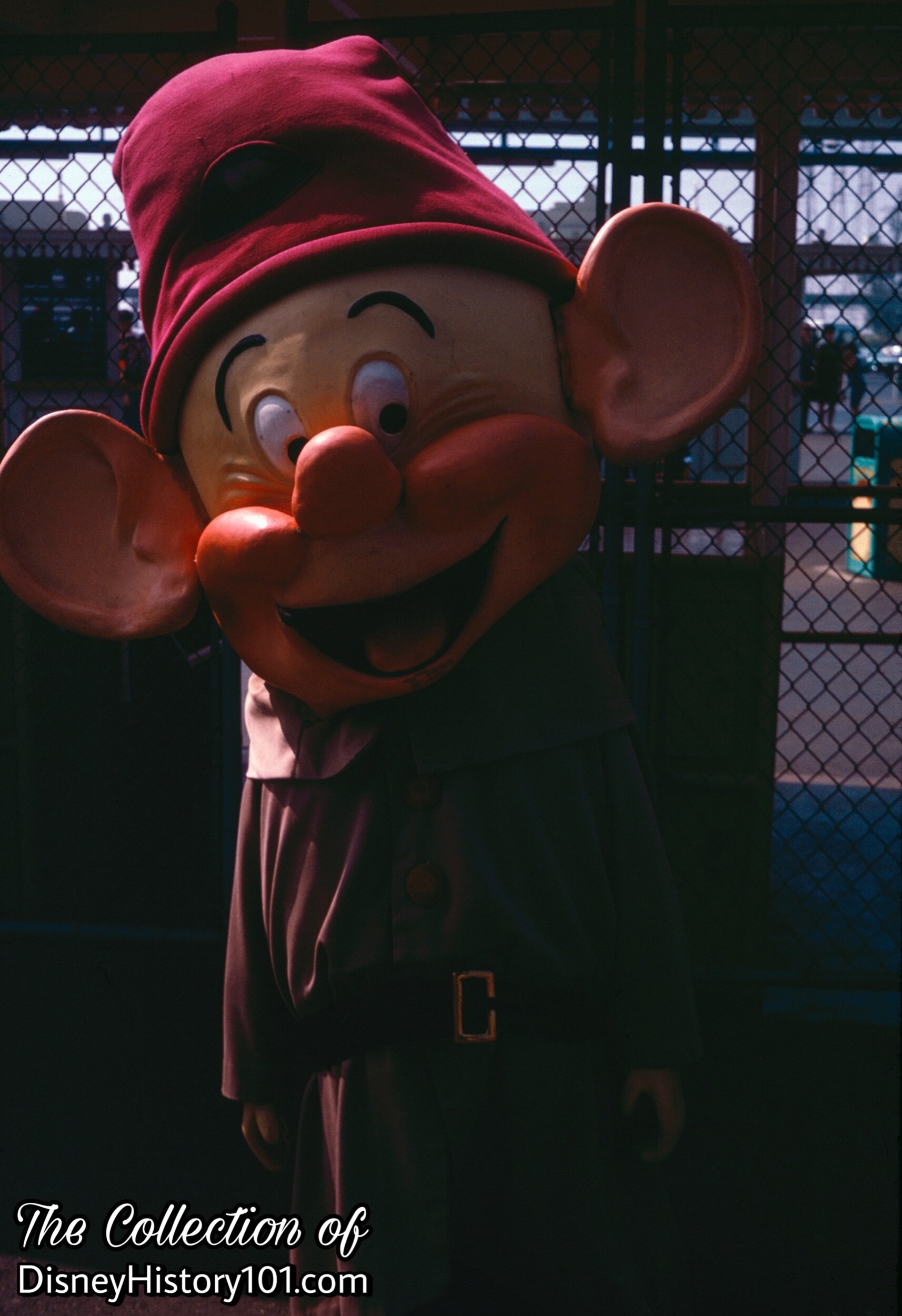
DOPEY, (1967)
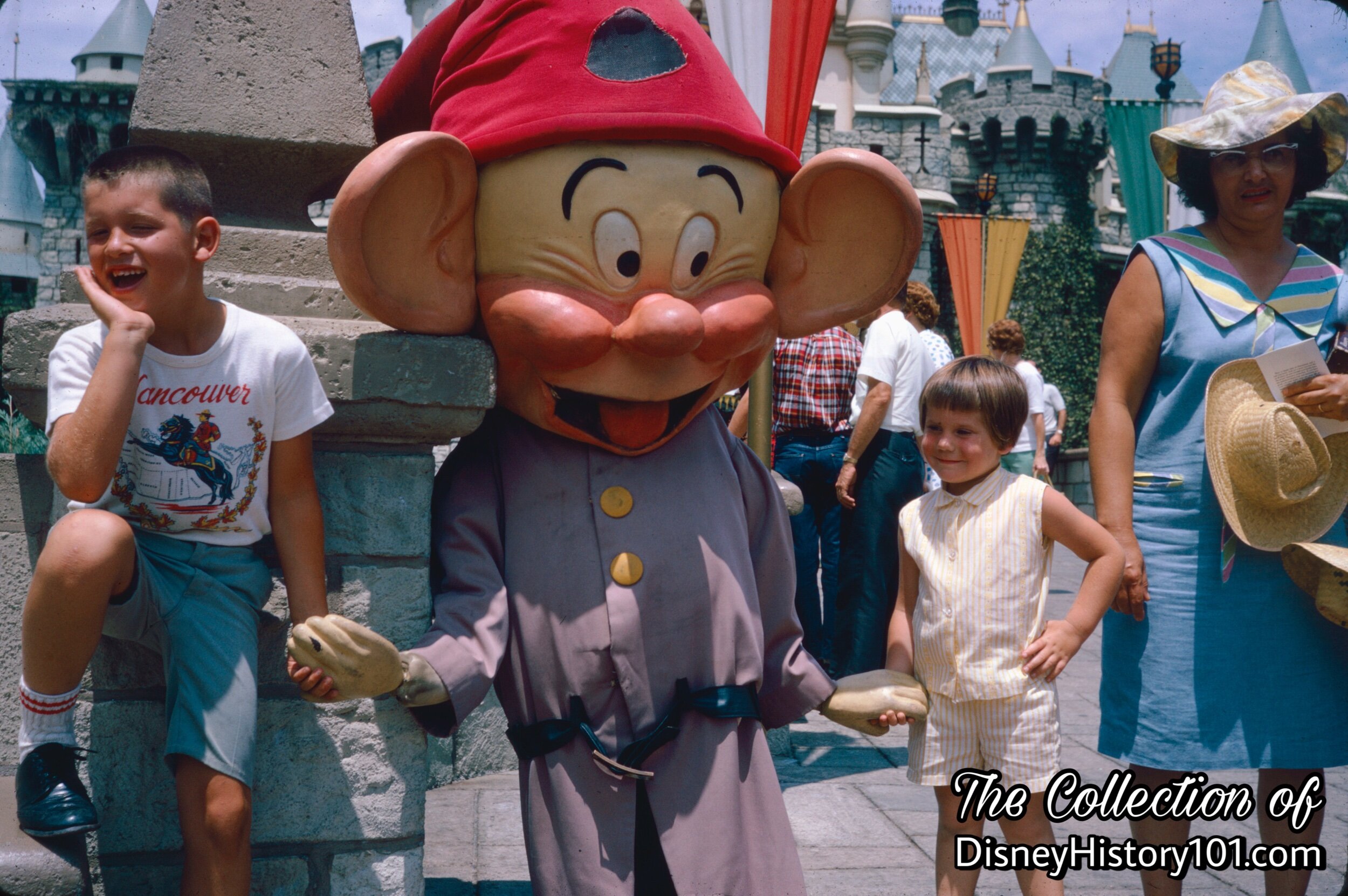
DOPEY
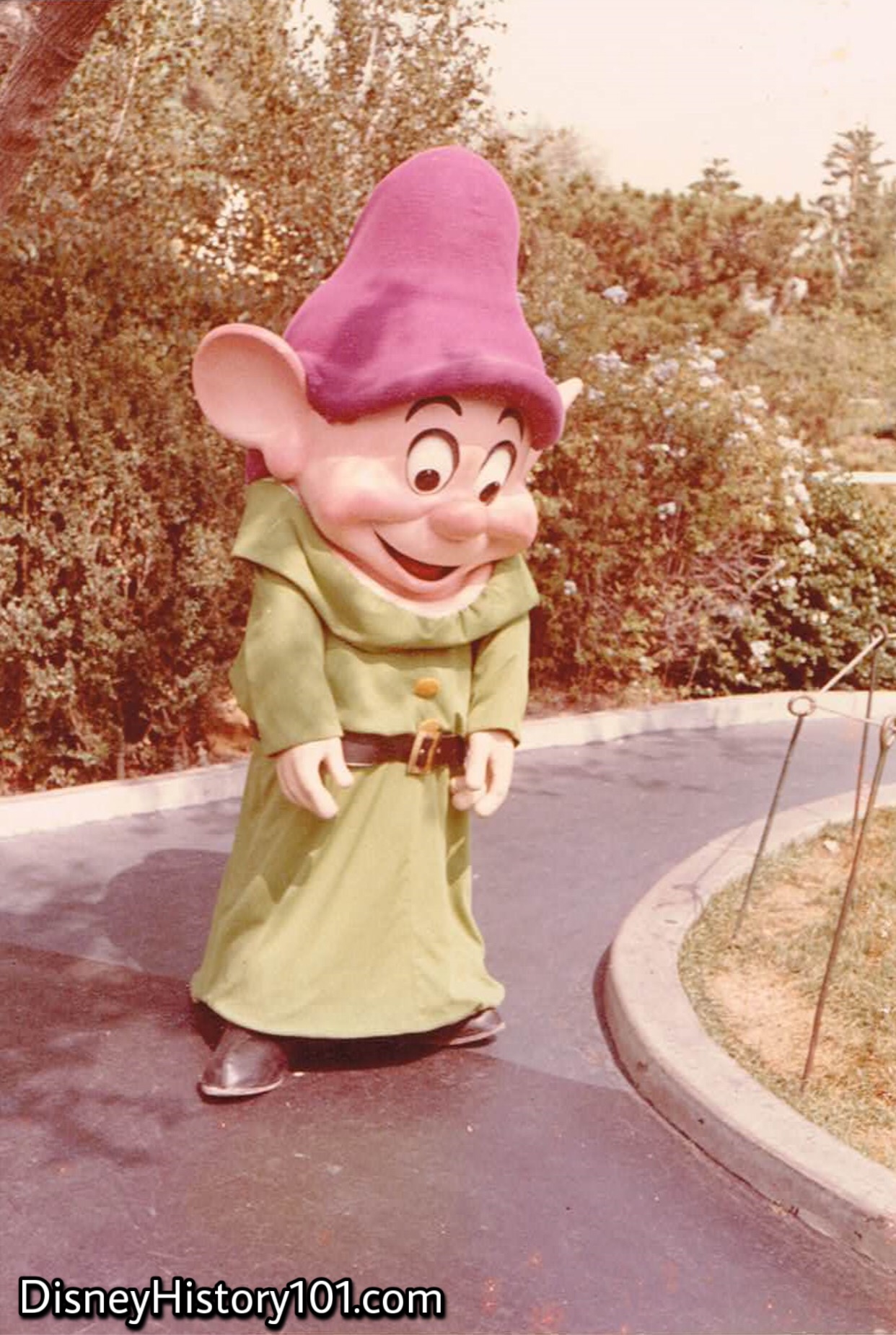
DOPEY, (September, 1972)
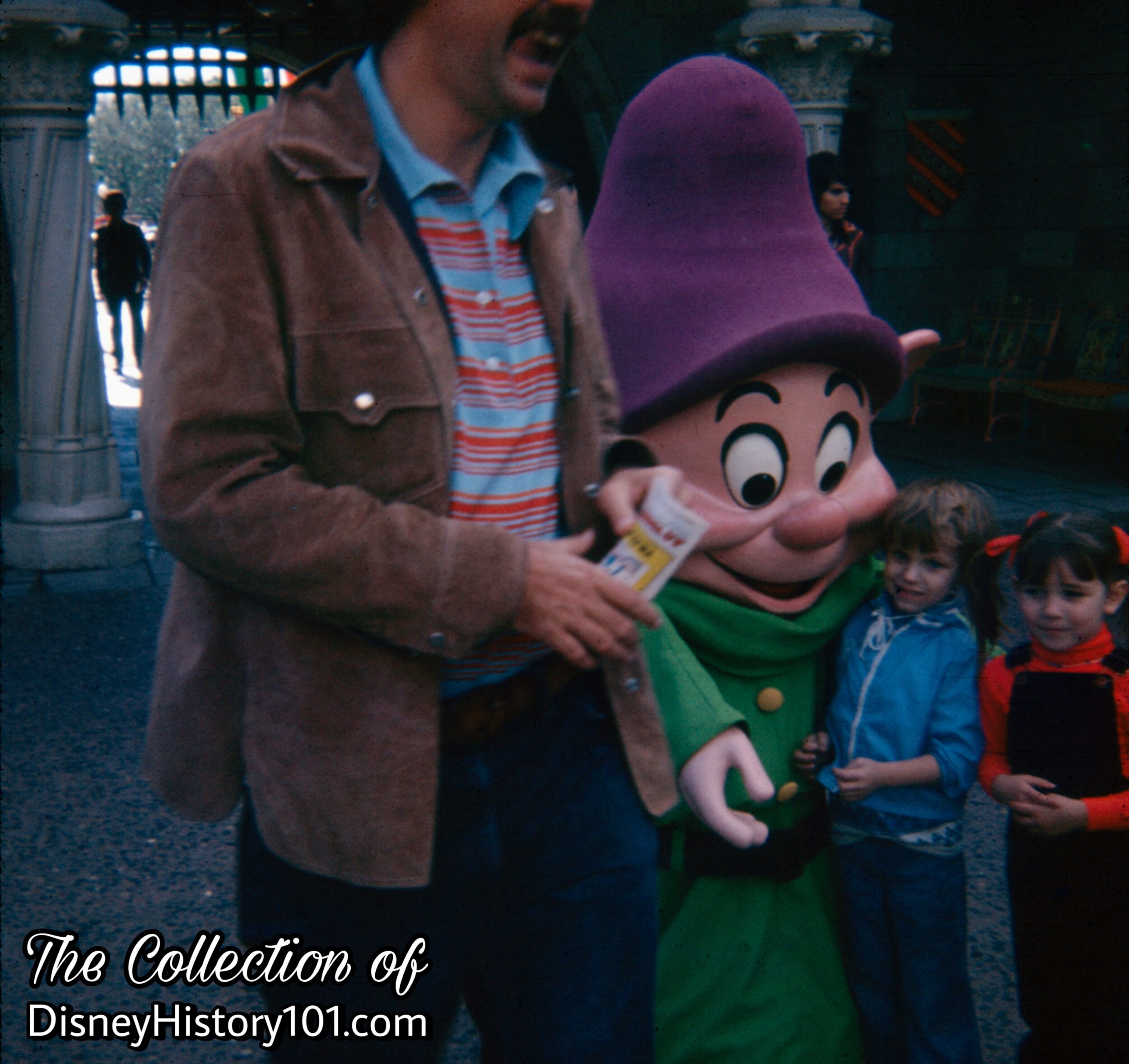
DOPEY

DOPEY
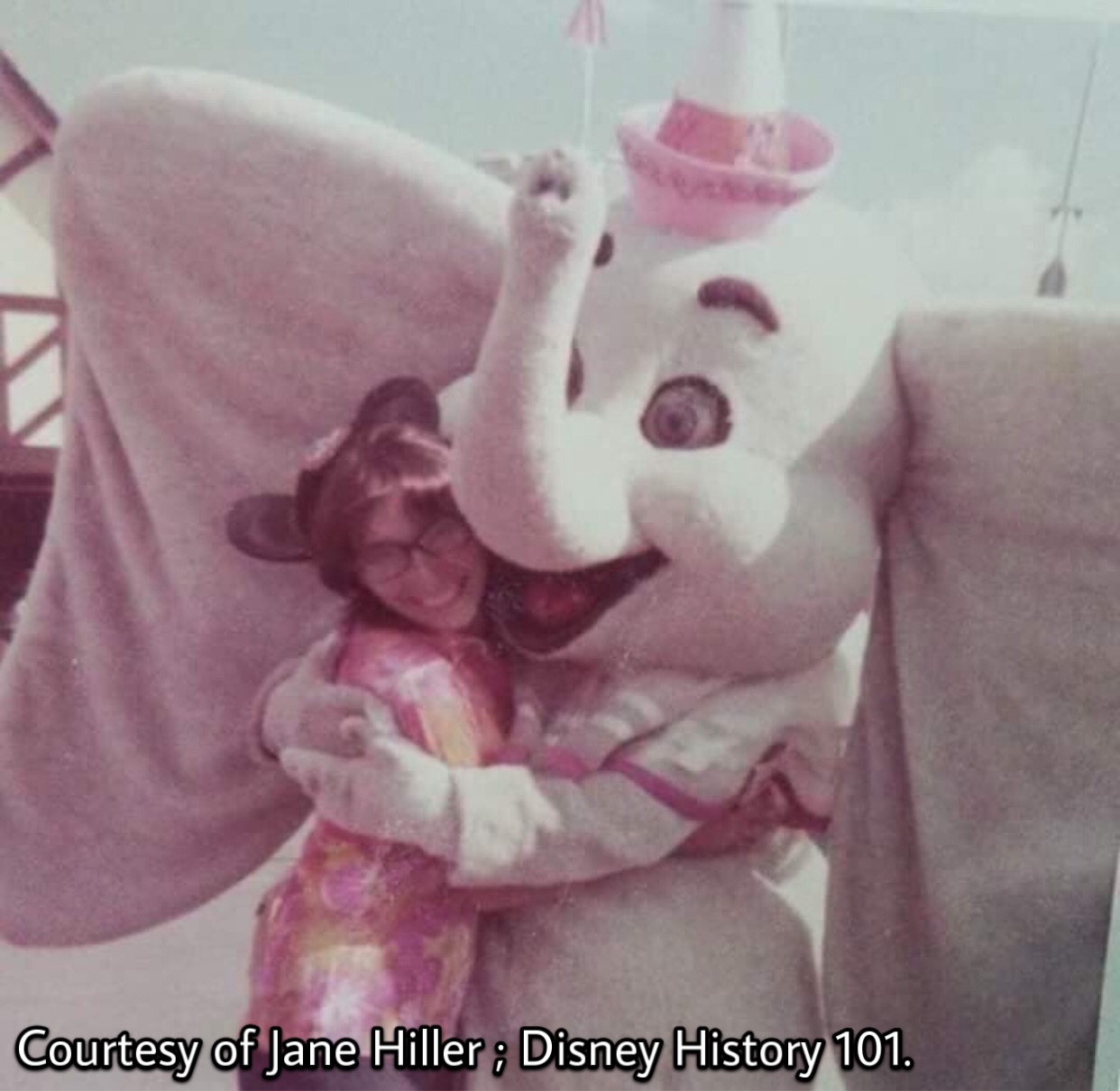
DUMBO, 1971
You may recollect (in our story above), that DUMBO has made appearances in Disneyland since the 1950s. Here, Dumbo epitomizes how to express “Disney courtesy” in a non-verbal way!
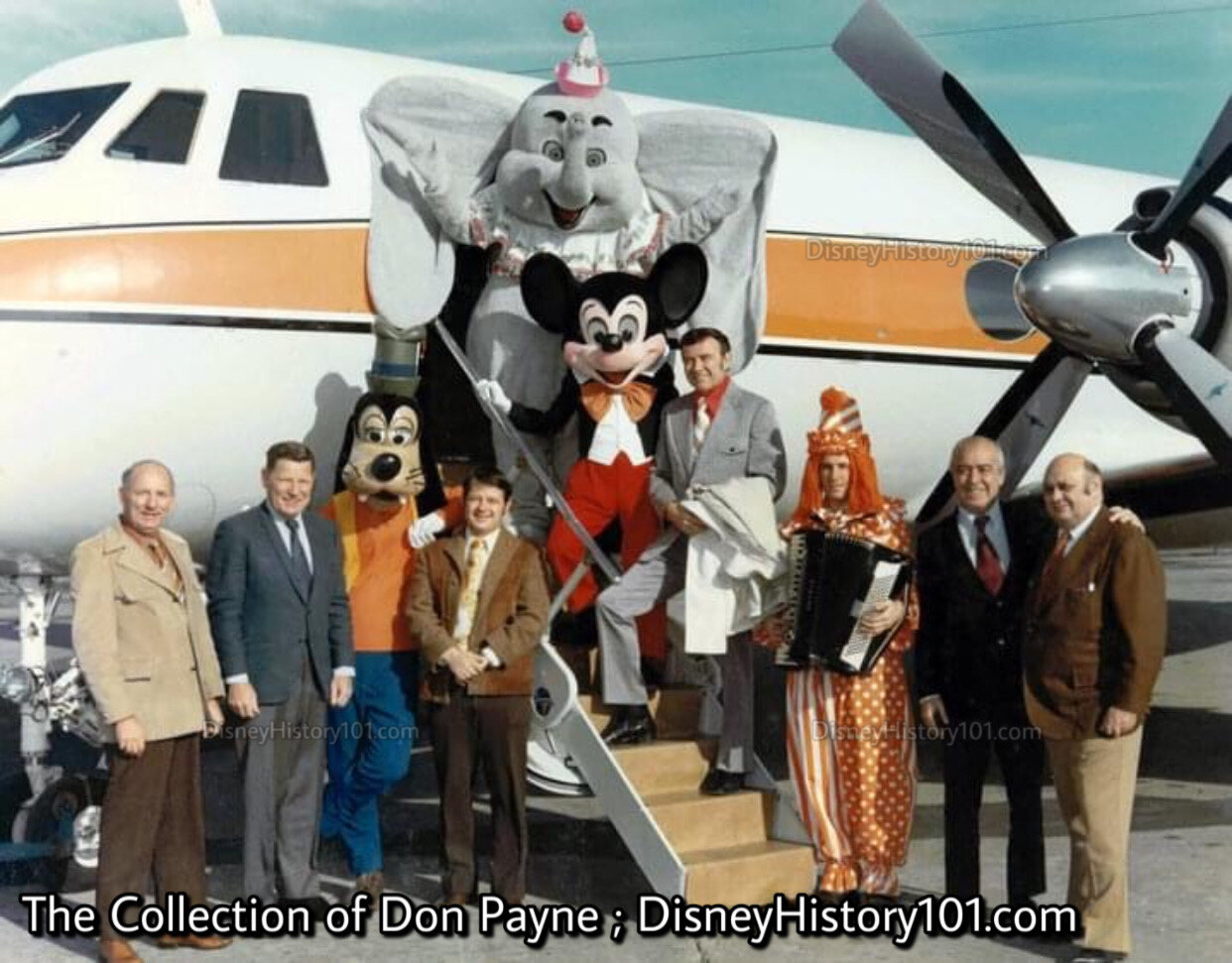
"DUMBO National Promotional Tour", (October 8, 1972-November 25, 1972)
A group shot taken outside Walt’s private Grumman Gulfstream jet, Denver Colorado, October 16th, 1972.
Left to Right : Chuck Malone (Pilot), Kelvin Bailey (Pilot), Greg Dymkowski (Goofy), Tom T.R. Robbins (Wardrobe), Don Payne (Dumbo), Lee Lomask (Mickey Mouse), Fulton Burley (Ringmaster / M.C.), Joe Diamond (Musician/Clown), Frank Petraglia (Tour Manager/Buena Vista Distribution), Marvin Goldfarb (Area Manager/Buena Vista Distribution).
Greg Dymkowski (who portrayed Goofy during the tour), remembers : “Cities included Birmingham, New Orleans, Washington DC, Boston, Buffalo / Windsor, Chicago, Pittsburgh, Denver, and Seattle. We were up before dawn daily to appear on each city’s local kiddie show…One was called Clancy the Cop [at Minneapolis WCCO] . His sidekick was [Carmen the Nurse]…The host of the show in Windsor was an old friend of Fulton’s. The key appearance was on the Bozo Show in Chicago. That show had an orchestra, and parents had to write for tickets years in advance.”
As for flying in Walt Disney’s Gulfstream I, Greg adds, “One of the seats in the rear of the Gulfstream I (turboprop) had its own phone. We were told that it had been Walt’s seat.”
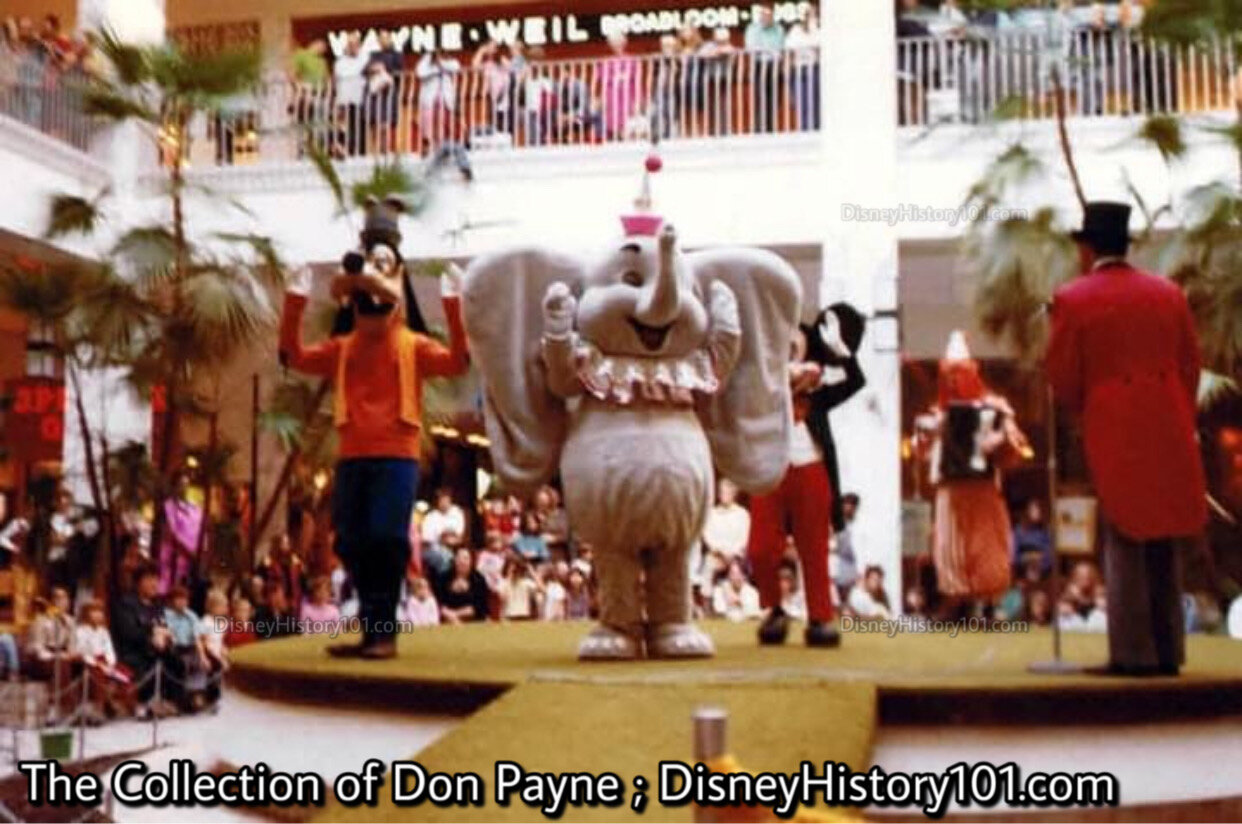
The animated Disney Characters of the "DUMBO National Promotional Tour," October 8, 1972-November 25, 1972.
Here is a candid shot taken at a mall performance in Pittsburgh, Pennsylvania on Monday, October 9, 1972. These events were physically demanding but a lot of fun. Left to right : Greg Dymkowski (Goofy), Don Payne (Dumbo), Lee Lomask (Mickey), Joe Diamond (Musician Clown), Fulton Burley (Ringmaster M.C.)
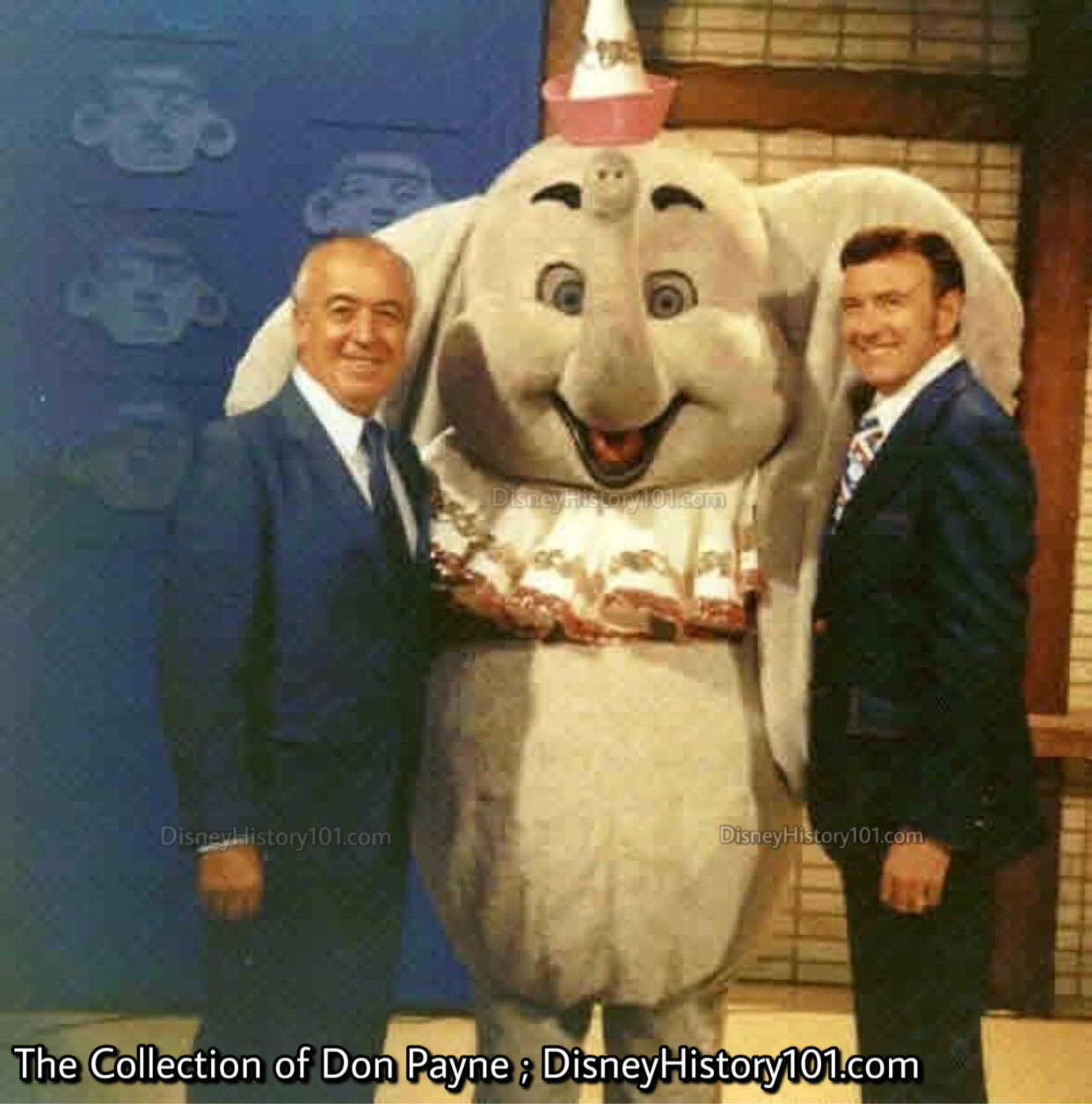
"DUMBO National Promotional Tour", (October 8, 1972-November 25, 1972)
Same T.V. show set, just after our live performance. Left to Right : Frank Petraglia (Tour Manager/Buena Vista Distribution), Don Payne (Dumbo), Fulton Burley (Ringmaster/M.C.). You’ll notice that Dumbo’s left ear is drooping. The Fiberglas support had been broken in transport. There was no possible way to repair it while away from the staff shops at Disneyland.
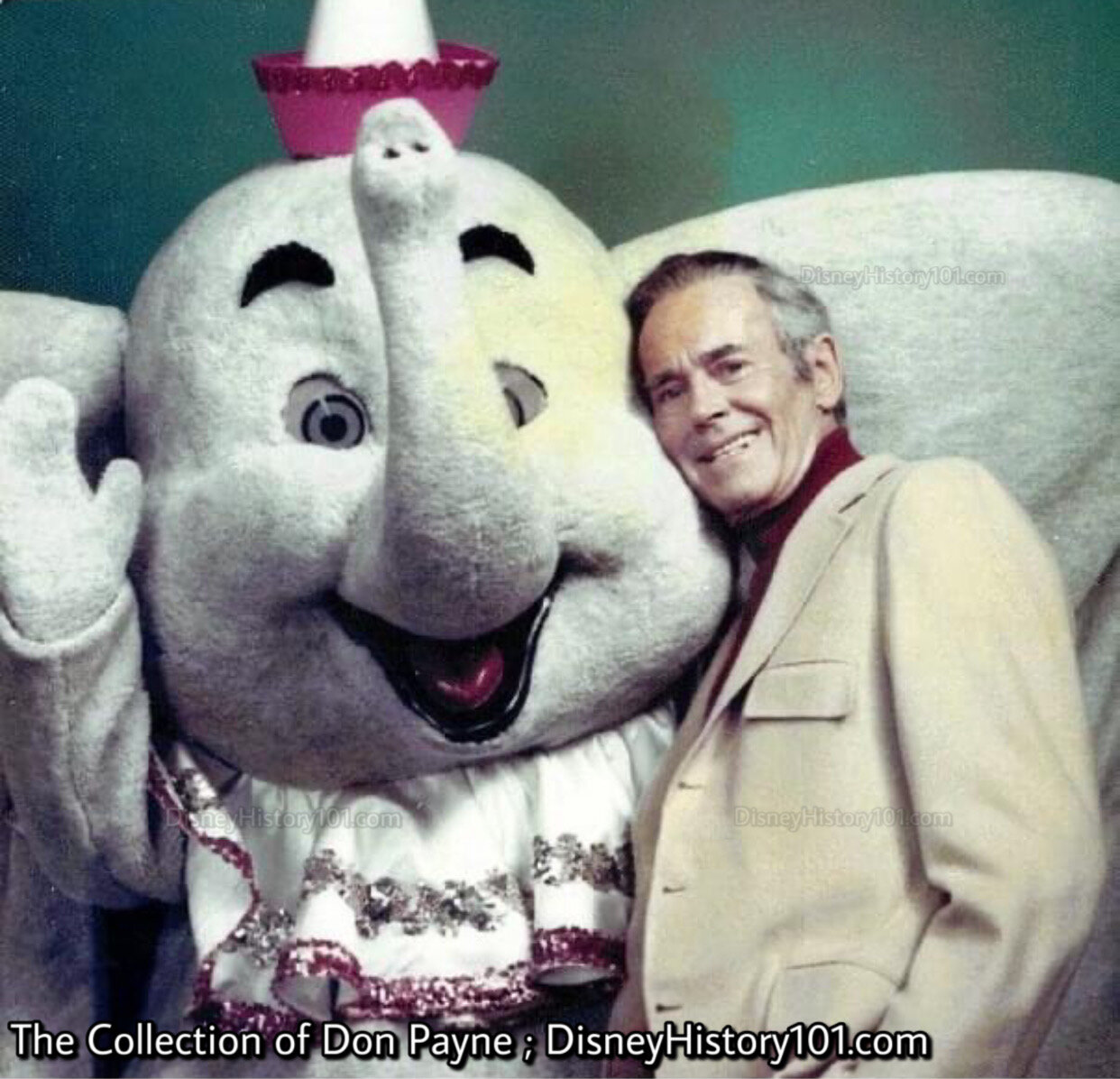
DUMBO and Henry Fonda (September 30, 1974)
Former Cast Member Don remembers : “We shot a GAF commercial over the span of two days. Mr. Fonda was gracious in volunteering to pose with the Disney cast (Mickey and Dumbo).”
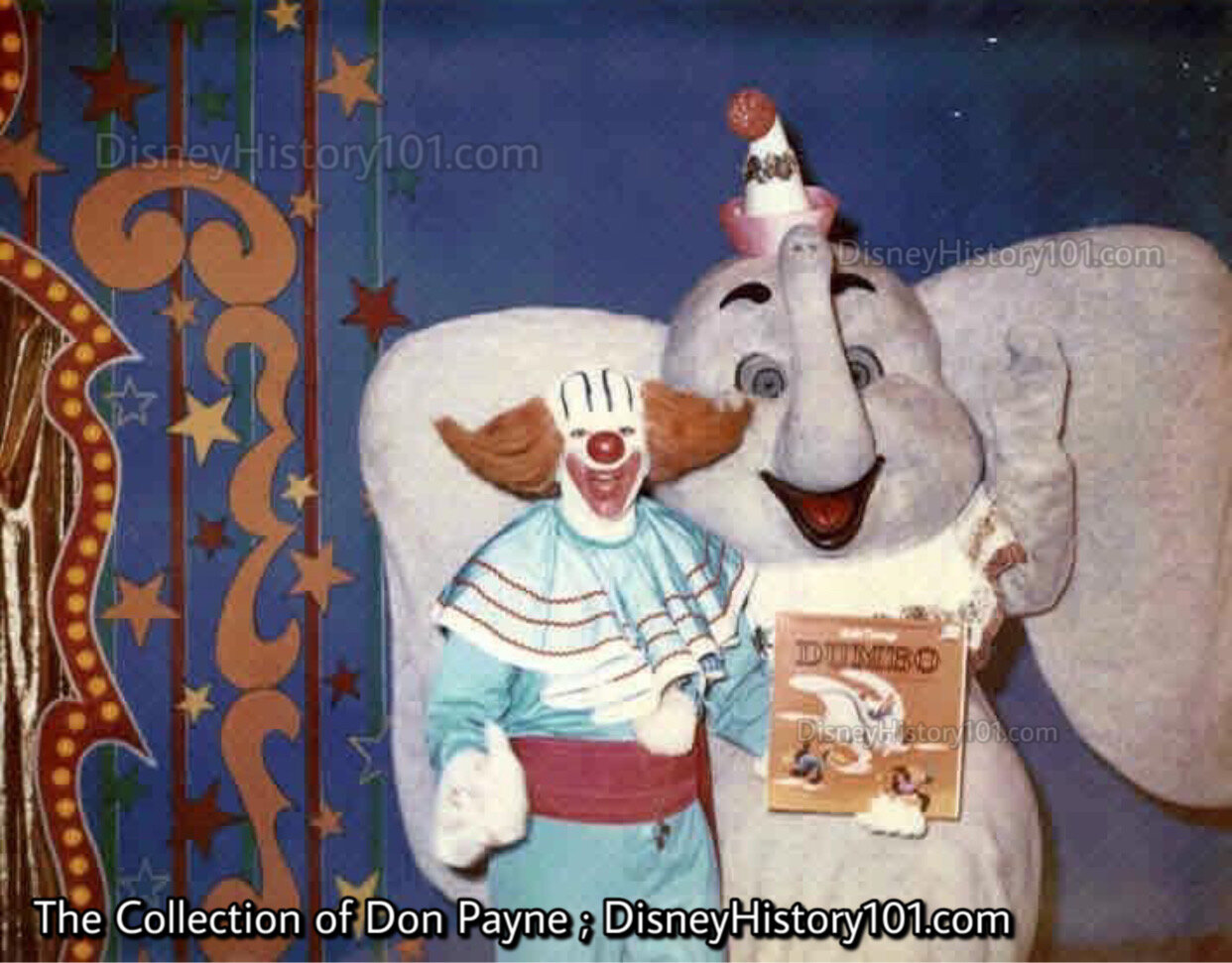
"DUMBO National Promotional Tour", (October 8, 1972-November 25, 1972)
The Dumbo T.V. show in Windsor, Canada. I believe Bozo was portrayed by Art Cervi at this point.
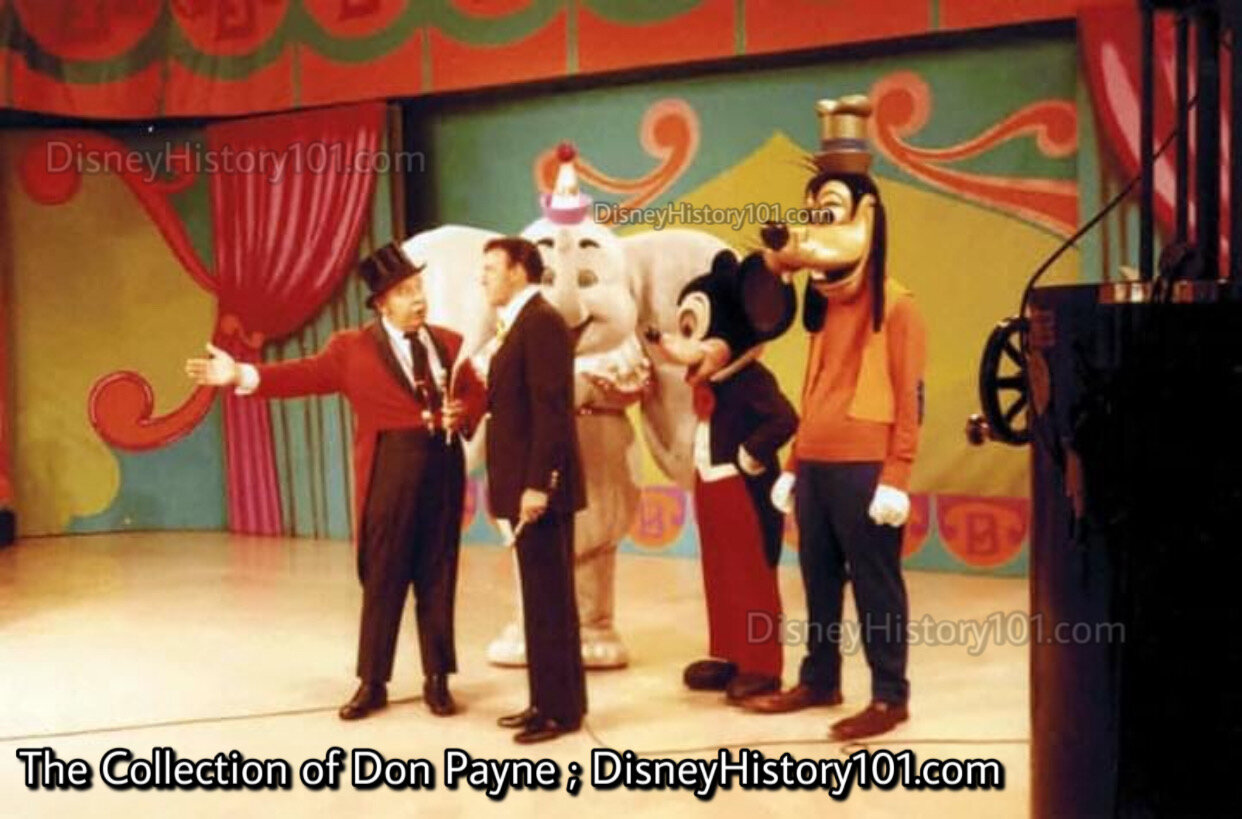
"DUMBO National Promotional Tour", (October 8, 1972-November 25, 1972)
The Bozo T.V. Show, Chicago, Illinois. This is an ‘on the air’ shot with the Dumbo cast and Ned ‘Ringmaster’ Locke taken Tuesday, October 10, 1972. Left to Right : Ned Locke, Fulton Burley, Don Payne (Dumbo), Lee Lomask (Mickey), and Greg Dymkowski (Goofy).

In This Section
•Eeyore (Winnie the Pooh) - Winnie the Pooh’s gloomy friend made his film debut in Walt Disney’s The many Adventures of Winnie the Pooh in 1967. The film won an Academy Award for Best Animated Short Film.
•Eleroo (The Wuzzles) - This character is believed to have appeared in Walt Disney’s Magic Kingdom On Ice: Sport Goofy from 1985 to 1986.
•Esmerelda -
•Eric -
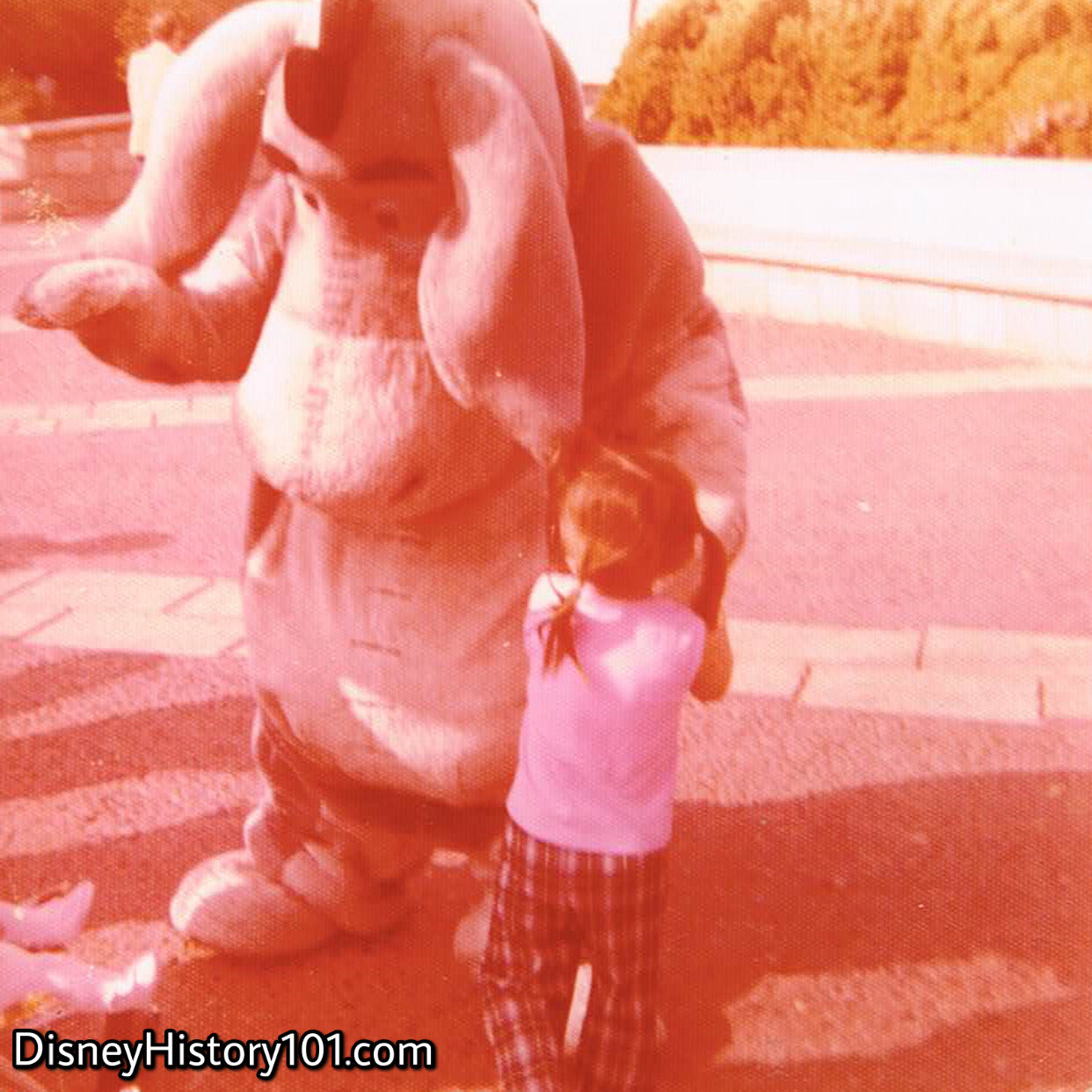
EEYORE
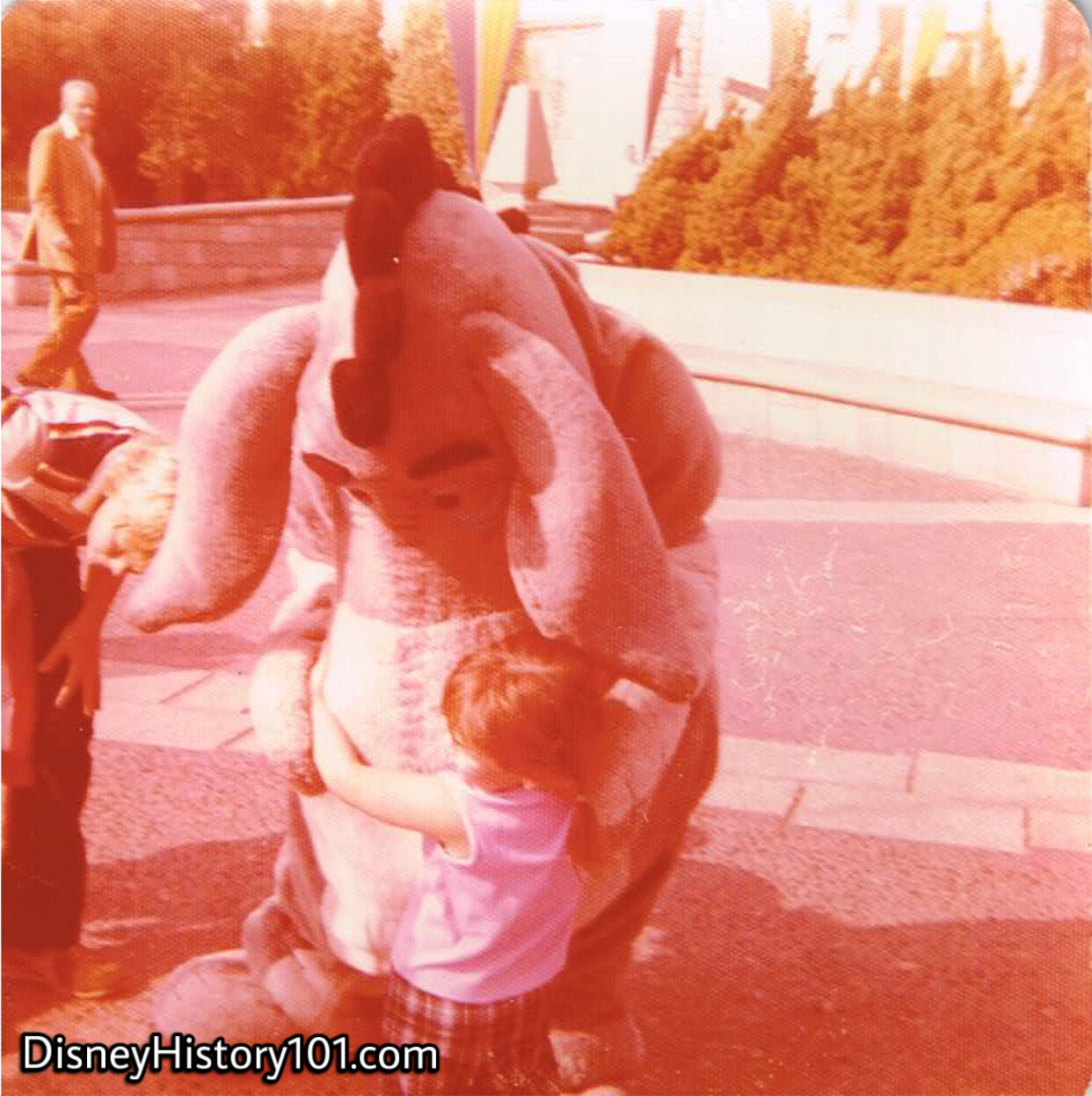
EEYORE
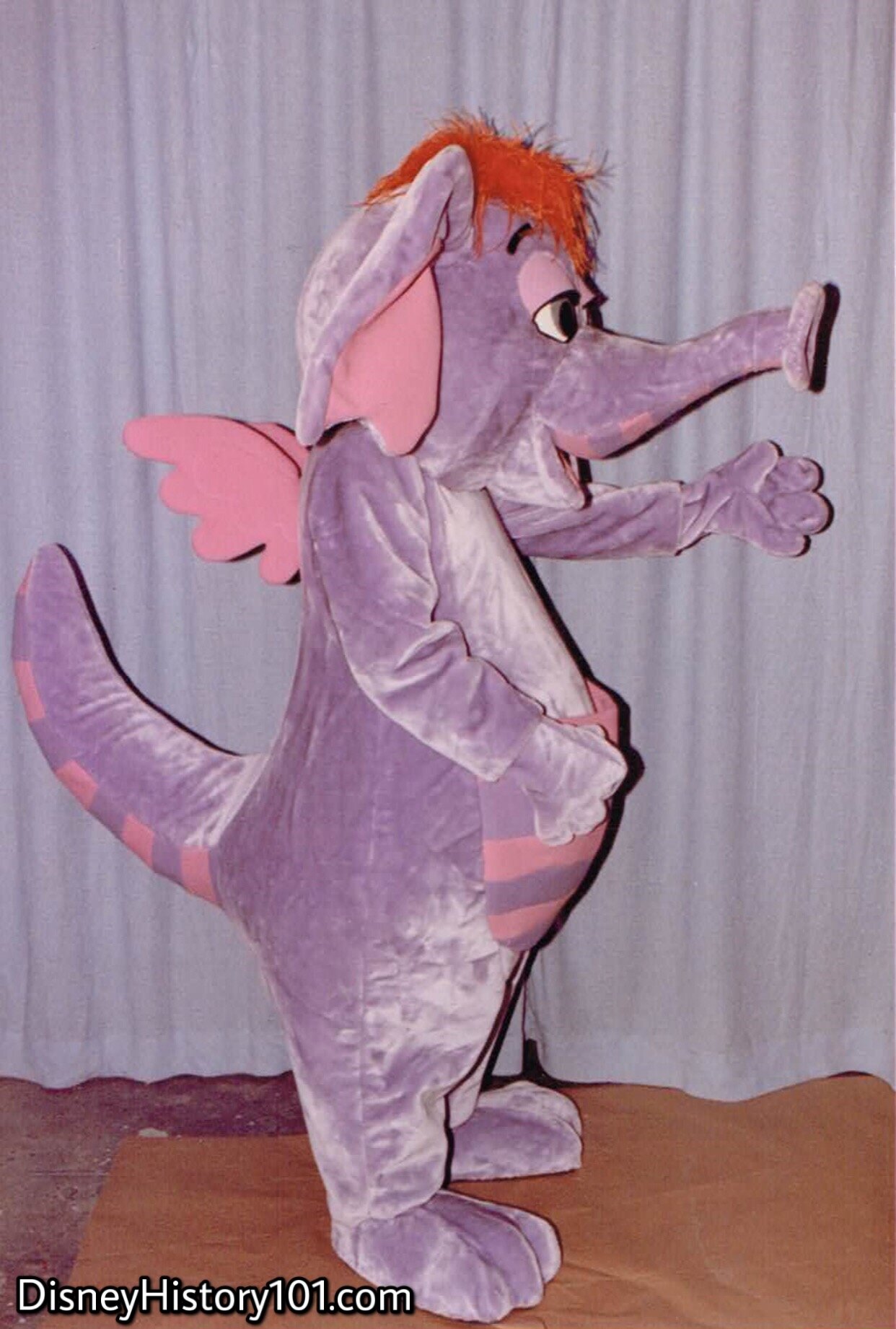
ELEROO

An animated ELEROO.

In This Section :
•Fa Zhou - Mulan's stern but sensitive father rode in a carriage in the Mulan Parade.
•Fairy Godmother (Cinderella) - Fairy Godmother is a Disney Face Character who can talk, communicate with Guests, and create magical Disney experiences for them.
•Fantasyland Court Jester - The Fantasyland Court Jester entertained guests of Sleeping Beauty Castle Courtyard in Fantasyland. He could often be found juggling and performing an assortment of magic tricks while riding his unicycle.
A “Five Minute Fairytale about the Fantasyland Court Jester” could be summed up this way: Christopher Fair (a young magician who performed on the Mickey Mouse Club’s Talent Round Up Day, had a knack for performing magic tricks. Walt kept an eye on this aspiring talented young man. Christopher continued to learn and grow, and was soon recognized as the International Brotherhood of Magician “1958 Juvenile Magician Champion” award. In 1959, upon graduating from high school, Christopher received a phone call from Walt Disney, inviting him to an interview at Walt Disney Studios in Burbank, California. Christopher did not feel confident performing close-up magic, but he was determined to learn. In addition, it was Christopher’s idea to utilize a unicycle in his act. Upon convincing Entertainment Department heads of its safety, Christopher began incorporating it. Christopher agreed to work for Disneyland, and went on to portray the soon-to-be Fantasyland icon during 1959.
The Fantasyland Court Jester (portrayed by Christopher Fair) was part of a promotional photo shoot with the Queen (portrayed by Annette Funicello. Two years later, the talented Christopher Fair was a headliner during Disneyland‘s Summer of ‘61 show, mentioned in “Disneyland News” (Vol.1, No.1) as part of the “entertainment themed mood of each ‘land.’”! The Fantasyland Court Jester was also part of the big summer (of 1963) talent lineup.
By the summer of 1966, he performed from 11 AM to 6 PM.
Two decades later, the Fantasyland Jester had a legacy of sorts in the Royal Jesters, juggling performers in New Fantasyland during the 1980s.
•Farley the Fiddler - In 1979, Charles “Farley” Francisco performed (alongside Bosco, Clem, Hickey, Lizard and Zeke) with “Montezuma’s Revenge” on the stage of the Golden Horseshoe. Farley performed a starring role as one of the “Billys” on the Big Thunder Ranch stage (even playing the mandolin). During recent decades, Farley could be found fiddling (and playing the jaw harp) on the porch of Davy Crockett’s Pioneer Mercantile shop set. Occasionally other musicians (like the Billies) and other Frontierland Face Characters would join him in entertaining guests.
•Fauna - Fauna gave the gift of song.
•Figaro the Cat (Pinocchio)
•Flik -
•Flynn Rider - He also appears in “Mickey and the Magical Map” presented in the Fantasyland Theatre.
•Flora - Flora gives the gift of beauty.
•Flower (Bambi) - Flower and Thumper debuted in Walt Disney’s Bambi (on August 13, 1942). They were two of the newest Characters during the summer of 1964. Flower was part of the Pre-game “Walt Disney and Disneyland Salute to the California Angels” at the new Angels Stadium on Saturday, April 23rd, 1966!
•Foulfellow - Foulfellow made his debut in Walt Disney’s Pinocchio, on February 17, 1940. He made regular appearances at the “Small World” Area, greeting guests as part of the Character Program, “throughout the Christmas Holidays” (daily between parades, from 9:00am to 11:45am). [“Disneyland Holiday Talent Master Schedule,” prepared for the period of December 16, 1967 through January 1, 1968]
•Friar Tuck - Friar Tuck (the kindly pastor of Sherwood Forest) had his film debut in Walt Disney’s Robin Hood on November 8, 1973.
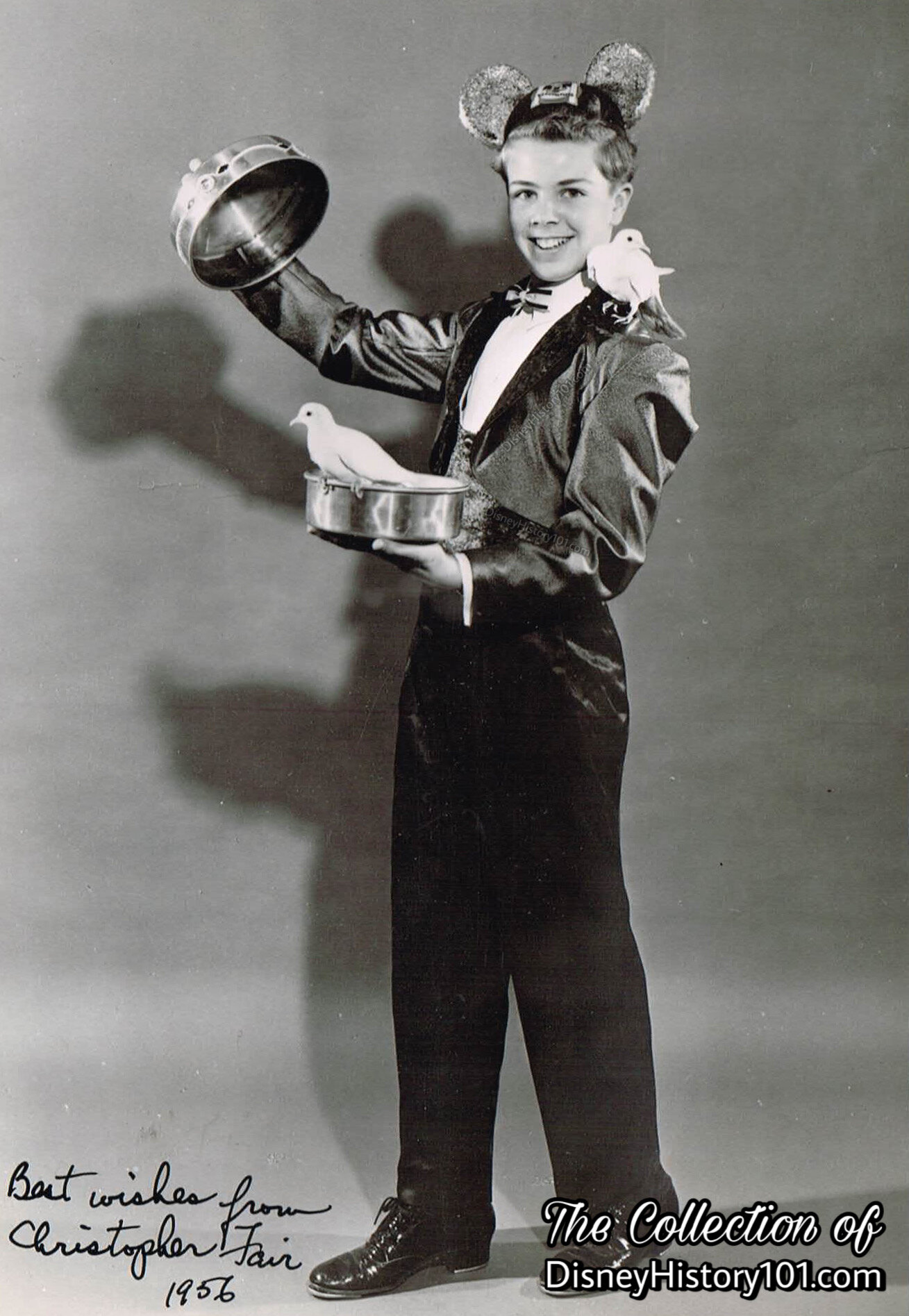
FANTASYLAND COURT JESTER (Christopher Fair as a Child)
A young Christopher Fair made an appearance on the Mickey Mouse Club, and autographed this photograph for Karen Pendleton, which was sent (care of his mother) to her at Walt Disney Studios. We wonder if young Christopher knew at this point, that he was destined to become one of Fantasyland’s most memorable entertainers.
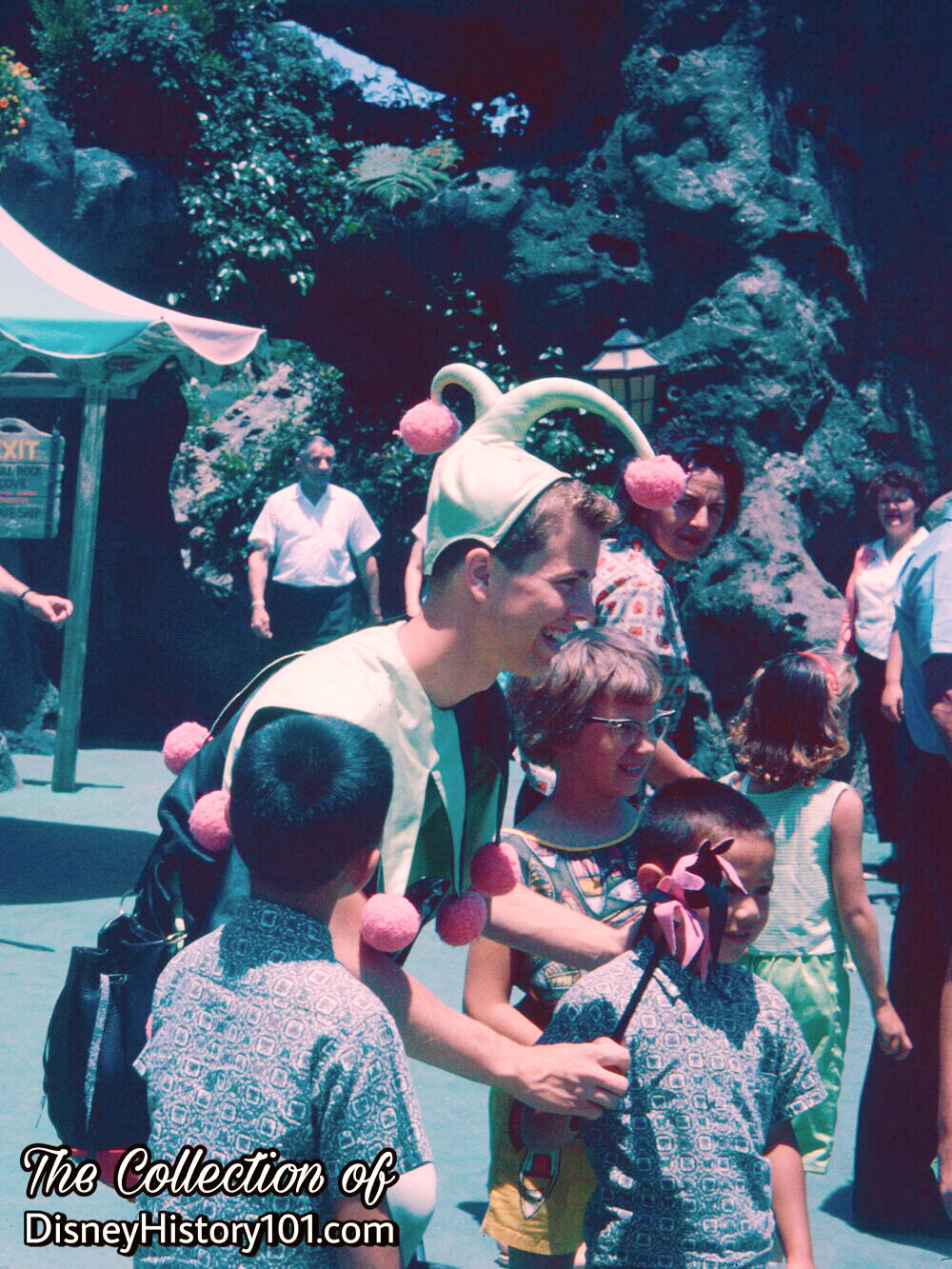
FANTASYLAND COURT JESTER creates happiness for a group of guests.
According to Backstage magazine (published Summer of 1965), “to successfully be ON STAGE at Disneyland means that you must have genuine liking for people. This is particularly true of Fantasyland, because of the close contact with the children of all ages.” Proving this, Christopher Fair (a headliner during Disneyland‘s Summer of ‘61 show) entertains a group of children in Fantasyland!
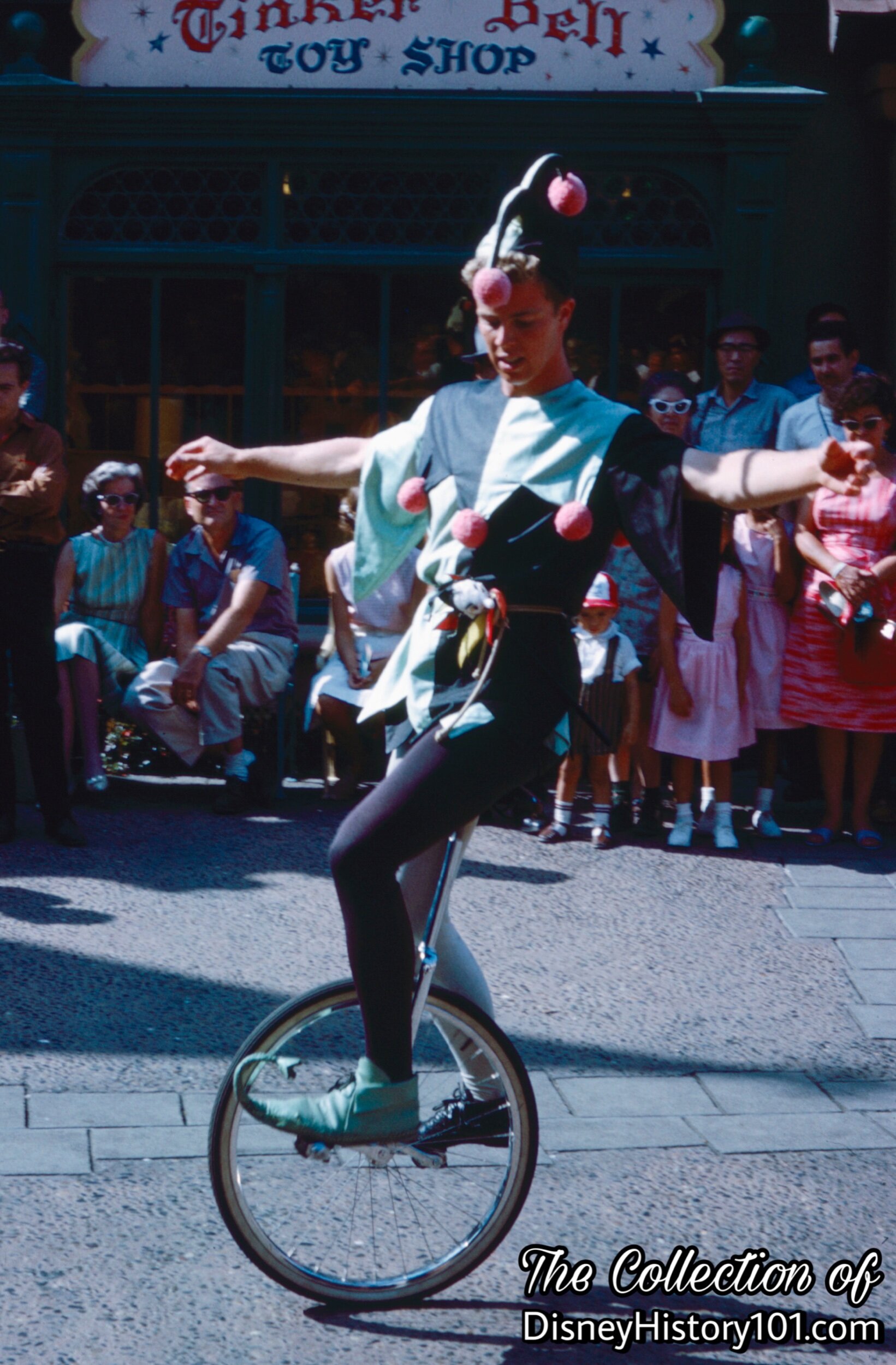
FANTASYLAND COURT JESTER
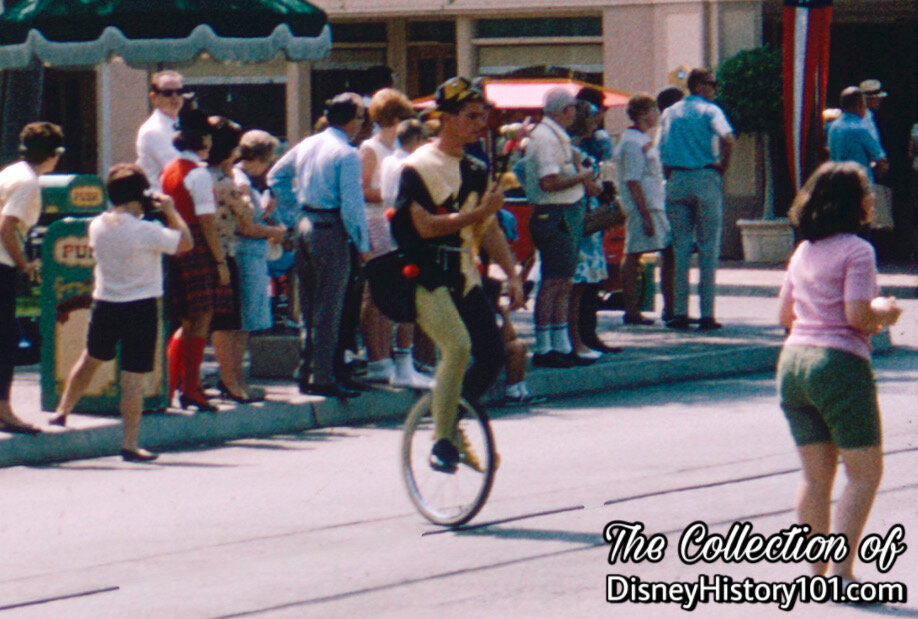
FANTASYLAND COURT JESTER

Above Left : Farley Souvenir Sticker
Roles like that of Farley have become much more challenging with each returning visitor. According to “Speaking on Stage,” prepared 1970: “Or roles become harder every day, too. Over half of our current guests are returning to Disneyland for their second, fifth, or twentieth time. These ‘returnees’ become less excited about the buildings and attractions that they've seen and much more interested and aware of the hosts and hostesses they come in contact with. This places much more demand on… Disneyland's representatives.” And so there rises a great demand for this representative of the Disneyland show to improve upon his showmanship and speaking!
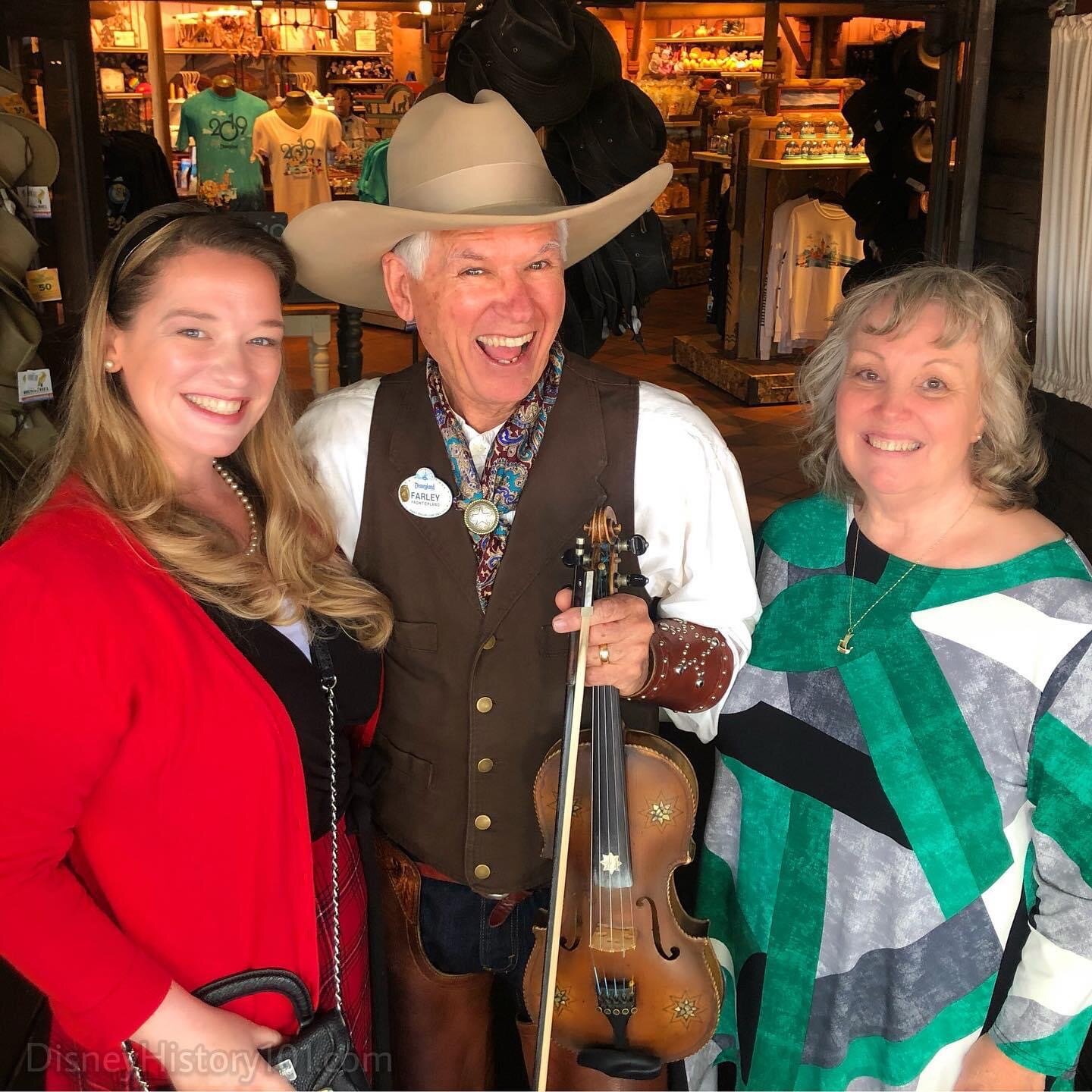
From Left To Right : Your Field Guide Beth, Farley “the Fiddler” and Mrs. “the Fiddler” extend a courteous smile.
Like Sheriff Lucky and Black Bart (before him), Farley the Fiddler embodied the “Spirit of Frontierland”! This Farley did, while “stringing us along” for 33 years, excelling in his individual role both effectively and efficiently until his retirement! While most Face Characters do not sing songs, Farley’s role was truly unique, in that he sang to Guests.
This “five minute fairy tale” had a happy ending. I would like to share this final farewell photo (pictured above) with both Farley and his true-life fair wife - “Mrs. The Fiddler.”
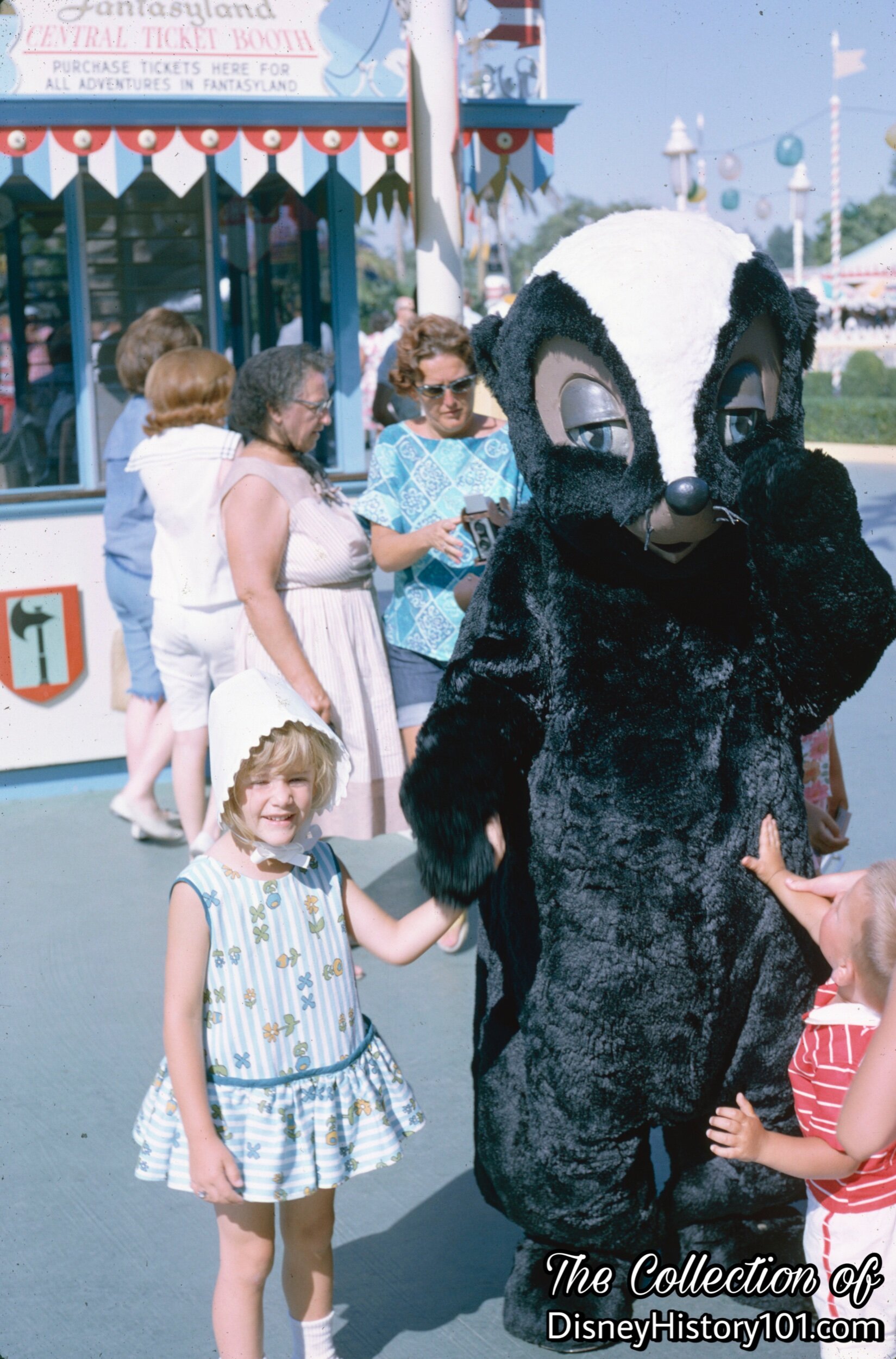
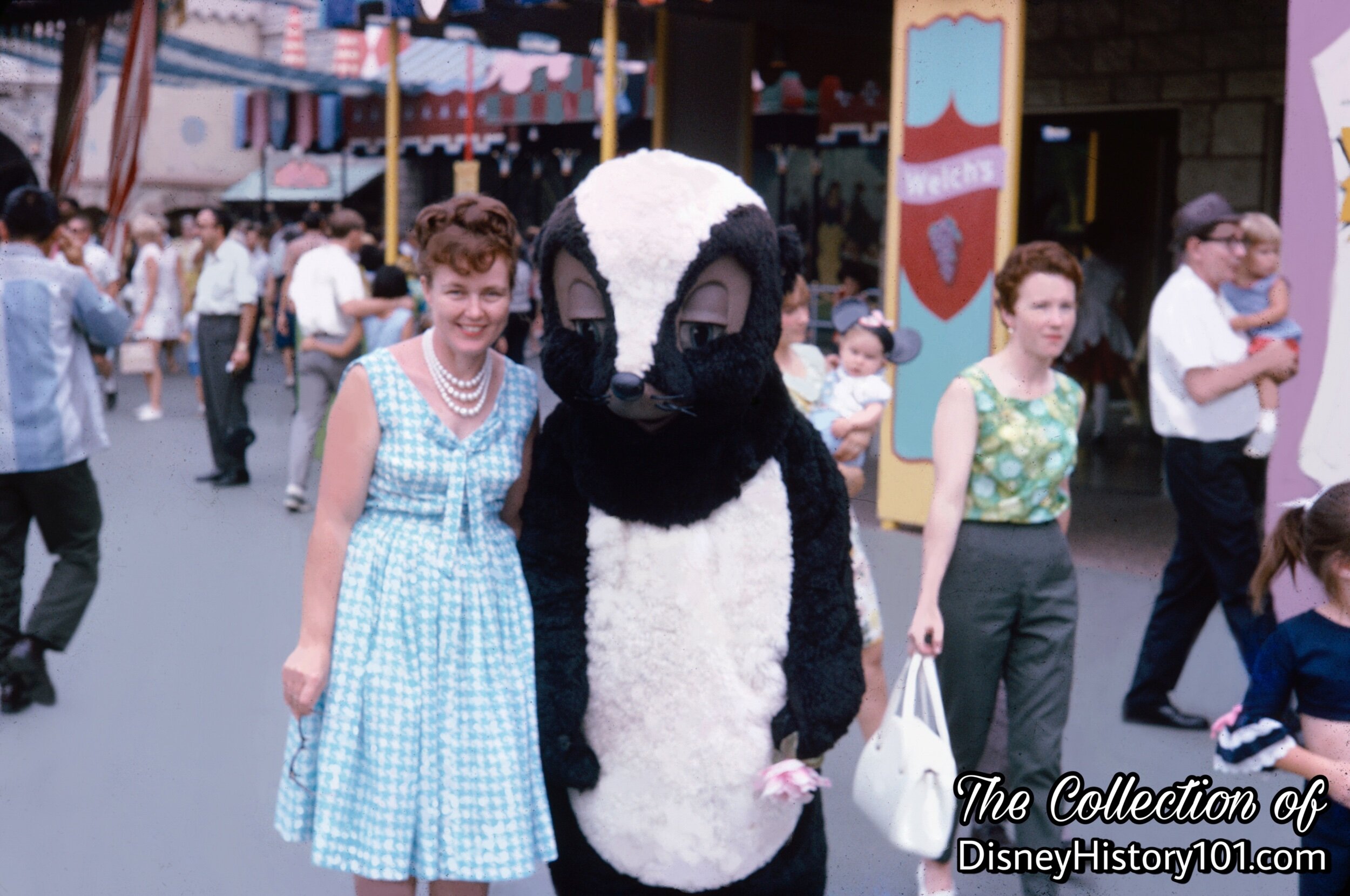
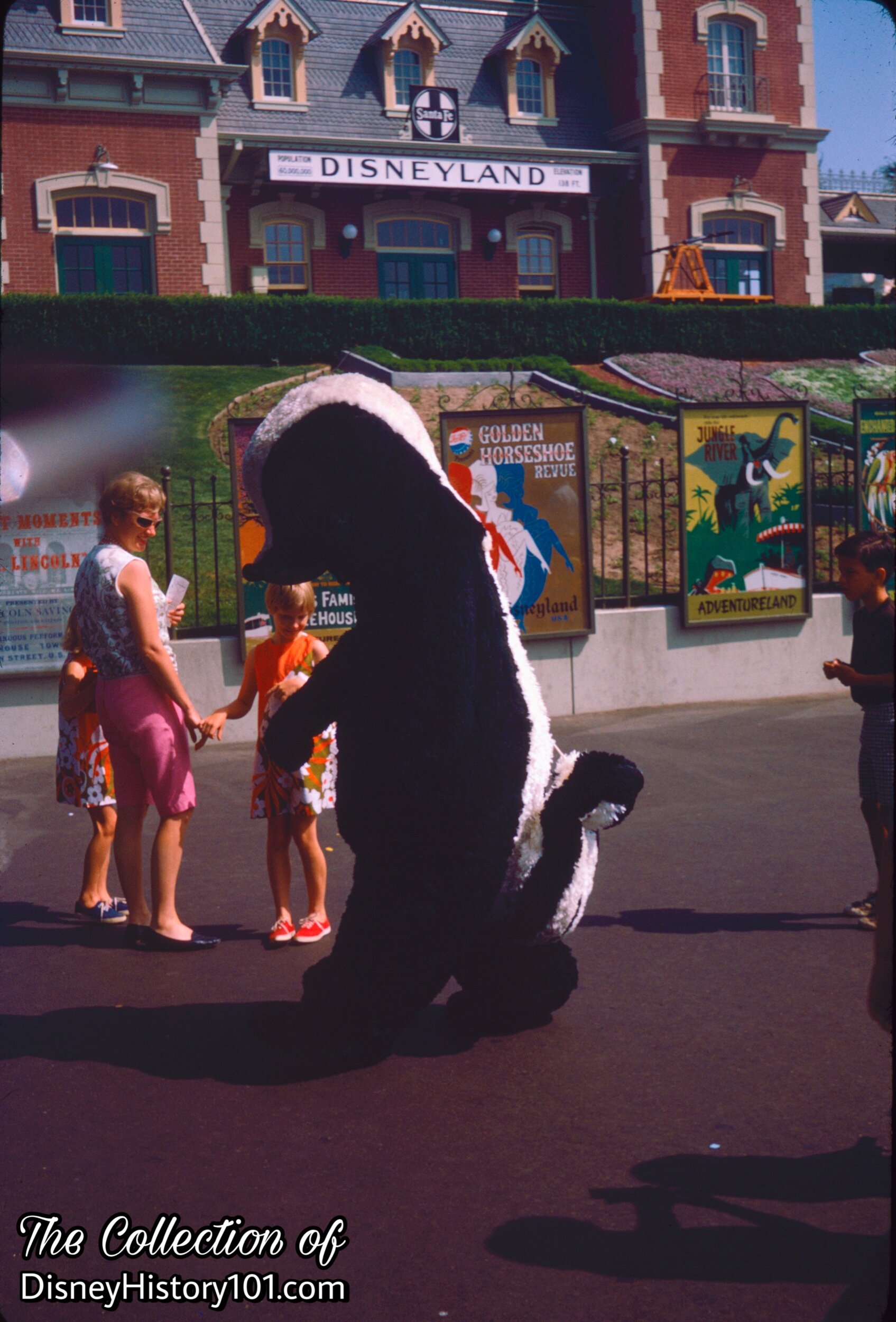
FLOWER, (1967)
Flower the Skunk and Thumper the Rabbit (taken from Walt Disney’s Bambi) were some of the newest Disneyland stars to appear during the summer of 1964.
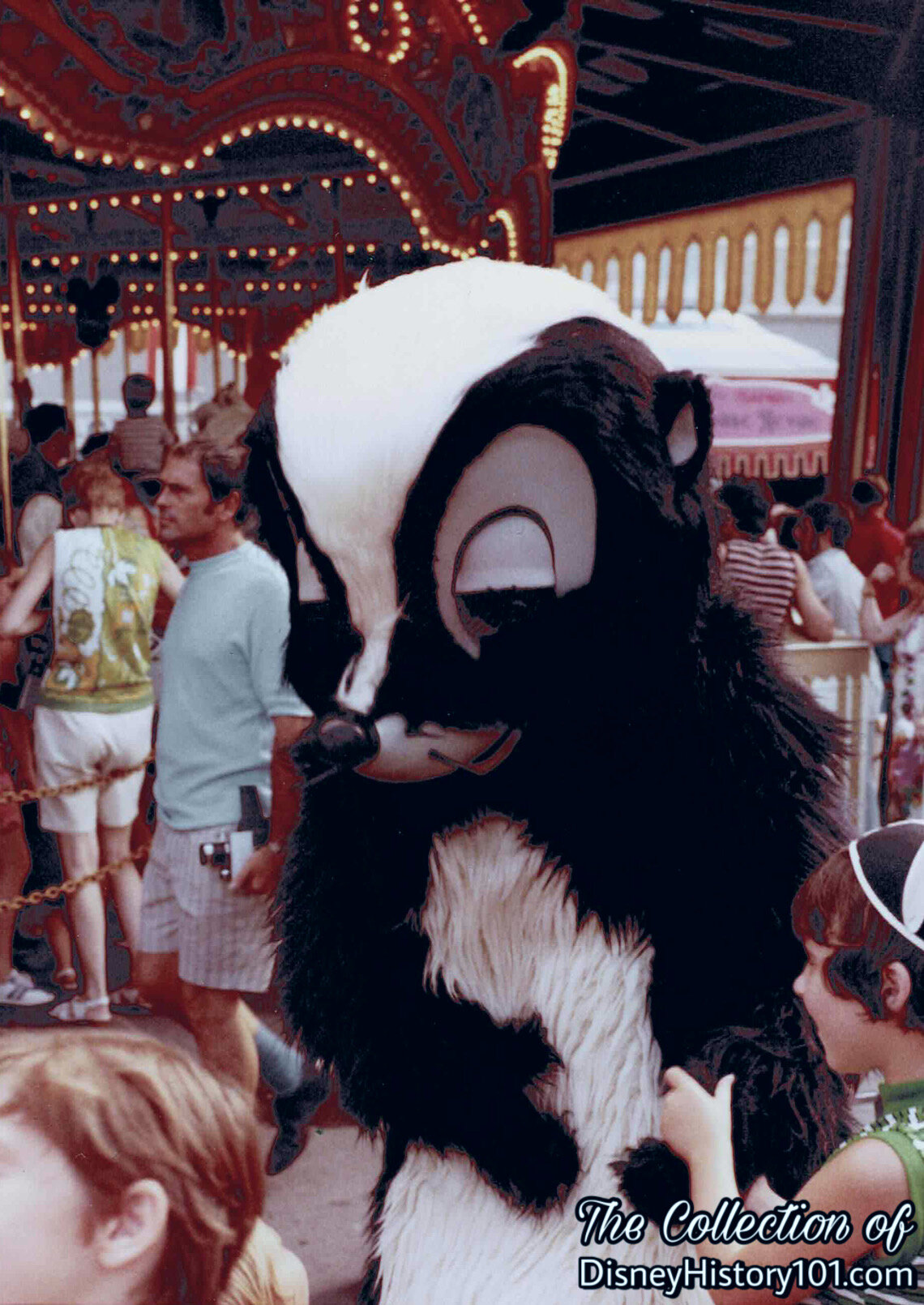

In This Section :
•Gargoyles (Victor, Hugo & Laverne) -
•Genie (Aladdin) - Genie made his debut in Disney’s Aladdin released November 25, 1992.
•Geppetto - Geppetto made his debut in Walt Disney’s Pinocchio, on February 7, 1940. When he isn’t making a new puppet for Pinocchio, Geppetto greets Guests at Disneyland.
•Gideon - Gideon made his debut in Walt Disney’s Pinocchio, on February 17, 1940.
After some sort of hiatus, the Disney Character made a return during the winter if 1962. According to the Talent Schedule “All of our regular Characters, plus a return visit by the 3 Pigs and Wolf and Pinocchio, J. Worthington Foulfellow and Gideon, will highlight this year's Holiday Season.”
Gideon was part of the Pre-game “Walt Disney and Disneyland Salute to the California Angels” at the new Angels Stadium on Saturday, April 23rd, 1966! Gideon made regular appearances at the “Small World” Area, greeting guests as part of the Character Program, “throughout the Christmas Holidays” (daily between parades, from 9:00am to 11:45am). [“Disneyland Holiday Talent Master Schedule,” prepared for the period of December 16, 1967 through January 1, 1968]
•Goofy - Goofy made his film debut in 1932 and his first appearance in the Mickey Mouse comic strip in 1933. Subsequent merchandise was produced featuring the licensed soon-to-be “Standard Disney Character,” indicating that his name was “Dippy Dawg” or “Dippy the Goof” (according to one c.1938 Whitman publication entitled “Walt Disney’s Story of Dippy the Goof”). According to one source Daisy has been considered a “Disney Standard Character,” meaning that she is a character “of the highest integrity” and “only associates with products, brands, and companies of the highest quality and integrity.” Since the beginning, Goofy “has always been a modest, unassuming fellow, one who’s never let fame go to his head,” according to Walt Disney. Soon, “The Reluctant Dragon” would introduce a popular series of “How To…” short films starring Goofy (also occasionally known as suburbanite George Geef).
If you watch Dateline Disneyland, you’ll notice Mickey, Minnie, Dumbo, Pluto, Pinocchio, and other licensed Walt Disney Productions characters cavorting down Main Street U.S.A., appearing by a special arrangement between Walt Disney and John H. Harris (Producer of the Ice Capades). Walt Disney’s Peter Pan and Captain Hook made a promotional appearance (as they were touring with John Harris’ Ice Capades). Even Snow White and the Seven Dwarfs, Chip ‘n Dale, their Chipmunk gal pal Bernice, and “Cinderella riding in a golden coach” were part of the procession. However, despite costarring in several films with Mickey Mouse and Donald Duck during the 1930s and despite going on to star in a series of popular short films of his own, there was not so much as a “Goofy Holler” to be heard during Disneyland’s opening day procession of July 17th, 1955.
But a few months later (by November), the Mickey Mouse Club Circus opened in Holidayland, and the first “come to life” incarnation Goofy finally appeared alongside his Ice Capades friends.
It wasn’t until the the summer of 1961, when an updated Goofy (a second incarnation) would “come to life” (in person) to greet Disneyland guests! This time (from 1961-1963) he would sport a green vest and yellow-blue hat. Recall that Walt Disney Studio Character Artist Bill Justice partnered with John Hench to oversee the creation of new characters that “could stand up to the rigors of everyday use among guests”. Almost immediately, souvenir postcards would feature Goofy and the rest of Disneyland’s popular cast of characters. During this time (of which Dennis Biggs was close to him), you may say “he’s Goofy about Disneyland” - gallivanting about Disneyland’s five cardinal lands, often without a formal schedule or static location for greeting guests. Goofy would be re-imagined yet again, subsequently appearing from 1963 to 1969 (“close to” Charlie Ridgway and others). This 3rd incarnation of Goofy made appearances alongside his reimagined friends outside Disneyland at the New York World’s Fair of 1964 and 1965. While there, Mickey, Goofy, and Pluto appeared at all of Walt Disney’s shows and even other pavilions. For instance, they assisted in the ribbon cutting at the new “People-to-People Room” of the Federal Pavilion of the New York World’s Fair during the 1964 season. Goofy also appeared at a Pennsylvania May Company department store (in 1965). However (like other Disney Characters), Goofy appeared at quite a few other events held outside Disneyland, demonstrating “the ultimate in wild animal training assisted by… Pluto,” in an act performed at the Canadian National Exposition’s “Matinee Fun Fest” (held August 24 - September 5, 1964). Goofy, Pluto, and “official Disneyland Tour Guide Lynn Taylor” engaged in the Coca-Cola Tour, advertised for the summer of 1970. The trio visited locations like the south patio of the Brentwood Country Mart.
In Hollywood, actors had stuntmen, and these multiple and simultaneous appearances of Goofy were similarly accomplished by way of “body doubles.” For instance, in 1964 Wardrobe assured that Goofy had at least “3 costume bodies” and “3 heads” in addition to costumes.
Goofy had the honor of catching the first ball (thrown by Mickey) as part of the Pre-game “Walt Disney and Disneyland Salute to the California Angels” at the new Angels Stadium on Saturday, April 23rd, 1966!
As for Goofy’s routine appearances at Disneyland, he regularly greeted guests “throughout the Christmas Holidays” as part of the Character Program, in Town Square (daily (9:00am to 11:45am) with both Mickey Mouse and Pluto. [“Disneyland Holiday Talent Master Schedule,” prepared for the period of December 16, 1967 through January 1, 1968]
During the 1970s, Goofy appeared in Main Gate/Town Square.
By the 1980s, Goofy had appeared in a total of 85 films (including a safety series and the ever-popular “How To…” series).
In 1992, Goofy starred in his very own parade - “The World According to Goofy.” In 1995 the states of Alabama, Tennessee, North Carolina, South Carolina and Georgia proclaimed April 1st as Goofy Day to celebrate the release of A Goofy Movie.
In the present, Mickey Mouse, Minnie Mouse, Donald Duck, Goofy, and Pluto are still considered the original "Fab Five" VIP Characters. When Goofy isn’t helping Max with his homework or Max isn’t teaching him to skateboard, he can occasionally be found meeting and greeting Guests at Disneyland.
•Grammi Gummi
•Grumpy (Snow White and the Seven Dwarfs)
•Gus-Gus (Cinderella) - Gus made his debut in Walt Disney’s Cinderella released February 15, 1950.
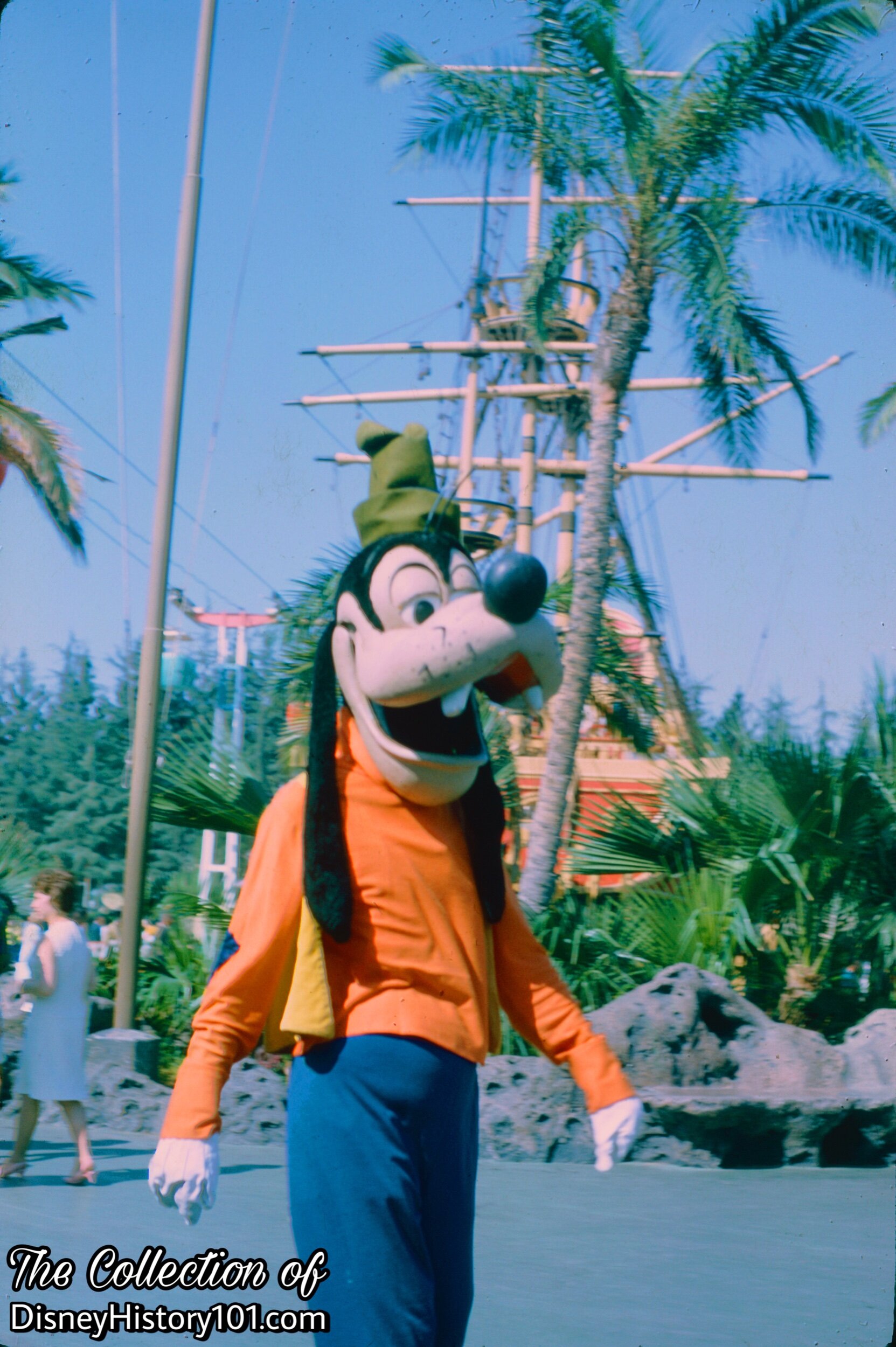
GOOFY, (c. August, 1966)
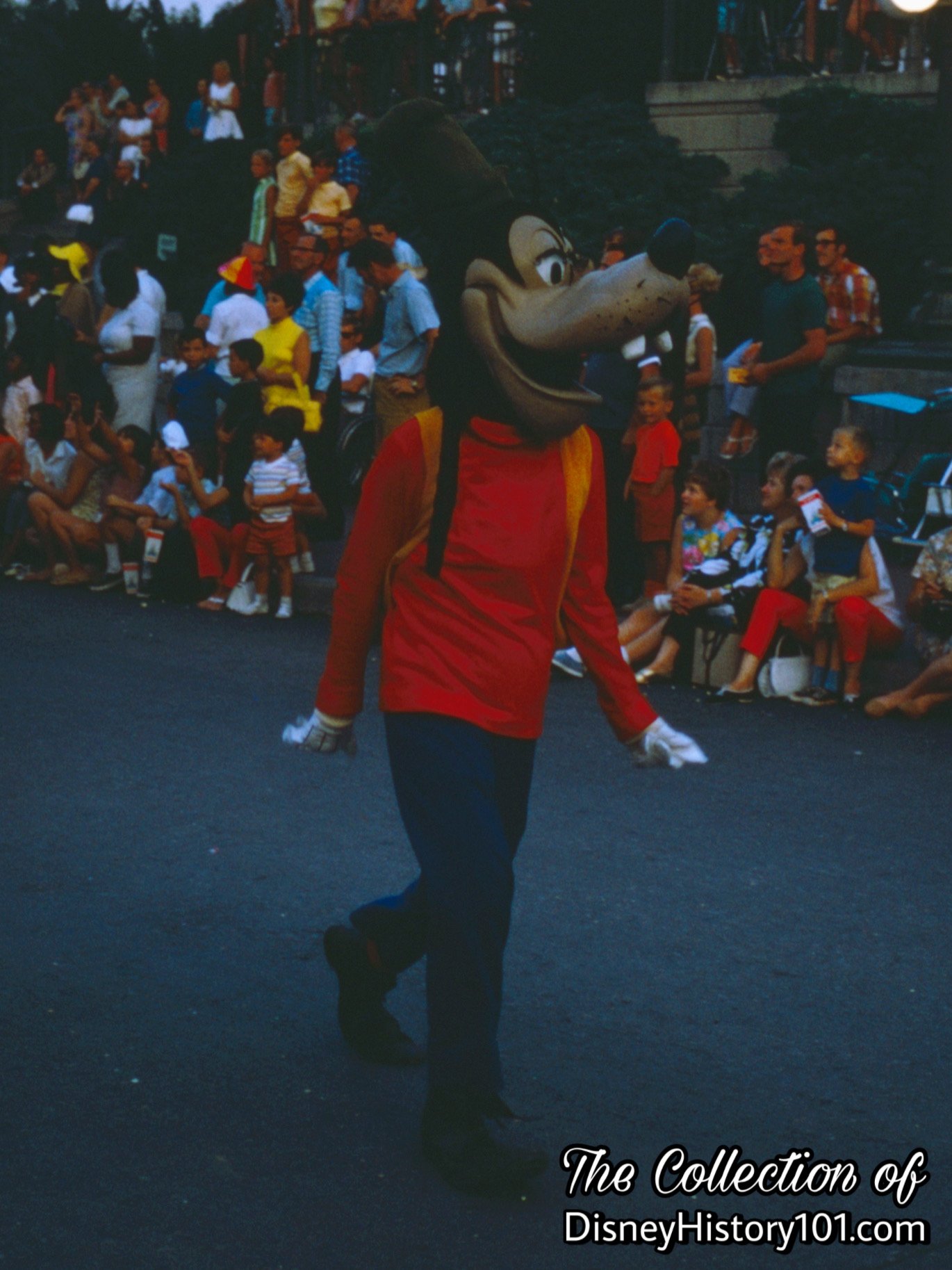

GOOFY, (1967)

GOOFY, (January, 1977)
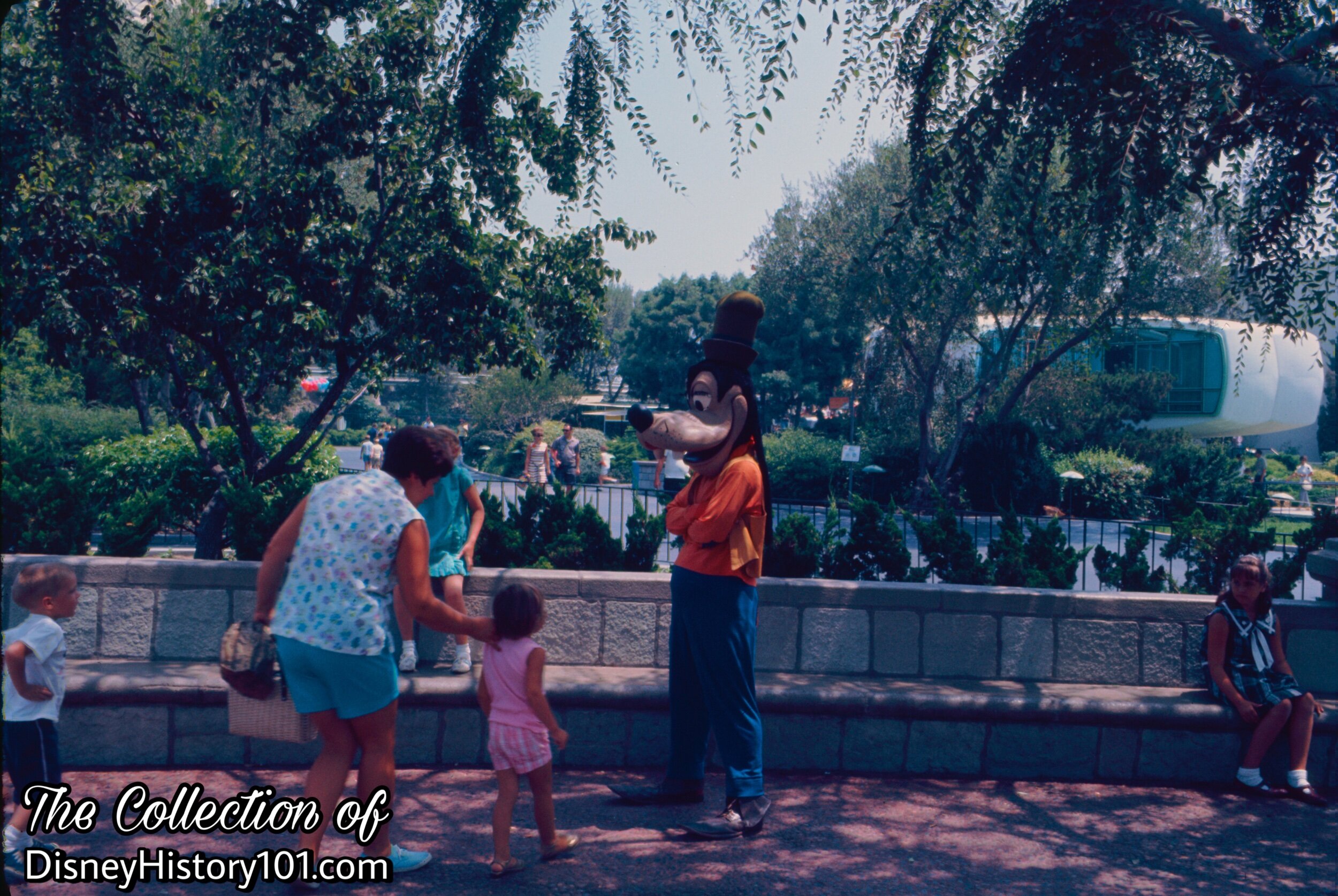
GOOFY, (August, 1967)
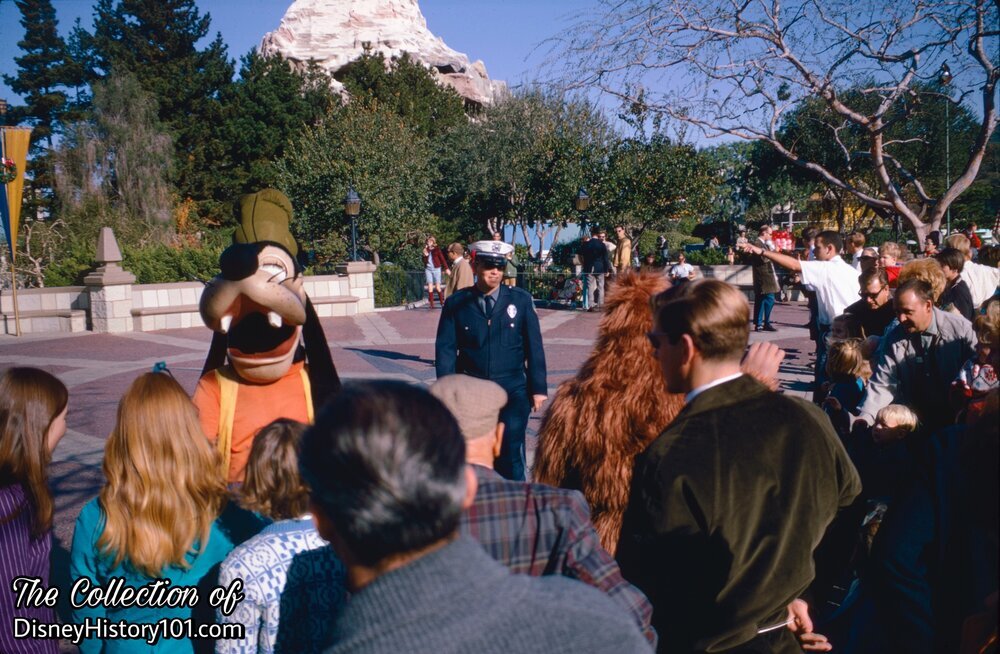
GOOFY, (February, 1968)
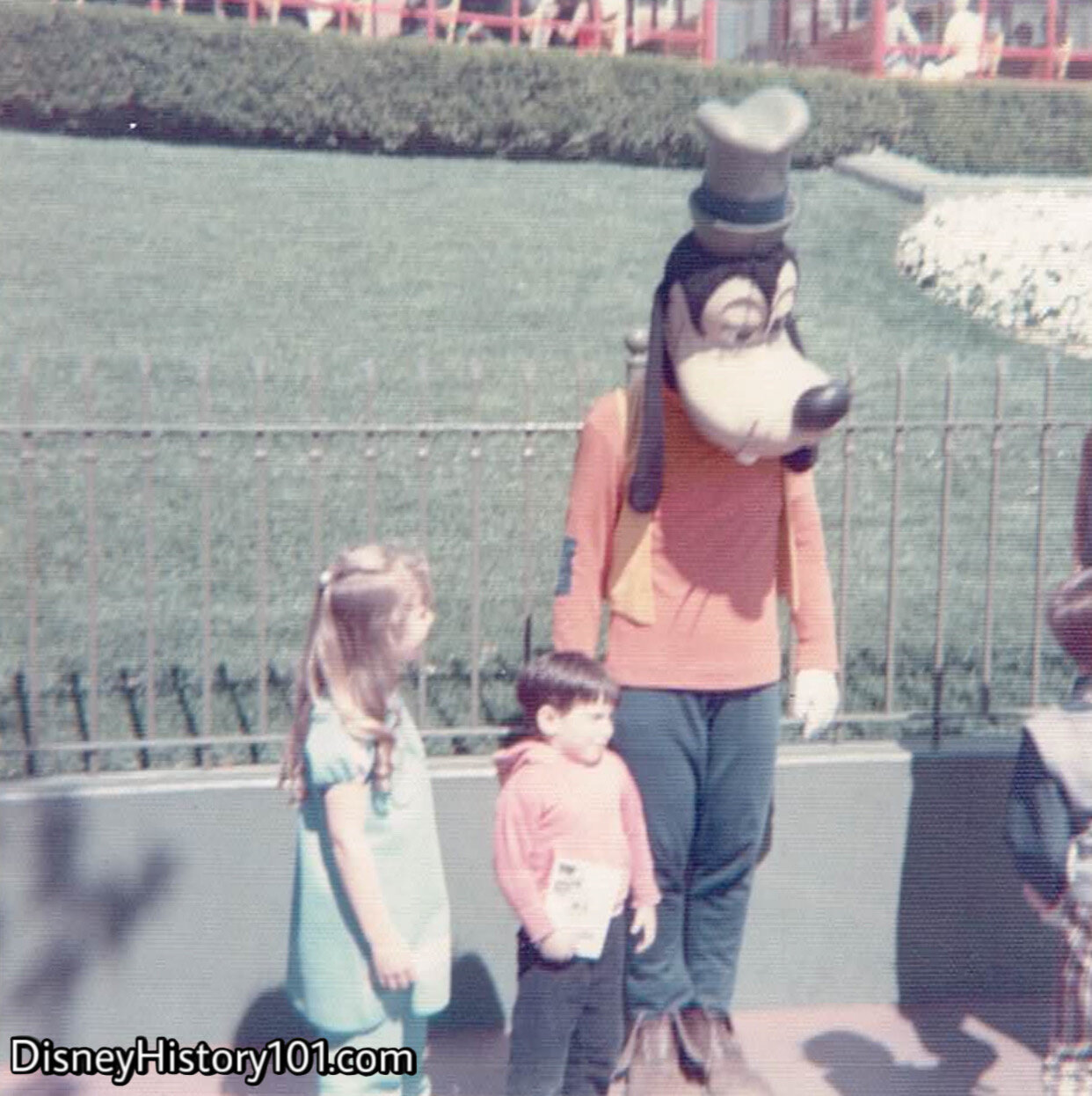
GOOFY, (April, 1971)
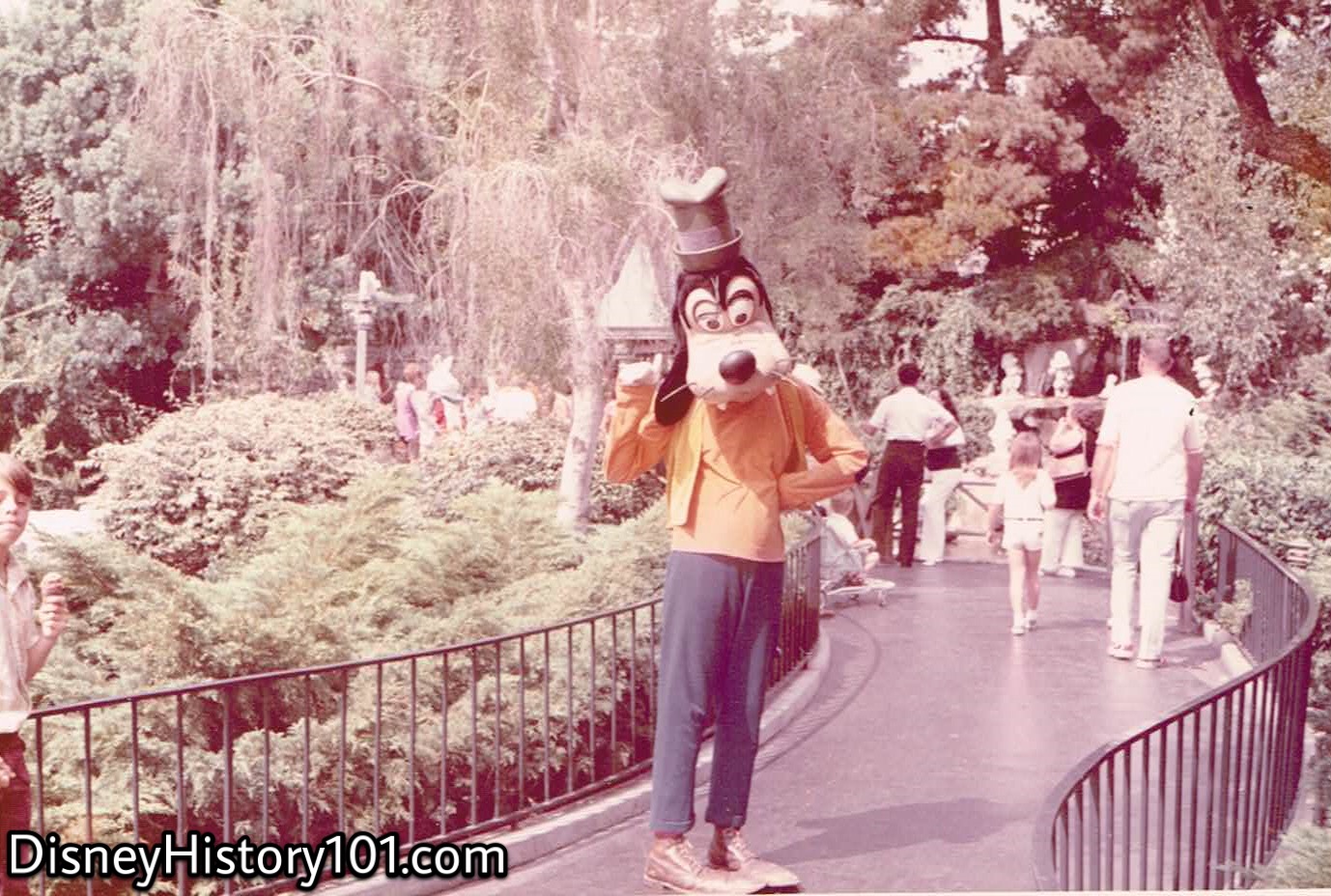
GOOFY, (September, 1972)
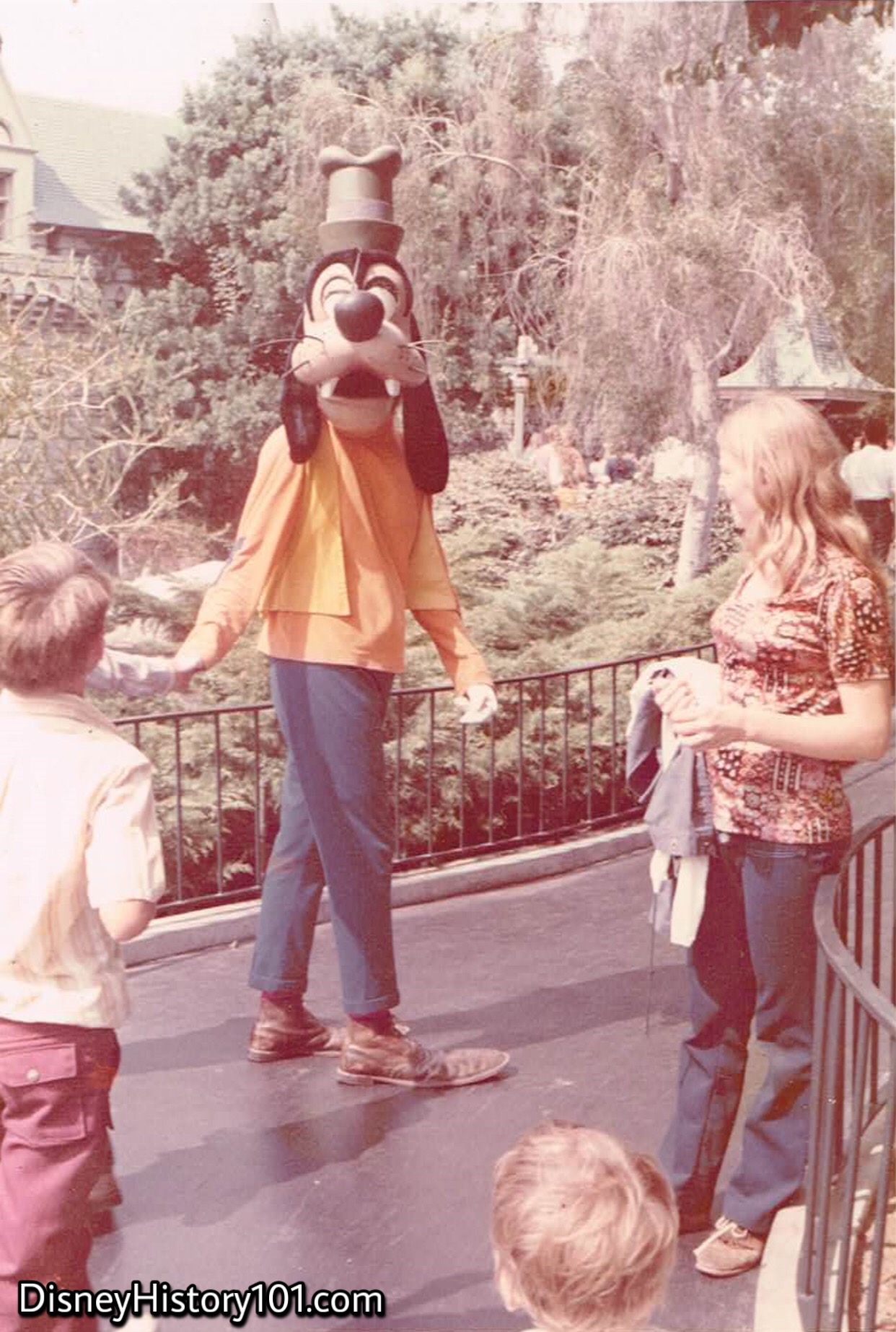
GOOFY, (September, 1972)
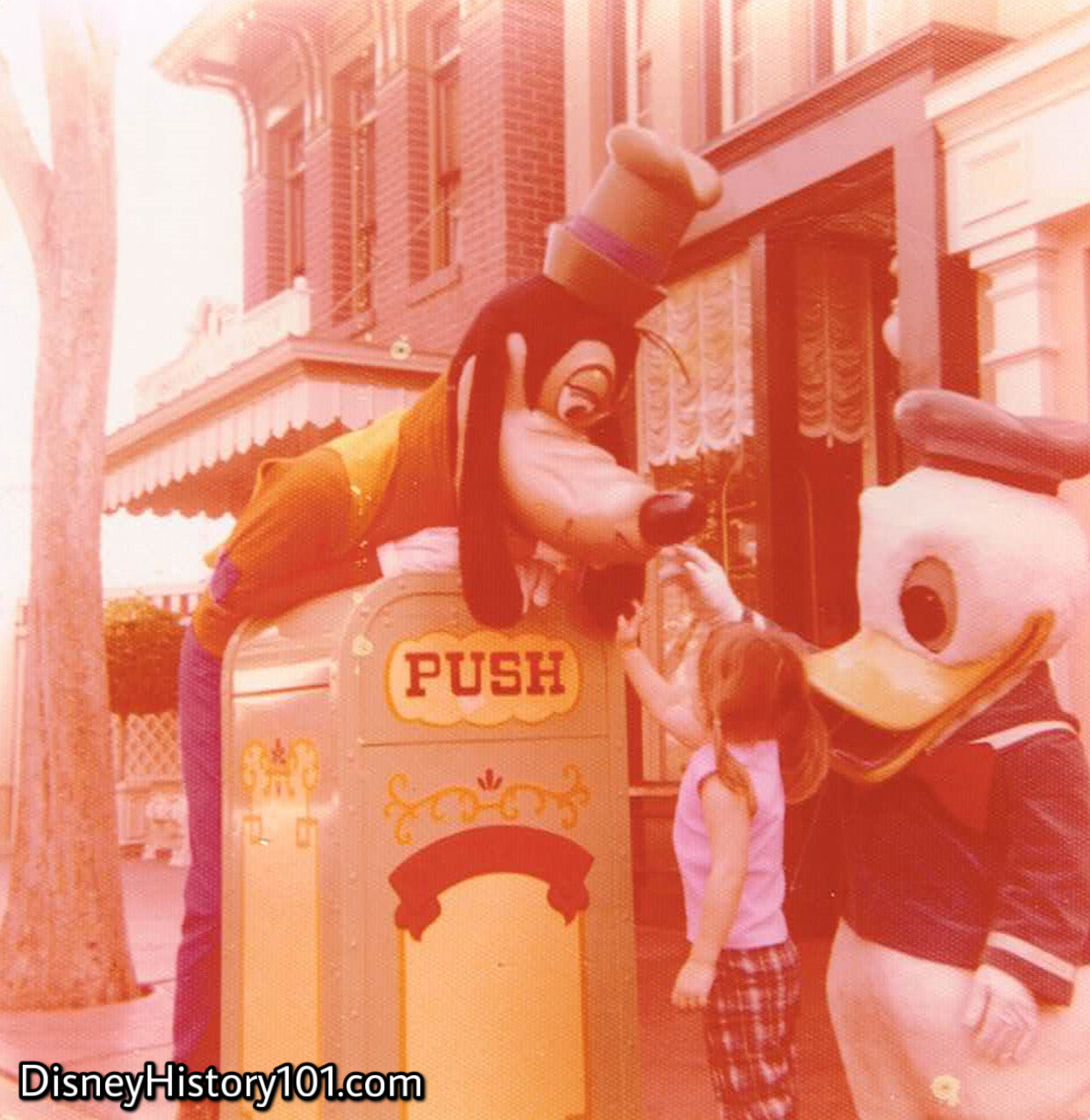
GOOFY
Goofy makes a magical moment for a guest, proving that he’s a guest relationship expert.
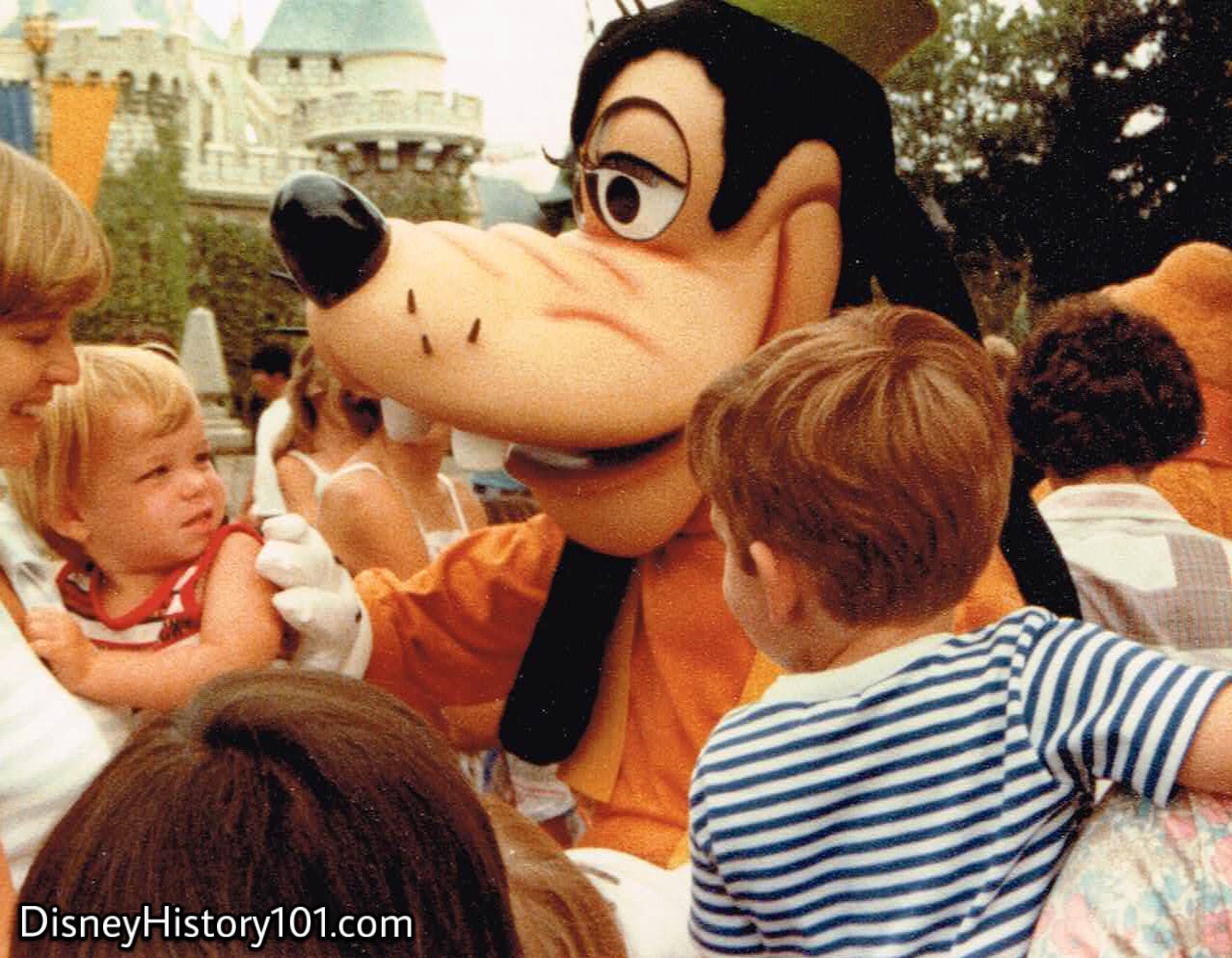
GOOFY, (May, 1979)
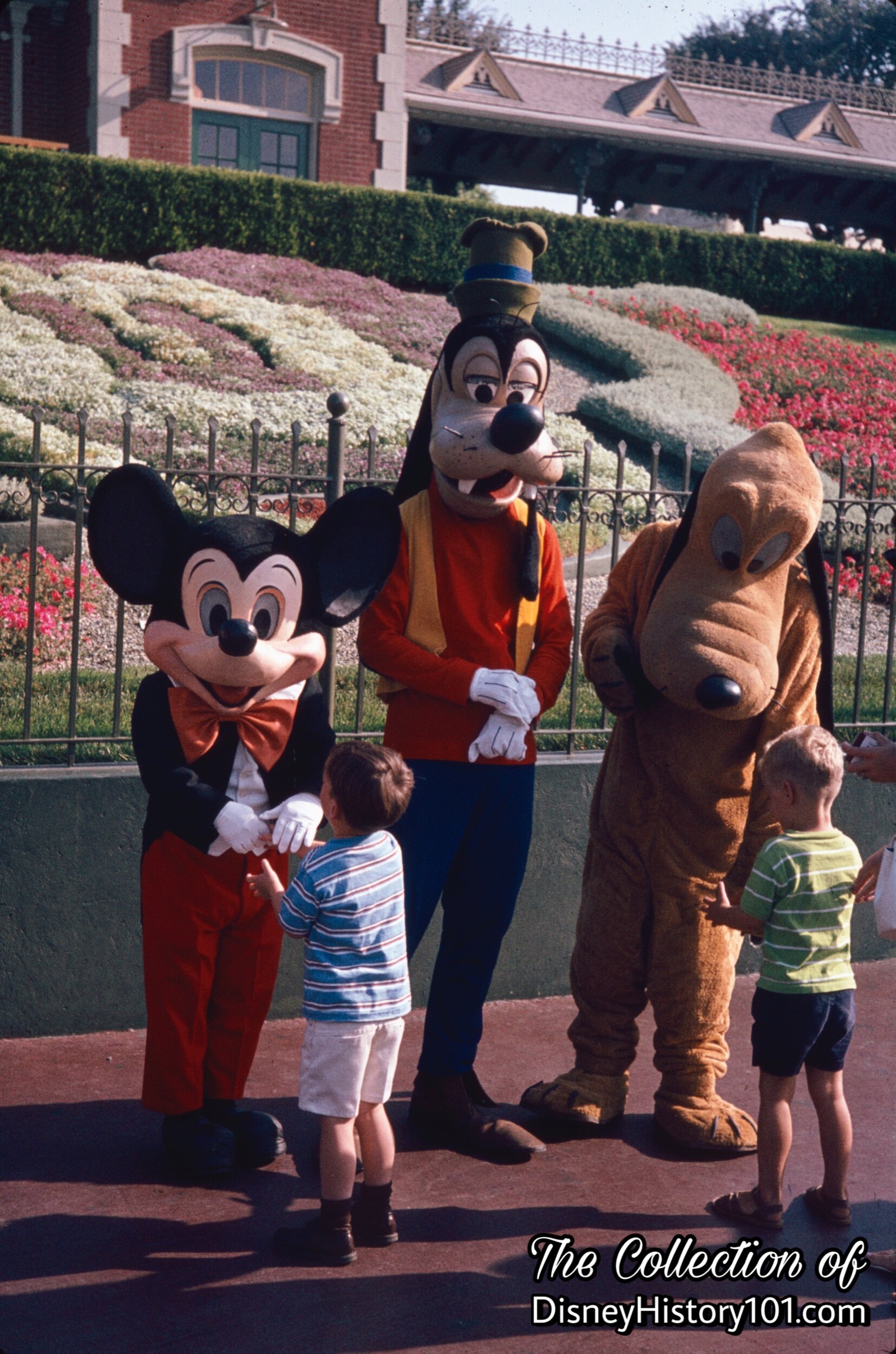
GOOFY, PLUTO, and MICKEY MOUSE
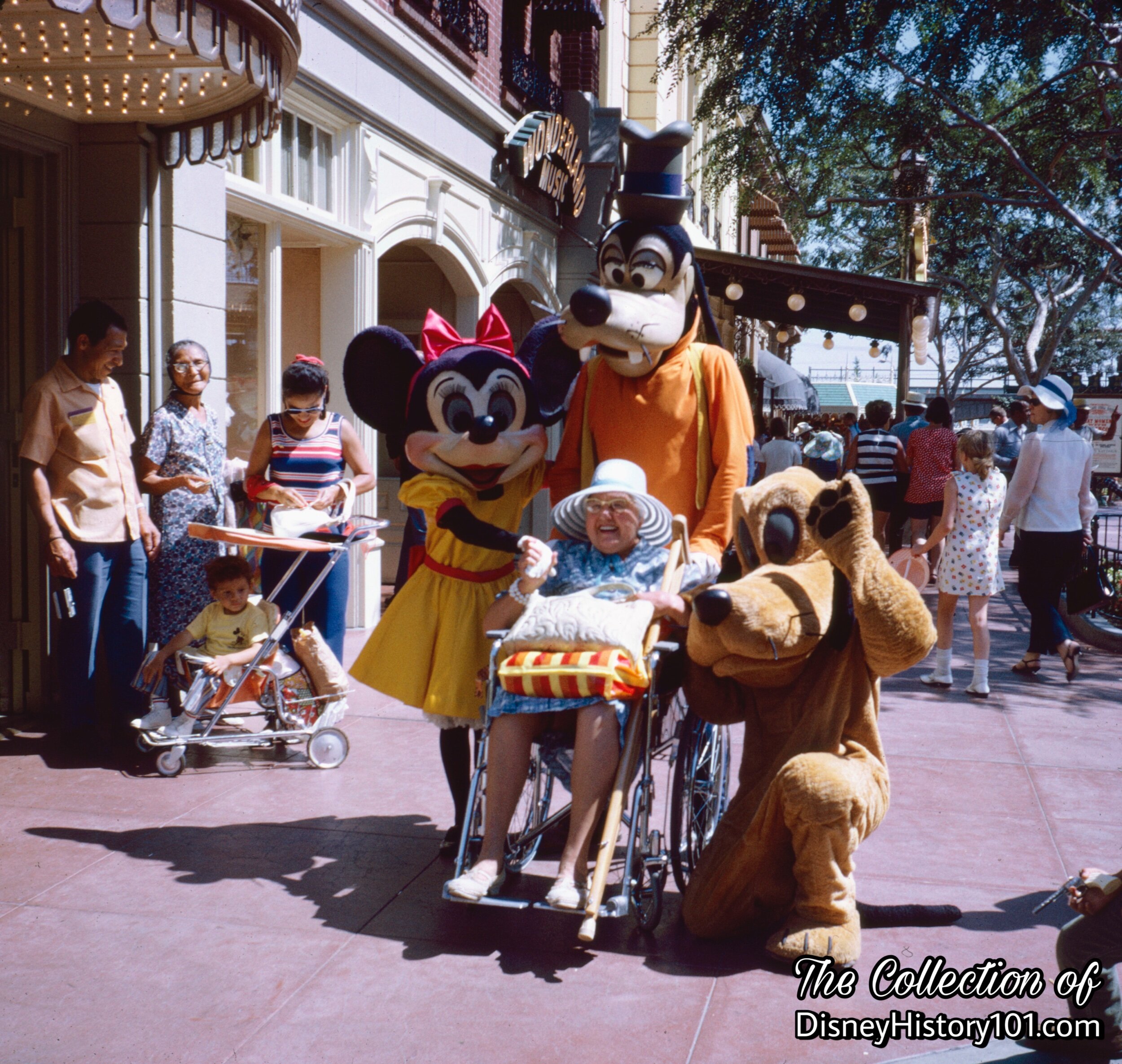
Standard Characters Goofy, Minnie, and Pluto make special Disney memories for a Guest.
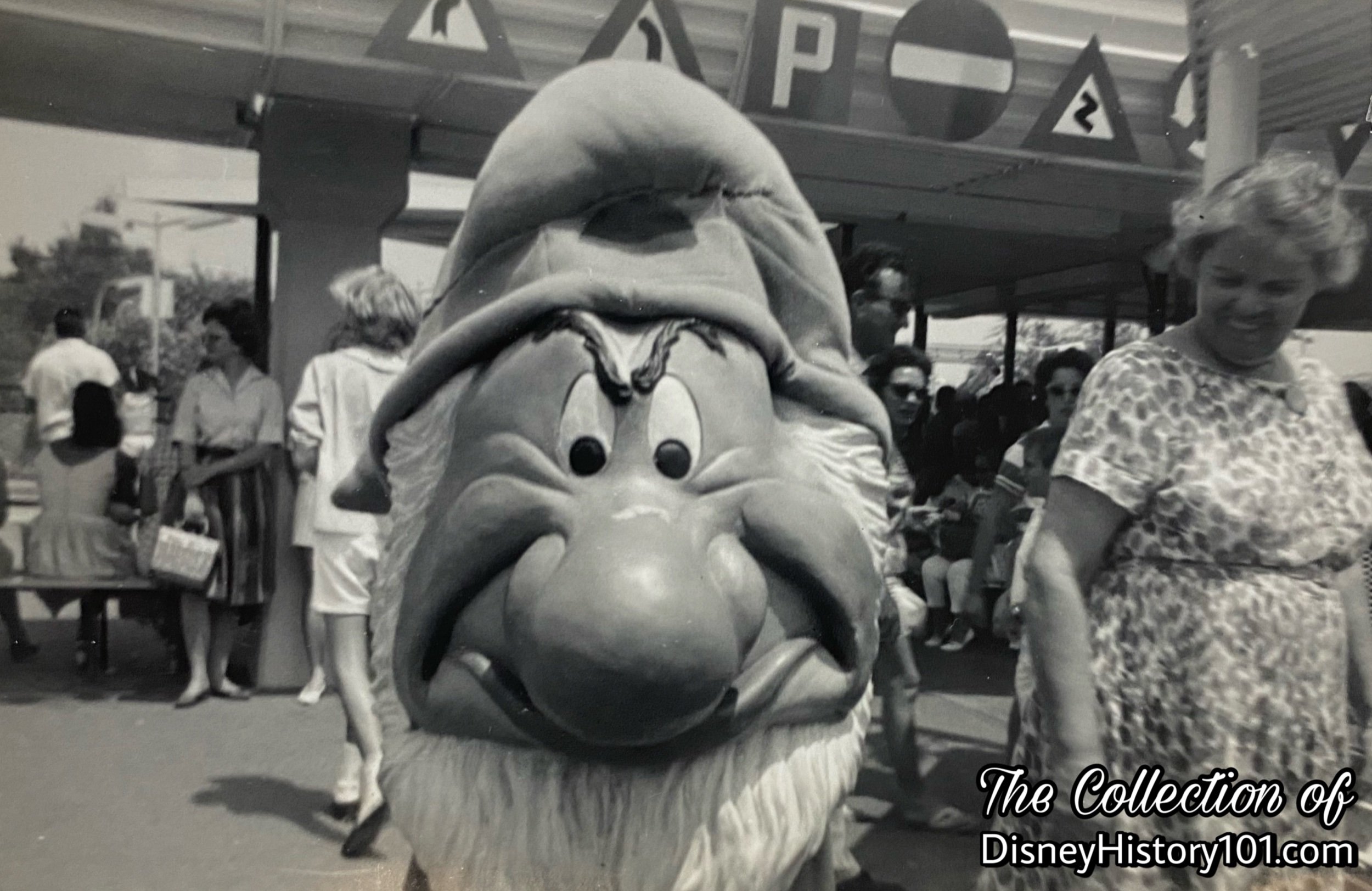
September, 1961.
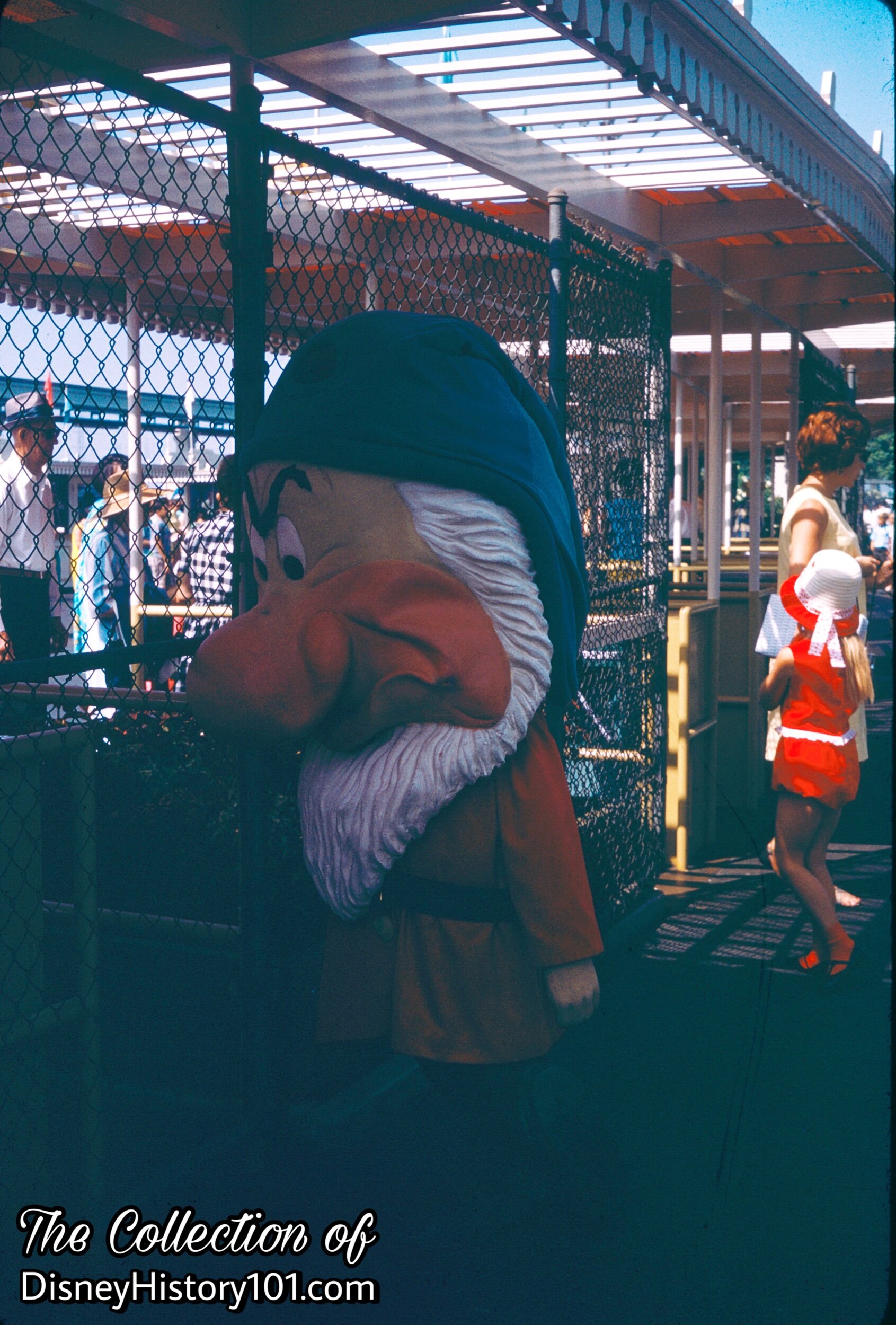
GRUMPY, (1967)
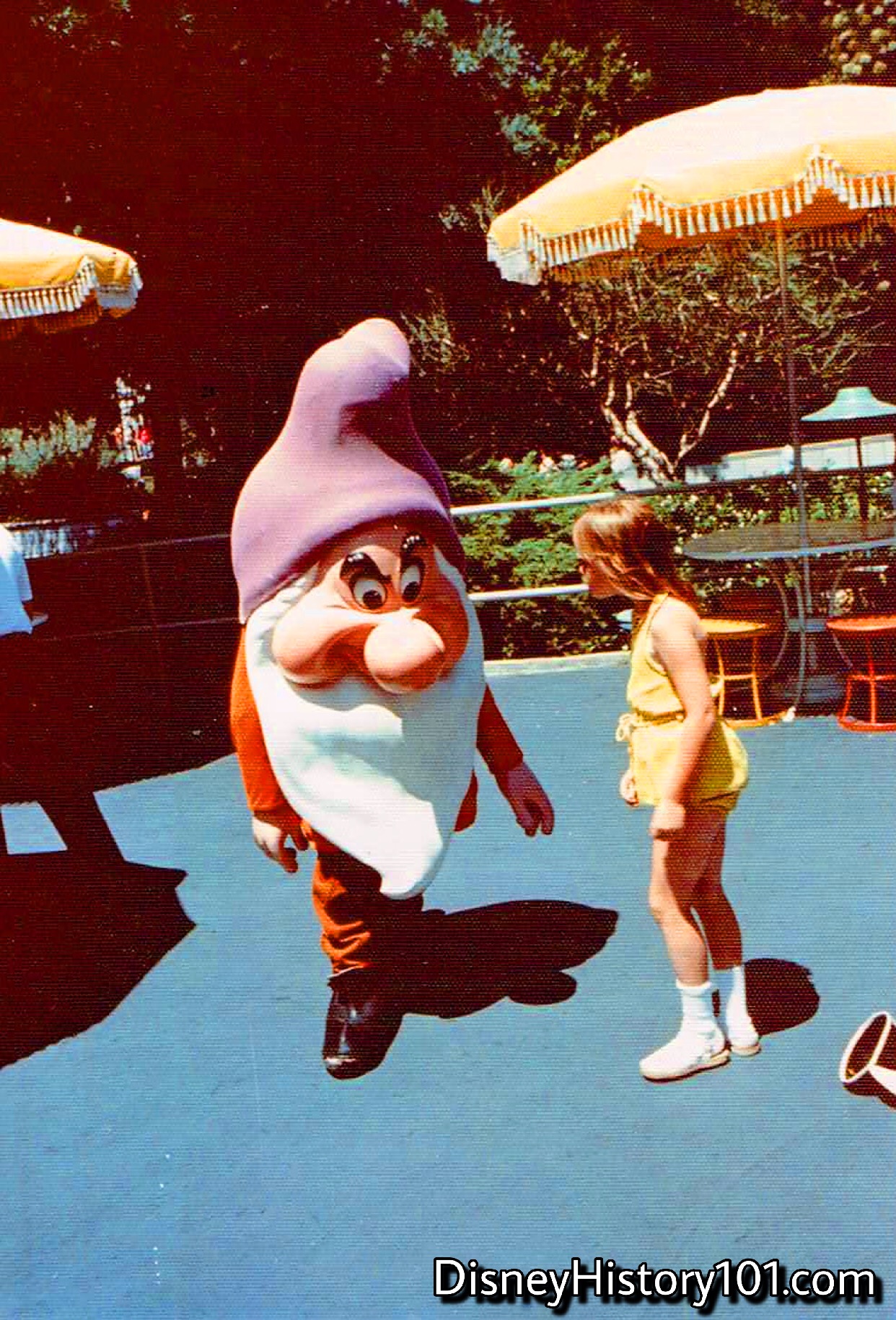
GRUMPY

GRUMPY
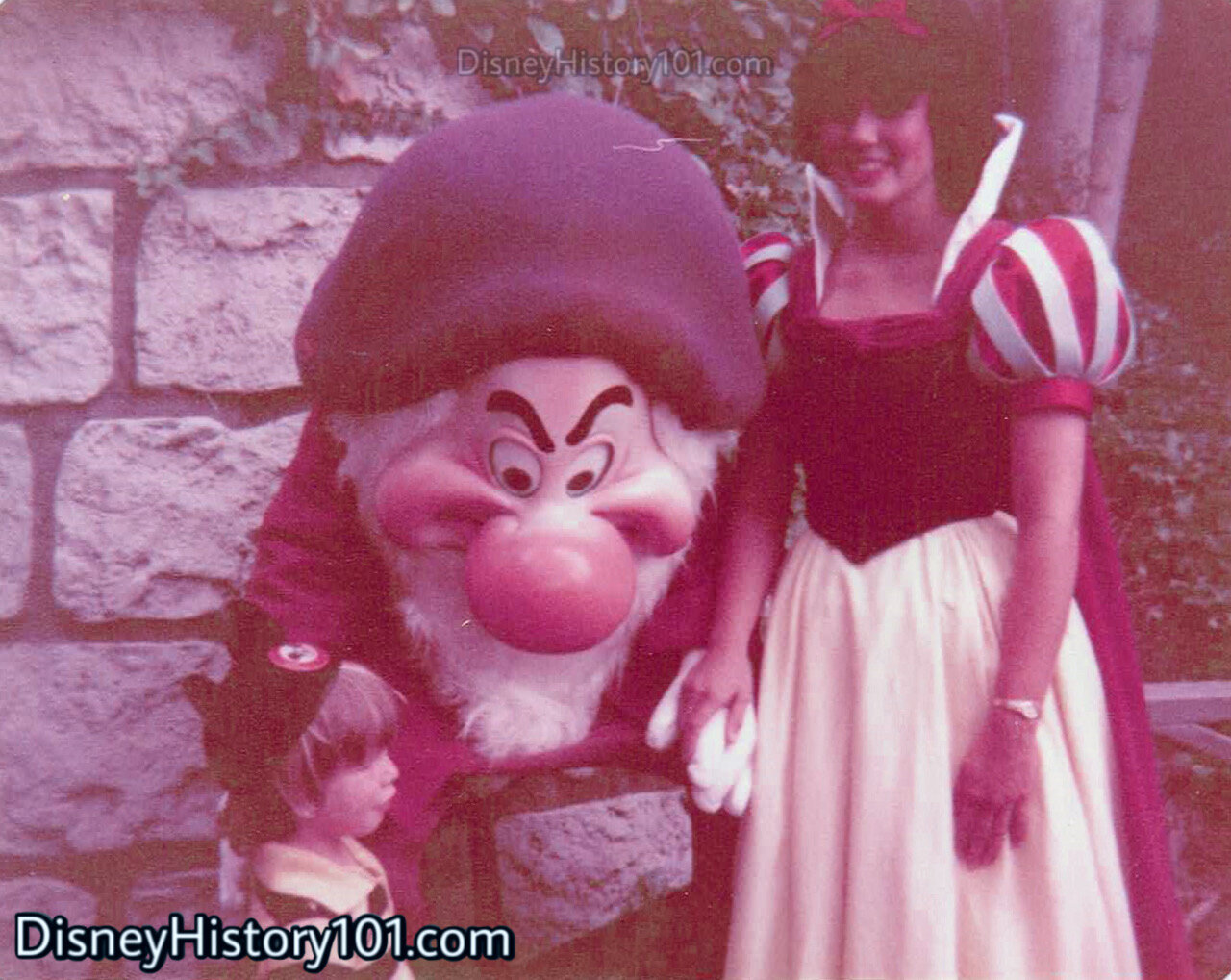
GRUMPY
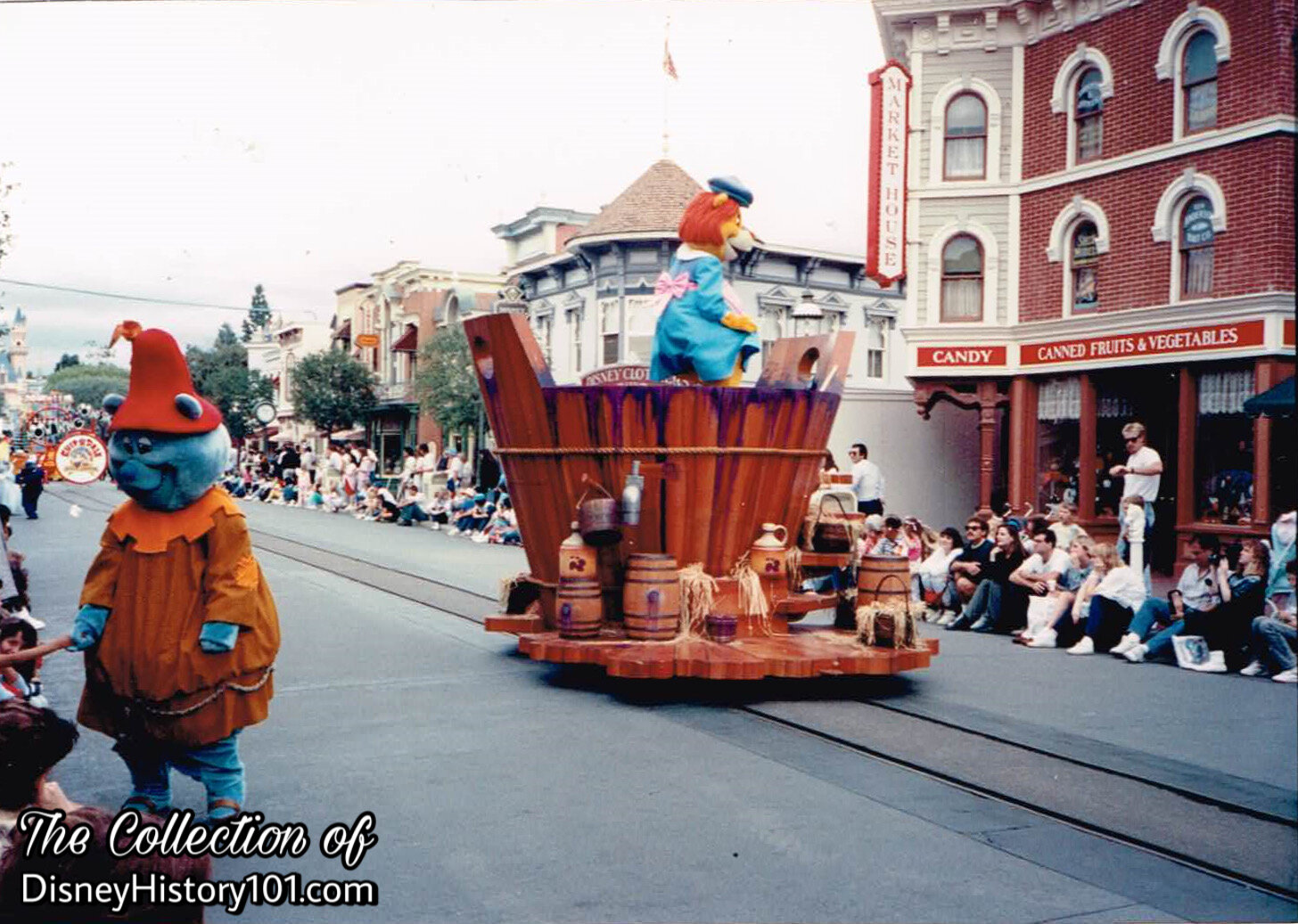
GRAMMI GUMMI
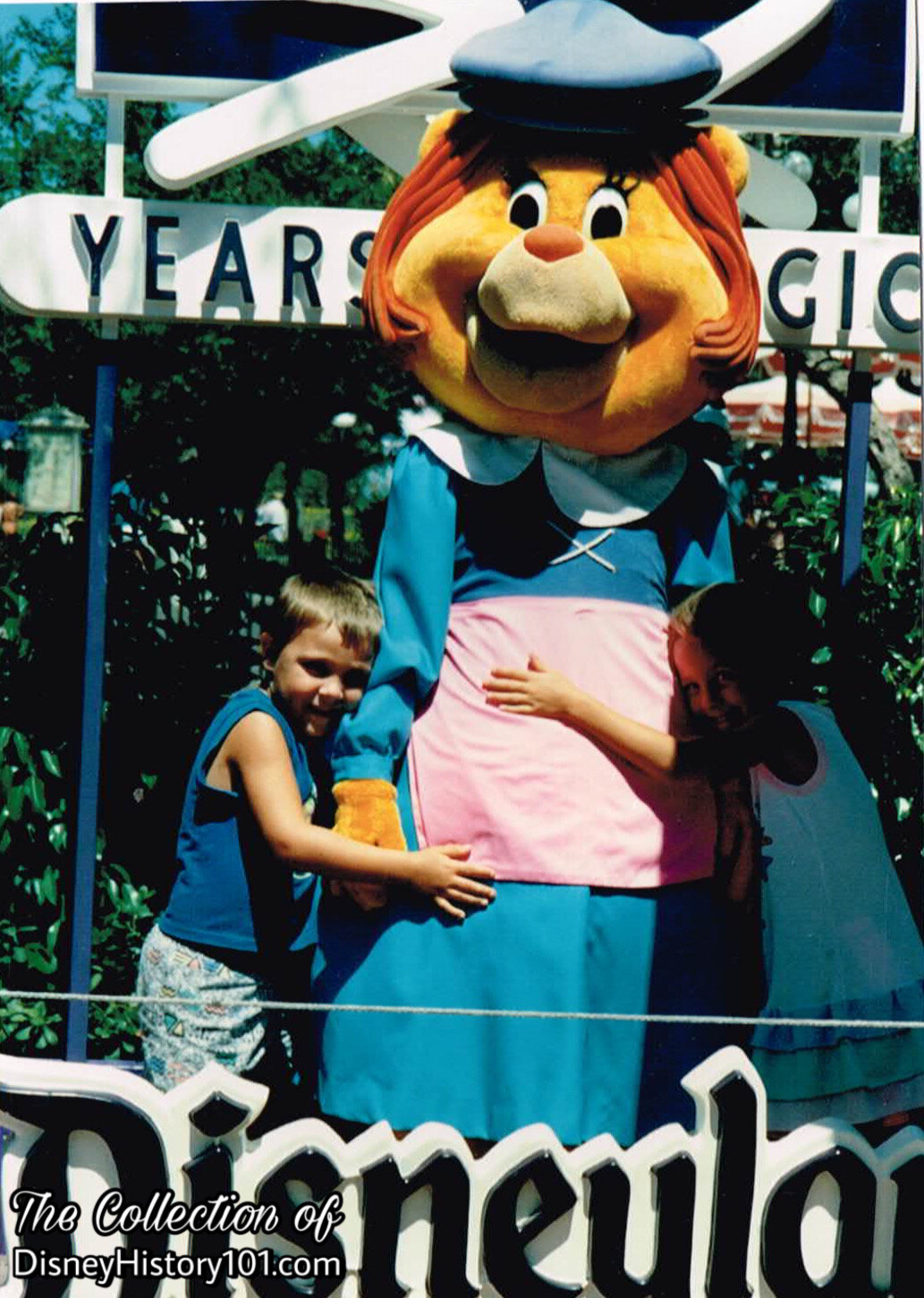
GRAMMI GUMMI
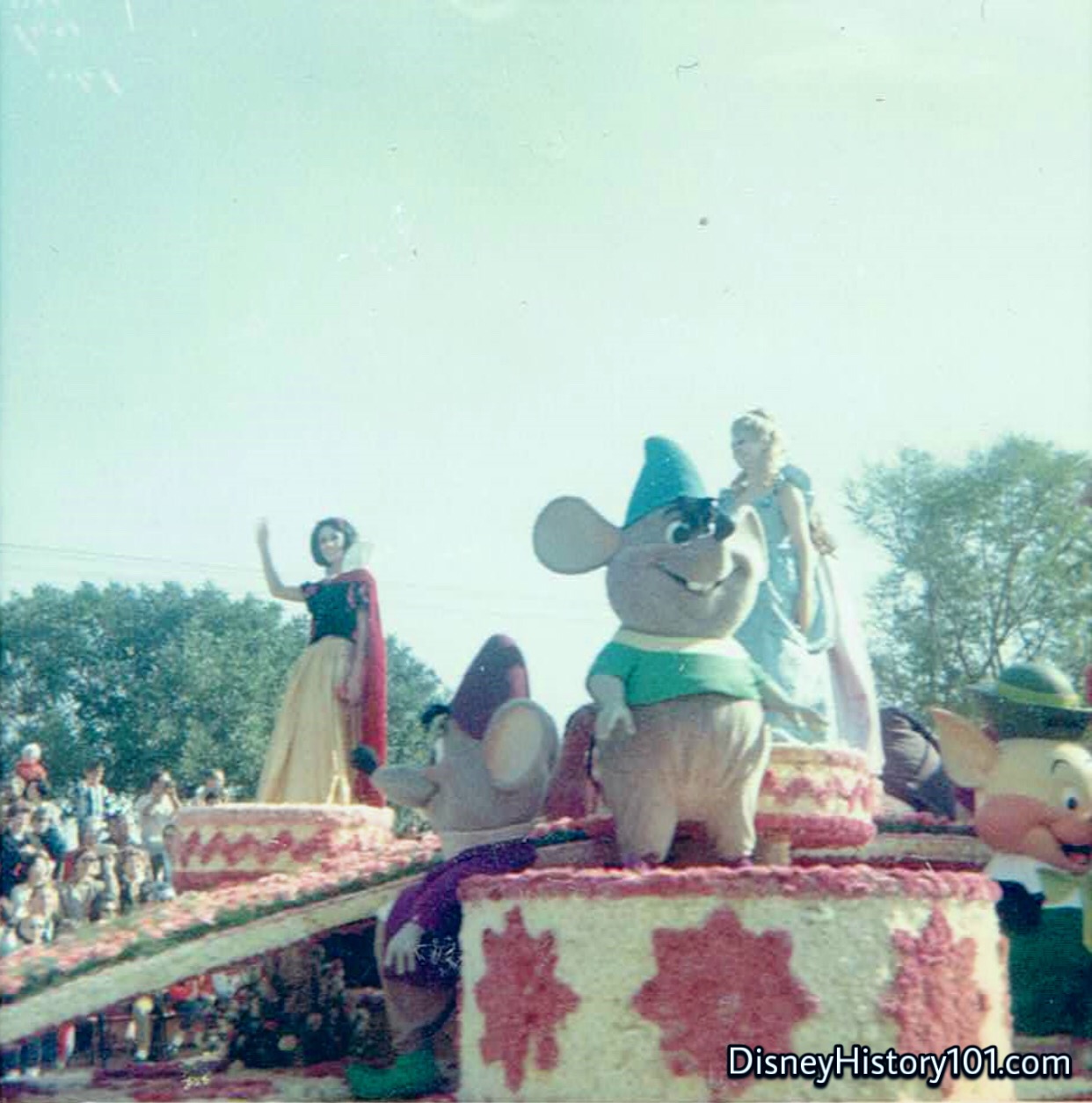
GUS-GUS

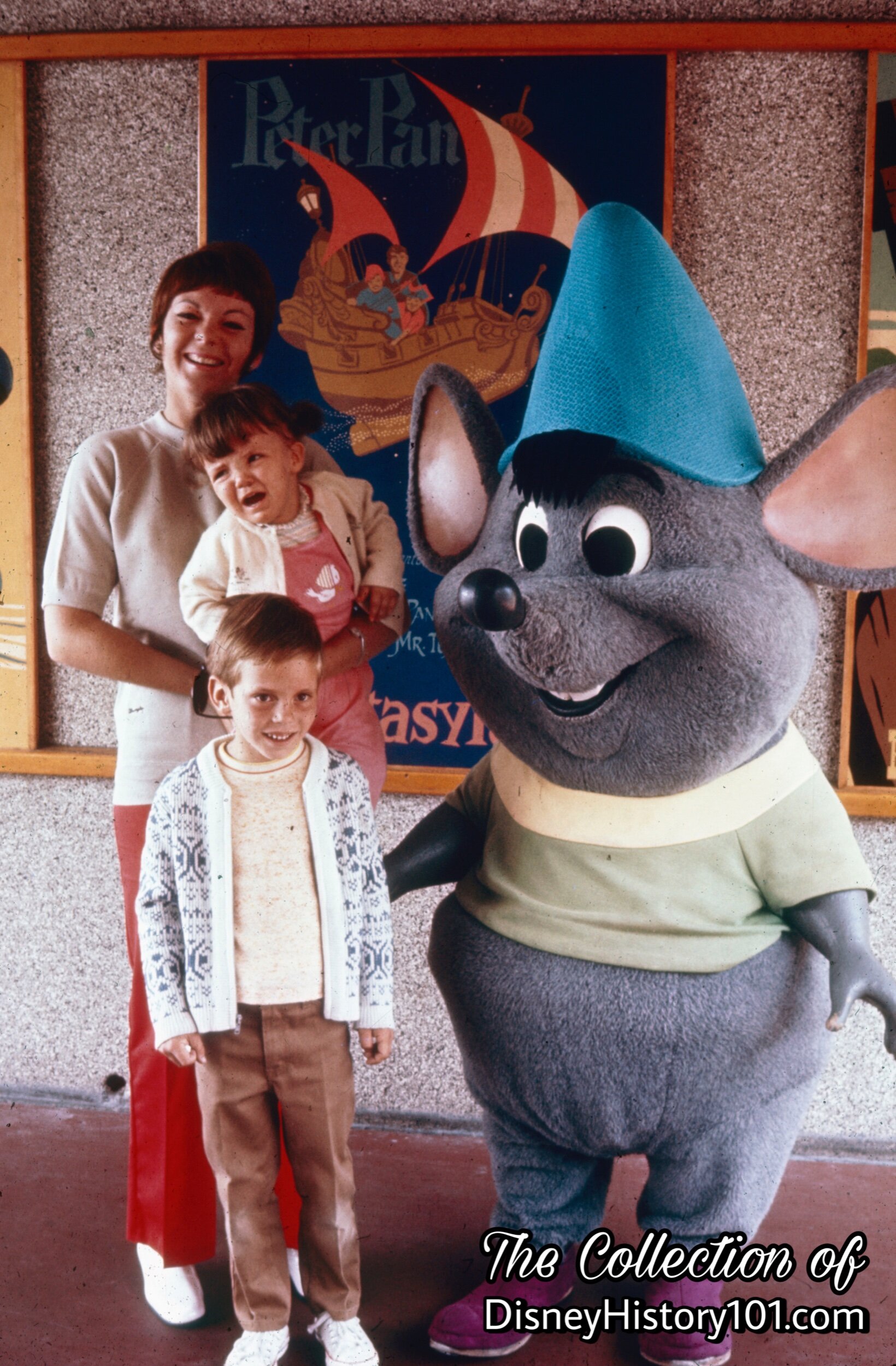
GUS-GUS

•Happy (Snow White and the Seven Dwarfs) - Walt Disney once said: “The idea of Disneyland is a simple one. It will be a place for people to find happiness.” A number of Disneyland Cast Members were close to Happy over the years, including (but not limited to) Jimmy Kaufman (1971). “The Happiest Place on Earth.”
•Herbie the Love Bug - After his nationwide debut on March 13, 1969, Herbie appeared at Disneyland.
•Hercules - Hercules (June 27, 1997)
•Hippos - The stars of Fantasia (released November 13, 1940) occasionally made appearances outside Disneyland, as when they performed in an act of the Canadian National Exposition (held August 24 - September 5, 1964)
•Honest John (Pinocchio) - J. Worthington Foulfellow is also known as Honest John.
After some sort of hiatus, the Disney Character made a return during the winter if 1962. According to the Talent Schedule “All of our regular Characters, plus a return visit by the 3 Pigs and Wolf and Pinocchio, J. Worthington Foulfellow and Gideon, will highlight this year's Holiday Season.”
He was part of the Pre-game “Walt Disney and Disneyland Salute to the California Angels” at the new Angels Stadium on Saturday, April 23rd, 1966!
•Hooter (Captain EO)
•Hoppopotamus (The Wuzzles) - This character is believed to have appeared in Walt Disney’s Magic Kingdom On Ice: Sport Goofy from 1985 to 1986.
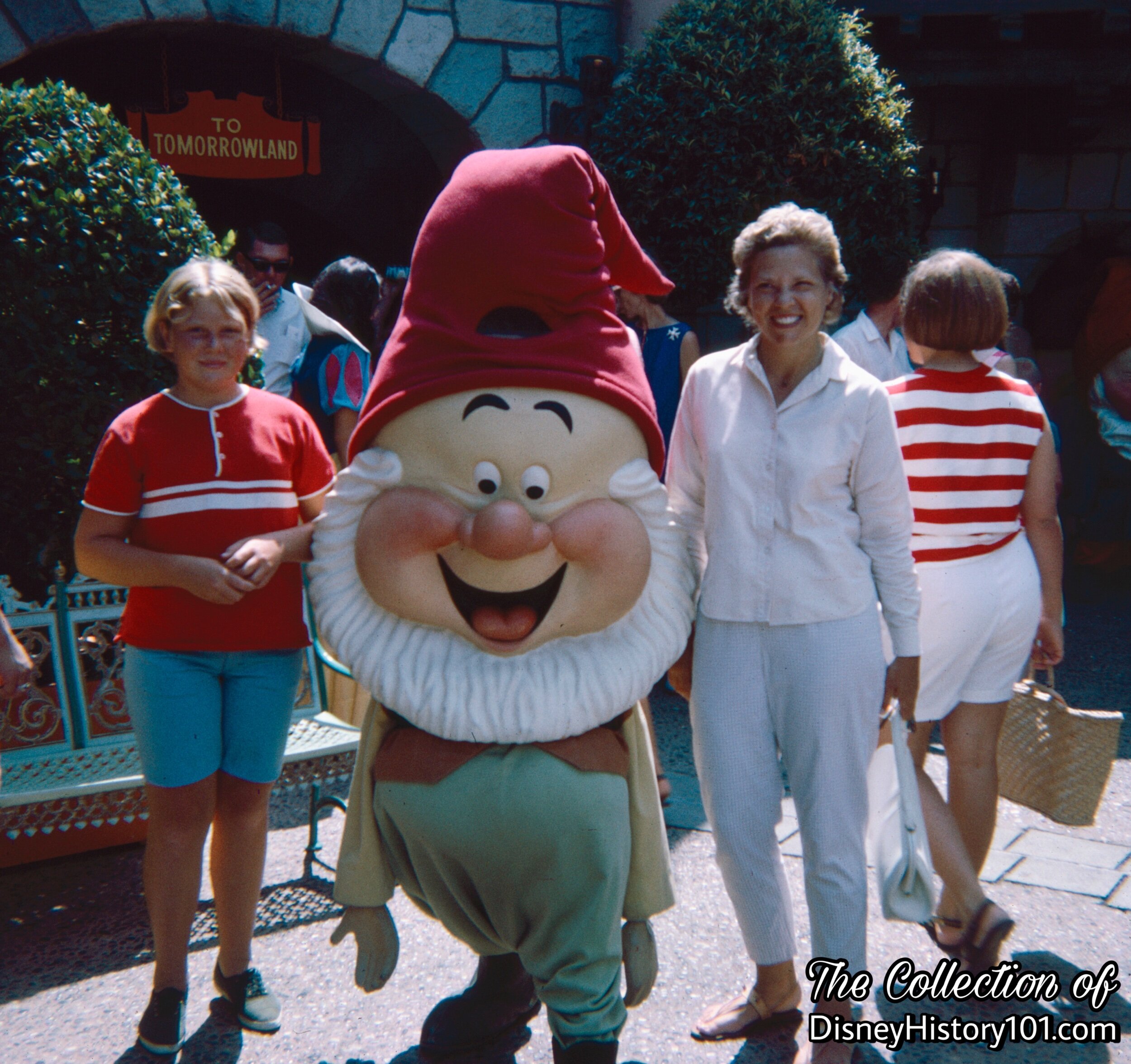
HAPPY (Augut, 1966)
This incarnation of Happy made his debut inside Disneyland during the summer of 1961.
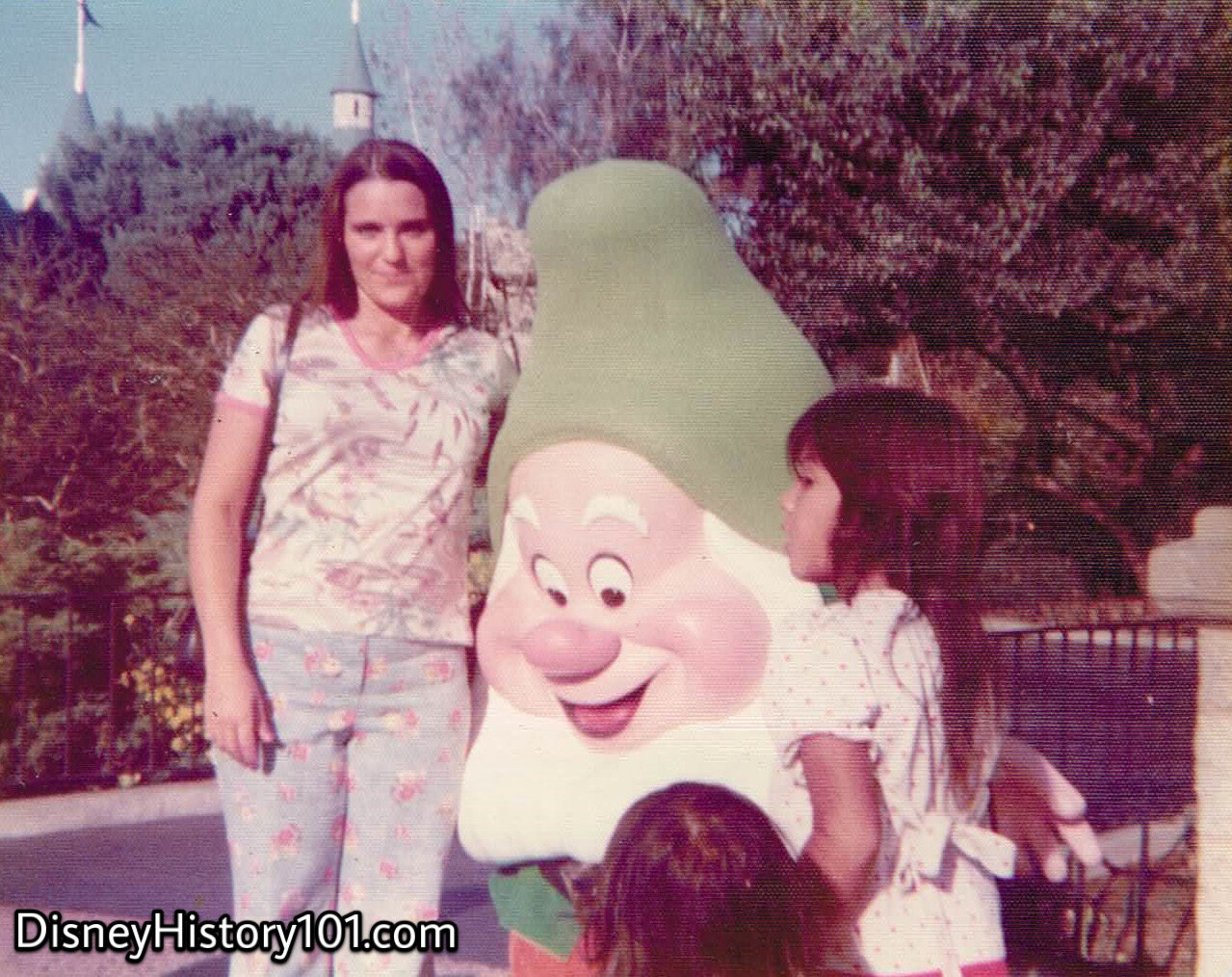
HAPPY
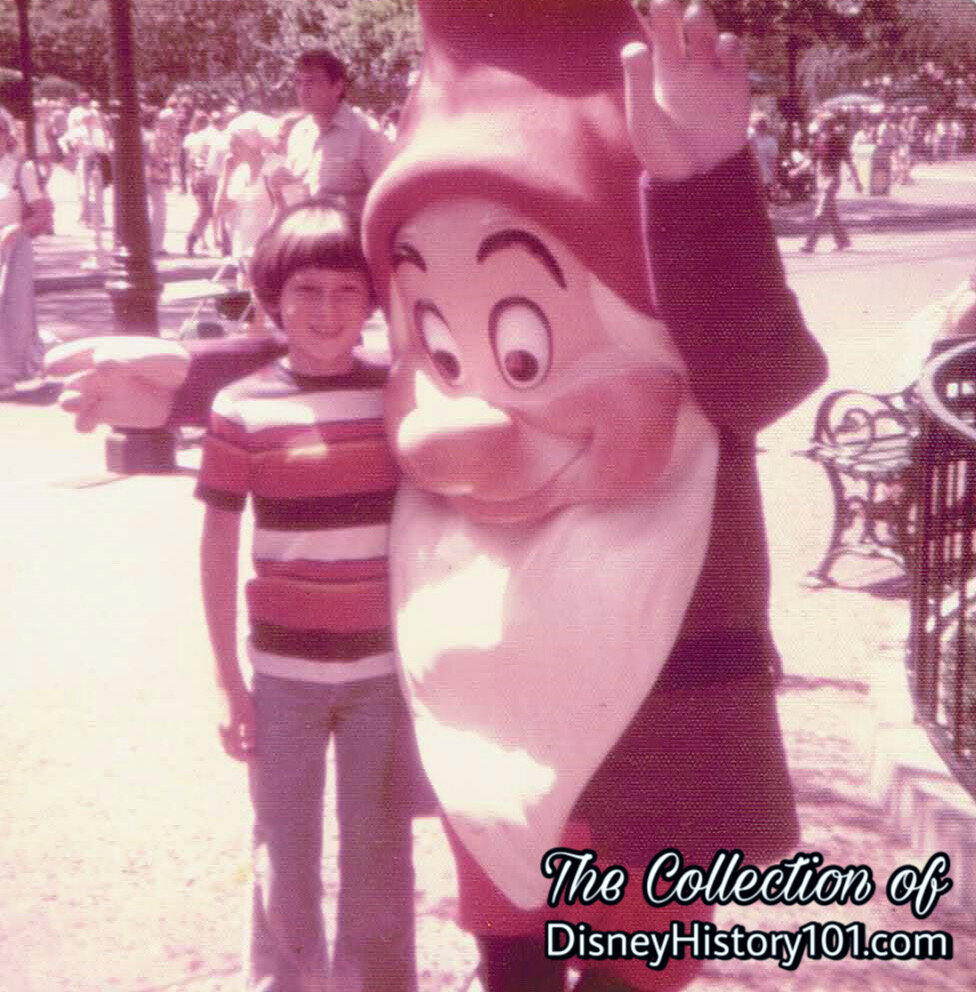
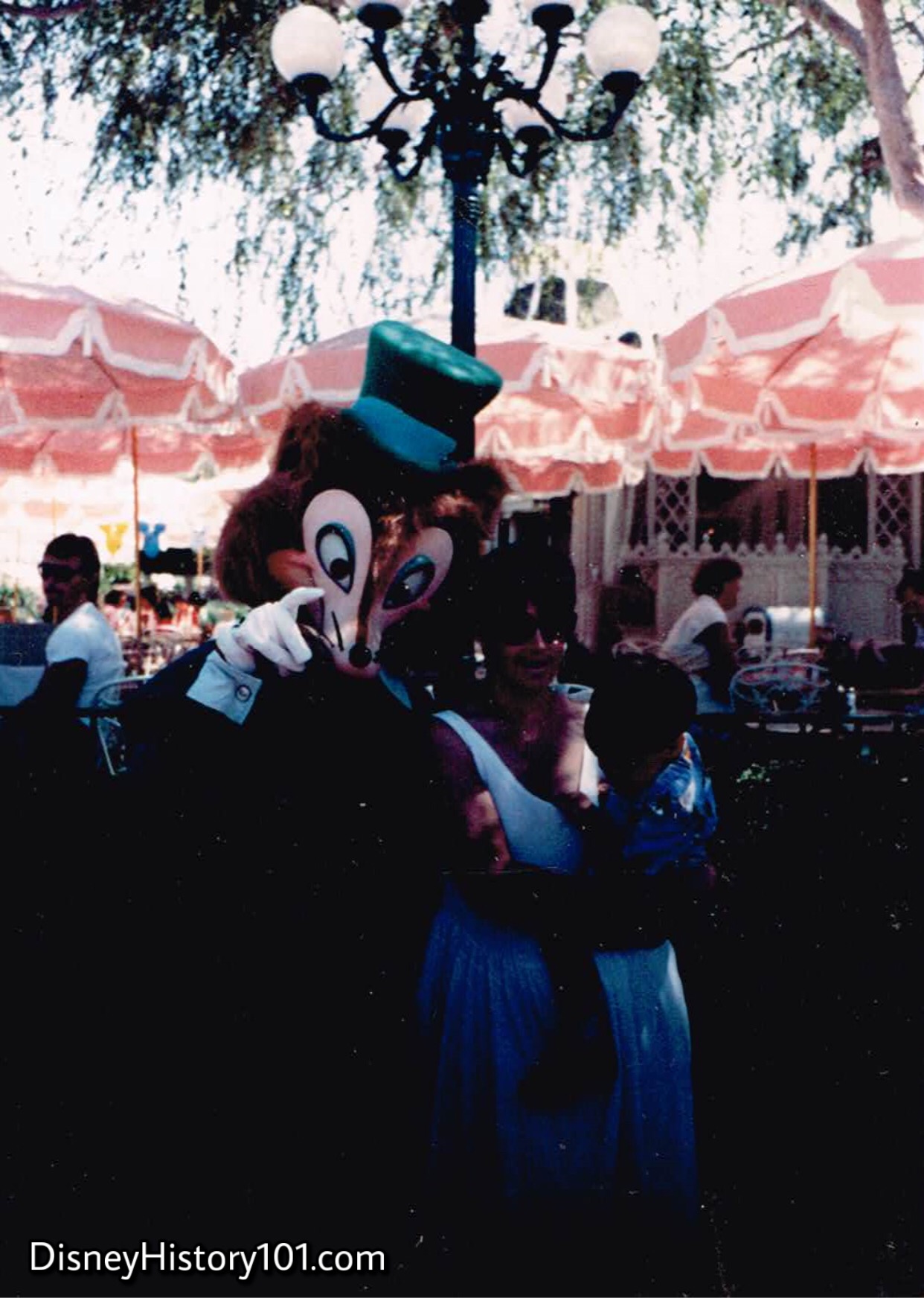
HONEST JOHN (J. Worthington Foulfellow) of "Pinocchio"
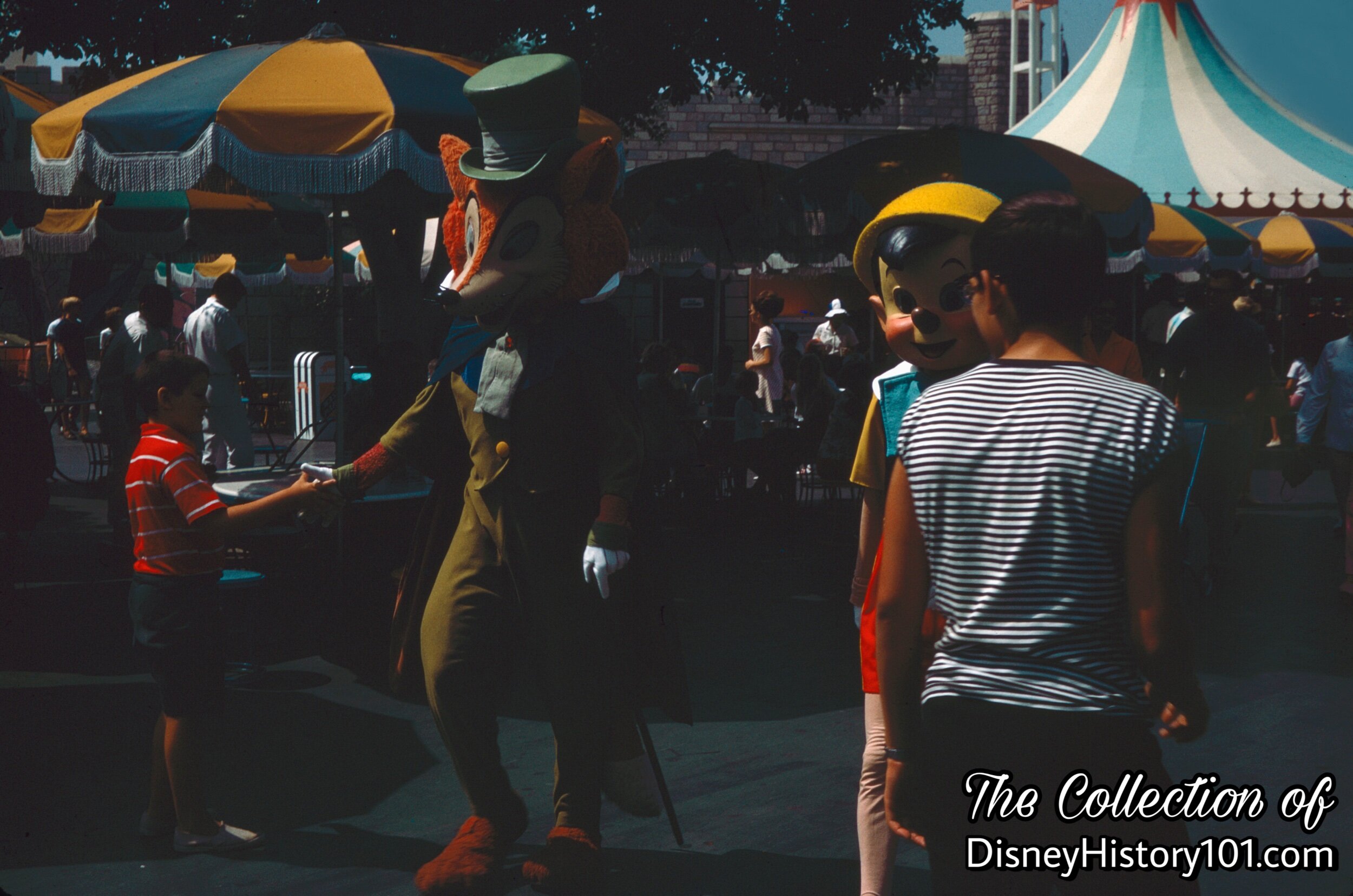
HONEST JOHN (J. Worthington Foulfellow) of "Pinocchio", (1967)

HONEST JOHN (J. Worthington Foulfellow) of "Pinocchio", (1971)

HONEST JOHN (J. Worthington Foulfellow) of "Pinocchio", (September, 1970)
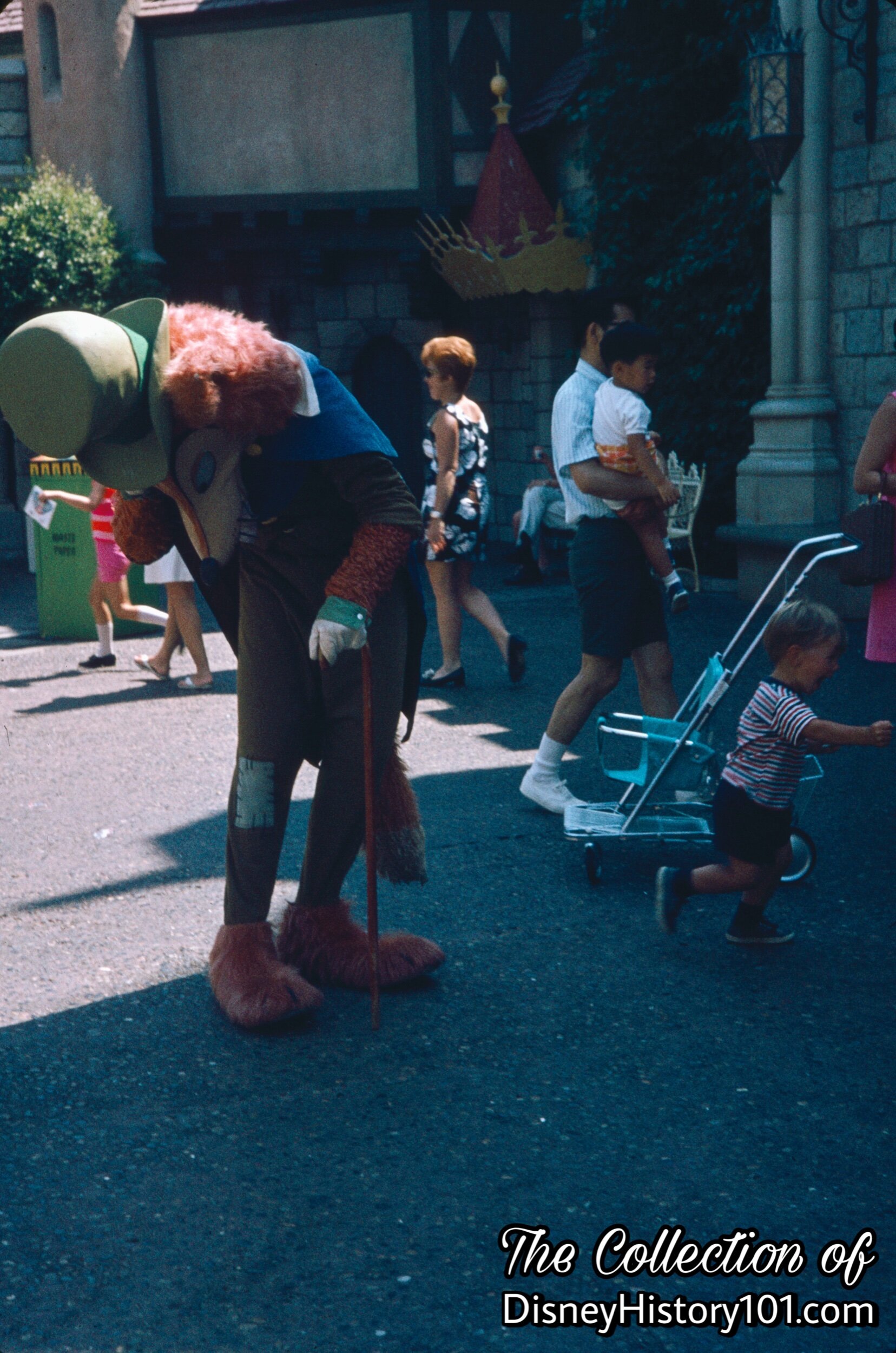
HONEST JOHN (J. Worthington Foulfellow) of "Pinocchio"
Approached by a frightened child, Honest John animates bashfulness and plays peek-a-boo.
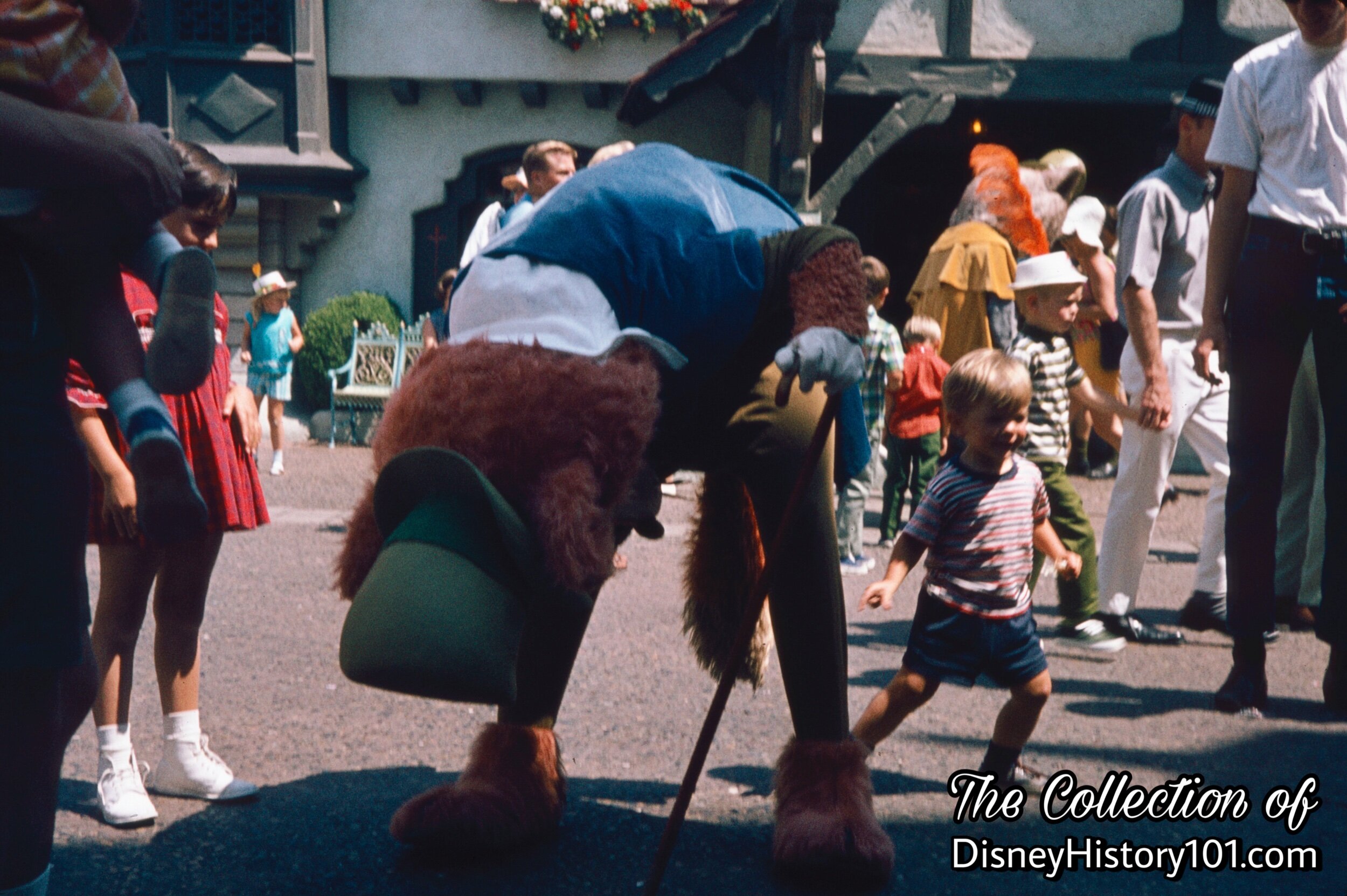
The animated HONEST JOHN (J. Worthington Foulfellow) of "Pinocchio"
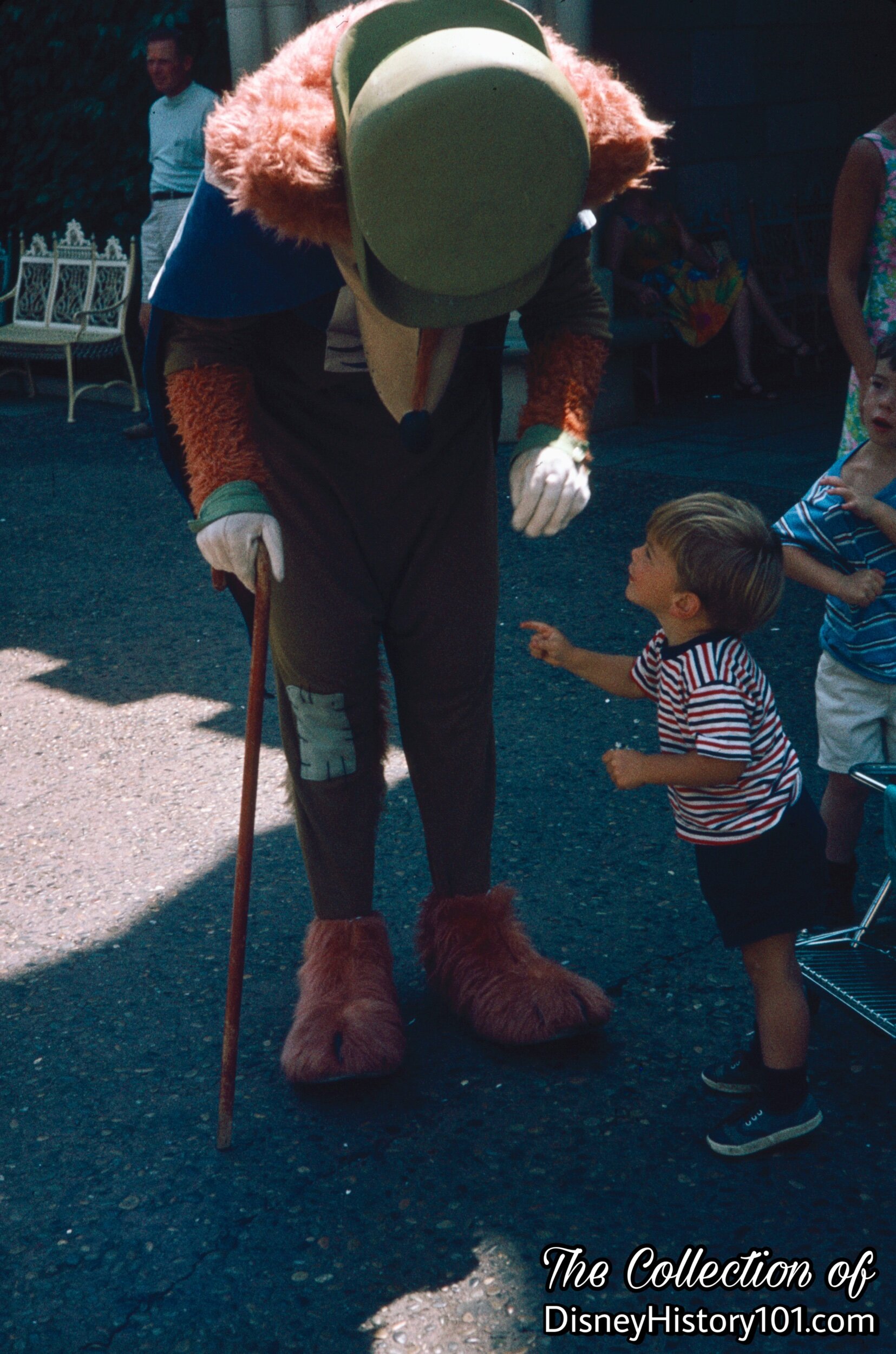
HONEST JOHN (J. Worthington Foulfellow) of "Pinocchio"
Honest John gets down to the child's level.
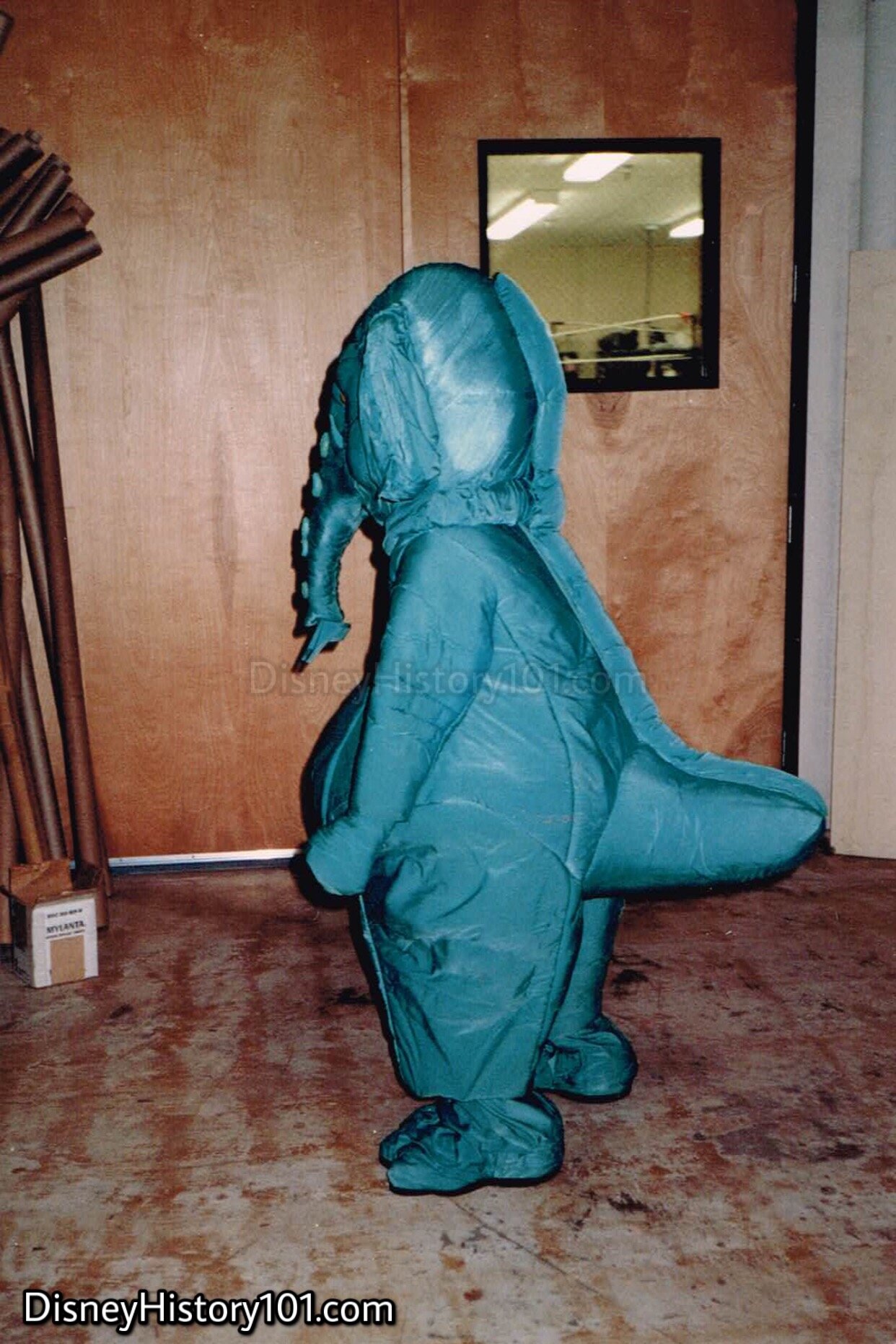
HOOTER of Captain EO, (1986)
Hooter first debuted during the Disneyland World Premier of Captain EO, in 1986. In this rare Vintage View, we catch a glimpse of an early prototype of Hooter, prepared by the Disneyland Entertainment Department.

HOPPOPOTAMUS, of "The Wuzzles"
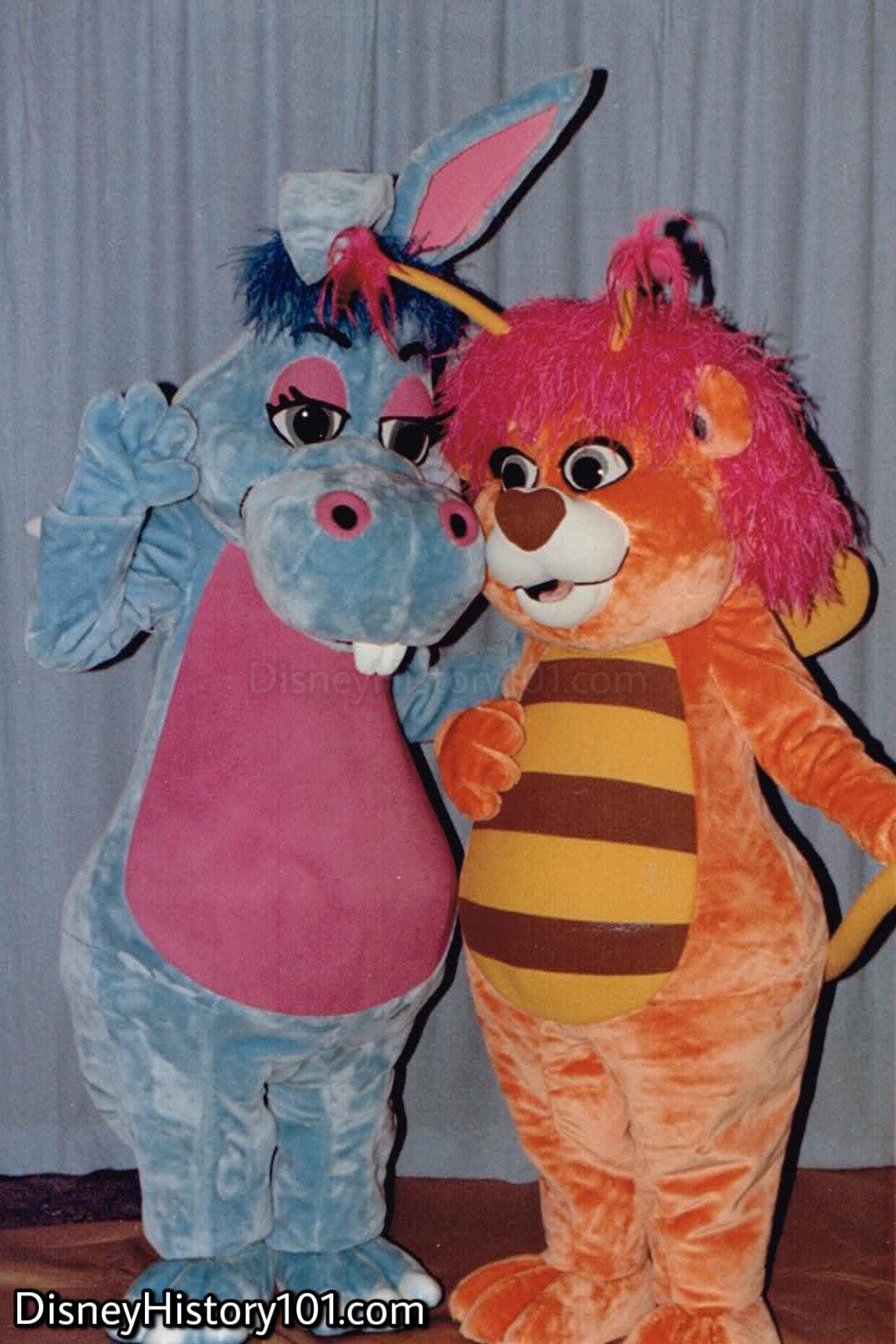
HOPPOPOTAMUS and Bumblelion, of "The Wuzzles"
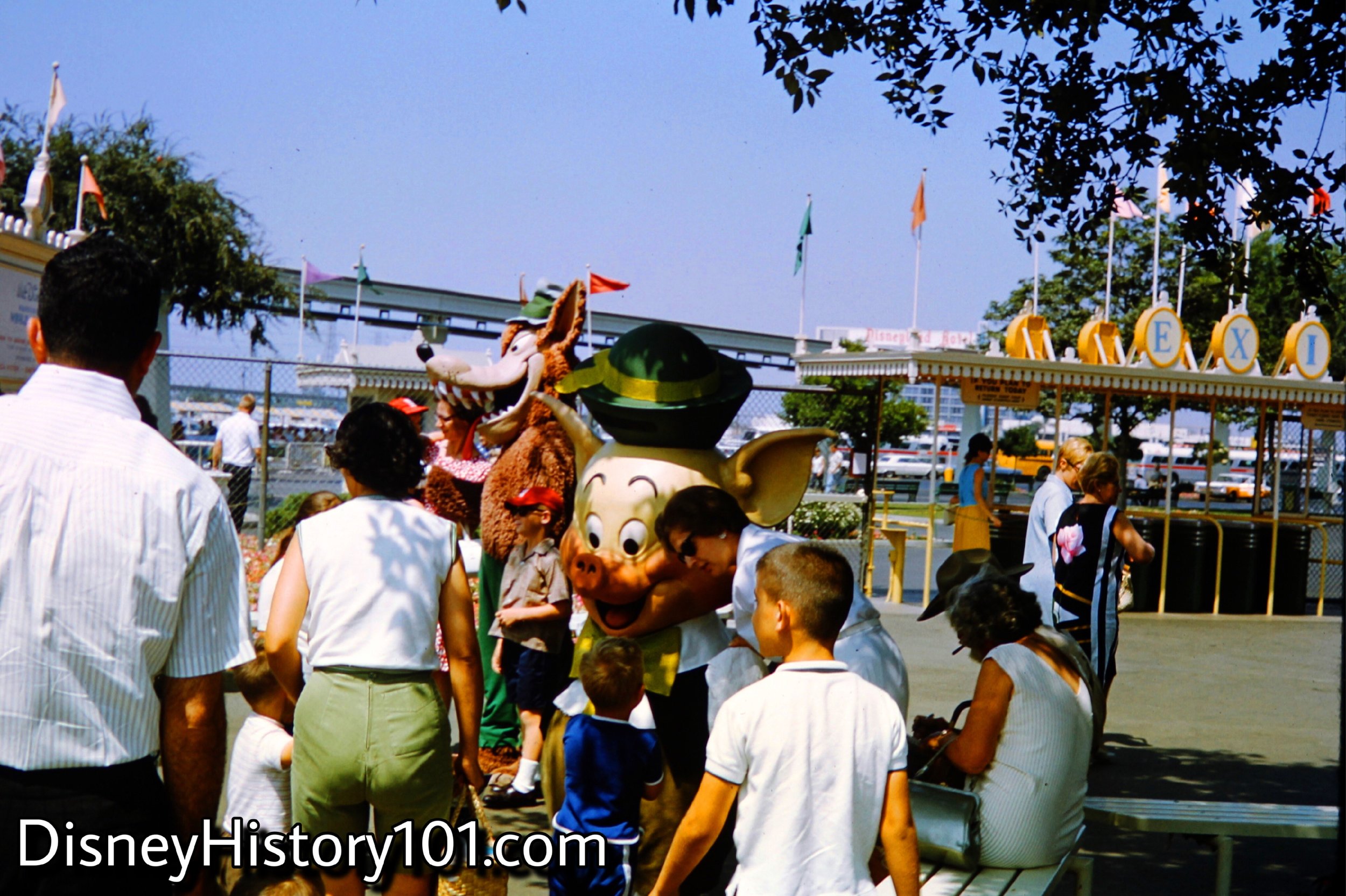
Summer, 1966


